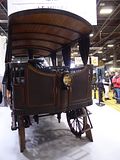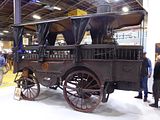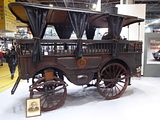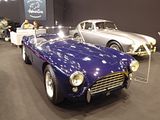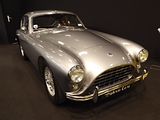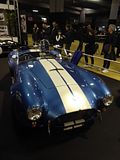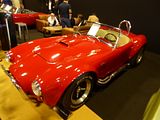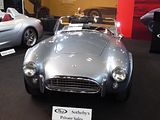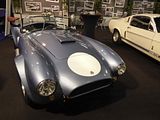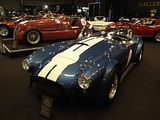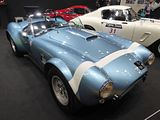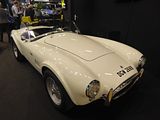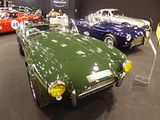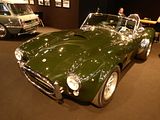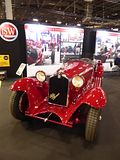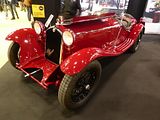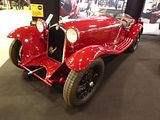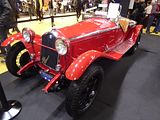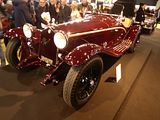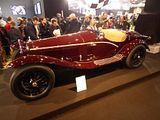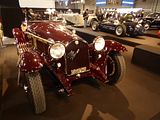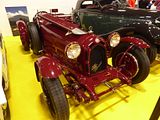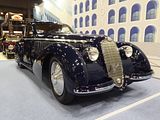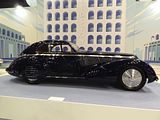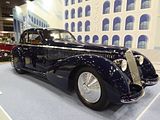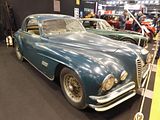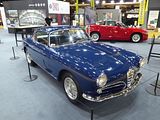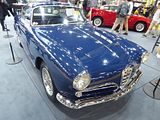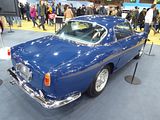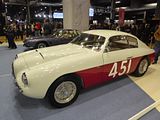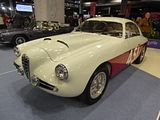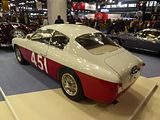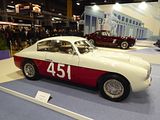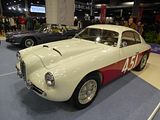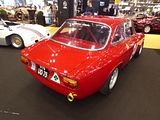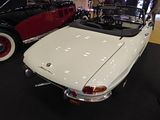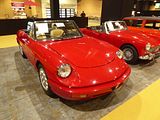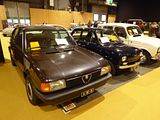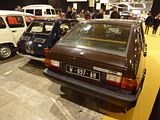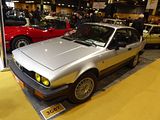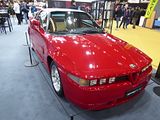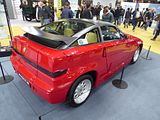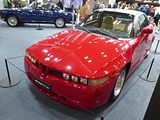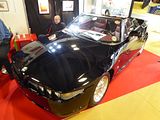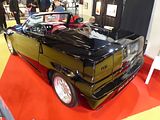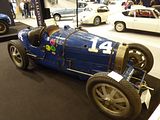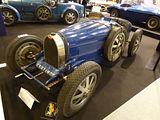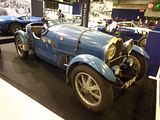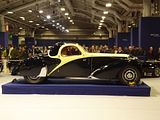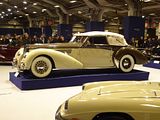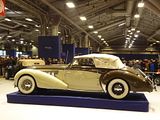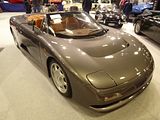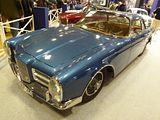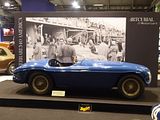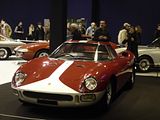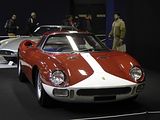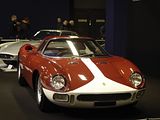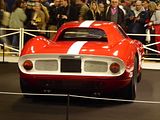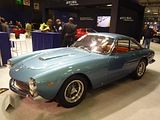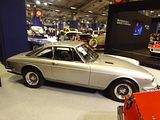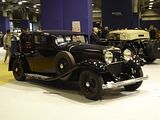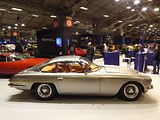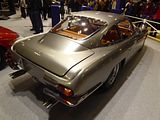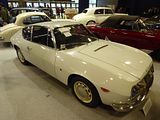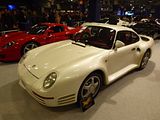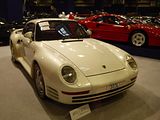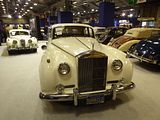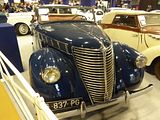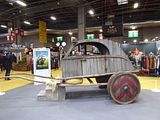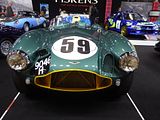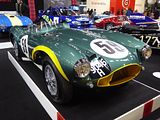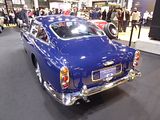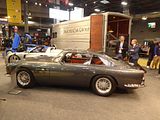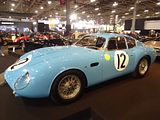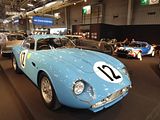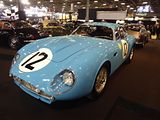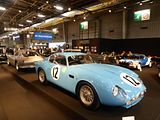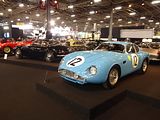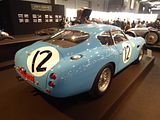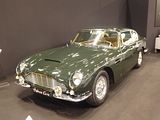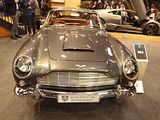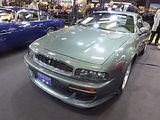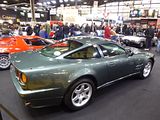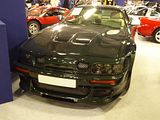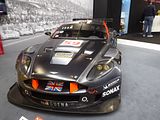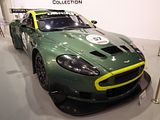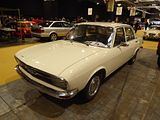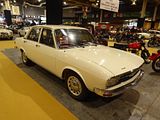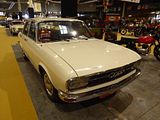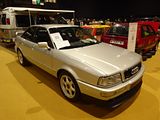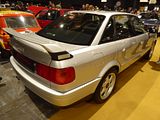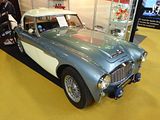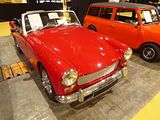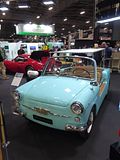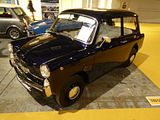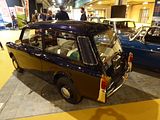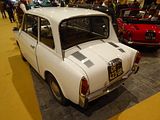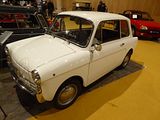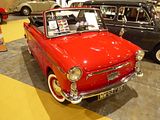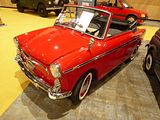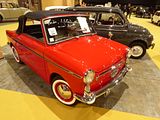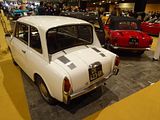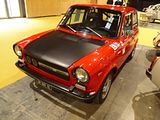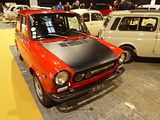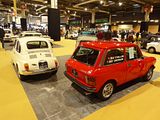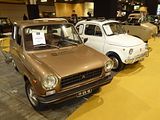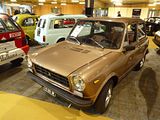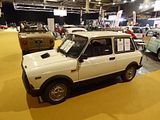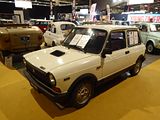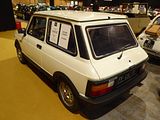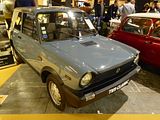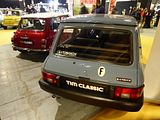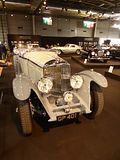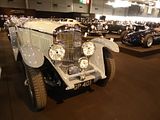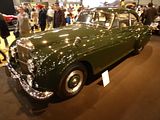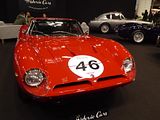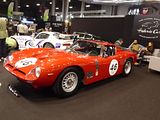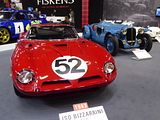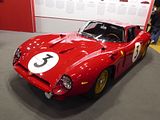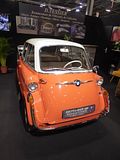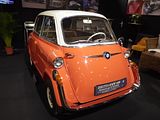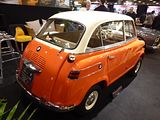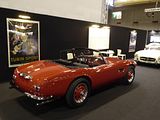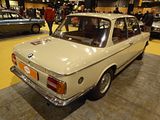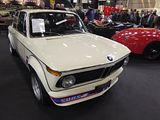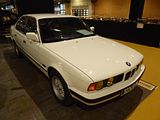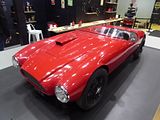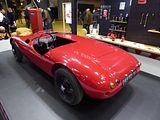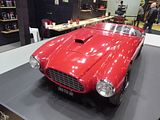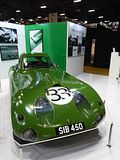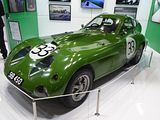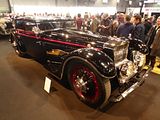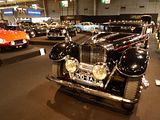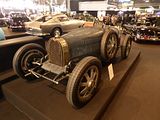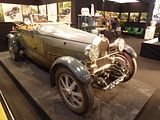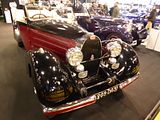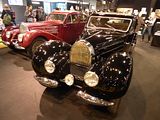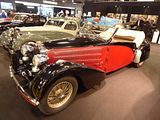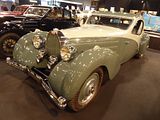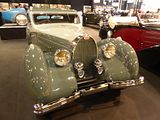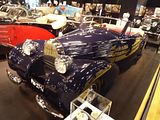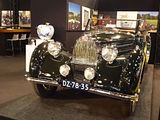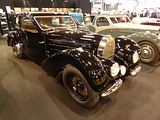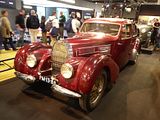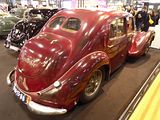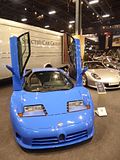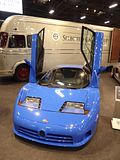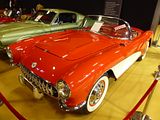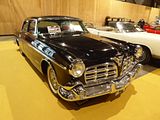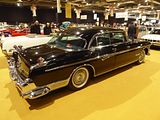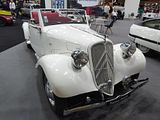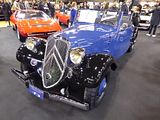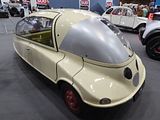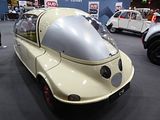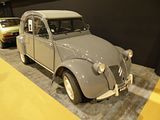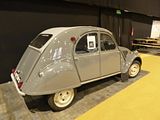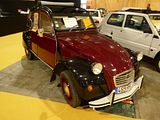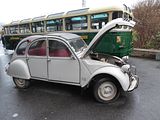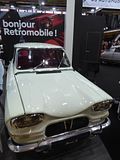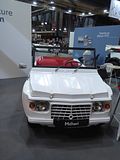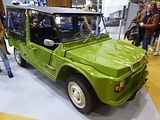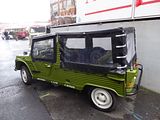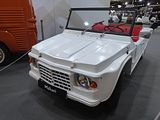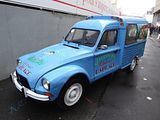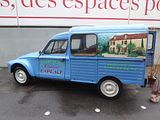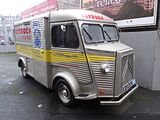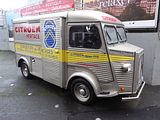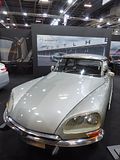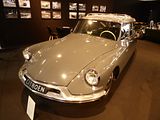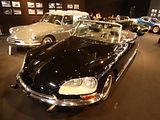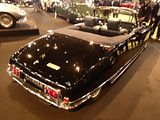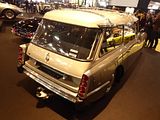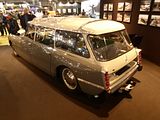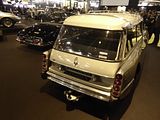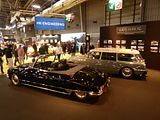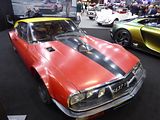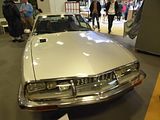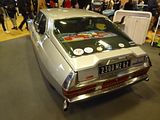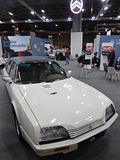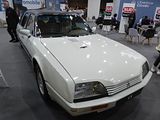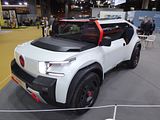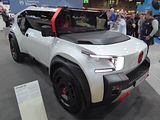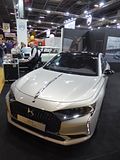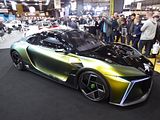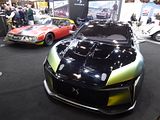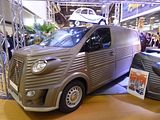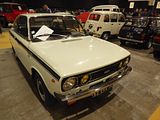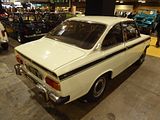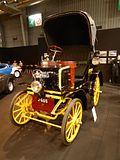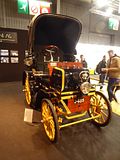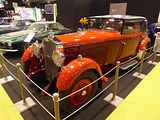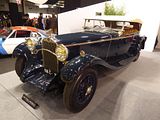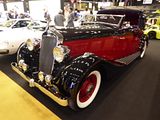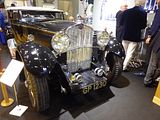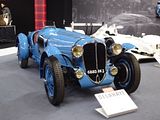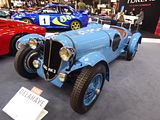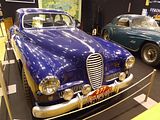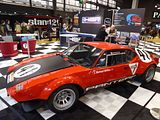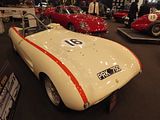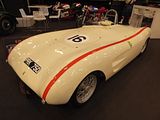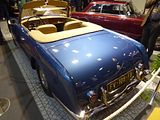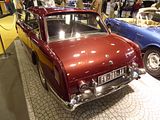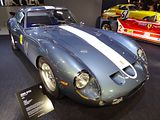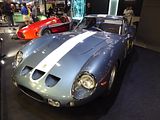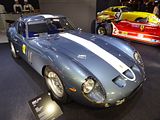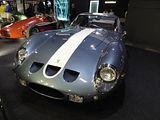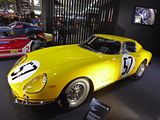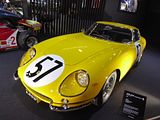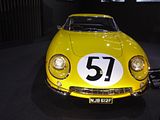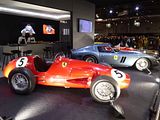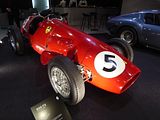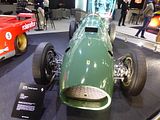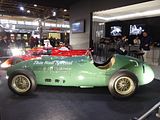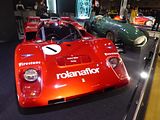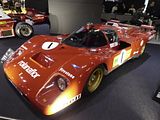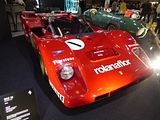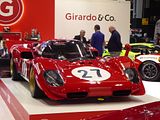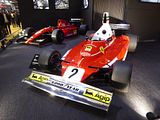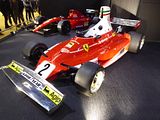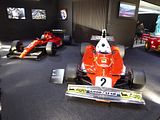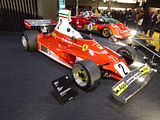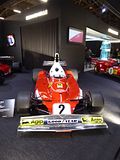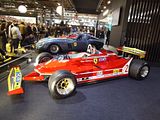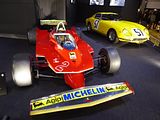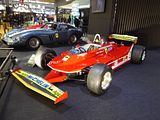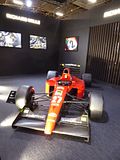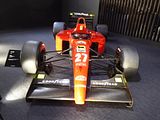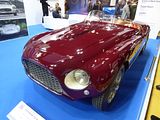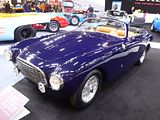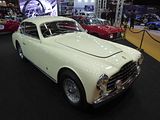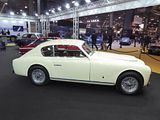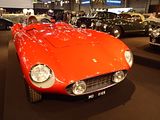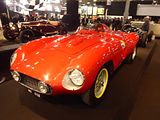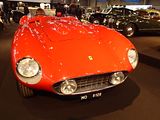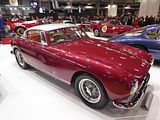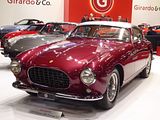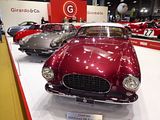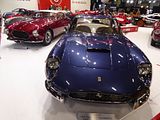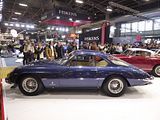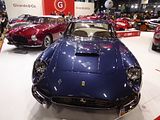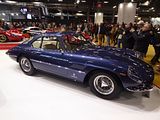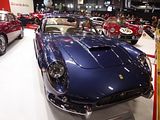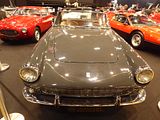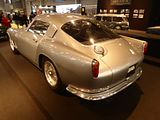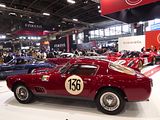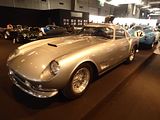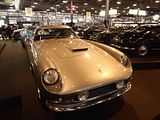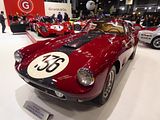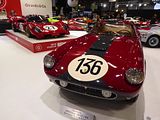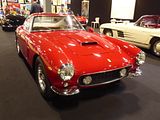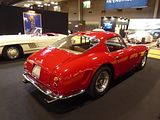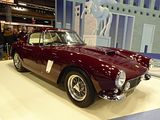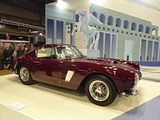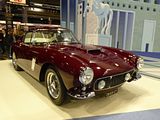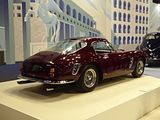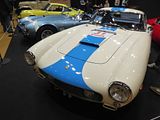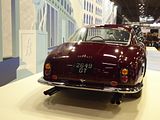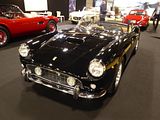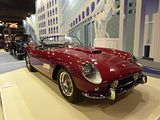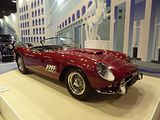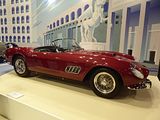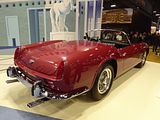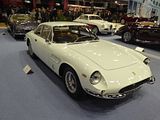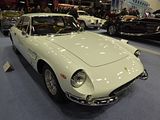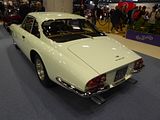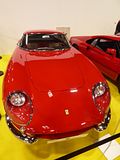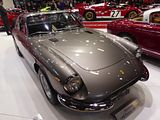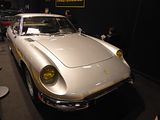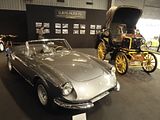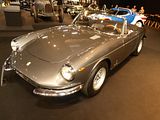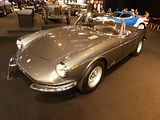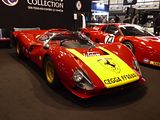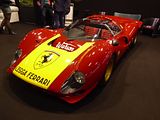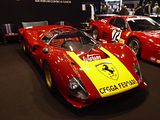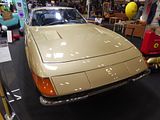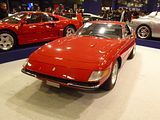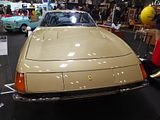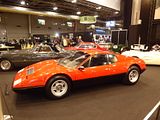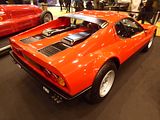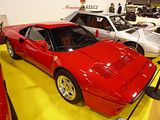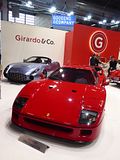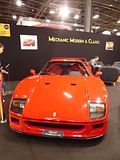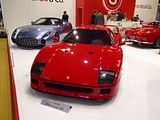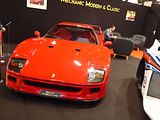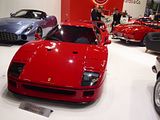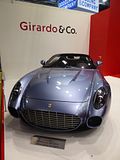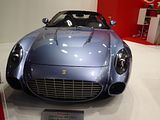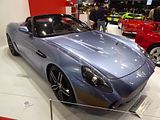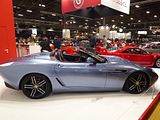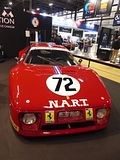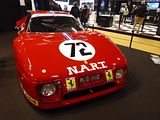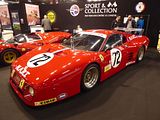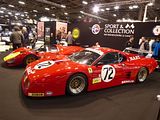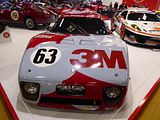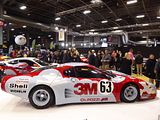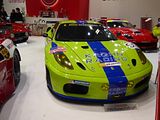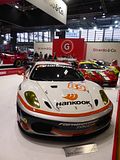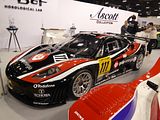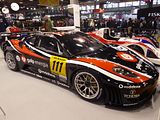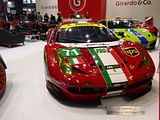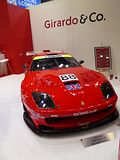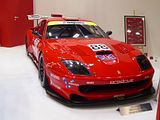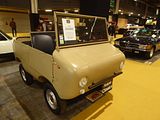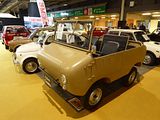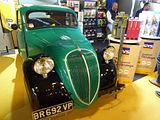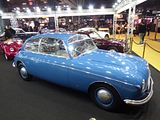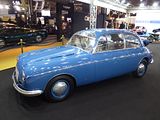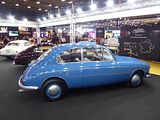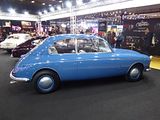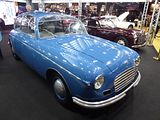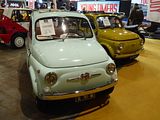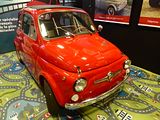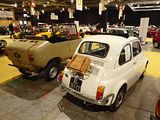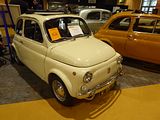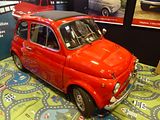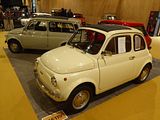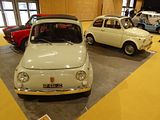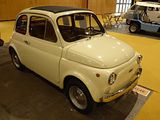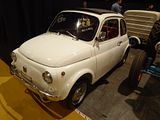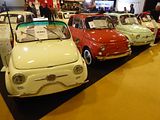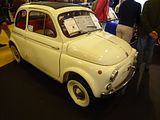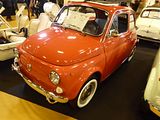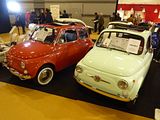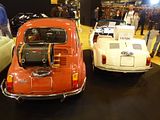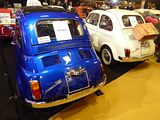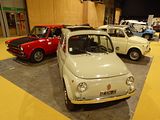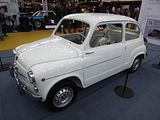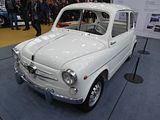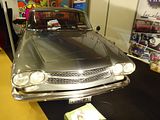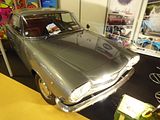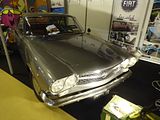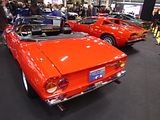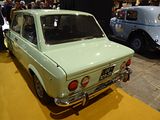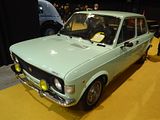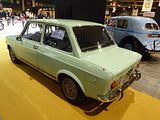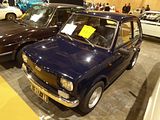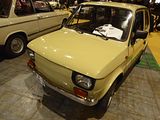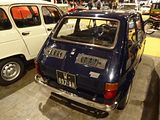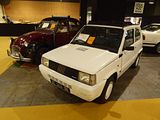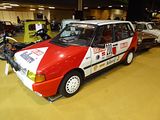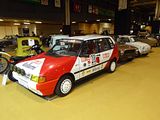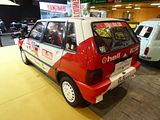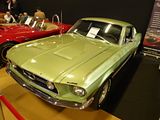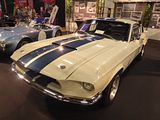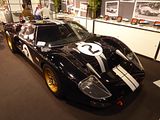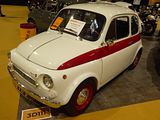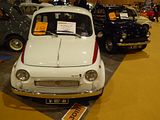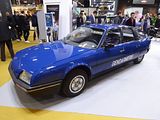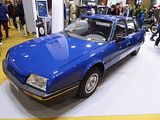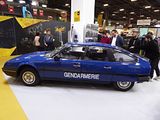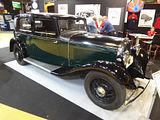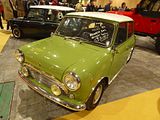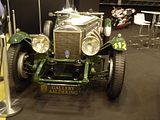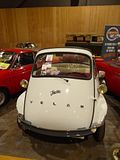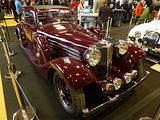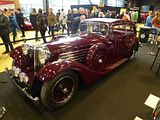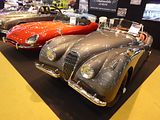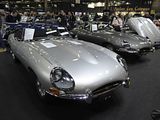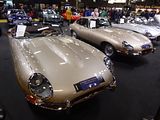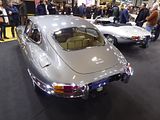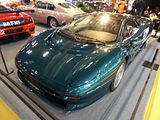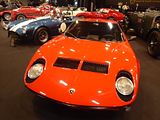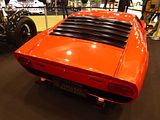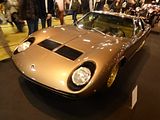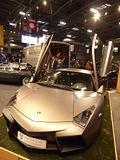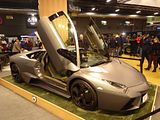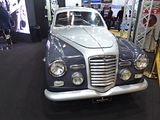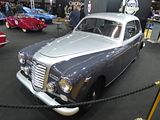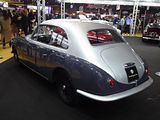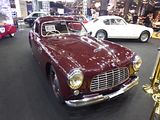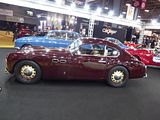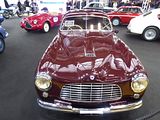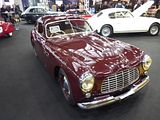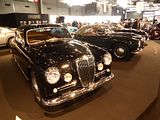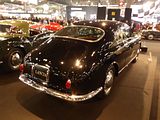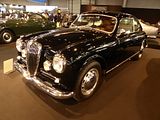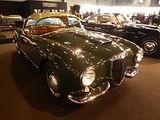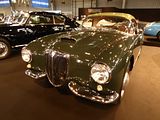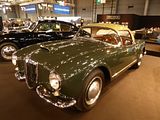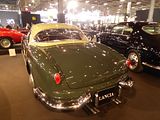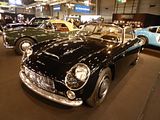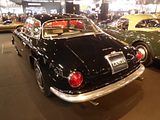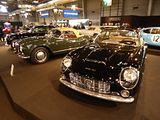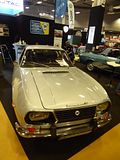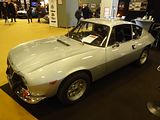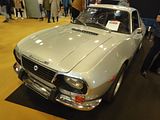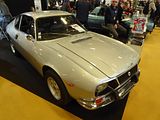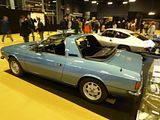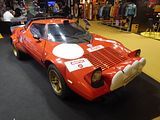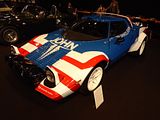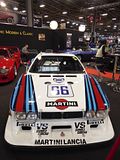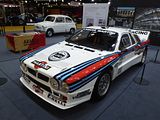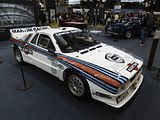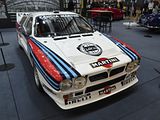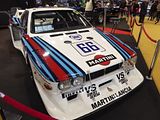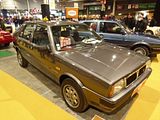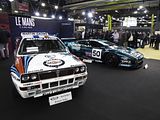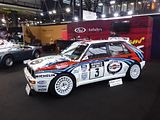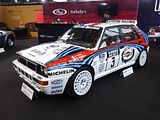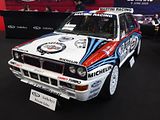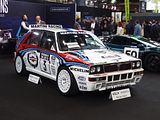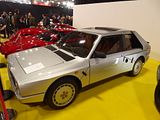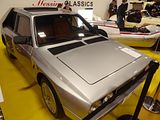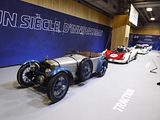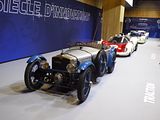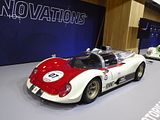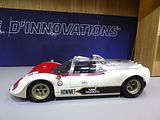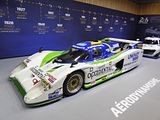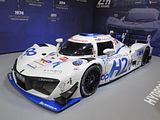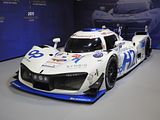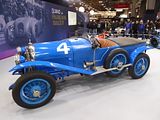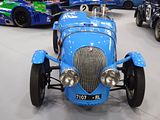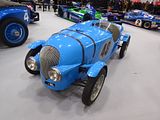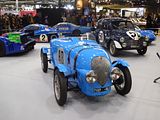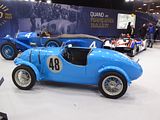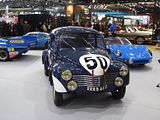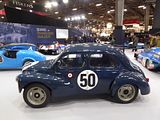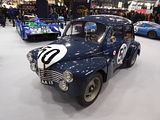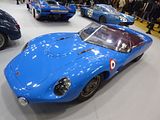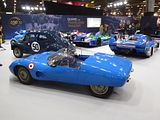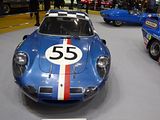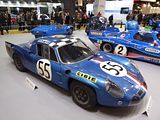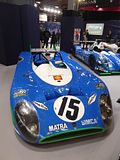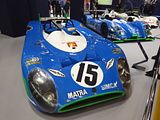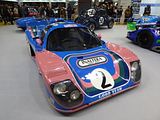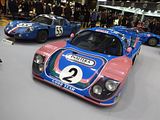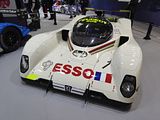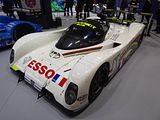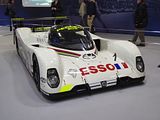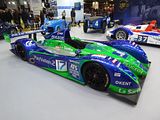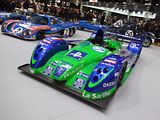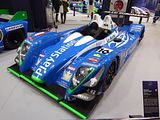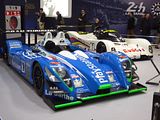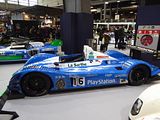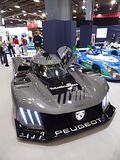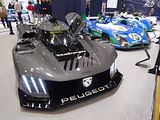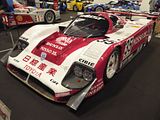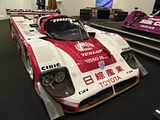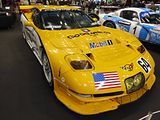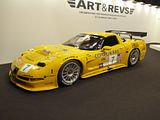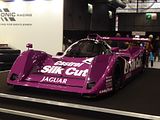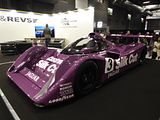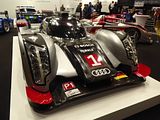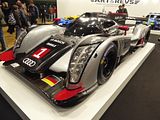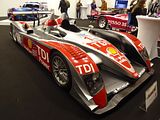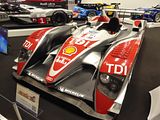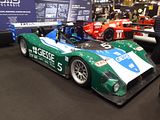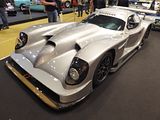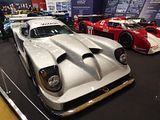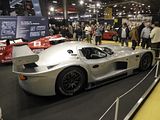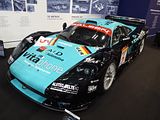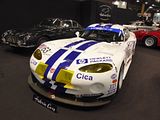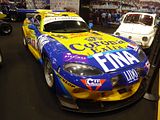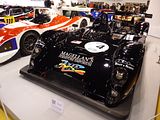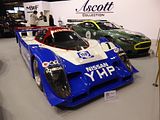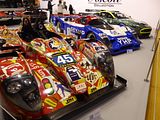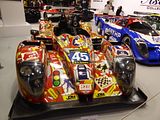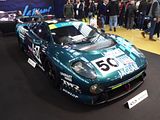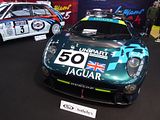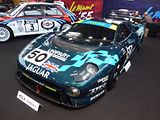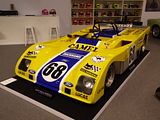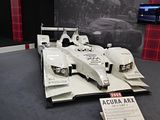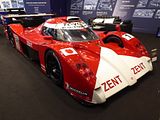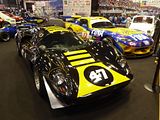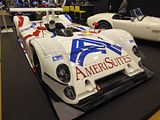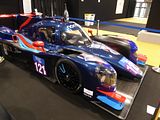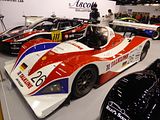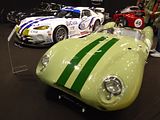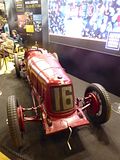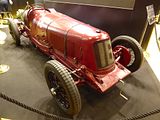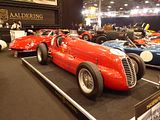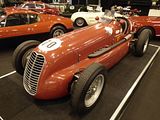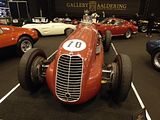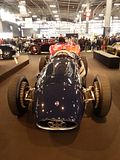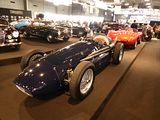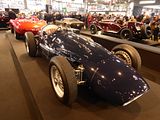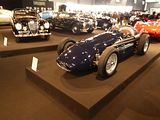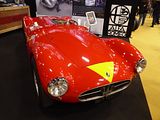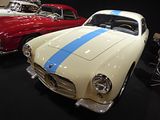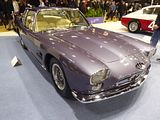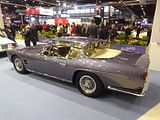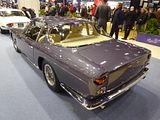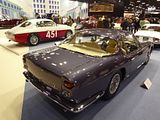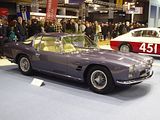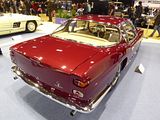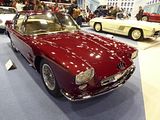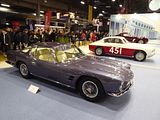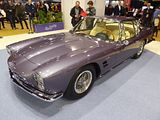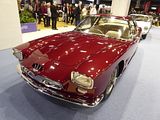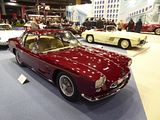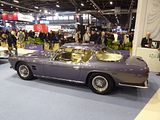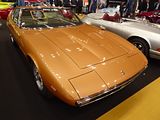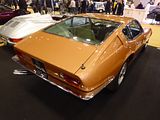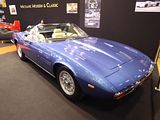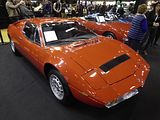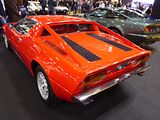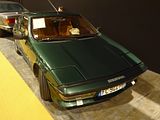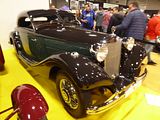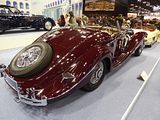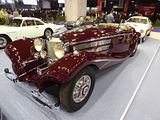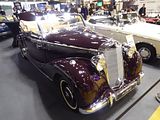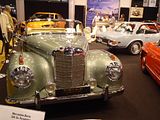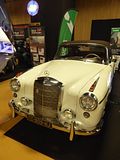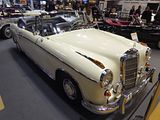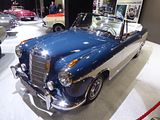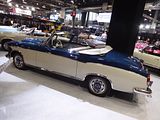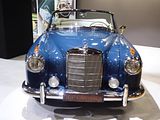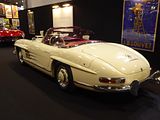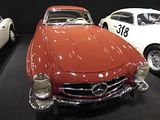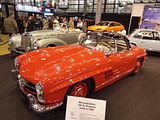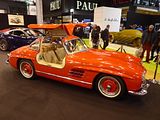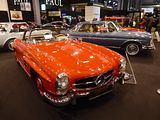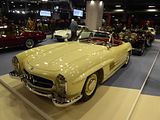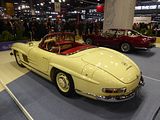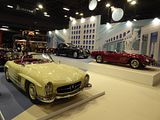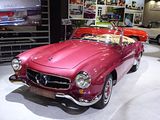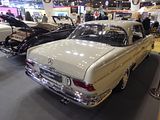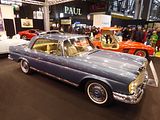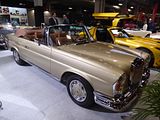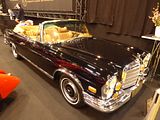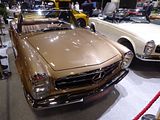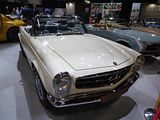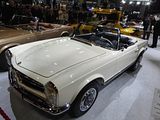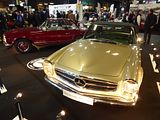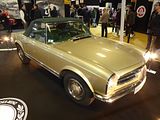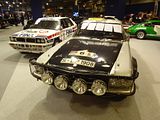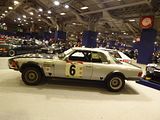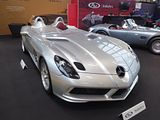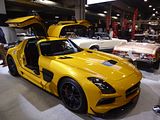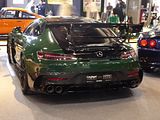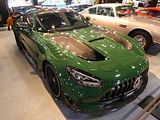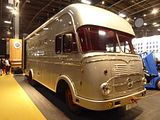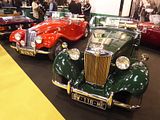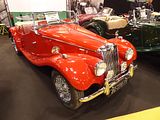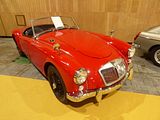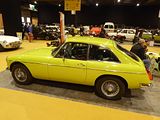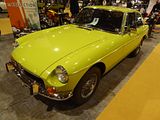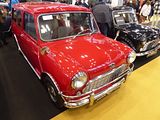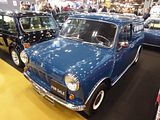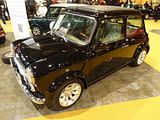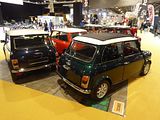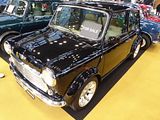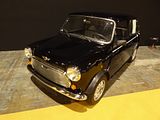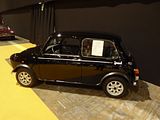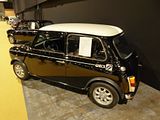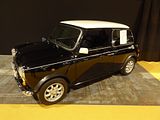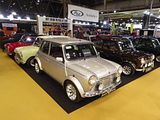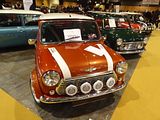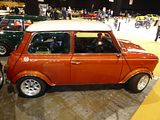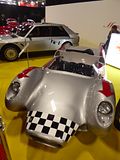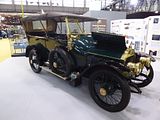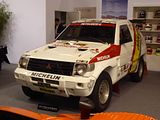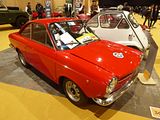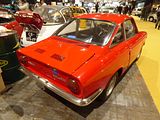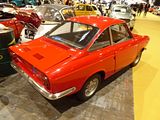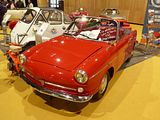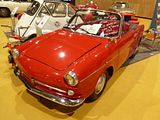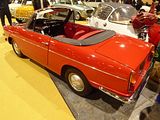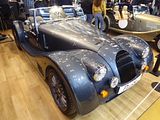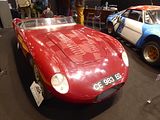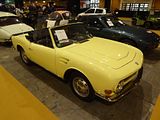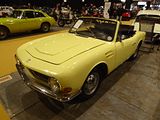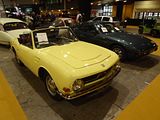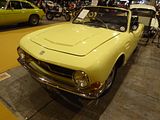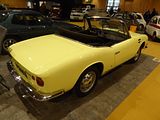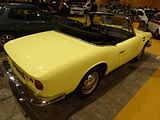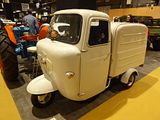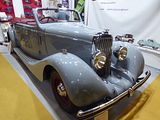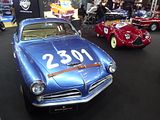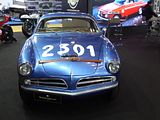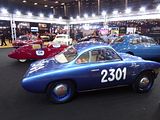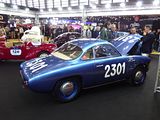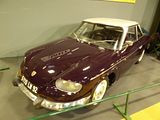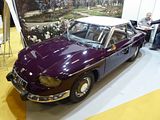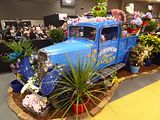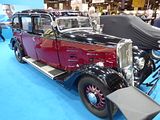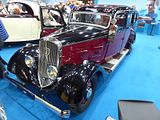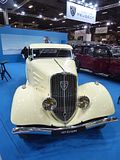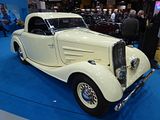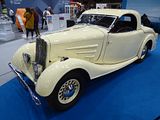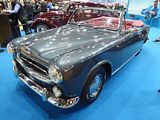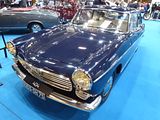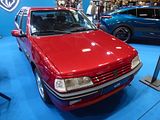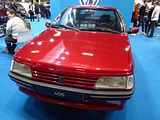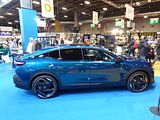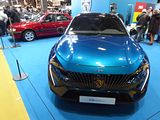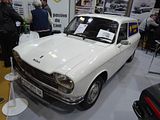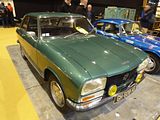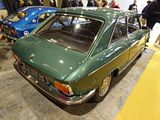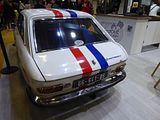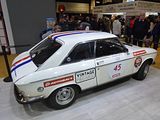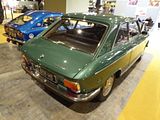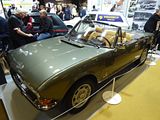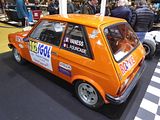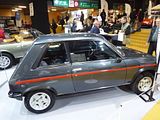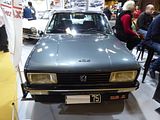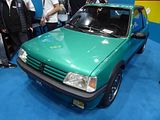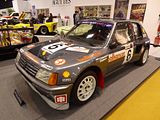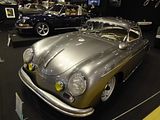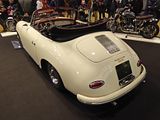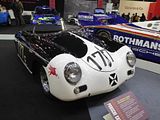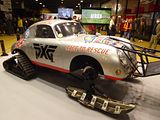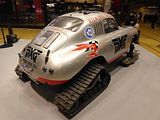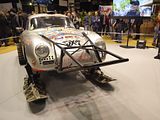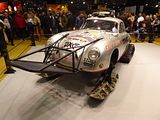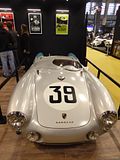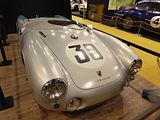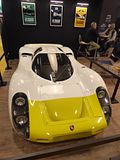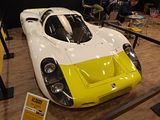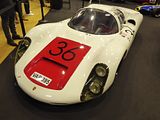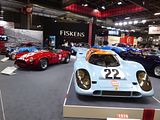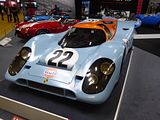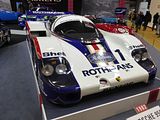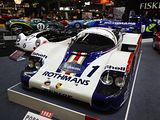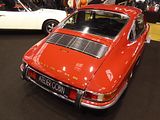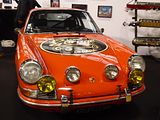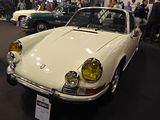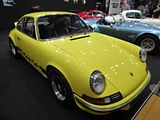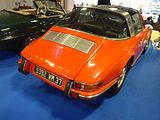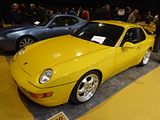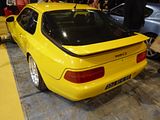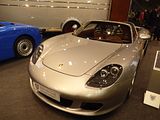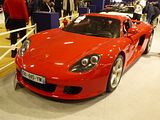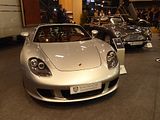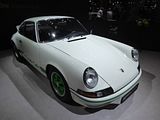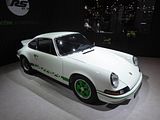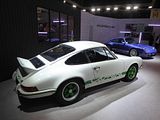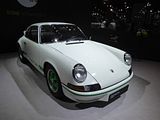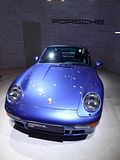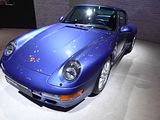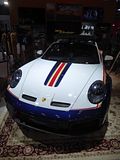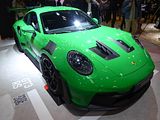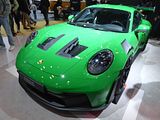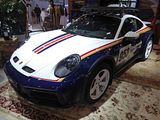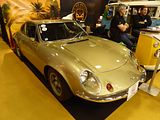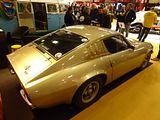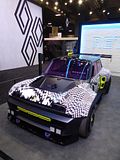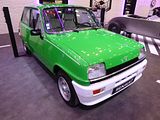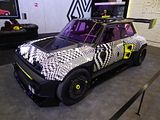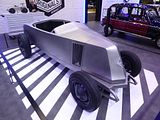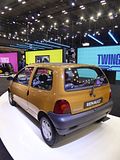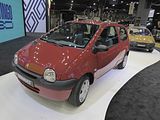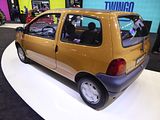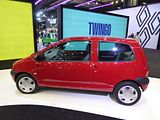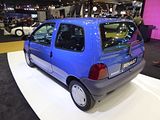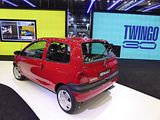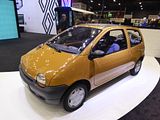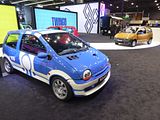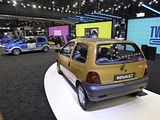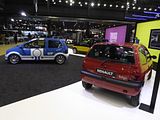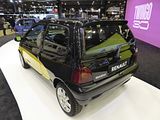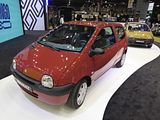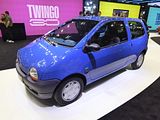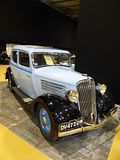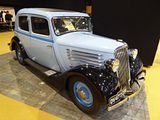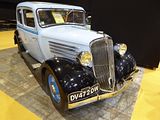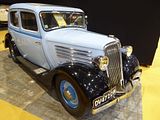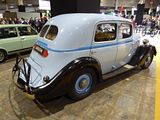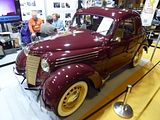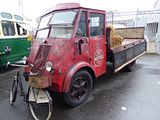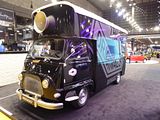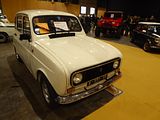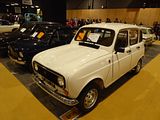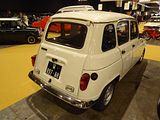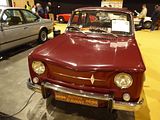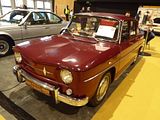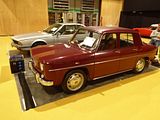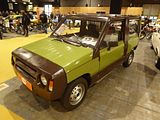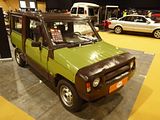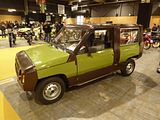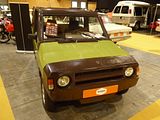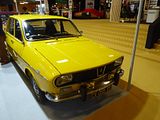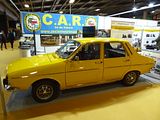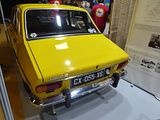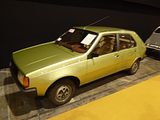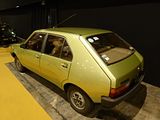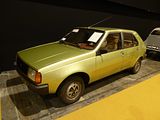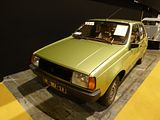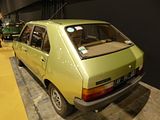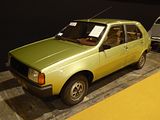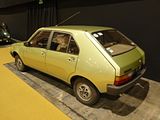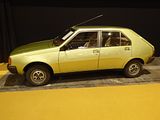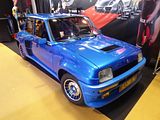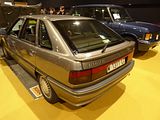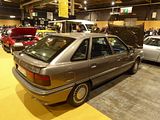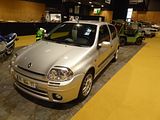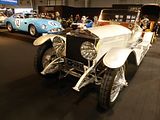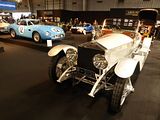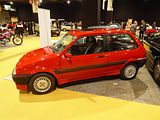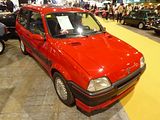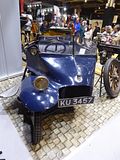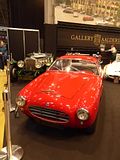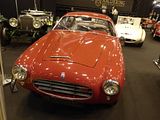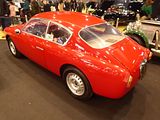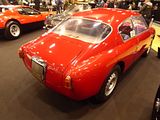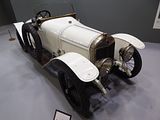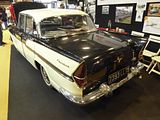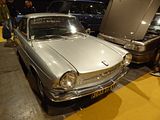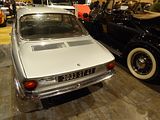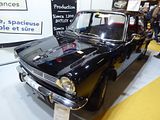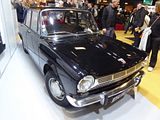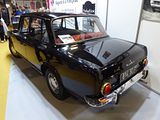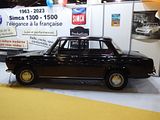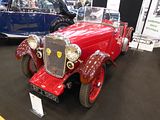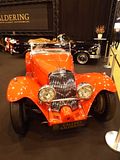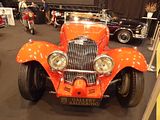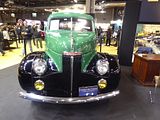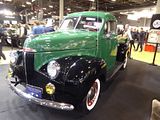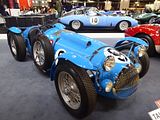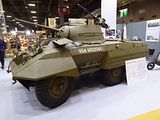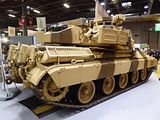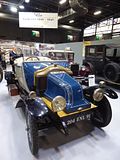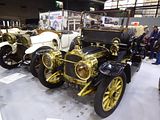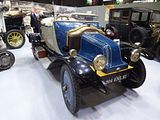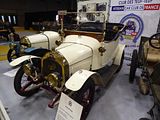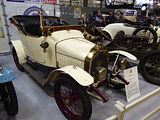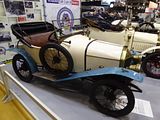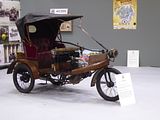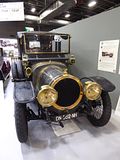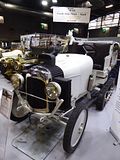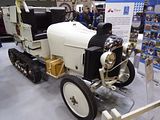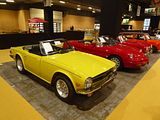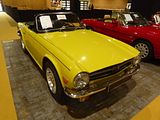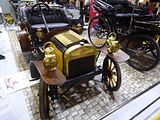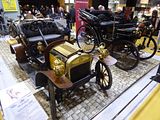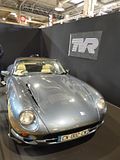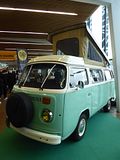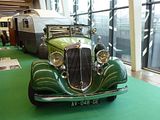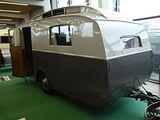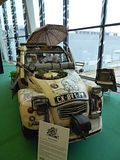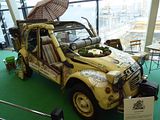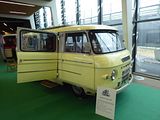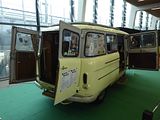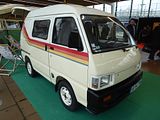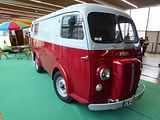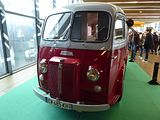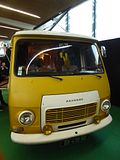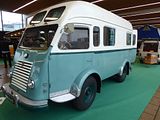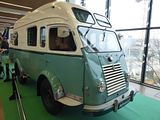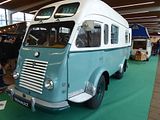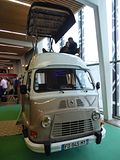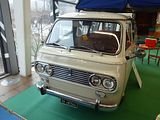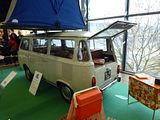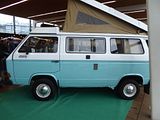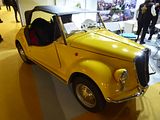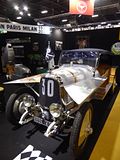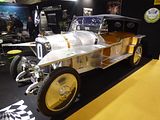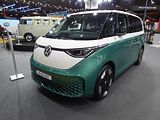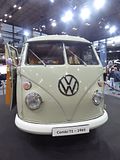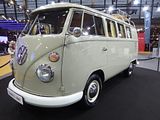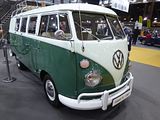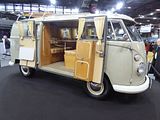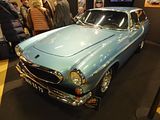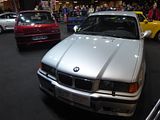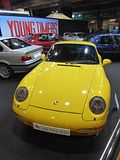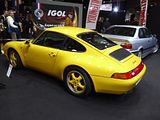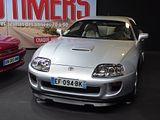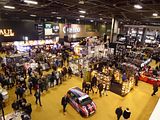Rétromobile in Paris claims the title of the biggest and best attended classic car show in Europe. Taking place around the start of February, it’s being running for more than 40 years now. This is one of few events that did happen in 2020, but needless to say the 2021 edition had to be cancelled and the 2022 edition was delayed a few weeks because of lingering Covid restrictions. By all accounts, it was a bit of a subdued event compared to previous ones. There was every expectation that for 2023 the event would be back to full strength and so it proved. Occupying three gigantic exhibition halls at the Porte de Versailles exhibition centre, which is on the south side of central Paris, there are more than 1000 exhibitors, with vast numbers of cars to see, with impressive displays from Simon Kidston, Girardo, Lukas Hüni, Axel Schütte, Fiskens, and more as well as clothing, books, model cars, automotive art, sculpture, ornaments, watches, tools, ephemera, spare parts and collectables on sale. The organisers always come up with a number of special themes, often the very non-obvious, and there are large manufacturer organised stands for all the French marques and a few others, as well as lots of high end dealers from across Europe and around 80 Car Clubs. A number of auction houses hold important sales during the time that the event is on, though there is not space for all of them on site, so most of these are held elsewhere, leaving just French Artcurial to fill a hall all by themselves with the cars they have on offer. A large area is reserved for private sellers offering a car under the Euro equivalent of $40,000 which was initiative first tried out a few years ago, and well received, so it has been repeated ever since, which opens up the opportunity for more affordable classics for those of us who did not inherit a Chateau. As well as the expected French marque of Citroen, Renault Peugeot and Simca, there were dozens of MGs, Triumph TRs of every number, multiple Alfa and Fiat coupes and sedans, and a smattering of the less exotic American cars. For those who stop for lunch, it should be no surprise that the catering runs to oysters, prawns and snails as well as the obligatory platters of cheese and charcuterie. Not a meat pie in sight. And – not a word of a lie – there are champagne vendors dotted around the halls, if you want something other than beer or ‘vin rouge’, also in plentiful supply. On the outside of the gigantic halls, members of a veteran car club offer short joy rides around the venue in their 1910-1920 era cars, raising funds for a children’s charity along the way. Fancy a spin around the block in a 1915 Renault or a survivor of the famed 1920’s Citroen half-track ‘Kégresse’? I arrived in time to have to wait for the gates to be opened, sand stayed until the covers were on many of the cars, the lights were starting to go out and the tannoy announcements were asking us all to leave. I think I saw everything but there is a lot to pack into a single day. There are around 960 photos in this report, which illustrate just why this is such a great event.
THE FIRST “CAR”
Dating from 1873, this Amedée Bollée l’Obeissante is considered one of the first self moving vehicle. This Steam engine propelled vehicle is operated with a coal fired boiler. It can carry twelve passengers at 30 kph with peak speed at 40 kph. The operation involved one operator for the coal fired boiler and a driver.
ABARTH
There is a complex history to the rest of the 600-based Abarths, starting with the 850TC, which actually predates the better known 595/695 cars. Officially known as the Fiat-Abarth 850TC Berlina (Turismo Competizione, or “touring competition”), it was introduced towards the end of 1960, using Fiat 600 bodywork with some modifications, most notably a boxlike structure ahead of the front bumper which held the engine’s oil cooler. The rear wings were usually blistered, to accommodate larger wheels. The engine is a four-cylinder model based on a Fiat unit, with 847 cc capacity and 51 hp. Overall length is 3,090 mm (122 in), overall width is 1,400 mm (55 in), height is 1,380 mm (54 in), wheelbase is 2,000 mm (80 in), and its front and rear track are 1,160 mm (46 in). The fuel tank holds 5.9 imperial gallons, and its empty weight was 793 kg (1,748 lb). The 850TC remained in the price lists until 1966. In 1962 the 850TC Nürburgring was introduced, with 55 PS at 6500 rpm. The name was intended to celebrate the class victory of an Abarth 850TC at the 1961 Nürburgring 500 km race. There followed the 850TC/SS with two more horsepower; this was renamed the 850TC Nürburgring Corsa towards the end of the year. Between 1962 and 1971 the 850cc and 1000cc class cars won hundreds of races all over the World and were commonly called “Giant Killers” due to their superior performance over much larger cars, culminating in a famous dispute with SCCA authorities in the USA when Alfred Cosentino (FAZA) was banned from running his 1970 Fiat Abarth Berlina Corsa 1000 TCR “Radiale” engine because his car was faster (mainly in wet conditions) to many V8 Mustangs, AMC AMX’s and Chev Camaro’s etc.The SCCA authorities dictated FAZA and Cosentino be forced to use an early design engine a non “Radiale” engine from 1962 model in his cars but still achieved 51 Victories from 53 races. The most victories in SCCA racing history, thereby cementing the superiority of the Fiat Abarth Berlina Corsa over larger and more powerful cars.
AC
AC had come back to the market after the Second World War with the staid 2-Litre range of cars in 1947, but it was with the Ace sports car of 1953 that the company really made its reputation in the post war years. Casting around for a replacement for the ageing 2-Litre, AC took up a design by John Tojeiro that used a light ladder type tubular frame, all independent transverse leaf spring suspension, and an open two seater alloy body made using English wheeling machines, possibly inspired by the Ferrari Barchetta of the day. Early cars used AC’s elderly 100 bhp two-litre overhead cam straight-six engine (first seen soon after the end of the First World War), which, according to a 1954 road test by Motor magazine, gave a top speed of 103 mph, a 0–60 mph in 11.4 seconds and a fuel consumption of 25.2 mpg. It was hardly a sporting engine, however, and it was felt that something more modern and powerful was required to put the modern chassis to good use. Joining the Ace in 1954 was the Aceca hard top coupé, which had an early form of hatchback rear door but used the same basic timber framed alloy body. From 1956, there was the option of Bristol Cars’ two-litre 120 bhp straight-six with 3 downdraught carburettors and slick four-speed gearbox. Top speed leapt to 116 mph with 0–60 mph in the nine second bracket. Overdrive was available from 1956 and front disc brakes were an option from 1957, although they were later standardised. In 1961 a new 2.6-litre straight-six ‘Ruddspeed’ option was available, adapted by Ken Rudd from the unit used in the Ford Zephyr. It used three Weber or SU carburettors and either a ‘Mays’ or an iron cast head. This setup boosted the car’s performance further, with some versions tuned to 170 bhp, providing a top speed of 130 mph and 0–60 mph in 8.1 seconds. However, it was not long before Carroll Shelby drew AC’s attention to the Cobra, so only 37 of the 2.6 models were made. These Ford engined models had a smaller grille which was carried over to the Cobra.
Like many British manufacturers, AC Cars had been using the Bristol straight-6 engine in its small-volume production, including its AC Ace two-seater roadster. This had a hand-built body with a steel tube frame, and aluminium body panels that were made using English wheeling machines. The engine was a pre-World War II design by BMW which by the 1960s was considered dated. In 1961 Bristol decided to cease production of its engine. In September 1961, American retired race car driver and automotive designer Carroll Shelby wrote to AC asking if they would build him a car modified to accept a V8 engine. Bristol engines for the AC Ace two-seater sports car had recently been discontinued so AC agreed, provided a suitable engine could be found. Shelby went to Chevrolet to see if they would provide him with engines, but not wanting to add competition to the Corvette they said no. However, Ford wanted a car that could compete with the Corvette and they happened to have a brand new engine which could be used in this endeavor: the Windsor 3.6-litre (221 cu in) engine – a new lightweight, thin-wall cast small-block V8. Ford provided Shelby with two engines. In January 1962 mechanics at AC Cars in Thames Ditton, Surrey designed the “AC Ace 3.6” prototype with chassis number CSX2000. AC had already made most of the modifications needed for the small-block V8 when they installed the 2.553-litre (156 cu in) inline 6 Ford Zephyr engine, including the extensive rework of the AC Ace’s front end bodywork. The only modification of the front end of the first Cobra from that of the “AC Ace 2.6” was the steering box, which had to be moved outward to clear the wider V8 engine. The most important modification was the fitting of a stronger rear differential to handle the increased engine power. A Salisbury 4HU unit with inboard disc brakes to reduce unsprung weight was chosen instead of the old E.N.V. unit. It was the same unit used on the Jaguar E-Type. After testing and modification, the engine and transmission were removed and the chassis was air-freighted to Shelby in Los Angeles on 2 February 1962, By this time the small-block’s displacement was increased to 4.7 L (289 cu in). Shelby’s team paired this engine along with a transmission into CSX2000, in less than eight hours at Dean Moon’s shop in Santa Fe Springs, California, and began road-testing. A few changes were made to the production version: The inboard brakes were moved outboard to reduce cost; the fuel tank filler was relocated from the fender to the cenre of the trunk; the trunk lid had to be shortened to accommodate this change. AC exported completed, painted, and trimmed cars (less engine and gearbox) to Shelby who then finished the cars in his workshop in Los Angeles by installing the engine and gearbox and correcting any bodywork flaws caused by the car’s passage by sea. A small number of cars were also completed on the East Coast of the US by Ed Hugus in Pennsylvania, including the first production car; CSX2001. The first 75 Cobra Mk1 models (including the prototype) were fitted with the 4.3 L (260 cu in). The remaining 51 Mk1 models were fitted with a larger version of the Windsor Ford engine, the 4.7-litre (289 cu in) V8. In late 1962, Alan Turner, AC’s chief engineer completed a major design change of the car’s front end to accommodate rack and pinion steering while still using transverse leaf spring suspension (with the leaf spring doubling as the upper suspension link). The new car entered production in early 1963 and was designated Mark II. The steering rack was borrowed from the MGB while the new steering column came from the VW Beetle. About 528 Mark II Cobras were produced from 1963 to the summer of 1965 (the last US-bound Mark II was produced in November 1964). In 1963 to keep production focused on producing cars for Shelby American Inc., the Ruddspeed Ace was discontinued. To supply cars to the European market, AC began to market and sell the Cobra in Europe. Advertisements from the time state that the Cobra was designed to meet the requirements of Shelby American Inc. Shelby experimented with a larger Ford FE engine, of 6.4 L (390 cu in) in chassis number CSX2196. Unfortunately, the car was not able to receive the development it needed, as resources were aimed at taking the crown from Ferrari in the GT class. Ken Miles drove and raced the FE-powered Mark II at Sebring and pronounced the car virtually undrivable, naming it “The Turd”. It failed to finish with the engine expiring due to damper failure. CSX2196 was revised for the showdown at Nassau which allowed a more relaxed class division of racing. This allowed the Cobras to run with a prototype Ford GT40, GM Grand Sport Corvettes and a Lola Mk6. An aluminium 6.4-litre (390 cu in) engine was used. By the end of the first lap, the Cobra had a lead of the length of the start-finish straight. However, the car failed to finish due to brake problems. A new chassis was required, developed, and designated Mark III. The new car was designed in cooperation with Ford in Detroit. A new chassis was built using 101.6 mm (4 in) main chassis tubes, up from 76.2 mm (3 in) and coil spring suspension all around (an especially significant change up front, where the previously-used transverse leaf spring had done double duty as the top link). The new car also had wide fenders and a larger radiator opening. It was powered by the “side oiler” Ford 7.0 L (427 cu in) FE engine equipped with a single 4-barrel 780 CFM Holley carburetor rated at 425 bhp at 6000 rpm and 651 N⋅m (480 lb⋅ft) at 3700 rpm of torque, which provided a top speed of 264 km/h (164 mph) in the standard model. The more powerful tune of 485 bhp with a top speed of 298 km/h (185 mph) in the semi-competition (S/C) model. Cobra Mark III production began on 1 January 1965; two prototypes had been sent to the United States in October 1964. Cars were sent to the US as unpainted rolling chassis, and they were finished in Shelby’s workshop. Unfortunately, The MK III missed homologation for the 1965 racing season and was not raced by the Shelby team. Only 56 of the 100 planned cars were produced. Of those, 31 unsold competition models were detuned and fitted with windscreens for street use. Called S/C for semi-competition, an original example can currently sell for US$1.5 million, making it one of the most valuable Cobra variants. Some Cobra 427s were actually fitted with Ford’s 7-litre (428 cu in) engine, a long stroke, smaller bore, lower cost engine, intended for road use rather than racing. The AC Cobra was a financial failure that led Ford and Carroll Shelby to discontinue importing cars from England in 1967. AC Cars kept producing the coil-spring AC Roadster with narrow fenders and a small block Ford 289. It was built and sold in Europe until late 1969.
ALFA ROMEO
Oldest Alfa models here were a number of examples of the rather fabulous 6C 1750. In the mid-1920s, Alfa’s RL was considered too large and heavy, so a new development began. The 2-litre formula that had led to Alfa Romeo winning the Automobile World Championship in 1925, changed to 1.5-litre for the 1926 season. The 6C 1500 was introduced in 1925 at the Milan Motor Show and production started in 1927, with the P2 Grand Prix car as starting point. Engine capacity was now 1487 cc, against the P2’s 1987 cc, while supercharging was dropped. The first versions were bodied by James Young and Touring. In 1928, a 6C Sport was released, with a dual overhead camshafts engine. Its sport version won many races, including the 1928 Mille Miglia. Total production was 3000 (200 with DOHC engine). Ten copies of a supercharged (compressore) Super Sport variant were also made. The more powerful 6C 1750 was introduced in 1929 in Rome. The car had a top speed of 95 mph, a chassis designed to flex and undulate over wavy surfaces, as well as sensitive geared-up steering. It was produced in six series between 1929 and 1933. The base model had a single overhead cam; Super Sport and Gran Sport versions had double overhead cam engines. Again, a supercharger was available. Most of the cars were sold as rolling chassis and bodied by coachbuilders such as Zagato, and Touring. Additionally, there were 3 examples built with James Young bodywork. In 1929, the 6C 1750 won every major racing event it was entered, including the Grands Prix of Belgium, Spain, Tunis and Monza, as well as the Mille Miglia was won with Giuseppe Campari and Giulio Ramponi, the Brooklands Double Twelve and the Ulster TT was won also, in 1930 it won again the Mille Miglia and Spa 24 Hours. Total production was 2635.
In 1924, Vittorio Jano created his first straight-eight-cylinder engine for Alfa Romeo, the 1987 cc P2, with common crankcase and four plated-steel two-cylinder blocks, which won the first World Championship ever in 1925. Although it was a straight-8, the 8C designation was not used. The 8C engine, first entered at the 1931 Mille Miglia road race through Italy,[2] had a common crankcase, now with two alloy four-cylinder blocks, which also incorporated the heads. The bore and stroke (and hence rods, pistons and the like), were the same as the 6C 1750 (bore: 65 mm, stroke: 88 mm 2,336 cc). There was no separate head, and no head gasket to fail, but this made valve maintenance more difficult. A central gear tower drove the overhead camshafts, superchargers and ancillaries. As far as production cars are concerned, the 8C engine powered two models, the 8C 2300 (1931–1935) and the even more rare and expensive 8C 2900 (1936–1941), bore increased to 68 mm and stroke to 100 mm (2,905 cc). At the same time, since racing cars were no longer required to carry a mechanic, Alfa Romeo built the first single seater race car. As a first attempt, the 1931 Monoposto Tipo A used a pair of 6-cylinder engines fitted side by side in the chassis. As the resulting car was too heavy and complex, Jano designed a more suitable and successful racer called Monoposto Tipo B (aka P3) for the 1932 Grand Prix season. The Tipo B proved itself the winning car of its era, winning straight from its first outing at the 1932 Italian Grand Prix, and was powered with an enlarged version of the 8C engine now at 2,665 cc, fed through a pair of superchargers instead of a single one. Initially, Alfa Romeo announced that the 8C was not to be sold to private owners, but by autumn 1931 Alfa sold it as a rolling chassis in Lungo (long) or Corto (short) form with prices starting at over £1000. The chassis were fitted with bodies from a selection of Italian coach-builders (Carrozzeria) such as Zagato, Carrozzeria Touring, Carrozzeria Castagna, Carrozzeria Pinin Farina ( later Pininfarina ) and Brianza, even though Alfa Romeo did make bodies. Some chassis were clothed by coach-builders such as Graber, Worblaufen and Tuscher of Switzerland and Figoni of France. Alfa Romeo also had a practice of rebodying cars for clients, and some racing vehicles were sold rebodied as road vehicles. Some of the famous first owners include Baroness Maud Thyssen of the Thyssen family, the owner of the aircraft and now scooter company Piaggio Andrea Piaggio, Raymond Sommer, and Tazio Nuvolari. The first model was the 1931 ‘8C 2300’, a reference to the car’s 2.3 litre (2336 cc) engine, initially designed as a racing car, but actually produced in 188 units also for road use. While the racing version of the 8C 2300 Spider, driven by Tazio Nuvolari won the 1931 and 1932 Targa Florio race in Sicily, the 1931 Italian Grand Prix victory at Monza gave the “Monza” name to the twin seater GP car, a shortened version of the Spider. The Alfa Romeo factory often added the name of events won to the name of a car.
One of many fabulous cars on Swiss-based Simon Kidston’s stand was this gorgeous 8C 2900B Touring Berlinetta. This Alfa Romeo 8C 2900B Berlinetta 1938 with bodywork by Touring was entered by Jon Shirley from the U.S.A. at the 2009 Concorso d’Eleganza Villa d’Este. The car collected a full Roll of Honour with the Coppa d’Oro Villa d’Este for the best show by the Jury, the Trofeo BMW Group for the best show by the Jury, the Trofeo BMW Group Italia by public referendum at Villa Erba as well as Class Winner in Prewar Closed Cars category. The engine is a 8 cylinder 2905 cc. Some 40 cars were manufactured after 1935. In line with the Company’s policy at the time, Alfa Romeo produced the chassis and the engine, while the bodies were manufactured by a coachbuilder, Touring in the present case.
Introduced in 1938, the 6C 2500 (2,443 cc) was the final 6C road car. World War II was coming and car development was stopped, but a few hundred 6C 2500s were built from 1940 to 1945. Postwar, the first new Alfa model was the 1946 6C 2500 Freccia d’Oro (Golden Arrow), of which 680 were built until late 1951, with bodies by Alfa. The 2500 had an enlarged engine compared to the predecessor model; this Vittorio Jano designed dual overhead cam engine was available with either one or three Weber carburettors. The triple carburettor version was used in the top-of-the-range SS (Super Sport) version. The 2,443 cc straight-six engine was bored out from 70 mm (2.8 in) to 72 mm (2.8 in) and was mounted onto a steel ladder frame chassis, which was offered with three wheelbases: 3,250 mm (128.0 in) on the Turismo, 3,000 mm (118.1 in) on the Sport and 2,700 mm (106.3 in) on the Super Sport. Various coachbuilders built their own bodied versions of the 2500, but most bodywork was built by Touring Superleggera of Milan. The Tipo 256 was a racing version of 2500 made in eight examples between 1939 and 1940 for the Mille Miglia and the Le Mans 24 Hours. It was made in Spider (convertible) and Berlinetta (coupe) Touring bodystyles. With a power of 125 bhp it could achieve a top speed of 200 kilometres per hour (120 mph). The car was sold to wealthy customers like King Farouk, Alì Khan, Rita Hayworth, Tyrone Power, and Prince Rainier. One was also featured in The Godfather in 1972. The 2500 was one of the most expensive cars available in its time. The final 6C was built in 1952 and the model was replaced by the 1900.
The 1900C was introduced in 1951 as the coupe version of the four-door Alfa Romeo 1900. The addition of the C in the name wasn’t for coupe as many assume, but for corto – the Italian word for short. Although the 1900 model series was the first with a unibody chassis, and the the first to be fitted with the new 1884cc DOHC inline-4, the then general manager of Alfa Romeo, Iginio Alessio, chose to develop the unibody chassis in such a way that the iconic Italian carrozzerie, or coachbuilders, could build custom bodies for it. He had become concerned with the difficulty posed by creating custom bodies for these newly engineered cars – and as a result of this decision the Alfa Romeo 1900 and 1900C were both bodied by some of the greatest names in Italian coachbuilding – including Zagato, Touring, Pinin Farina, Bertone, Boneschi, Boano, Colli, Stabilimenti Farina, Vignale, and of course, Ghia. Alfa Romeo gave official contracts to Touring to build the sporty 1900 Sprint coupé and to Pinin Farina to build an elegant four seat Cabriolet and Coupé. Carrozzeria Zagato built a small series of coupés with the unofficial designation of 1900 SSZ, designed for racing with an aerodynamic lightweight aluminium body and Zagato’s trademark double bubble roof. One-off specials were numerous, from the famous Bertone BAT series of aerodynamic studies, to an infamous sci-fi like Astral spider designed by Carrozzeria Boneschi for Rafael Trujillo the dictator of the Dominican Republic. There was a Barchetta or “Boat Car” made by Ghia-Aigle in Lugano Switzerland designed by Giovanni Michelotti at the request of a wealthy Italian who had two passions: the ‘Riva’ boats and a woman, his mistress, the car has no doors or windscreen wipers. Seen on the Alfa Classiche part of the Stellantis stand was this 1900C Farina.
The Kidston stand did not have any cars with Le Mans history. The only one with racing genes was the 1955 Alfa Romeo 1900 SS Zagato. This red/white Alfa was once delivered new to Italian chocolatier Vittorio Vanini and who immediately took part in the Mille Miglia with it. With 19th place out of 661 participants, this was also a fine performance.
Following the 1900 family, Alfa’s next new model range would be cheaper and aimed at capturing some of the market from middle class buyers. Known as Giulietta, the 750 and later 101 Series were a series of family-sized cars made from 1954 to 1965, and Alfa Romeo’s first, successful, foray into the 1.3-litre class. The first to be introduced was the Giulietta Sprint 2+2 coupé which was premiered at the 1954 Turin Motor Show. Designed by Franco Scaglione at Bertone, it was produced at the coachbuilder’s Grugliasco plant, near Turin. A year later, at the Turin Motor Show in April 1955, the Sprint was joined by the 4-door saloon Berlina. In mid 1955, the open two-seat Giulietta Spider, featuring convertible bodywork by Pininfarina arrived. The Giulietta used unibody construction and a front-engine, rear-wheel-drive layout. Front suspension was by control arms, with coaxial coil springs and hydraulic dampers. At the rear there was a solid axle on coil springs and hydraulic dampers. The axle was located by a longitudinal link on each side, and by a wishbone-shaped arm linking the top of the aluminium differential housing to the chassis. All Giuliettas (save for the last SZ examples) had hydraulic drum brakes on all four corners. The Giulietta used an Alfa Romeo Twin Cam straight-four of 1290 cc, with an aluminium alloy engine block and cast iron inserted sleeves. Bore and stroke measured 74.0 mm and 75.0 mm. The aluminium alloy cylinder head was of a crossflow design and featured hemispherical combustion chambers. The double overhead camshafts were driven by two timing chains, and acted on two valves per cylinder, angled 80°. In 1957 a more powerful Berlina version, called Giulietta T.I. (Turismo Internazionale) was presented with minor cosmetic changes to the bonnet, the dial lights and rear lamps. Carrozzeria Colli also made the Giulietta station wagon variant called Giulietta Promiscua. Ninety-one examples of this version were built. Carrozzeria Boneschi also made a few station wagon examples called Weekendina. A new version of the Giulietta Berlina debuted at the Frankfurt Motor Show in 1959. Mechanical changes were limited to shifting the fuel pump from the cylinder head to a lower position below the distributor, and moving the previously exposed fuel filler cap from the tail to the right rear wing, under a flap. The bodywork showed a revised front end, with more rounded wings, recessed head lights, and new grilles with chrome frames and two horizontal bars. The rear also showed changes, with new larger tail lights on vestigial fins, which replaced the earlier rounded rear wings. The interior was much more organised and upholstered in new cloth material; the redesigned dashboard included a strip speedometer flanked by two round bezels, that on the T.I. housed a tachometer and oil and water temperature gauges. The T.I. also received a front side repeater mounted in a small spear, unlike the Normale which kept the earlier small round lamp with no decorations. During 1959 the type designation for all models was changed from 750 and 753 to 101. In February 1961 the 100,001st Giulietta rolled out of the Portello factory, with a celebration sponsored by Italian actress Giulietta Masina. In Autumn 1961 the Giulietta was updated a second time. Both Normale and T.I. had revised engines and new exhaust systems; output rose to 61 bhp and 73 bhp. With this new engine the car could reach a speed of almost 100mph. At the front of the car square mesh side grilles were now pieced together with the centre shield, and at the rear there were larger tail lights. Inside the T.I. had individual instead of bench seats, with storage nets on the seatbacks. June 1962 saw the introduction of the Alfa Romeo Giulia, which would eventually replace the Giulietta. As until 1964 the Giulia only had a larger 1.6-litre engine, production of the standard Berlina ended with 1963, whilst the T.I. continued for a full year more. A last T.I. was completed in 1965. The Giulietta sport models had a different fate: Sprint, Sprint Speciale and Spider were fitted with the new 1.6-litre engine, received some updates and continued to be sold under the Giulia name until they were replaced by all-new Giulia-based models during 1965. These days., the Berlina is the model you see the least often. A few of the model are used in historic racing where the car takes on the might of those with far larger engines. A total of 177,690 Giuliettas were made, the great majority in Berlina saloon, Sprint coupé or Spider roadster body styles.
There’s a complex history to this much-loved classic. The first car was called the Alfa Romeo Giulia Sprint GT, and was revealed at a press event held at the then newly opened Arese plant on 9 September 1963, and displayed later the same month at the Frankfurt Motor Show. In its original form the Bertone body is known as scalino (step) or “step front”, because of the leading edge of the engine compartment lid which sat 1/4 an inch above the nose of the car. The Giulia Sprint GT can be distinguished from the later models by a number of features including: Exterior badging: Alfa Romeo logo on the front grille, a chrome script reading “Giulia Sprint GT” on the boot lid, and rectangular “Disegno di Bertone” badges aft of the front wheel arches; flat, chrome grille in plain, wide rectangular mesh without additional chrome bars; single-piece chrome bumpers; no overriders. Inside the cabin the padded vinyl dashboard was characterised by a concave horizontal fascia, finished in grey anti-glare crackle-effect paint. Four round instruments were inset in the fascia in front of the driver. The steering wheel was non-dished, with three aluminium spokes, a thin bakelite rim and a centre horn button. Vinyl-covered seats with cloth centres and a fully carpeted floor were standard, while leather upholstery was an extra-cost option. After initially marketing it as a four-seater, Alfa Romeo soon changed its definition of the car to a more realistic 2+2. The Giulia Sprint GT was fitted with the 1,570 cc version of Alfa Romeo’s all-aluminium twin cam inline four (78 mm bore × 82 mm stroke), which had first debuted on the 1962 Giulia Berlina. Breathing through two twin-choke Weber 40 DCOE 4 carburettors, on the Sprint GT this engine produced 105 hp at 6,000 rpm. Like all subsequent models, the Sprint GT was equipped with an all-synchromesh 5-speed manual transmission. The braking system comprised four Dunlop disc brakes and a vacuum servo. The rear brakes featured an unusual arrangement with the slave cylinders mounted on the axle tubes, operating the calipers by a system of levers and cranks. According to Alfa Romeo the car could reach a top speed of “over 180 km/h (112 mph)”. In total 21,902 Giulia Sprint GT were produced from 1963 to 1965, when the model was superceded by the Giulia Sprint GT Veloce. Of these 2,274 were right hand drive: 1,354 cars fully finished in Arese, and 920 shipped in complete knock-down kit form for foreign assembly. For 1966, the Giulia Sprint GT was replaced by the Alfa Romeo Giulia Sprint GT Veloce, which was very similar but featuring a number of improvements: a revised engine—slightly more powerful and with more torque—better interior fittings and changes to the exterior trim. Alongside the brand new 1750 Spider Veloce which shared its updated engine the Sprint GT Veloce was introduced at the 36th Geneva Motor Show in March 1966, and then tested by the international specialist press in Gardone on the Garda Lake. Production had began in 1965 and ended in 1968. The Giulia Sprint GT Veloce can be most easily distinguished from other models by the following features: badging as per Giulia Sprint GT, with the addition of round enamel badges on the C-pillar—a green Quadrifoglio (four-leaf clover) on an ivory background—and a chrome “Veloce” script on the tail panel; black mesh grille with three horizontal chrome bars; the grille heart has 7 bars instead of 6; stainless steel bumpers, as opposed to the chromed mild steel bumpers on the Giulia Sprint GT. The bumpers are the same shape, but are made in two pieces (front) and three pieces (rear) with small covers hiding the joining rivets. Inside the main changes from the Giulia Sprint GT were imitation wood dashboard fascia instead of the previous anti-glare grey finish, front seats revised to a mild “bucket” design, and a dished three aluminium spoke steering wheel, with a black rim and horn buttons through the spokes. The Veloce’s type 00536 engine, identical to the Spider 1600 Duetto’s, featured modifications compared to the Giulia Sprint GT’s type 00502—such as larger diameter exhaust valves. As a result it produced 108 hp at 6,000 rpm, an increase of 3 hp over the previous model, and significantly more torque. The top speed now exceeded 185 km/h (115 mph). Early Giulia Sprint GT Veloces featured the same Dunlop disc brake system as the Giulia Sprint GT, while later cars substituted ATE disc brakes as pioneered on the GT 1300 Junior in 1966. The ATE brakes featured an handbrake system entirely separate from the pedal brakes, using drum brakes incorporated in the rear disc castings. Though the Sprint GT Veloce’s replacement—the 1750 GT Veloce—was introduced in 1967, production continued throughout the year and thirty final cars were completed in 1968. By then total Giulia Sprint GT Veloce production amounted to 14,240 examples. 1,407 of these were right hand drive cars, and 332 right hand drive complete knock-down kits. The Alfa Romeo 1750 GT Veloce (also known as 1750 GTV) appeared in 1967 along with the 1750 Berlina sedan and 1750 Spider. The same type of engine was used to power all three versions; this rationalisation was a first for Alfa Romeo. The 1750 GTV replaced the Giulia Sprint GT Veloce and introduced many updates and modifications. Most significantly, the engine capacity was increased to 1779 cc displacement. Peak power from the engine was increased to 120 hp at 5500 rpm. The stroke was lengthened from 82 to 88.5 mm over the 1600 engine, and a reduced rev limit from 7000 rpm to 6000 rpm. Maximum torque was increased to 137 lb·ft at 3000 rpm. A higher ratio final drive was fitted (10/41 instead of 9/41) but the same gearbox ratios were retained. The result was that, on paper, the car had only slightly improved performance compared to the Giulia Sprint GT Veloce, but on the road it was much more flexible to drive and it was easier to maintain higher average speeds for fast touring. For the United States market, the 1779 cc engine was fitted with a fuel injection system made by Alfa Romeo subsidiary SPICA, to meet emission control laws that were coming into effect at the time. Fuel injection was also featured on Canadian market cars after 1971. Carburettors were retained for other markets. The chassis was also significantly modified. Tyre size went to 165/14 from 155/15 and wheel size to 5 1/2J x 14 instead of 5J x 15, giving a wider section and slightly smaller rolling diameter. The suspension geometry was also revised, and an anti-roll bar was fitted to the rear suspension. ATE disc brakes were fitted from the outset, but with bigger front discs and calipers than the ones fitted to GT 1300 Juniors and late Giulia Sprint GT Veloces. The changes resulted in significant improvements to the handling and braking, which once again made it easier for the driver to maintain high average speeds for fast touring. The 1750 GTV also departed significantly from the earlier cars externally. New nose styling eliminated the “stepped” bonnet of the Giulia Sprint GT, GTC, GTA and early GT 1300 Juniors and incorporated four headlamps. For the 1971 model year, United States market 1750 GTV’s also featured larger rear light clusters (there were no 1970 model year Alfas on the US market). Besides the chrome “1750” badge on the bootlid, there was also a round Alfa Romeo badge. Similar Quadrofoglio badges to those on the Giulia Sprint GT Veloce were fitted on C pillars, but the Quadrofoglio was coloured gold instead of green. The car also adopted the higher rear wheelarches first seen on the GT 1300 Junior. The interior was also much modified over that of earlier cars. There was a new dashboard with large speedometer and tachometer instruments in twin binnacles closer to the driver’s line of sight. The instruments were mounted at a more conventional angle, avoiding the reflections caused by the upward angled flat dash of earlier cars. Conversely, auxiliary instruments were moved to angled bezels in the centre console, further from the driver’s line of sight than before. The new seats introduced adjustable headrests which merged with the top of the seat when fully down. The window winder levers, the door release levers and the quarterlight vent knobs were also restyled. The remote release for the boot lid, located on the inside of the door opening on the B-post just under the door lock striker, was moved from the right hand side of the car to the left hand side. The location of this item was always independent of whether the car was left hand drive or right hand drive. Early (Series 1) 1750 GTV’s featured the same bumpers as the Giulia Sprint GT Veloce, with the front bumper modified to mount the indicator / sidelight units on the top of its corners, or under the bumper on US market cars. The Series 2 1750 GTV of 1970 introduced other mechanical changes, including a dual circuit braking system (split front and rear, with separate servos). The brake and clutch pedals on left hand drive cars were also of an improved pendant design, instead of the earlier floor-hinged type. On right hand drive cars the floor-hinged pedals were retained, as there was no space for the pedal box behind the carburettors. Externally, the series 2 1750 GTV is identified by new, slimmer bumpers with front and rear overriders. The combined front indicator and sidelight units were now mounted to the front panel instead of the front bumper, except again on the 1971-72 US/Canadian market cars. The interior was slightly modified, with the seats retaining the same basic outline but following a simpler design. 44,269 1750 GTVs were made before their replacement came along. That car was the 2000GTV. Introduced in 1971, together with the 2000 Berlina sedan and 2000 Spider, the 2 litre cars were replacements for the 1750 range. The engine displacement was increased to 1962 cc. The North American market cars had fuel injection, but everyone else retained carburettors. Officially, both versions generated the same power, 130 hp at 5500 rpm. The interior trim was changed, with the most notable differences being the introduction of a separate instrument cluster, instead of the gauges installed in the dash panel in earlier cars. Externally the 2000 GTV is most easily distinguished by its grille with horizontal chrome bars, featuring protruding blocks forming the familiar Alfa heart in outline, smaller hubcaps with exposed wheel nuts, optional aluminium alloy wheels of the same size as the standard 5. 1/2J × 14 steel items, styled to the “turbina” design first seen on the alloy wheels of the Alfa Romeo Montreal, and the larger rear light clusters first fitted to United States market 1750 GTV’s were standard for all markets. From 1974 on, the 105 Series coupé models were rationalised and these external features became common to post-1974 GT 1300 Junior and GT 1600 Junior models, with only few distinguishing features marking the difference between models. 37,459 2000 GTVs were made before production ended and these days they are very sought after with prices having sky-rocketed in recent years.
Alfa replaced the Giulia-based Spider model with an all-new design which finally made its debut in 1966 together with the Giulia Sprint GT Veloce at an event organised in Gardone Riviera. With its boat tailed styling, it quickly found favour, even before taking a starring role in the film “The Graduate”. The original 1600cc engine was replaced by a more powerful 1750cc unit at the same time as the change was made to the rest of the range, and the car continued like this until 1970, when the first significant change to the exterior styling was introduced on the 1750 Spider Veloce, with the original’s distinctive elongated round tail changed to a more conventional cut-off tail, called the “Kamm tail”, as well as improving the luggage space. Numerous other small changes took place both inside and out, such as a slightly different grille, new doorhandles, a more raked windscreen, top-hinged pedals and improved interior trim. 1971 saw the Spider Veloce get a new, larger powerplant—a 1962 cc, 132 hp unit—and consequently the name was changed from 1750 Spider Veloce to 2000 Spider Veloce. The 1600 Spider restarted production a year later as the Spider 1600 Junior, and was visually identical to the 1300. 1974 saw the introduction of the rare, factory request, Spider-Targa. Based upon the Spider, it featured a Porsche style solid rear window and lift out roof panels, all made out of black GRP type material. Less than 2,000 models of such type were ever made and was the only part solid roof Spider until the introduction of the factory crafted hard top. The 1300 and 2000 cars were modified in 1974 and 1975 respectively to include two small seats behind the front seats, becoming a “two plus two” four seater. The 1300 model was discontinued in 1977. Also, between 1974 and 1976, the early-style stainless-steel bumpers were discontinued and replaced with black, rubber-clad units to meet increasingly stringent North American crash requirements. 4,557 examples of the 1300 Junior were made and 4,848 of the 1600 Junior as well as 16,320 2000 Spider Veloces and 22,059 of 2000 Spider Veloce US version. There were also 4,027 1750 Spider Veloces produced.
The S4, the final major change to the long running Spider came in 1990, and mechanically, the biggest different was the use of Bosch Motronic electronic fuel injection with an electric fan. Externally, the Spider lost its front under-bumper spoiler and the rather ungainly rear boot spoiler of the S3, and picked up 164-style rear lights stretching across the width of the car as well as plastic bumpers the same colour as the car. This also marked the first generation of the car with automatic transmission, as well as on-board diagnostics capabilities. The car had remained in production largely thanks to continued demand in North America, though this market had to wait until 1991 for the changes to appear on their cars. European markets were offered a car with a 1600cc engine and carburettors as well as the 2 litre injected unit. Production finally ended in 1993, with an all new model, the 916 Series Spider appearing a year later. The S4 car was not officially sold in the UK, but plenty have found their way to our shores since then.
Alfa Romeo had explored building a smaller front wheel drive car in the 1950s but it was not until 1967 that firm plans were laid down for an all-new model to fit in below the existing Alfa Romeo range. It was developed by Austrian Rudolf Hruska, who created a unique engineering package, clothed in a body styled by Giorgetto Giugiaro of ItalDesign. The car was built at a new factory at Pomigliano d’Arco in southern Italy, hence the car’s name, Alfa Sud (Alfa South). January 18, 1968, saw the registration at Naples of a new company named “Industria Napoletana Costruzioni Autoveicoli Alfa Romeo-Alfasud S.p.A.”. 90% of the share capital was subscribed by Alfa Romeo and 10% by Finmeccanica, at that time the financial arm of the government controlled IRI. Construction work on the company’s new state sponsored plant at nearby Pomigliano d’Arco began in April 1968, on the site of an aircraft engine factory used by Alfa Romeo during the war. The Alfasud was shown at the Turin Motor Show three years later in 1971 and was immediately praised by journalists for its styling. The four-door saloon featured an 1,186 cc Boxer water-cooled engine with a belt-driven overhead camshaft on each cylinder head. It also featured an elaborate suspension setup for a car in its class (MacPherson struts at the front and a beam axle with Watt’s linkage at the rear). Other unusual features for this size of car were four-wheel disc brakes (with the front ones being inboard) and rack and pinion steering. The engine design allowed the Alfasud a low bonnet line, making it very aerodynamic (for its day), and in addition gave it a low centre of gravity. As a result of these design features, the car had excellent performance for its engine size, and levels of roadholding and handling that would not be equaled in its class for another ten years. Despite its two-box shape, the Alfasud did not initially have a hatchback. Some of the controls were unorthodox, the lights, turn indicators, horn, wipers and heater fan all being operated by pulling, turning or pushing the two column stalks. In November 1973 the first sport model joined the range, the two-door Alfasud ti—(Turismo Internazionale, or Touring International).Along with a 5-speed gearbox, it featured a more powerful version of the 1.2 engine, brought to 67 hp by adopting a Weber twin-choke carburettor; the small saloon could reach 160 km/h. Quad round halogen headlamps, special wheels, a front body-colour spoiler beneath the bumper and rear black one around the tail distinguished the “ti”, while inside there were a three-spoke steering wheel, auxiliary gauges, leatherette/cloth seats, and carpets in place of rubber mats. In 1974, Alfa Romeo launched a more upscale model, the Alfasud SE. The SE was replaced by the Alfasud L (Lusso) model introduced at the Bruxelles Motor Show in January 1975. Recognisable by its bumper overriders and chrome strips on the door sills and on the tail, the Lusso was better appointed than the standard Alfasud (now known as “normale”), with such features as cloth upholstery, headrests, padded dashboard with glove compartment and optional tachometer. A three-door estate model called the Alfasud Giardinetta was introduced in May 1975. It had the same equipment of the Alfasud “L”. It was never sold in the UK and these models are particularly rare now. The Lusso model was produced until 1976, by then it was replaced with the new Alfasud 5m (5 marce, five speed) model, the first four-door Alfasud with a five-speed gearbox. Presented at the March 1976 Geneva Motor Show, it was equipped like the Lusso it replaced. In late 1977 the Alfasud Super replaced the range topping four-door “5m”; it was available with both the 1.2- and 1.3-litre engines from the “ti”, though both equipped with a single-choke carburettor.The Super introduced improvements both outside, with new bumpers including large plastic strips, and inside, with a revised dashboard, new door cards and two-tone cloth seats. Similar upgrades were applied to the Giardinetta. In May 1978 the Sprint and “ti” got new engines, a 78 hp 1.3 (1,350 cc) and a 84 hp 1.5 (1,490 cc), both with a twin-choke carburettor. At the same time the Alfasud ti received cosmetic updates (bumpers from the Super, new rear spoiler on the boot lid, black wheel arch extensions and black front spoiler) and was upgraded to the revised interior of the Super. The 1.3 and 1.5 engines were soon made available alongside the 1.2 on the Giardinetta and Super, with a slightly lower output compared to the sport models due to a single-choke carburettor. All Alfasuds were upgraded in 1980 with plastic bumpers, new instrument panel, headlamps and rear lights as well as other revisions. The Ti version was now fitted with a twin-carburettor version of the 1490 cc engine that had been fitted to the Sprint the previous year, developing 95 bhp A three-door hatchback was added to the range in 1981 in either SC or Ti trim and the two-door Ti and Giardinetta were deleted from most markets around this time. Belatedly in 1982 the four-door cars were replaced by five-door versions as by now, most of its competitors were producing a hatchback of this size, although some also produced a saloon alternative. The range was topped by the five-door Gold Cloverleaf, featuring the 94 hp engine from the Ti and enhanced interior trim. In 1983 an attempt to keep pace with the hot hatchback market, the final version of the Alfasud Ti received a tuned 1490 cc engine developing 105 PS Now named Quadrifoglio Verde (Green Cloverleaf) this model was also fitted with Michelin low profile TRX tyres on metric rims as well as an enhanced level of equipment. The five-door Alfasud saloons were replaced by the 33 models in 1983. The 33 was an evolution of the AlfaSud’s floorpan and running gear, including minor suspension changes and a change from four-wheel disc brakes to front disc and rear drum brakes to reduce costs. The three-door versions continued for a further year before being replaced by the unsuccessful Alfa Romeo Arna a joint venture between Alfa Romeo and Nissan.
As was still the practice in the 1970s, Alfa followed up the launch of the Alfetta Berlina with a very pretty coupe. Styled by Giugiaro, this car, initially called the GT, and premiered in the autumn of 1974, looked completely unlike the saloon on which it was based. The first cars had 1.8 litre four cylinder engines and there was one of those on show. In 1976 the range was expanded both up and down with a 1.6 and a 2.0 model, the latter adopting the legendary GTV name. In 1981, with the 2.5 litre V6 engine that had been developed for the ill-fated Alfa 6 luxury saloon available, Alfa was able to create a true rival for the 2.8 litre Capri with the GTV6. A facelift modernised the look of the car with plastic bumpers front and rear and a new interior looked rather better as well as being more ergonomically logical. There was a good mix of the earlier chrome bumpered and later plastic bumpered models, the last with 2.0 and 2.5 GTV6 versions both represented. There was also a car sporting 3.0 badging and right hand drive. This is a South African car. From 1974 South African Alfetta’s were manufactured at Alfa Romeo’s own Brits plant. South Africa was one of two markets to have a turbocharged GTV6, with a Garrett turbocharger and a NACA intake. An estimated 750 were assembled before all production ceased in 1986. The South African range included a 3.0 litre GTV-6, predating the international debut of the factory’s 3.0 litre engine in 1987 (for the Alfa 75). and 212 of these were built in South Africa for racing homologation. The last 6 GTV-6 3.0’s were fuel injected. To this day, the GTV-6 remains the quintessential Alfa Romeo for South Africans.
It was more than 10 years after the Montreal had ceased production before Alfa offered another high-end and costly Coupe model, and the result, seen for the first time in 1989, could hardly have been more different than its forebear. That car had been praised for its looks, whereas this one, the SZ, and cruelly nicknamed “Il Mostro”, was almost wilfully, well, “different”. First seen at the 1989 Geneva Show, the car was also first shown simply as a concept, called the ES-30, for Experimental Sports car 3 litre. It was produced by Zagato. Robert Opron of the Fiat design studio was responsible for the initial sketches while Antonio Castellana was largely responsible for the final styling details and interior. Only the ‘Z’ logo of Zagato was kept. The car possessed unusual headlights positioned in a trio on each side – a styling used more subtly on later Alfa Romeos in the 2000s. Mechanically and engine-wise, the car was based on the Alfa 75, production being carried out by Zagato at Terrazzano di Rho near the Alfa factory in Arese. The thermoplastic injection moulded composite body panels were produced by Italian company Carplast and French company Stratime Cappelo Systems. The suspension was taken from the Alfa 75 Group A/IMSA car, and modified by Giorgio Pianta, engineer and team manager of the Lancia and Fiat rally works team. A hydraulic damper system was made by Koni. The SZ was originally equipped with Pirelli P Zero tyres (front 205/55 ZR 16, rear 225/50 ZR 16) and is able to sustain over 1.1 G in cornering, some drivers have measured a cornering force of 1.4 G, which remains an excellent performance figure. Low volume production got underway late in 1989, and over the next three years, 1036 were built, slightly more than planned. With the exception of a black car made for Zagato, all of them were red. Subsequently a convertible version, the RZ (for Roadster Zagato), was produced from 1992 until December 1994. Although almost identical to look at the two cars had completely different body panels save for the front wings and boot. The RZ had a revised bumper and door sills to give better ground clearance and the bonnet no longer featured the aggressive ridges. Three colours were available as standard: black, yellow and red, with black and yellow being the more popular choices. Yellow and red cars got a black leather interior and black cars burgundy. Although the interior layout was almost unchanged from the SZ, the RZ had a painted central console that swept up between the seats to conceal the convertible roof storage area. 350 units were planned but production was halted after 252 units when the Zagato factory producing the cars for Alfa Romeo went in to receivership, a further 32 cars were then completed under the control of the receivers before production finished at 284 units. Of those final three were painted silver with burgundy interior and another pearlescent white.
ARTCURIAL AUCTION
Just one of the auctions that take place during the event is actually on site and that is for French-based auction house Artcurial. They have a huge display taking over most of Hall 2 for the cars they hope to sell. Like most auctions, though, you have to pay for a catalogue to gain entry and the asking price for this was an utterly ridiculous €80, which is the highest I have ever seen and was four times the cost of the entry to the show. At that price, I had to content myself with what I could see from the perimeter of the displays, which was quite a lot though clearly only a subset of the cars on offer. Auctions were held on both the Friday and Saturday, with the highlight of the sale on the first day being the 250 LM, and on Saturday the SLR McLaren Stirling Moss. Unfortunately, neither sold. Other sale highlights included a high-mileage Porsche 959 Komfort, a red Carrera GT, a Ferrari 340 America Barchetta which went for a whopping 5,580,000 Euros all-in, and a beautiful original Countach LP400 which went for a “cheap” price in our opinion. In total, the auction grossed 23,189,280 Euros on Friday and 14,049,400 Euros on Saturday, amounting to a total of 33,336,800 millions for both days. A lot of cars did not sell, though, so ultimately, I imagine this sale was considered a disappointment.
1929 Bugatti Type 35C: The 2-litre supercharged engine 166 C was assembled at the factory in May 1928 along with 2-litre engines n°164 to 167 and 2-litre 300 engines n° 168 to 170. The Type 35C chassis 4920/engine 166 C was delivered to the driver Guy Bouriat on 11 March 1929. He had taken delivery of the Type 35C chassis 4921/171 the day before. The two vehicles were billed to him for 91.500 FF each. Georges Philippe de ROTHSCHILD (1902-1988) was the son of Baron Henri James de Rothschild, the renowned playwright and a doctor by training. From 1922, having been introduced to the racing driver Robert Benoist by his older brother, the young Philippe began motor racing in events such as the Paris-Nice. In 1929, under the pseudonym ” Georges Philippe “, this amateur driver began Grand Prix motor racing in earnest. Philippe de Rothschild had the two Bugatti Type 35s, at his disposal, delivered by Guy Bouriat at the start of March, for the start of the 1929 season. He made his GP debut at Juan les Pins on 1 April in the car registered 2678 RB 6, chassis 4921, and suffered an accident halfway through the race. Therefore, for the Monaco Grand Prix on 14 April, he used 4920, its registration number 2677 RB 6 clearly visible in photos. He finished an honourable 4th place behind the Mercedes SSK of Caracciola. In the first Grand Prix de Bourgogne, held at the circuit in Dijon, on 9 May 1929, the Rothschild team entered both 35Cs, the 4920 (2677 RB 6) for Bouriat and 4921 (2678 RB 6) for Rothschild. Bouriat quickly took the lead and Rothschild managed to follow him, in front of Gauthier. After a battle lasting 3 hours and 47 minutes, Rothschild claimed victory, after Bouriat gave way to his boss and finished a fifth of a second behind in the Bugatti 4920. The team came together again for the second Bugatti Grand Prix, organised by the Molsheim boss at the Le Mans circuit on 2 June 1929. Bouriat took part in testing in 4920 N° 33 and Rothschild in a new and as yet unregistered 35C N° 34, (probably 4930 bought two weeks earlier). Having broken a rod in his Bugatti, Juan Zanelli acquired 4920 on the weigh-in day from Rothschild who decided to drive his Type 44, while Bouriat moved to the wheel of N°34. Zanelli, who was racing 4920 for the first time, won the Grand Prix. He repeated this feat in 1930, this time at the wheel of 4921 which he also acquired from the Rothschild team, before Hellé Nice took it over for the following two seasons. In 1929, Guy Bouriat was in charge of Baron de Rothschild’s racing team before becoming the director of sales for the new Bugatti showroom at 46, avenue Montaigne. Juan Zanelli (1906-1944), the young Italo-Chilean millionaire and vice-consul for Chile in Nice, had been racing Bugatti since 1926. It is believed he acquired, or was lent for the race, Bugatti 4920, just before the start of the Bugatti Grand Prix held at the circuit at Le Mans on 2 June 1929. The registration plate of the Chilean’s winning Bugatti, 2677 RB 6, was clearly visible at the finish. At the Marne GP on 7 July 1929, Zanelli drove Rothschild’s other Bugatti 35C, 2678 RB 6, namely 4921, and at San Sebastian on 25 July, Zanelli entered 4921 for Foresti as well as his new 4939, acquired ten days earlier. He appears not to have used 4920 in any other event during 1929. Race results the car in 1929 : – 14 April : Grand prix de Monaco , Rothschild : 4th; 9 May : Grand Prix de Bourgogne, Bouriat : 2nd; 2 June : Grand Prix Bugatti, Zanelli : winner. The Bugatti 35C was registered in the Rhône region with number 7466 PF 1 in March 1930. It was acquired at the end of the 1929 season by a young enthusiast from Lyon, Marcel ROUSSELET (1904-1984). He was born on 24 April 1904 in Cublize, the village where his father worked as a pharmacist. In 1931 he lived at 289, Cours Lafayette with his mother and older brother Jean, who took over the family pharmacy at the same address. By 1933 he was a trainee lawyer at the Court of Appeal in Lyon, and would go on to become a judge. In all likelihood, he bought the Bugatti 35C at the start of 1930, when he was just 25 years old and not yet fully qualified as a lawyer. The purchase of the Bugatti 35C which was under a year old, required funds that probably came from the family. He married in Lyon in February 1939 and was awarded the Liberation medal in 1947. M. Rousselet died in Neuilly sur Seine on 19 July 1984. As early as 1929, he acquired a Bugatti Type 37A which it is thought Eddoura used for testing during the Laffrey hillclimb on 18 August 1929. Using the pseudonym ” Ralph ” Rousselet began racing in his 37A from the spring of 1930. He took part in several hillclimbs, at Camp in May, and at Les Alpilles and Val de Cuech in June, again in the 1500cc class. In the summer of 1930, he lent his 2-litre supercharged vehicle, which he had not yet competed in, to the young motorcycle prodigy Eddoura.
1931 Bugatti Type 43 Gran Sport: This Bugatti Type 43 has the advantage of a continuous history which shows that it has remained completely authentic. This is confirmed by the study below by the Bugatti specialist Pierre-Yves Laugier. Engine no. 130 was assembled at the works on 9 September 1928, but it was only at the end of 1929 that the chassis with engine no. 130 was dispatched from Molsheim to the showroom on the avenue Montaigne in Paris. And so, on 25 November 1929, the car, with the chassis plate 43297, arrived in the capital. It is possible that it remained in stock for some time, on display or as a demonstrator, before returning to Molsheim. On 29 January 1931, with its definitive chassis number 43303, it was sent by train to Zurich on behalf of the company B.U.C.A.R. It remained in stock there for another few years, possibly in the free zone in the firm’s premises at Saint-Louis (near Basel) as it was not cleared through customs in Switzerland. It was only in 1934 that the torpedo GS 43303/130 was sold to the Bugatti dealer in Amsterdam, H. van Ramshorst, whose garage C.V. Albatros was located at 21-27 Pieter Baststraat. A Dutch insurance document even mentions 1932 as the year in which it left the factory. The car’s first private buyer was an amateur Dutch racing driver and pilot, Johannes-Willem Rens, who was quite a character. He was born in 1896 into a Dutch colonial family, whose company Fuchs & Rens distributed Chrysler, de Soto, Plymouth and Renault in the Dutch East Indies and also had a branch in Amsterdam. The family returned to Holland in 1902 and Rens had an eventful life in Brazil and then in Canada, serving a few months in prison for desertion, before his first marriage in 1919 and then a second in 1931 to a young woman from Burgundy, Georgette Gatheron, who held shares with him in a garage in Calais. They were a colourful couple, as in October 1934 Georgette shot him in the jaw with a revolver before he shot her in the foot. As a result, they separated in January 1935 and Rens instituted legal proceedings to reclaim his shares in the garage in Calais which he ran jointly with a M. Rejeange. He returned to Holland for good and it was at this point that he expressed his interest in the Bugatti Type 43, which was for sale at van Ramshorst’s Albatros garage. Rens started by renting the car from 10 May to 1 July 1935 and insured it for the substantial sum of 225 florins. He was then supposed to buy the car for 4000 florins. Rens asked van Ramshorst to convert the Type 43 3/4-seat torpedo into a two-seater, most likely for tax reasons. The modification was carried out on 4 June 1935, but instead of being shortened, the car was fitted with a (removable) metal panel covering the rear seats. The panel can be clearly seen in family photographs from the time. The car was also fitted with a bonnet strap and stone guard. The insurer J.-Herm Schroder recorded the registration number GZ 17555 for the insurance policy on 5 September 1935; the vehicle licensing records for Amsterdam also indicate that this number was transferred to Rens on 16 May 1935 at his address at 102 Euterpestraat. Rens held out the promise to van Ramshorst of the French inheritance – his shares in the garage – he was due to receive. His lawyer was none other than the best man at his wedding in Paris, Maître Raymond Hubert, a leading barrister who had pleaded in the Stavisky affair. One wonders how he had become friends with the infamous Dutchman. Before the affair was settled, Rens managed in May 1936 to get his mother to pay for his latest fad, a secondhand Bugatti Type 51, which would be seized in 1938. In April 1940, he tried to serve his country courageously by asking the Secretary of the Swedish Legation for the possibility of enlisting as a pilot instructor in the service of the Swedish government, pointing out his perfect knowledge of German, English, French and Dutch, but it does not seem that he was able to obtain this assignment. On 17 August 1941, after a wild rant in front of one of his neighbours in Amsterdam with a revolver in his hand, he was arrested and sent to the Gross Rosen concentration camp at Rogoznica in Poland. He died there on 9 April 1942. Meanwhile, the Type 43 was sold in spring 1939 to Bernard Cramer, the heir to a long line of Dutch industrialists who produced paper and cigars. Rens put a fanciful value of 3000 florins on his Bugatti, but Cramer finally bought it on 10 March 1939 for 475 florins plus his Hillman taken in part-exchange. The record from the Albatros garage states: “IR. B. Cramer Heerde-Ende Wapenveld (Gelderland) – Bugatti and chassis/engine 43303 ‘mit kompressor'”. In December 1939, Cramer bought a secondhand supercharger, no. 154, and had some work carried out on the car. According to the recollections of some local people, however, Cramer’s young wife could not stand the noise the Bugatti made and he soon had to sell it back to the Albatros garage. As the marriage between Bernard Cramer and Anna Catharina van Marle was celebrated at Wapenveld on 4 August 1942, it may be assumed that the Bugatti was sold around then. The Type 43 torpedo joined the stock of at least ten Bugattis tucked away in large premises known as ‘The Temple’, next to the Obrechtkerk church in Amsterdam. In an old photograph showing the Bugattis in this secret location, the Type 43 torpedo can be seen second from the left. It was registered in the name of van Ramshorst’s garage as G 70670. The hiding-place was kept secret through the war, and in 1950 van Ramshorst decided to shorten the Type 43 chassis to race it at Zandvoort. Several photographs show the modified car in the streets of Amsterdam, with the registration plates G 274, and then with the racing number 40 driven by van Ramshorst at Zandvoort. A year later, the car was sold to the Bugatti enthusiast Guillaume Prick in a purchase agreement dated 16 July 1951. Prick registered the car as P 5198 and christened it ‘Prima Donna’. In his ownership, the torpedo became part of the origin of Bugatti’s legend in Europe, as from 1951 Prick spread his gospel at circuits and on rallies across the continent. For him, the world had begun the year in which the founder of the Molsheim company was born! Prick founded the Dutch Bugatti Club in 1956 and also contributed to the creation of the Bugatti Club Deutschland that year. The car travelled to Ermenonville for the 1958 Rallye, then to Molsheim in 1961 for the Rallye International. Prick also went to Alsace as often as possible, bringing with him the first Bugatti collectors. For more than 30 years, he drove his Type 43 all around Europe; it was sold by his family the year after his death. It was bought by Pim Hascher, an unconventional collector born into a family of musicians in Leiden; he became the proud owner of the Type 43 torpedo on 13 October 1984 and registered it as PX-51-RG. Hascher had driven Bugattis since the start of the 1950s, first a Chevrolet-engined Type 40 and then, from 1953, a Type 37. But for him, the Type 43 was the final stage in his initiation into the legend of Bugatti, the design of whose engines was instrumental in the revelation he experienced. On 9 February 2008, at Bonhams’ auction at Rétromobile, the Type 43 torpedo was sold to the engineer and Bugatti historian Bart Rosman for 1,327,500 €. The car joined his collection, which had long included a Type 40 GS, a Type 37, a rare 35C and a Touring-bodied Ferrari 340 America Barchetta, the last two of which are also presented at our auction. Today, we can make the following observations based on an examination of the Type 43. The original chassis plate is engraved ‘43303 Bas Rhin’, as it is a car sold after 1929. Engraved by the Dutch authorities, the plate shows the number 43303 in place of the engine number and below it the capacity of 2246 cc. There is no number visible on the front axle, which had been chromium-plated, but the chassis number 43303 and engine number 130 are present on the sump. According to the notes from the factory, the original crankshaft was no. 165. It has not been possible to check whether this was noted when the engine was stripped down. The gearbox and its casing are numbered 131, and the strut 132. The original rear axle, no. 132, was swapped for no. 52 from the Type 43 chassis no. 43196 which Prick also owned in the 1960s. No. 43196 still has the rear axle no. 132 previously fitted to chassis no. 43303. Bart Rosman and the other owner intended to refit these parts to their original chassis. The original, shortened chassis frame is no. 131. Pierre-Yves Laugier, December 2022: Combining the performance of a Bugatti 35 B with the comfort of a touring torpedo body, the 43 Grand Sport was one of the best models produced by the marque from Molsheim. We had the pleasure of spending several hours test driving this example, which can be considered one of the best performing cars in circulation today. In fact, beneath the superb patina of its bodywork, the mechanics are set up optimally, the result of a lifetime of observation and working on Bugatti. The car’s acceleration is impressive, accompanied by the exhilarating roar of its supercharged 8-cylinder engine. Every start feels like the start of a Grand Prix, while the powerful braking allows full use of the car’s capabilities. It is clear that in 1929, there wasn’t a road in Europe that allowed you to exploit to the max the potential of such a car, which could be compared retrospectively to the philosophy of Supercars.
1936 Bugatti Type 57 Atalante: Following the extraordinary Roadster Grand Raid of the Paris Motor Show in 1934, Jean Bugatti, with the help of Joseph Walter in the design department, created another aesthetic masterpiece, the legendary Atalante. As if taken from novel by Pierre Benoit, it precedes the Aérolithe and the Atlantic. Based on the Type 57 chassis with a 3.30m wheelbase, the Atalante corresponded to the factory design N° 1070, dated 20 January 1935. When originally conceived it had the name ” Faux Cabriolet “, given to the first cars built in April 1935. A month later, the magazine Omnia presented a feature on the ” Faux Cabriolet 1070 ” built on a Type 57 chassis. It was only from chassis n°57330, on display at the Motor Show in October 1935, that the name Atalante appeared. The factory price for the “Coupé Atalante 2/3-seater with sunroof ” was 90 000 francs in October 1935. A year later this was 87 000 francs rising to 108 000 francs in October 1937 for the new version of the Coupé, in aluminium. The model was described thus: “Coupé Atalante 2/3 seater, 2-door – Independent metal seats with removable padding – Upholstery: fine leather – Contoured wraparound wings – Large boot and tool compartment in the rear tip – Sun visor double windscreen wipers – Rear-view mirror – Front bumpers “. The Atalante coupé was withdrawn after the Motor Show in October 1938. In 1935 and 1936, the production was as follows : – 1935 : 10 Atalante including seven with sunroof (chassis 57249, 57263, 57267, 57312, 57325, 57330 and 57333). – 1936 : eight Atalante including three with sunroof (chassis 57401, 57428 and 57432). The final model built in 1936, n°57432 was also the last Atalante to have a sunroof. Of the ten Atalante with sunroofs in 1935-1936, few have survived : just 57330, 57401 and 57432 have retained their bodywork on their original chassis. The body of 57263 was modified into a cabriolet, and the bodies of 57312, 57325 and 57333 are mounted on other chassis today. The body of 57428, transformed into a cabriolet, was subsequently rebuilt as an Atalante. The car on offer (chassis n°57432, engine n°315) left the Bugatti coachbuilders on 13 July 1936. Described as “Coupé Atalante 57432/315, black and ivory, tan leather”, it was ordered by the Bugatti agent in Marseille, Gaston Descollas, who had a showroom at 42 Cours du Prado. His client was a jeweller from Marseille by the name of Charles Joseph Olivero (1906-1990), who had inherited the jewellery business from his father, Charles Olivero, on his death in 1930. In May 1934, he acquired a second-hand Type 49 cabriolet, which he sold at the end of July 1936 to the Descollas business in order to buy the Atalante. Together with his brother, Jean-Baptiste, they also drove a Type 37 from the spring of 1936 to the summer of 1937. The Bugatti Atalante was registered new on 24 July 1936, with the number 8357 CA 8, in the name of Charles Olivero, 22 rue Petit St Jean in Marseille. From 13 to 17 July 1938, C. Olivero took part in his Atalante in the Rallye des Alpes, with race number 14, but had to retire on 16 July during the stage from Chamonix to Nice. In 1939, C. Olivero ordered and oversaw the construction of a 57C Roadster from Gangloff. In order to do this, he drove his Atalante from Marseille to Colmar every Friday evening, to monitor the progress of his exceptional roadster inspired by the 12-cylinder Delahaye. When his new 57C was finally completed, the Atalante coupé was sold through a mechanic from Nîmes, Émile Reveiller, who registered the car in his name at the address of his garage (1 rue de Général à Nîmes), with the number 6008 FN 4. This registration, however, was for the rather short period of 24 to 25 August 1939. In fact, it appears that by this date the car already belonged to the subsequent owner, the aviator Léon Givon. This is evidenced by a letter from Givon, on Marignane airbase-headed paper and dated 9 July 1939, which stated : ” I went to the Marseille agency to buy a 57 Atalante with a sun roof “. The car must therefore have been in his possession at least from the date of this letter. Léon Givon registered the Bugatti at his villa Santos Dumont, Impasse des Gattons, Bonneveine, Marseille on 25 August 1939, one week before the start of the war, with the number 7262 CB 1. We know that Givon took part in the Paris-Nice 1939 in the Bugatti 5-litre class, probably in the Type 50 he had acquired in 1937. He also took part in the Rallye des Alpes françaises, between 13 and 17 July 1939 : this was possibly the first outing for the Atalante in the hands of the Air France pilot. He did not appear in the list of finishers published in L’Auto on 17 July. During the war, given Léon Given’s involvement in the Resistance, it is possible that the Bugatti was used in service, but traces of the car disappeared and we don’t come across it again until 1948 in Luxembourg. Incidentally, in September 1945, Commander Givon participated in the Grand Prix de la Libération, in the Bois de Boulogne, driving a Bugatti, but in the 1500cc compressor class. In June 1948, the Atalante was bought by Rudi Cloos. It still had its original engine n°315, which would have been overhauled by the factory. Cloos decided on a full restoration which included replacing the engine with one from chassis-engine n°547 that he had obtained new from the factory at the end of the war. Between June 1948 and April 1949, the Atalante was sent to the coachbuilder Jos Metz and to the garage Loll Lambert, in Luxembourg, to be given a metal-roof bodied coupé configuration, with a Bugatti Ventoux windshield. A new unnumbered gearbox was fitted, and gearbox n°315 left on the new chassis, equipped with a Ventoux body. The Atalante then drove around with the registration L 5289, its registration document showing the number of its new engine, ” 547 “, and subsequently given the erroneous extension ” 57547 “. We note that chassis 57547 is a 1937 Ventoux, perfectly original and with no connection to the Atalante described, which rediscovered its true identity n°57432 after the engine number 547 was erased and re-engraved 315 for reasons of administrative convenience. Once restored, the car sold in November 1950 to Belgian architect Albert Jean de Lay, from Liège, living in Luxembourg. He took the Bugatti to the Belgian Congo (DRC today) where he was involved in a building programme. The car was maintained locally in Elisabethville but as the engine was giving a few problems, he sent it back to Molsheim, to little effect. In 1960 the independence of Congo was declared, but the civil war that ensued in 1963 forced the de Lay family to flee to the British Protectorate of Northern Rhodesia, (now Zambia) with the Bugatti, abandoning all their other possessions. The same year, Rudi Cloos agreed to take back his Atalante, giving Jean de Lay the means to start a new life. Living in Esch-sur-Alzette, Rudi Cloos registered his Bugatti L 4005 and used it again, from 1963 until 1973. Rudi Cloos, along with other bugattistes, was a regular at the night-club “Royal Bugatti” belonging to Gaston Greven. The latter possessed a new Jaguar V12 that Cloos took a shine to. He offered Greven a suitably compensated exchange with the Atalante. Greven, of 27 rue des réservoirs in Heisdorf, repainted the car in yellow and dark blue and in 1974 took part in the Rallye Monte-Carlo des Voitures Anciennes. He kept the registration L 4005. During a subsequent rally, Greven met the famous Bugatti dealer and enthusiast Lucien Mette, who offered to buy the Atalante. Greven proposed a very high price, which the dealer accepted, forcing the night-club owner from Luxembourg to sell the car. In fact, Mette was sourcing cars for the collector Maurice Teisserenc, from the Domaine de Montplaisir, Linxe in the Landes, who became the next owner of the vehicle on 12 September 1974. Mechanically, the car required a major overhaul (the front axle had been bent during the Rally of the 50th anniversary of the Lyon Grand Prix), and the work was entrusted to Colin Crabbe’s workshop ” Antique Automobiles ” in Great Britain. The Bugatti was repainted in black and red, and it appears the roof was modified again. Once finished, Maurice Teisserenc used it in 1978 for the 100 Bugatti meeting in Deauville, as well as for other rallies organised by the Club Bugatti France that he belonged to. After owning the car for 14 years, he put it up for auction in Fontainebleu on 24 May 1988. The Atalante was bought by the collector from Cannes, Bernard Mérian, who had the means to finally restore the beautiful Atalante to its original configuration. To this end, he requested the help of the Bugatti expert Pierre Yves Laugier who saw the car at the Novo garage in Marolles-en-Hurepoix. The “57547” identity not being correct and linked to the exchanged engine number 547, it was necessary to find out the vehicle’s real identity. The discovery of the number 315 engraved on the rear axle put us on the trail of chassis 57432 which proved to be a convertible Atalante delivered to Marseille. Archives show the first owner of the vehicle as a certain Charles Olivero. When contacted by phone, Olivero was surprised and delighted to recount the story of his Bugatti(s). Moreover, he provided the historian Claude Taconetti, who was dispatched to meet him, with the photos that made it possible to restore the car to its 1936 configuration. The engine was entrusted to M.Pallier of Tours. The other mechanical elements (chassis, running gear, brakes, electrics) were overhauled by Claude Afchain of Houdan. The bodywork was restored by Jean-Claude Tisserand, of Sarcelles, who created an exact copy of an Atalante roof with sunroof. To do this, Hervé Ogliastro’s car, n°57330 ex-Salon de Paris 1935, which was at the Lecoq coachbuilders in Saint-Ouen, was used as a model. The interior was re-done by Mme Tisserand, in Connolly leather from Décorauto, in Montmagny. The Atalante was presented in 1992 to the widow of Charles Olivero, who had passed away in the meantime, and to his two daughters Janie and Josette, at an exhibition at the Musée de Mougins. In 1995, the Atalante was exhibited at Retromobile by Christophe Pund. It was finally sold by Bernard Mérian on 11 August 2001 at an auction at the Nürburgring. The car was bought by the Dutch entrepreneur Victor Müller, who presented it the following year at the concourses of Pebble Beach and winter park in Florida, and in 2003 at Goodwood and Villa d’Este. The Atalante then sold on 31 August 2003 to the current owner at a sale at the Concours d’Élégance du Palais Het Loo in Apeldoorn, the Netherlands. A great enthusiast and historian of the marque, he entrusts all mechanical work on the car to the workshop of Ab van Egmond in the Netherlands who also found and cured the starting problems (capacitors for suppression of electromagnetic interference). For nearly twenty years, our enthusiast has been criss-crossing Europe and the United States at the wheel of his stunning Atalante, which shows no sign of ageing. It has become a regular guest at Concours d’Élégance events.
1992 Citroen BX 16V: This superbly preserved Citroen BX was delivered new on the 29th April 1992 by the Citroën dealership in Dijon. Incredible fact and impossible to find, it has so far only travelled 36,500 km since leaving the factory. Included with the car, its service logbook and history file demonstrate that it’s been regularly cared for. It integrated Mr. Romagny’s collection in 2018 and its history illustrates only two owners from 1992 until the mid-2010s. Its white colour is enhanced by grey alloy wheels and a red line running through the bodywork. The seats (bucket seats at the front) combine grey velvet with black and white chevron patterns. It is worth mentioning that the driver of this car can count on the air conditioning and electric windows to always drive in total comfort. Vincent Crescia, the best Citroen restorer worldwide, is never completely fulfilled with his passion for the chevron brand. When he saw this BX 16S in the Romagny sale that we conducted and, knowing perfectly well its market and how rare such an example was, he had to get it no matter what the cost was. But his joy would only last a few weeks, as his car registration application was denied by Swiss authorities on the territory due to the absence of a catalytic converter. Consequently, he sadly parted from this jewel to which he devoted an incredible work of restoration and especially of integral preparation. This 16S is now even more beautiful than ever, in “like new” condition. This is a very rare opportunity to acquire a true collector car that is still in the making.
1938 Delage D8-120 Vanvooren: The flagship model of the Delage range from 1936, the D8-120 chassis reflected the best that could be found in France at that time. Its powerful straight-eight engine, which increased to 4.7-litres and 115 bhp in 1938, required a fantastically long bonnet, inspiring numerous coachbuilders who had their sights set on this fabulous chassis. Massive chrome exhaust pipes emerged from the right side of the bonnet to plunge back into the wing, a clear demonstration of the car’s power. Certain creations took this look to another level, adding identical dummy pipes installed on the opposite side, to perfect the symmetry. This is the case with chassis 51613 that left the Delage factories in 1938. It was taken to Vanvooren in Courbevoie to be given an exceptional cabriolet body, with 4/5 seats under its hood. The car was registered new in Paris, given the number 1111 RM 1 for the first owner, the Shah Aga Khan III. It is notable that the Shah’s Delahaye 135 Figoni bore the number 1111 RK 6, and so number 1111 was the result of a special request. A copy of an old registration document tells us that the vehicle remained in Paris but changed title on 16 June 1948. The next owner was Joseph Pollet, a mechanic from Rueil Malmaison, who acquired the car on 13 November 1959. In 1960, it was bought by Jean Salis, well known in the world of vintage aircraft, who already owned three Delage D8 120s (a blue, a white and a red – 51613). Photos from this period show the car obviously not running and with a special radiator grille. It then passed into the hands of Ray Jones before being sold in 1979 to Mr Yvon from Saintes. It was from the latter that Mr Smits, a discerning Dutch collector, acquired it in 1979 when the odometer stood at 12 740 km. The car then was complete, not running and in need of a full restoration. The comprehensive file accompanying this work of art contains a photographic report of this barn-find, testifying to the condition of the car when it was discovered. Also included is a set of photographs of the restoration, documenting the job from dismantling it down to the chassis, with each part of the bodywork, the interior, all mechanical elements, the suspension, all studiously classified then rebuilt, bit by bit, through to its complete and meticulous re-assembly. At this point the radiator grille was returned to its original configuration. The work was of an exceptionally high standard as today, this D8 120 remains in superb condition, simply patinated as we like automobiles to be. We had the pleasure of a test drive and experienced the powerful 8-cylinder engine running very well, connected to a lovely Cotal gearbox. Hood up or down, the elegant and sporty design of this cabriolet is spectacular. The overall level of finish and sophistication confirms that this D8-120 does indeed represent the best in France before the Second World War. A major collector’s piece with a prestigious provenance and fully continuous history coming with a substantial file.
1935 Delahaye 135MS Saoutchik: The roots of the Delahaye 135 can be found deep in the ” Super-Luxe ” series unveiled at the 1933 Paris Motor Show. The Type 138 formed the basis for the entire 135 family that was the ultimate development of Delahaye’s six-cylinder range. The new, low chassis benefitted from independent front suspension and a 3.2-litre 90 bhp six-cylinder engine. With a lightly modified version, Delahaye established several records on the Montlhéry speed ring during the summer of 1933, including completing 500km at over 158 km/h. In May 1934, the marque went further with a profiled coupé that covered 10,000km at an average speed of over 168 km/h, an emphatic demonstration of the robustness of the engineering. The car that would become the 135 was presented at the 1934 Paris Motor Show. Derived from the 138, it had a lower, more graceful shape, and its mechanical versatility and balanced handling made the car a huge success. Completing the range with a 3.5-litre 20 CV model, the 135 was a success was on two fronts: aesthetically, with a wide range of elegant bodies built by the best French coachbuilders, and in competition, with numerous victories including the Monte-Carlo Rally and the ACF Grand Prix. The 3.5-litre MS version (“modifiée spéciale”), with three carburettors was the most powerful of the touring car range, and production of this model continued until the 1950s. The car on offer has a very interesting history. The Delahaye 135 MS chassis was bought new from the local Delahaye agent in Roanne by Albert Prost, who had the car bodied by Saoutchik, selecting his own style of elegant four-seater cabriolet. This was a time when you could go to a coachbuilder of your choice and commission an automobile that was entirely made-to-measure, just as an elegant lady would have her dress made by a designer such as Christian Dior or Yves Saint-laurent on Avenue Montaigne. Five years later, on June 1 1955, he sold it to a certain Garage Le Marais, but re-discovering the car at the start of the 1980s, he decided to buy it back ! In order to revive the original splendour of this handsome automobile, he undertook a complete restoration. The file contains several interesting items relating to its history : the period promotional brochure with prices from the Delahaye dealer in Roanne, several photos of the car during the 1950s with Mrs Prost, and a photo taken after Prost found the car but before it was restored. After his death, his children entrusted us to sell their father’s collection in 2014. This car was sold to the current owner, a dealer and aesthete but above all a great enthusiast of rare cars from all eras. This exceptional and unique car is fitted with Borrani wire wheels and a Cotal gearbox. Its flowing design corresponds perfectly to Saoutchik’s style at this time, with enveloping front wings that stretch back towards the rear of the car and without an overload of chrome to spoil the flowing profile. The stunning burgundy red paintwork adds a certain dignity. Inside, the well-preserved cognac leather upholstery displays a charming patina. The large four-spoke steering wheel sits in front of the sporting dashboard of the Delahaye 135 that displays a period Commodor radio. The boot houses two original suitcases, shaped to fit beautifully in the space.
1976 De Tomaso Longchamp Convertible: Introduced in 1972, the De Tomaso Longchamp originated from the Ghia Marica, a project designed based on a Lancia Flaminia by American designer Tom Tjaarda and taken over by Alejandro De Tomaso, who asked Tjaarda to modify it in order to make it look similar to the Mercedes SLC. Powered by a 5.7L Ford V8 engine, the Longchamp was a fast and luxurious GT. As an industrial designer and De Tomaso enthusiast, the seller of this particular car has always sought to acquire the rarest or most exotic models. And as it turned out, he managed to find in the mid-1990s a Longchamp convertible in Milan, one of two examples produced with thin chrome bumpers. Twelve other convertibles have emerged with larger rubber elements. Since De Tomaso did not have a suitable body shop, these cars were coupe versions transformed in the Carrozzeria Pavesi facilities. The car was in poor condition and therefore had a restoration carried out in 1997 and 1998. It returned with a Nardi steering wheel and an elegant brown metallic colour, as opposed to the original dark brown. It was present at the 40th anniversary dinner at the De Tomaso factory in 1998 during the presentation of the Guara Spyder redesigned by our collector / designer and also exhibited at Pebble Beach for the “Italian Day” in 2002.
1997 De Tomaso Guara Spider: A major De Tomaso collector, the owner of this special Guarà Spyder is an industrial designer who designed its interior for the manufacturer. The story began at the Frankfurt Motor Show in 1995, when De Tomaso’s sales manager, Armin Fisher, tried to sell a Guarà to our client, who declined because he found the interior unattractive and the car was not a convertible. Two weeks later, Fisher called him back to ask if he would be willing, as a designer, to re-design the interior of the car and improve the exterior. He had spoken about the idea to Alejandro de Tomaso, who had given it the go-ahead. The designer agreed and sent his initial drawings to De Tomaso, who accepted them. Once all the changes had been defined, De Tomaso bought an unsold Guarà from a Swiss dealership and sent it to the Carrozzeria Bachelli & Villa in Modena to be converted into a Spyder. The dashboard was produced from fibreglass by Pro Industria in Germany before being sent to Italy. The interior layout was renewed according to the designer’s drafts, while the car’s exterior received a slight facelift and a dominant air outlet in the front hood. A new exhaust system was designed by Tubi Style to allow space for a small luggage compartment, which was very well thought-out and executed. After its completion, the car, which celebrated the company’s 40th anniversary in 1999, was exhibited at the 2000 Turin Motor Show. It was then used as a presentation vehicle by factory for the press and customers. After that, it was handed over to the designer, who registered it in Germany for one day in 2002. The odometer was reset to zero at the factory when it was delivered to him, and the vehicle is estimated to have been driven around 7000 km. The odometer now shows 4013 km. In addition, only 2 other Spyders were built, but these with the interior of the coupe. This car remains unique as a prototype with its color scheme and new interior. De Tomaso homologated a 4.6 liter Ford V8 for marketing on the American market in place of the previous BMW V8. Due to a lack of space in the engine compartment, no further Spyders could be built. The buyer of this car will therefore own a unique supercar, sold directly by its designer.
1962 Facel Vega II HK: As the identification certificate from the Amicale Facel Vega confirms, chassis no. A159 was supplied new on 7 June 1962 to the Auto-Becker dealership in Germany. Its TY8 engine was mated to an automatic gearbox; the body was in iridescent Facel blue with an interior in blue leather (3015). It was equipped with tinted glass, Borrani wire wheels, a Nardi steering wheel and Radiomobile radio. It was also noted that it had forged steel wheel hubs, a stronger English steering arm and a modified gearbox. It was as a wreck, without any papers, that Alain Ragault bought the car at the start of the 2010s, before embarking on a courageous restoration, shown in an extensive set of photos. The body was completely rebuilt by Daniel German, while the upholstery was handled by Serge Sellerie; a plate in honour of these craftsmen has been mounted in the boot. Naturally, the engine, electrical system and running gear were also restored. This model, the cornerstone of his collection, was Ragault ‘s pride and joy; he spent more than seven years on its restoration but would never live to enjoy it. In 2022, in order to put the finishing touches to it, the car was entrusted to the excellent firm of Vega Passion and an invoice for more than 16,000 € lists the work undertaken. The Facel II, of which 184 were built, was the most accomplished Facel Vega model, the quickest too, not to mention its exceptionally elegant styling or its luxurious interior.
1960 Facel Vega Facellia: As per the identification certificate issued by the Amicale Facel Vega, chassis A105 was delivered new to the Imperial Garage in Paris on 2 April 1960. It was immediately registered as 8928 JS 75 and was probably used as a demonstrator before being sold in Monaco on 23 September 1960. It is indeed one of the very first cars to be produced in series, the 3rd to be more exact, since the first two prototypes received the numbers 101 and 102. It was painted “Metallic” with black interior, featured rocker and wheel covers, as well as a clock. The elegant cabriolet then passed into the hands of an enthusiast from the South of France who kept it until 1988, before selling it to a collector from Colmar who restored it, then sold it in April 2016. In 2015, work on the engine was entrusted to the renowned specialist Quirino Marafini to be completely redone. It was in March 2018 that Alain Ragault acquired it from an enthusiast from Calvados. In 2019, the cylinder head was removed, tested and rectified. In 2022, the starter was reconditioned. The car is fitted with two Weber 40 DCOE carburettors, as on the “Sport” versions.
1951 Ferrari 340 America Barchetta: Le Mans 1951. Compared with the previous year, the starting grid had evolved, with the models developed before the war gradually making way for more modern machinery. The breakthroughs made in aerodynamics continued, as could be seen with the new C-Type Jaguar or the streamlined Porsche 356. In the wake of its victory in 1949, Ferrari turned out in force with nine cars, including four 340 Americas, the firm’s most powerful model with its 4.1-litre V12. Alongside the cars driven by Chinetti and Chiron, whose reputation was well established, no. 18 was entered by Eddie Hall, sharing the driving with Giuseppe Navone. A former bobsleigh champion in the British team, Hall was an experienced driver who had raced extensively before the war, notably with MGs and Bentleys. In 1950, he competed in the 24 Hours of Le Mans with his aerodynamic Bentley Corniche and succeeded in finishing eighth after driving for 24 hours without handing over the wheel to his co-driver a single time, a feat unrivalled to this day! In 1951, the crew of no. 18 proved very quick and it was the fastest Ferrari in qualifying. This performance was confirmed in the race, when theirs was one of the few cars to complete a lap in under 5 minutes, with the fourth fastest time behind Moss and Walker’s Jaguar C-Types and Fangio’s Talbot. At 4 p.m. on 23 June, the race started and the Ferrari took its place among the leading cars, along with the Jaguars, Cunninghams, Astons and the other Ferraris. During the race it poured with rain, putting the drivers of open cars at a disadvantage. No. 18 lapped consistently and, halfway through the race in the middle of the night, it was in third place behind the Jaguar of Whitehead and Walker (which would go on to win) and the Cunningham of Walters and Fitch. When day broke, the rain let up and the Ferrari stopped in the pits to refuel. But when it was due to leave the pits, the starter refused to turn. The driver made several attempts, but to no avail. They were out of the race … It is this very car that we are offering here. Sold new on 7 June 1951 to Edward Ramsden “Eddie” Hall, on 13 June it was assigned the Italian registration number MO 25270. The next day, it was tested at the factory and fitted with extra lights for the 24-hour race at Le Mans. After Le Mans, on 15 September the car took its place on the grid for the Tourist Trophy at Dundrod (in Northern Ireland), where Hall teamed up with Mike Hawthorn, the future F1 World Champion. The car was slightly modified, with a deflector rather than a full windscreen, but the event came to an abrupt end when Hall came off the track on the first lap. In 1953, the Ferrari was sold to William B. Lloyd, an American from Green Farms, Connecticut, who entered it in March that year in the 12 Hours of Sebring. It was due to be driven by Lloyd and Tommy Cole, but, suffering from engine problems, it took only part in testing. Soon afterwards, it was sold to William Spear, from Westport, who lent it to John Rutherfurd, a property developer from Palm Beach. Rutherfurd took part in boat racing, and his Packard-engined ‘Juno’, one of the first three-point hydroplanes, won several competitions and records. He was also an aviator and served in the US Army during the First World War. At the start of the 1950s, Rutherfurd became interested in motor racing and his love of setting records led him to enter his friend Spear’s Ferrari 340 in the Daytona Speed Week in 1954, with sponsorship from Champion spark plugs and Sinclair Oil lubricants. In front of 4000 spectators, he drove the course in both directions and posted an average speed of 136.03 mph (218.92 kph). The event was captured for posterity on some rare colour slides which convey the magnificent atmosphere of the period and show the car’s blue livery. In addition, Sinclair Oil used this achievement to illustrate a huge advertising campaign promoting its Sinclair Power X oil. Soon after the event, Spear sold the car to Richard Hall from Albuquerque, who in turn sold it in 1959 to Robert Schroeder from Dallas. Schroeder set about stripping down the car for a restoration which was never completed, but the engine and various components were refurbished. After Schroeder’s death, his heirs sold the car in 1974 to Joel Eric Finn, from Ridgefield; Finn then sold it on 7 October 1975 through the Dutch dealer Rob de la Rive Box to Bart Rosman from Hilversum in Holland. The purchase price declared was 1800 $ and the car was then shipped to Rotterdam. In 2013, the 340 was entrusted to Alwin Hietbrink Coachbuilding in Haaksbergen for the body to be restored. The workshop evidently sought to respect the integrity of the car: the chassis was preserved, as were all the exterior body panels, and a high-quality paint job carried out respecting the original blue. The running gear and transmission are restored and in situ, but the engine will need a complete restoration. As the specialist Marcel Massini has confirmed, it is the original engine, but the gearbox and rear axle were replaced in period. A set of parts including connecting rods, pistons and their pins, as well as new bearings, accompanies the car, completed with all the wear parts that have been replaced as well as all the small body parts that have been rebuilt. The dashboard is complete, with its authentic instruments, the seat frames without their fittings are also present. It is interesting to note that this is the only 340 Touring barchetta with a rear-hinged bonnet. The history file includes the report from an inspection carried out in June 2022 by Massini, which provides details of the work undertaken. Massini also established a comprehensive history of the car. As its name indicates, the 340 America was primarily intended for the American market and its engine was derived from the 340 Grand Prix single-seater, an intermediate model equipped with a 4.1-litre version of the V12 designed by Aurelio Lampredi. Modified for endurance racing, it developed 220 bhp in the 340, whose body by Touring was derived from the 166 barchetta. The model subsequently evolved into the 340 Mexico and 340 Mille Miglia, which are equally rare.
1964 Ferrari 250LM: They had won! The Ferrari 250 LM driven by Masten Gregory and Jochen Rindt was the first over the line at the 24 Hours of Le Mans, defying the predictions of a win for Ford! In 1965, Ferrari dominated the race, coming in 1st (250 LM) 2nd (250 LM) 3rd (275 GTB) and 6th (250 LM). And so in 1965, for motorsport enthusiasts this model came to symbolise the victory of David over Goliath, the resistance that Ferrari, with its limited resources, put up against Ford’s mighty armada in a confrontation which would be one of the most keenly followed and bitterly disputed in the history of motorsport. As well as achieving the last of Ferrari’s nine victories at Le Mans, the 250 LM was the last in the noble family of 250s to go racing, following the Testa Rossa and GTO models and heralding the fantastic line of mid-engined Ferraris to come. Unveiled at the Paris Motor Show in October 1963, the 250 LM was a berlinetta version of the 250 P, presented in March that year, which could already boast several victories in competition, before going on to win at Le Mans in 1964. Designed under the direction of the chief engineer Carlo Chiti, it was the first competition Ferrari with a centrally-mounted V12 engine. The 246 SP had introduced this new layout in 1961, but with a V6 engine. For the 250 LM, Scaglietti created a masterpiece of design, the streamlined front a striking contrast to the car’s long, muscular rear, which revealed the presence of a powerful engine. The small central arch brought a lightness of touch to the roof, while one of the car’s most spectacular features was its huge bonnet which opened like a cathedral to expose the inner workings of this radical machine. With the 250 LM, Enzo Ferrari wanted to follow on from the 250 GTO and homologate the car as a GT. But while the FIA’s officials had turned a blind eye to the Commendatore’s tendentious arguments which had enabled him to homologate the 250 GTO (which he had presented simply as an evolution of the 250 GT), this time they were having none of it and insisted that the 100 cars required were built. But Ferrari only produced 32, so the 250 LM had to remain in the ‘Prototype’ category and compete with much more powerful cars, the most formidable of which was Ford’s GT40. A brilliant protagonist in the duel opposing Ford and Ferrari, the 250 LM defended the cause of the Italian manufacturer, making up for its lack of power with its roadholding and handling, which some of the other, more powerful cars could not match. Chiti had been right when he succeeded in convincing a reluctant Enzo Ferrari to adopt the rear-engined layout. The 250 LM should really have been named the 275 LM (according to Ferrari’s naming convention based on the individual cylinder displacement) as the cars which followed the model displayed at the Paris Motor Show were equipped with a 3.3-litre engine. Hoping to go undetected by the FIA, for the reasons outlined above, Enzo Ferrari wanted to keep the ‘250’ model name. Given its design, the 250 LM was intended for the racetrack more than the road, and most of the cars produced suffered the trials and tribulations of a career in competition. This was not the case, however, for the car we are presenting, which has spent its life in the hands of private owners and collectors who never took it racing. It was admittedly present at the 24 Hours of Daytona in 1966, but only as a spare car. This explains its magnificently preserved original condition today, as we shall shortly see. The full history of this work of art has been prepared and documented by the Ferrari specialist Marcel Massini. According to the build card for this 250 LM, its tubular chassis was supplied to the Carrozzeria Scaglietti in Modena on 24 June 1964. On 18 September, the final assembly of the engine was carried out by the mechanic Baschieri, supervised by the foreman Amos Franchini. It was Franchini too who oversaw the assembly of the gearbox, completed on 23 September by Ivo Giusti. The official order placed by Luigi Chinetti, the owner of the N.A.R.T. racing team and Ferrari importer based in New York, was dated 6 November 1964 and was followed on the 14th by the manufacturer’s invoice. On 20 November, the car was dispatched to the port of Livorno and loaded onto the cargo ship ‘Maria Costa’, which then set sail for New York. After it arrived, Chinetti sold the car to its first owner, Raymond John Augusterfer, from Philadelphia. On 5 and 6 February 1966, the 250 LM was used by the N.A.R.T. team as a spare car at the 24 Hours of Daytona, but as none of the cars entered suffered any damage, it remained in the paddock and did not take part in the race. The following year, Chinetti bought the car back, before selling it in 1968 to George Arents, from Warren, and then in 1969 to Walter and Irene Young, from Wilton. After passing through Kirk F. White Motorcars in Philadelphia, the car was bought on 29 June 1970 by William B. Rearden (of Villanova, Pennsylvania), in exchange for his Ferrari 330 P Spider and the sum of 16,500 $. Rearden kept it for eight years, during which it appeared in issue 37 of Prancing Horse, the magazine of the Ferrari Club of America, next to the 330 LMB and Dino 246 GTS in his collection. Its owner also had the opportunity to drive it at the annual meeting of the Ferrari Club at Lime Rock on 1 June 1974 and then during the Ferrari Parade organised before the start of the F1 race at Watkins Glen on 5 October 1975. In February 1978, Rearden sold his 250 LM no. 5901 to Robert Bodin from Minneapolis, and it was registered as ‘CWR 118’ in Minnesota. Bodin showed the car on 25 June 1978 at the fourth annual meeting of the Ferrari Club of America, at Road Atlanta, and drove it there again in June the following year. Following some restoration work, he sold the car on 16 January 1982 to Joseph Rosen, from Patchogue (New York), who registered it with the number ‘FIAT-X-19’. Over the next ten years, Rosen regularly took the car out for meetings and concours events of the Ferrari Club of America or for historic race meetings such as those held at Laguna Seca, Elkhart Lake or Mosport. In September 1995, no. 5901 was offered for sale by Ferrari of San Francisco, at a price of 1,600,000 $. It was through this dealership that the car joined the collection of Massimo Ferragamo, the son of the founder of the Ferragamo fashion house, who was the company’s CEO in the USA at the time and lived in New York. Ferragamo sold it in November 1997 to the leading collector and hotel owner, Mody Enav, based in Geneva. The car was then sent to the Ferrari specialist DK Engineering in England for a complete restoration, which lasted through 1998 and 1999. It was given the British registration number ‘619 TOD’. After being presented in June 1999 at the Louis Vuitton Concours d’élégance held at the Hurlingham Club, it was sold in March 2002 to Jean Guikas, who re-sold it the same year to a leading European collector. Its new owner used it very little over 20 years, covering only 2000 km or so since its restoration by DK. Today, the car is in superb condition and to its original specification. An article written by Mick Walsh and published in Classic & Sports Car in June 1999 on this very 250 LM provides some interesting information about its restoration by DK Engineering. Phil Ashley, who was responsible for the work, explained about the body: “Once we’d stripped the paint off, you could see evidence of several ‘offs’, including a rear shunt. The owner was determined to keep the original body, so repairs took longer than planned. (…). The preparation for paint also ran over on time, but that’s always the price if you try to keep original metal. The owner was understanding.” The original bodywork could therefore be kept in its entirety, which is rare for a car of this type and age. The engine presented fewer problems, as it was the classic Ferrari V12 from the period, in 3.3-litre guise with a crankshaft with seven main bearings, twin chain-driven overhead camshafts and six Weber carburettors. “Once we’d freshened it up, it produced about 300 bhp during dyno checks”, Phil Ashley noted in the article quoted above. The tubular chassis is strong, but some of the tubes are used to channel water or oil, which can cause damage. “These turn porous and can become a nightmare once the car is assembled.” They were therefore checked beforehand. “The engineering has no tricks, no black boxes hidden away, and is actually relatively basic”, Ashley concluded in the article. As they both belong to the famous 250 family, the 250 LM is often compared to the 250 GTO, that other legendary Ferrari. But the layout of the GTO, of which 36 examples were built, is completely different, with its engine mounted at the front. The Ferrari 250 LM is in a different league altogether: for the first time in the history of the marque, the engine was mid-rear mounted, using the chassis of the 250 P with its 3.3-litre V12 engine producing 320 bhp. The 250 LM’s design by Pininfarina drew on the styling of the 250 P, with the addition of a roof extending over the rear section of the car, as if sculpted by aerodynamics. The air intakes mark the start of the curved lines of its wings and bonnet. It is simply exquisite. Let us defer to a racing driver who knows both models very well, David Piper, who said in the article in Classic & Sports Car mentioned above: “I have lots of affection for LMs and still love driving mine. For me it’s twice the car a GTO is and is still very underrated. It’s more sophisticated, much quicker and the gearbox and steering are fabulous. On really fast circuits such as Daytona, Sebring, Le Mans and Reims, it was very quick in a straight line and would outperform many more powerful cars.” To these words of an undisputed connoisseur should be added the historical significance of a model which opened the way for mid-engined Ferraris in competition. Its spectacular design and outstanding engine add to the Ferrari 250 LM’s strong character, making it one of the most important milestones in the history of motor racing. This 250 LM is one of only two cars from the 32 examples built which has not raced and has thus been protected from the rigours of competition: it is therefore complete in every particular, including the entire tubular chassis, engine, gearbox and bodywork, which have been inspected and corroborated by Ferrari Classiche. We invite interested buyers to consult the history file accompanying this 250 LM, which, need it be said, will be welcomed with open arms at all historic events around the world, whether on the asphalt of a racetrack or the lawns of a golf course.
1964 Ferrari 250 GT/L “Lusso”: With its elegant Pininfarina styling, the Ferrari 250 GT Lusso (“luxury”) is one of the best-looking Ferrari ever built. A member of the large 250 GT family, with its excellent 3-litre V12 engine, it was sophisticated yet simple enough to be reliable. This was a road-going version of the 250 GT ” short chassis “, with its own specific interior, featuring large central dials and a luxury finish making this a high-class Grand Tourer. It was also a rare model, with production limited to 350 examples. The car on offer was sold new in the United States to a certain Manuel Dos Passos from Maine in July 1964, through the marque’s American importer, Luigi Chinetti. At this time, it was painted Blu Chiaro ref. 19343, with a leather interior in Terra Cotta ref. VM3102. It went back to Luigi Chinetti in November 1966, to be part exchanged for a Ferrari 275 GTB/6. During the 1970s, the car passed through the hands of John Tedesco before being restored in the 1990s. Some USD150,000 was invested in this full restoration project. The engine was rebuilt by Fiorano Motors, of Monterey (California), with the pistons, bearings and camshafts replaced. The carburettors and distributors were refurbished, the clutch system replaced, and the transmission inspected and seals renewed. The suspension was overhauled and various accessories including the horn and the heating renewed. The paintwork, then in Rosso Scuro with beige interior, was re-done to the highest standards. In 2000, thanks to the quality of the work, the car was awarded ‘platinum’ status in the Concorso Italiano, at the summer event at Pebble Beach. The dealer Mario Bernardi acquired the car from Talacrest in America, and in 2010 it had covered 40 209 miles, receiving its Ferrari Classiche certification in 2014. The famous red binder comes with the vehicle. In 2016 the current owner acquired the car and decided to return the car to its original configuration as specified in the certification, light blue with Terra Cotta interior. The bodywork was entrusted to the Dekker and Brouwer workshops, and all mechanical elements were overhauled by Mugello, the excellent professional Ferrari specialist in the Netherlands. The upholstery was renewed by the Cv Straaten and Son Bv. workshop, returned to its specification when new. The car has covered 43 767 miles today and is kept in warm and dry conditions, in our vendor’s excellent collection. This 250 GT Lusso, complete with its Ferrari Classiche certification, is presented in impressive condition today, thanks to the very high quality of its restoration.
1969 Ferrari 365 GTC: Sold new in Germany, this Ferrari 365 GTC was bought in 1973 by David Tallmadge, the husband of Ms Eline, the heiress to the Schlitz Brewing Company in the US. He had the Ferrari shipped to the States and joined the Ferrari Owners’ Club; he took part in several of its meetings, but drove the car little, as, according to the history available to us, in 1986 the 365 GTC had covered only 6000 miles. It was sold on 4 May 1996 to Tom Barbour. At the time it was grey with a navy blue interior and had two sets of wheels: Borrani wires and Campagnolo magnesium alloys. It comes with some service books and bills, including the sales invoice from 1973. In 2005, it was fitted with a new ANSA exhaust, before being sold to another owner through a major Californian dealer in 2007, when it had only 24,000 miles on the clock. The car then underwent extensive restoration work for some 90,000 $, for which we have all the invoices. All the mechanical components were completely refurbished, including the engine, transmission, suspension and even the air-conditioning. Fortunately, the magnificent original navy blue interior was preserved. This 365 GTC, considered one of the best roadgoing models in Ferrari’s history, will be sold with its document wallet containing the owner’s manual and supplement for the 365 GTC and GTS, a comprehensive file of invoices, old registration documents and even a report for the calibration of the speedometer, which was mandatory in California in the mid-1970s. With 30,641 miles now on the clock (undoubtedly the mileage it has covered since arriving in the US in 1973) and in amazing original condition, this is an opportunity to acquire a magnificent example of this model, of which only 149 were built.
1970 Ferrari 365 GTB/4 Daytona: Lamborghini had opened the way for a new layout for ultra-high-performance sports cars: a mid-mounted engine, which allowed a lower centre of gravity and improved weight distribution. Nonetheless, when you compare the high-speed stability of a Lamborghini Miura and a Ferrari Daytona, Enzo Ferrari’s choice can be understood: the Daytona doesn’t budge an inch, whereas the Miura tends to lift its nose. The Ferrari’s qualities were, moreover, confirmed by its success in competition (including winning the 1972 Tour Auto with Andruet/Biche), which was not the case for the Miura. After being met at the time with unjustified sarcasm on the part of specialists, the Daytona now has an undoubted aura based on numerous criteria. It was the last front-engined Ferrari V12 from that period: as smooth as it was fiery, it produced 352 bhp at 7500rpm, taking the car to 270 kph; the quality of its handling was undeniable, especially in long corners taken at full speed; it had impressive styling by Fioravanti, for Pininfarina. This very attractive Daytona is a first-series model which left the factory on 8 May 1970 and was dispatched to Jacques Swaters’ Garage Francorchamps in Brussels on 28 May. It was sold to its first owner, M. Vandevelde, International Polioxal SA, from Machelen in Belgium. It was later registered in northern France, then moved to the Hauts-de-Seine department outside Paris in 1974, with the number 659 EA 92. We have the copy of the registration document which confirms that it was then registered in 1983 with the number 84 EHZ 75 in the name of Véronique Bevilacqua, the wife of the famous French singer Christophe, who was in the habit of putting the papers of his many cars in his wife’s name. Christophe kept the Italian sports car for ten years. On a side note, one of his friends lent him a large amount of money in exchange for the Daytona. As he was unable to pay him back, his friend kept the car and registered it in his name on 23 April 1993, but never drove it. The Ferrari was bought on 25 July 2002 by its current owner, a Parisian who had grown up with the magnificent cars his father had owned, notably a Bugatti 57 SC Atalante in the 1930s and, later, a Ferrari 250 Coupé PF. As soon as he bought the car, he sent it to the specialist Alain Coquelet for a complete restoration of the body and interior. Coquelet did a remarkable job, respecting its original specification and keeping the original leather for both seats.
1933 Hispano Suiza HS26 Junior Vanvooren: The Junior presented here (chassis no. 7109) left the factory on the Boulevard Brune on 28 December 1933. Vanvooren was commissioned to build its body, a ‘four-door, four-seat pillarless saloon’. Its first owner was a tannery by the name of R. Costil & Fils, based at Pont-Audemer in Normandy. The company was known especially for its ‘washable patent leather’ and was a supplier to the famous Hermès brand. Naturally therefore, the upholstery in this very well preserved Hispano Junior came from Costil. The documents with the car mention that it was sold in the 1930s to N.J. (Nicolas) Zachariasen, an architect from Rouen. According to a later owner, Jan-Willem Martens, the car was hidden in Paris during the war to avoid being requisitioned by the authorities or the occupying forces. In 1946, when the war was over, the authorities in the Eure department issued a temporary permit so that the car could be used on public roads. When the new registration system was introduced in 1950, Zachariasen changed its number to 3298 FK 76, a number from the Seine-Maritime department. It appears, however, that the Junior was unused from 1946-1963. On 15 November 1963, it was sold through Jackie Pichon, who ran the Hôtel du Cheval Noir at Clères, north of Rouen, to Jan Martens, a Dutchman living in Leeuwarden, for the sum of 1,800,000 francs (ancien). The car’s history file includes several photographs showing the Junior being prepared to be driven up to Holland in mid-winter. Jan, and then his son Jan-Willem (who was also the seller of the Alfa Romeo 8C 2900B Touring we sold at auction in 2018), kept the Hispano Junior for the next 53 years! At the time, it was registered 26-58-BS. Even though the Martens family garage contained such exotic machinery as an Alfa 8C 2900 Berlinetta, Jan-Willem was happy to acknowledge that the Hispano-Suiza was his favourite car to take out for a drive. After more than half a century in the same family ownership and a full mechanical restoration around 2005, Jan-Willem Martens sold the car in 2015 to its current owner. He had looked forward to this moment for nearly 30 years, ever since he had accompanied Jan Martens in the Junior on the ‘Rallye de Monte-Carlo des Voitures Anciennes’ in 1983. After buying the car, he had it repainted in dark blue (its original colour), while a complete mechanical overhaul was carried out recently in by one of the top Dutch workshops restoration companies. Today, only 13 surviving Hispano-Suiza Juniors are recorded, making this a particularly rare car, which is eligible for the most prestigious international concours d’élégance. It will enable its new owner to enjoy this exclusive and prestigious marque, as well as being very pleasant to drive.
1967 Lamborghini 400GT 2+2: In 1963 Ferruccio Lamborghini, a manufacturer of agricultural machinery – and an unsatisfied customer of Ferrari – decided to create the eponymous firm with the ambition of challenging the marque with the prancing horse. The best engineers were recruited, including Giotto Bizzarrini, the illustrious designer of the Ferrari 250 GTO engine, as well as Giampaolo Dallara for the chassis. A first prototype, named 350 GTV, was designed by Franco Scaglione in 1963 and only four months after the launch of the project, the 350 GT was presented at the Geneva Motor Show. The bodywork was redesigned by coachbuilder Touring, adapting the famous tubular chassis “superleggera”. The car was powered by a 3.5-liter V12 engine with four overhead camshafts that could potentially develop 360bhp, but limited to 280bhp on the series production model. However, Ferrari was quick to respond. The 330 GT, launched in 1963, was equipped with a 4 liters engine. In 1965, the engine block of the Lamborghini 350 GT went up to 4 liters and its max power gained 40bhp, reaching 320bhp. It was now all set to compete with the Ferrari 330 GT, available recently in a 2 + 2 variant. In order to provide it with two seats in the back, the car was skillfully redesigned by Touring. The roof was slightly raised and the fastback slope of the rear encroached more on to the boot; thus was born the 2 + 2. The changes were actually more profound. In addition to the increase of the interior volume, the length of the car increased by 14cm, without altering the wheelbase. The bodywork was now in steel, and there was only one petrol tank and a pair of two round front headlamps. The car was equipped with a new five-speed “in-house” gearbox and a new differential. According to information provided by Olivier Nameche, the NCS club president, the car on offer was sold new on 13 May 1967 by Pier Giorgio Zani, the dealer in Ravenna. The number of the Touring body is 23902. The car was in a sublime colour combination: silver grey and tobacco leather interior, as it still is today. After spending some time in Holland in the early 2000s, it was purchased in 2004 from a Belgian collector by its current owner, our very selective and enthusiast Belgian collector. The car was then in an original condition but needing to be restored. Two years later, he decided to get the car a comprehensively restored. The bodywork was redone at Carrozzeria Touring, in Milan, as well as the interior, in its original tobacco leather. The Borrani wheels were also reconditioned, and the engine was overhauled at Mario Villa in Monza. It was then reassembled at Red Willow Racing’s workshops in 2013. In a sumptuous state today, the car has covered less than 3,900 km since.
1967 Lancia Fulvia Sport Zagato: Lancia never did things like everyone else. Mechanically, the Fulvia had a very compact V4 with drive to the front wheels, a formula that worked for it since it won the world rally title in 1972. The 1.3-liter engine had evolved to 90bhp in its 1.3 S version. Even more radical, the Sport version received a Zagato bodywork designed by Ercole Spada, whose elegant aerodynamic design reflected the unconventional tradition of this coachbuilder. After 700 units in aluminium, the following series featured a steel body, less complex to manufacture. The car on offer is one of the rare aluminium versions, bought in 2014 by an enthusiast who had found it in Italy, when it was part of the collection of a Lancia dealer in Modena, who had comprehensively restored the car. Since then, the engine has been overhauled and the tires are new. This Fulvia Sport comes with its “Foglio Complementare” extract, an ASI certificate and its period manuals. In rare condition for this category, it is an exclusive car, especially in this rare aluminium version. With its strong personality both aesthetically and dynamically, it is a guarantee of pleasure both for the eyes and behind the wheel.
1967 Maserati Mistral 4000: According to the certificate issued in September 2015 by Maserati Classiche, this rare Maserati Mistral 4000 coupé left the factory in June 1967. Fitted with a 6-cylinder fuel injection engine and a manual gearbox, it was equipped with Borrani rims spoked and was painted in “Beige Mirabello” with black Connoly leather upholstery. This car then went to the United States at one point and the file includes several invoices from 2007 and 2008 mentioning in particular the replacement of the injection pump and the repair of the brakes. The file includes an American registration certificate dated October 4, 2007, which mentions a mileage of 46,787 km. A year later, through Goodings & Co, this car was purchased by a French enthusiast residing in Cassis, near Marseilles, and it was through this port that he imported the car to France where it arrived in October 2009. In 2016, this car was in Holland as can be seen by two invoices for work carried out in this country for a total of nearly €16,000, including a complete overhaul of the injection system. Currently, this Dutch-registered Mistral displays 49,797 km and is in very good condition. It is a superb model beautifully designed by Frua, and is powered by 6-cylinder Maserati in its ultimate 4-litre version with an interior featuring magnificent designer seats, typical of its time.
1988 Peugeot 205 Rally: The brand from Sochaux became a big hit by releasing the 205 and its sports versions experienced great success, just like the GTI with its injection system. The 205 Rallye is considered to be the version “for purists”, meeting their expectations with its 1,300cc engine and its two double-barrel Weber carburettors. Deprived of comfort equipment, the Rallye was lighter than the GTI and its 103 hp were enough to carry the 780 kg. The Rallye displays incredible agility, coupled with a very pleasant and characteristic engine. Delivered new on the 23rd June 1988, this particular 205 benefited from a major restoration in 2022. Mechanically, carburettors were serviced, the crankshaft was replaced as well as connecting rods and bearings. The interior is in beautiful condition, thanks to the new upholstery of the seats and new red carpets which give the car a more sporty feel. The bodywork was painted and complemented with stickers specific to the Rallye livery. The 205 is a true French icon and embodies pure sportiness in its rally version. This freshly restored example will offer you big thrills at the wheel, similar to drivers in the 1980s and 1990s.
1987 Porsche 959 Komfort: This splendid car is without doubt the only Porsche 959 in this spectacular colour combination: pearlescent white metallic with an interior in ‘Cartier red’ full leather, covering the seats, doors, dashboard steering wheel and gear lever. The carpet and headlining are in the same colour, producing a superb effect which is all the more striking as the whole interior is in extremely well-preserved condition. This exceptional 959 was delivered new in Germany on 13 July 1987, as its service book confirms, and was probably handed over to its owner directly at the factory (‘Werksauslieferung’). It remained in his sole ownership for 20 years, until 2007. He used his Porsche supercar very regularly. It covered most of its mileage during the first nine years of its existence; when it was serviced on 22 October 1996, the odometer was reading 85,436 km, according to its service book, which shows it had been regularly maintained by Porsche. In 2007, the car was sold in turn to two connoisseurs from the Brescia region, before it was bought by our client from Monaco, who knew the previous owner very well. In 2015, with 93,911 km recorded, it was given a major service at the ‘Centro Porsche Brescia Città’, for a total of 17,839 €. Since then, it has been driven very little and now has 94,682 km on the clock. The car will be sold with its service book, a file of invoices, certificates from the Automotoclub Storico Italiano and FIVA, and its original tool kit. The 959 occupies a special place in Porsche’s history. It was developed as a result of the Group B regulations, which stipulated that 200 cars had to be built for it to be homologated. After Porsche had hesitated to build a mid-engined car, its chief engineer, Helmuth Bott, finally decided to continue development of the 911; he also encouraged the adoption of four-wheel drive. For the engine, Porsche’s engineers used the 2.8-litre 24-valve flat-six with water-cooling for the cylinder heads and air-cooling for the central part of the cylinders, an engine initially designed by Hans Mezger and adapted for the 935 race cars. It was fitted with twin sequential KKK turbos, which came into operation in turn as the driver accelerated. The body was restyled by Tony Lapine’s team and in particular by Dick Soderberg: the 911’s roof was kept for reasons of cost, but the front of the car was modified to improve its aerodynamics. Above all, the 959 was equipped with sophisticated electronic systems, including that for the four-wheel drive, making the car a technological showcase for Porsche. With 450 bhp, it could accelerate from 0-100 kph in 3.7 seconds and reach a top speed of 314 kph. The car was presented at the Frankfurt Motor Show in 1985, but the first examples only came off the production line in 1986, attracting many orders despite its high price. Porsche delivered 113 cars in 1987, 179 in 1988 and eight in 1989, built from left-over parts. Meanwhile, the competition version found time to win the Paris-Dakar in 1986, but when Group B was cancelled, Porsche changed tack and adapted the 959 to enter it in the IMSA/GTP category.
1958 Rolls Royce Silver Cloud: The factory release document of this “silver cloud” states that it was delivered new on the 28th August 1958 in Canada to a certain F.R. MacDonald, President of a large building materials organisation bearing his actual name. In a lovely porcelain white livery and beige leather interior, it is equipped with power steering and original air conditioning, of which the latter was removed for space reasons but will still be delivered with the car. The car changed ownership in 1960 and then moved to Nebraska in 1963 to remain in the same family until 2008, when it was then purchased by an English dealer, from whom the current owner bought it. Sophisticated, the latter has since had the car repainted in its original colour, with gold nets and replacement of all seals. As for leathers, they have been dyed again and resulted in the car offering a gorgeous appearance both inside and outside. The woodwork is in good condition and the speedometer is now graduated in km/h. A test drive with its owner demonstrated its overall good working order and its smoothness, typical characteristic for this model. There are not many examples in such neat condition, in left-hand drive, with a clear history and interesting options.
1939 Renault Viva Grand Sport: “Elegant car, of rare distinction” was the period advertisement summarizing the philosophy of the Stella range, represented by a star, which were the most luxurious pre-war Renaults. The car on offer, a rare two-seater convertible with spider bodywork from the last year of production, was purchased in 1969 by Jean Desgardins, father of the current owner and director of the “Ancêtres et classiques” department of the Club des Amateurs d’Anciennes Renault (CAR). In an 8-page article dedicated to the car in Retroviseur, his son recalls that the car was sold new at the beginning of 1939 to a lawyer in Paris and certainly abandoned in Nogent le Rotrou during the exodus in May 1940, probably when it ran out of gas. When it was purchased in 1969, the car was restarted in order to drive back to the capital, but the connecting rods broke 40 km after! The engine was refurbished with a second connecting rod found by chance in a scrapyard. Carefully preserved in the family since then, it received a comprehensive restoration between 2005 and 2016, the sheet metal work and painting was entrusted to coachbuilder Lecoq, the engine and electricals to Automobiles d’Antan in Châtillon. A folder of invoices of nearly €48,000 details the work carried out. Particularly elegant, with its folding windscreen and its midnight blue tint paired with a brown leather interior, this rare Viva Grand Sport cabriolet with its clear history is a collectible that you will rarely come across.
1939 Rosengart LR539 Supertraction Cabriolet: As early as 1932, before Citroën, Lucien Rosengart had explored the concept of front-wheel drive by marketing his “Supertraction” which borrowed their mechanicals from Adler. At the 1938 Motor Show, under the slogan “The most beautiful French car”, he presented the LR539 which adopted the mechanicals of the Citroën Traction 11 perfo, as well as its 3-speed gearbox. Available in cabriolet and coupé body styles, it was a luxurious car with an elegant design that retained many details testifying to a thorough aesthetic research. Marketed in March 1939, its production stopped with the war, and today there are very few surviving examples. Roger Sanlaville, sensitive to the refinements of the model, had acquired a first example in 1971, then found this one in 1976 at a farm in the Drôme, where it had been registered since 1962. Complete and equipped with RAF bi-metal rims and an accessory steering wheel, the car then received a new two-tone paint. On the blocks since the mid-1980s, this rare cabriolet, with its older restoration, features a beautiful brown leather upholstery. The engine is not seized and most of the specific accessories are present, which will allow an easy restoration. A car that will be welcome at most Concours d’Elegances, this LR539 allows you to travel aboard an exclusive and little-known French car, which benefits from the latest pre-war technical refinements, but whose mechanicals are proven and spare parts easily available.
ASTERIX
Something completely different is this Citroën Asterix Chariot. Freely translated, chariot is a cart. This concept is in the shape of a Citroën 2 CV and was specially made by Citroën’s design department for the new Asterix film L’ Empire du Milieu or The Middle Kingdom. And whether with or without a Citroën, Asterix & Obelix are always the victors at the end of the film. This literal chariot stars in the new live-action Astérix & Obélix movie, based on the comic series about a pair of Gaulish warriors that fight around the world during the time of Julius Caesar. The chariot was inspired by the design of the 2CV, with cheeky features like a roll-back sunroof, chevron wheels, headlights and a body reminiscent of the actual car. In one scene in the film, the characters arrive in China and see a billboard promoting the chariot being pulled by two horses, a reference to the real-life Citroën AX ad that was filmed on the Great Wall.
ASTON MARTIN
1934 Aston Martin Mk II Cabriolet Bertelli
The Aston Martin DB3 and later DB3S were sports racing cars built in the 1950s. Although they used some DB2 parts, they were quite different, being designed especially for racing. The original modifications were done by ex-Auto Union engineer, Eberan von Eberhorst, though others handled the later DB3S work. The DB3 was introduced in 1951 with a 133 hp 2.6 litre Lagonda straight-6 engine from the DB2 Vantage. The car was unsuccessful, so a larger 2.9 litre engine, producing 163 hp, was introduced in June 1952. The car was placed 2nd, 3rd, and 4th at Silverstone May 1952 (in 2.6 litre form) that year behind a Jaguar C-Type. The cars were forced out of Le Mans, but did claim the 9-hour race at Goodwood. In 1953 a DB3 driven by Parnell/Abecassis placed 2nd at the Sebring 12 Hours, the opening race in the World Sports Car Championship, behind a Cunningham CR4 and then at the second round at the Mille Miglia, Reg Parnell drove a DB3 to 5th place, the highest position ever reached by a British sports car in the Italian classic. The car was then replaced as Astons front line car by the DB3S. In total 10 DB3s were made between 1951 and 1953, with chassis numbers from DB3/1 to DB3/10. Cars 1 to 5 being used as works cars and cars 6 to 10 being sold as customer cars. Several Aston Martin DB3s have received coupé style bodies over the years. The DB3S was a lighter version of the car, introduced in 1953. It was somewhat more successful, and was produced until 1956. Originally two ‘works’ coupé versions were also built.
Technically the DB4 was a development of the DB Mark III it replaced but with a completely new body. The DB4’s design formed the basis for later Aston Martin classics, such as the DB4 GT Zagato, the Lagonda Rapide 4-door saloon. It was eventually replaced by the Aston Martin DB5. The lightweight superleggera (tube-frame) body was designed by Carrozzeria Touring in Milan, and its Continental looks caused a sensation on its unveiling at the 1958 London Motor Show. Although the design and construction techniques were Italian, the DB4 was the first Aston to be built at the company’s Newport Pagnell works. The 3670 cc engine, designed by Tadek Marek, was a double overhead cam straight-6, with cylinder head and block of cast R.R.50 aluminium alloy, a further development of the earlier engine. The engine was prone to overheating initially, but the 240 hp produced by the twin-SU carburettor version made buyers forgive this unfortunate trait[citation needed]. Servo-assisted disc brakes were fitted all round: early 11.5 in Dunlops were replaced by Girlings. The independent front suspension used ball-jointed wishbones, coil springs and rack-and-pinion steering. The live rear axle also used coil springs and was located by a Watt’s linkage. The normal final-drive ratio for British and European use was 3.54:1: in the United States the ratio was usually 3.77. Customers wanting a car with an especially high top speed could choose a 3.31:1 ratio. A car with the British standard 3.54 final drive ratio tested by The Motor magazine in 1960 had a top speed of 139.3 mph and could accelerate from 0-60 mph in 9.3 seconds. A fuel consumption of 17.7 mpg. The test car cost £3967 including taxes. There were five “series” of DB4. The most visible changes were the addition of window frames in Series II and the adoption of a barred (rather than eggcrate) grille in Series IV. The Series III cars differed from the earlier ones in having taillights consisting of three small lamps mounted on a chrome backing plate. Earlier cars have single-piece units and the last Series V cars of September 1962 have similar taillights but recessed. The Series V also has a taller and longer body to provide more interior space, though the diameter of the wheels was reduced to keep the overall height the same. The front of the Series V usually was of the more aerodynamic style as already used on the Vantage and GT models, a style that was later carried over to the DB5 cars. A convertible was introduced in October 1961. It featured in-house styling similar to the Touring saloon, and an extremely rare factory hardtop was also available. In total, 70 DB4 convertibles were made from a total DB4 production run of 1,110 cars. 30 of these were Series IV, with the remaining 40 belonging to the Series V. 32 of the total convertibles built (11 and 21 of the different series respectively) were equipped with the more powerful Vantage engine. Top speed for the regular version is about 136 mph.
This is the 1961 Aston Martin DB4 GT Zagato MP208 Special Lightweight which was shown on the Lukas Huni stand. Project MP209 Grand Turismo Super Lightweight was prepared under John Wyer and John Horsman and was an extensively modified for weight saving
Although not the first in the DB series, this is undoubtedly the best-known, and needs little in the way of an introduction, as this model is famous for being the most recognised cinematic James Bond car, first appearing in the James Bond film Goldfinger The DB5 was a follow-on to the DB4, designed by the Italian coachbuilder Carrozzeria Touring Superleggera. Released in 1963, it was an evolution of the final series of DB4. The principal differences between the DB4 Series V and the DB5 are the all-aluminium engine, enlarged from 3.7 L to 4.0 L; a new robust ZF five-speed transmission (except for some of the very first DB5s); and three SU carburettors. This engine, producing 282 bhp, which propelled the car to 145 mph, available on the Vantage (high powered) version of the DB4 since March 1962, became the standard Aston Martin power unit with the launch in September 1963 of the DB5. Standard equipment on the DB5 included reclining seats, wool pile carpets, electric windows, twin fuel tanks, chrome wire wheels, oil cooler, magnesium-alloy body built to superleggera patent technique, full leather trim in the cabin and even a fire extinguisher. All models have two doors and are of a 2+2 configuration. Like the DB4, the DB5 used a live rear axle At the beginning, the original four-speed manual (with optional overdrive) was standard fitment, but it was soon dropped in favour of the ZF five-speed. A three-speed Borg-Warner DG automatic transmission was available as well. The automatic option was then changed to the Borg-Warner Model 8 shortly before the DB6 replaced the DB5. The high-performance DB5 Vantage was introduced in 1964 featuring three Weber twin-choke 45DCOE side-draft carburettors and revised camshaft profiles, delivering greater top-end performance at the expense of overall flexibility, especially as legendary Webers are renowned as ‘full-throttle’ devices. This engine produced 315 hp. Only 65 DB5 Vantage coupés were built. Just 123 convertible DB5s were produced (also with bodies by Touring), though they did not use the typical “Volante” name until 1965. The convertible model was offered from 1963 through to 1965. Originally only 19 of the 123 DB5 Convertibles made were left-hand drive. 12 cars were originally fitted with a factory Vantage engine, and at least one further convertible was subsequently factory fitted with a DB6 specification Vantage engine. A rare factory option (actually fitted by Works Service prior to customer delivery) was a steel removable hard top. From October 1965 to October 1966, Aston Martin used the last 37 of the Aston Martin DB5 chassis’ to make another convertible model. These 37 cars were known as “Short Chassis” Volantes and were the first Aston Martins to hold the “Volante” name. Although calling it a “Short Chassis” is a bit of a misnomer as the “short” comes from comparing it to the subsequent DB6, which has a longer chassis. When compared to the DB5, it is not “short” but rather the same size, however these cars differ to the DB5 convertible models as they feature DB6 split front and rear bumpers and rear TR4 lights, as also used on the DB6.
Also here was the DB6, a model which was launched in 1965 as a replacement for the DB5 which had run since 1963. The wheelbase was now 4″ longer than before, resulting in an extensive restyle with a more raked windscreen, raised roofline and reshaped rear quarter windows. Opening front quarter lights made a reappearance, but the major change was at the rear where a Kamm tail with spoiler improved the aerodynamics, greatly enhancing stability at high speeds. “The tail lip halves the aerodynamic lift around maximum speed and brings in its train greater headroom and more luggage space”, declared Motor magazine, concluding that the DB6 was one of the finest sports cars it had tested. Famed employee, Tadek Marek, designed the six cylinder engine, which had been enlarged to 3,995cc for the preceding DB5 and remained unchanged. Power output on triple SU carburettors was 282bhp, rising to 325bhp in Vantage specification. Premiered at the 1965 London Motor Show, the DB6 Volante marked the first occasion the evocative ‘Volante’ name had been applied to a soft-top Aston Martin. After 37 Volante convertibles had been completed on the DB5 short wheelbase chassis, the model adopted the longer DB6 chassis in October 1966. A mere 140 DB6 based Volantes were manufactured, and of these only 29 were specified with the more powerful Vantage engine.
As with many other Aston Martin models, a high-performance Vantage model of the Virage would later be introduced. First shown at Birmingham in September 1992, the Vantage was produced from 1993 through 2000 and, like many other Aston Vantage models would soon become the only variant available. The Virage name lasted just a few years, with its final descendants inheriting the simple and familiar V8 name. The Vantage had new styling with only the roof, doors and wing mirrors shared with the Virage. The wing mirrors were later replaced in favour of the ones from the Jaguar XK8/XKR. The Vantage is wider, lower, used four round tail lights (later adopted for the base V8 Coupe), and featured new rear suspension and interior electronics. Like the 6.3, the Vantage used record-sized 362 mm (14 in) brake discs and 18 inch wheels. The biggest change to the Vantage was inside the engine compartment. The 5.3 L (5,341 cc) V8 engine now used twin superchargers. Power output was now 550 hp (558 PS), and the torque was equally high at 555 lb⋅ft (752 N⋅m) at 4,000 rpm. Top speed was 300 km/h (186 mph), with acceleration to 60 mph taking 4.6 seconds. Customers cars could be returned to Works Service starting in 1998 to be converted to V600 specifications, where the engine was upgraded to 600 hp (608 PS) at 6,200 rpm and 600 lb⋅ft (813 N⋅m) of torque at 4,400 rpm. In 2000, Aston Martin’s Works Service unit also built nine bespoke Vantage Volante models (convertibles), one of which was built to long wheelbase specifications.
This Aston Martin DB9R GT1 is the first customer chassis sold by Prodrive. This number 101 was run by Cirtek Motorsport, on behalf of its owner, between 2005 and 2008. 101 name participated in the FIA Championship, the Le Mans Series and, of course, the 24 Hours of Le Mans. Their best result came in 2006 when they fell just short of the podium with fourth place. Tey did win the Milhas in Brazil that year with father and son Piquet behind the wheel. 2008 was their peak year: Antoinio Garcia and Thomas Enge then won the Le Mans Series races at Monza, at the Nürburgring and at Silverstone. The car is also currently for sale in the 2008 configuration.
There was a second example here, too.
AUDI
The premiere of the Audi 100 in 1968 was preceded by a turbulent history because its development was actually started in secret. In the mid-1960s, Volkswagen AG acquired Auto Union GmbH and prevented the company from developing any new models. This stipulation to only look after the existing models was ignored by Ludwig Kraus, then Technical Director at Auto Union GmbH. In 1965, Kraus wanted to expand the range of vehicles which the resuscitated Audi brand offered. He saw adding a model in the executive segment as the only way to keep an independent Auto Union GmbH afloat in a time when the Ingolstadt plant was being used for production of the VW Beetle. Without informing Volkswagen, Kraus developed and subsequently presented the concept before it was eventually given the go-ahead from the team in Wolfsburg. The Audi 100 debuted at the Frankfurt Show in 1968 in two-door and four-door sedan form. Rupert Neuer headed the design team, achieving a modern and aerodynamically efficient shape that managed to be visually lighter than the BMW and Mercedes-Benz competitors of the time while also distancing itself from the visual themes of its two rivals. The 100 had its own unique look, and the four rings were positioned prominently on the grille, signalling the re-emergence of the Audi marque. The 100 was initially powered by a longitudinally mounted, Daimler-based 1.7-litre four-cylinder, good for 115 hp and 119 lb-ft of torque, and was later joined by a 1.8-litre unit. Offered with a choice of a four-speed manual or a three-speed automatic transmission. “With the Audi 100, the Volkswagen Group suddenly added a car in its range that appealed to the up-and-coming Beetle buyers,” Audi says. “In addition, Audi managed to win many customers with the Audi 100 who identified themselves with other brands. The fact that from 1971, the large Audi could optionally be supplied with up to 112 hp also contributed to its success. Thanks to its lightweight construction, the Audi 100 GL was so appealing that customers increasingly switched from competing six-cylinder models to the new Audi.” Very quickly, the capacity of the Ingolstadt plant was pushed to its limits and thus Auto Union shifted the entire production of the Audi 100 to the Neckarsulm works in 1970. Volkswagen made an effort to push the model upmarket, in time setting its sights on offerings BMW and Mercedes-Benz, and the stylish Coupe was one manifestation of that ambition. It was not the only up-market car, of course, as there was still the NSU Ro80 as a stable mate, and there had been the ill-fated VW K70 but by 1976, however, it was clear which model had won out, and with nearly 800,000 produced, the Audi 100 pointed to a path forward for the entire Audi lineup, working to cement its place as Volkswagen’s upmarket division. From the first series alone, the company sold 800,000 units.
Audi developed a sports version of the Coupé in 1990, called the Audi Coupé S2. This replaced the famous Audi Quattro and was capable of 150 mph. In 1993, the S2 received some cosmetic updates, including new AVUS-style alloy wheels, ellipsoid beam (projector) headlamps, and clear front indicator lenses. This coincided with the introduction of the five-door S2 Avant, along with a limited run of four-door S2 sedan models, of which 306 were produced. The S2 saloon and Avant feature a lot of similarities in the rear axle support system to the later B5 A4 quattro. The B4 platform S2 Avant was also used between 1993 and 1995 as the basis for Audi’s RS2 Avant super-sports estate, which was modified for Audi with assistance from Porsche. This is one of those rare sedan models.
AUSTIN HEALEY
Donald Healey had been producing a range of expensive sports cars from the 1940s, cars such as the Silverstone, the Abbott and the Farnham. For the 1952 London Motor Show, he produced a new design, which was called the Healey Hundred, based on Austin A90 mechanicals, which he intended to produce in-house at his small car company in Warwick. It was one of the stars of the 1952 Show, and it so impressed Leonard Lord, the Managing Director of Austin, who was looking for a replacement to the unsuccessful A90. that Lord struck a deal with Healey on the spot, to build it in quantity. Bodies made by Jensen Motors would be given Austin mechanical components at Austin’s Longbridge factory. The car was renamed the Austin-Healey 100, in reference to the fact that the car had a top speed of 100 mph. Production got under way in 1953, with Austin-Healey 100s being finished at Austin’s Longbridge plant alongside the A90 and based on fully trimmed and painted body/chassis units produced by Jensen in West Bromwich—in an arrangement the two companies previously had explored with the Austin A40 Sports. By early 1956, production was running at 200 cars a month, 150 of which were being sold in California. Between 1953 and 1956, 14,634 Austin-Healey 100s were produced, the vast majority of them, as was the case for most cars in this post war era, going for export. The car was replaced by an updated model in 1956, called the 100-6. It had a longer wheelbase, redesigned bodywork with an oval shaped grille, a fixed windscreen and two occasional seats added (which in 1958 became an option with the introduction of the two-seat BN6 produced in parallel with the 2+2 BN4), and the engine was replaced by one based on the six-cylinder BMC C-Series engine. In 1959, the engine capacity was increased from 2.6 to 2.9 litres and the car renamed the Austin-Healey 3000. Both 2-seat and 2+2 variants were offered. It continued in this form until production ceased in late 1967. The Big Healey, as the car became known after the 1958 launch of the much smaller Austin-Healey Sprite, is a popular classic now. You come across the 3000 models more frequently than the 100s, as they accounted for more than 60% of all Big Healey production
The Mark II to Mark IV Sprite were all very similar and represented the evolution of the model throughout the 1960s, The Mark II was announced at the end of May 1961. It used the same 948 cc engine with larger twin 1 1⁄4 inch SU carburettors, increasing power to 46.5 bhp. A close-ratio gearbox was fitted. The bodywork was completely revamped, with the headlights migrating to a more conventional position in the wings, either side of a full-width grille. At the rear, styling borrowed from the soon-to-be-announced MGB gave a similarly more modern look, with the added advantages of an opening boot lid and conventional rear bumper bar. The result was a much less eccentric-looking sports car, though at the expense of some 100 lbs extra weight. It followed the MG version of the car which was introduced a couple of weeks earlier as ‘the new Midget,’ reviving a model name which had been a great success for the MG Car Company in the 1930s. The Midget was to prove more popular with the public than the Sprite and by 1972 had completely supplanted it within the BMC range. In October 1962, both Sprites and Midgets were given a long-stroke 1098 cc engine. A strengthened gearbox with Porsche (baulk-ring) synchromesh was introduced to cope with the extra power – 56 bhp. Front disc brakes were also introduced at the same time and wire wheels became an option. 31,665 Mark II Sprites were made. The Mark III Sprite was also marketed as the Mark II MG Midget – differences between the two were again restricted to minor trim detailing. Although still 1098 cc, the engine had a stronger block casting, and the size of the crankshaft main bearings was increased to two inches. A new (slightly) curved-glass windscreen was introduced with hinged quarterlights and wind-up side windows. Exterior door handles were provided for the first time, with separate door locks. Though the car could now be secured, with a soft-top roof the added protection was limited. The rear suspension was modified from quarter-elliptic to semi-elliptic leaf springs, which gave a more comfortable ride for a near-negligible weight penalty as well as providing additional axle location, the upper links fitted to the quarter-elliptic models being deleted. Though scarcely sybaritic, these changes helped the Sprite and Midget compete with the recently released Triumph Spitfire. 25,905 Mark III Sprites were made. The next upgrade was presented at the London Motor Show in October 1966. Besides receiving the larger 1275 cc engine (which disappointed enthusiasts by being in a lower state of tune than that of the Mini-Cooper ‘S’), the Mark IV and its cousin the Mark III MG Midget had several changes which were more than cosmetic. Most notable is the change from a removable convertible top, which had to be stowed in the boot, to a permanently affixed, folding top of greatly improved design, which was much easier to use. Separate brake and clutch master cylinders were fitted, as car manufacturers’ thoughts began to turn to making their products safer. For the 1970 model year cast-alloy wheels were fitted and the grille was changed to resemble that fitted to the MG Midget. 22,790 Mark IV Sprites were made. The Healey connection was discontinued in 1971, so the final 1,022 Sprites built were simply Austin Sprites.
AUTOBIANCHI
The Bianchina cars were the first Autobianchi models to be produced. Based on the Fiat 500, they were available in various configurations: Berlina (saloon), Cabriolet, Trasformabile (convertible), Panoramica (station wagon), and Furgoncino (van). The car was presented to the public on 16 September 1957 at the Museum of Science and Technology in Milan. Initially, the car was equipped with the smallest Fiat engine, air-cooled 479 cc producing 15 PS. In 1959, the engine power was increased to 17 PS and in 1960, the cabriolet version was launched. In the same year, the Trasformabile, whose engine cylinder capacity was increased to 499 cc (18 hp), was made available in a Special version with bicolour paint and an engine enhanced to 21 PS. The Trasformabile featured fixed B-pillar and partial roof, as the rest of the opening was covered with foldable fabric hood. Cabriolet version had no B-pillar. Also this was the only version to feature suicide doors. In 1962, the Trasformabile was replaced by a four-seat saloon. The engine and chassis were the same as in the Trasformabile. In 1965, a minor facelift was made. In France, the models were sold under different names: the Berlina became the Lutèce, the Familiare the Texane, and the Trasformabile was marketed as the Eden Roc. Production ceased in 1970.
The Autobianchi A112 was a supermini, developed using a shrunken version of the contemporary Fiat 128’s platform and whose mechanicals subsequently underpinned the Fiat 127. It was introduced in November 1969, as a replacement for the Bianchina and Primula, and was built until 1986, when it made way for the more modern Autobianchi Y10 (branded in most export markets as the Lancia Y10). Over 1.2 million A112s were produced in Autobianchi’s Milan factory. The A112 was available only with a 3-door body. It was offered with the OHV engine of 903 cc from the Fiat 850 capable of attaining 42 PS. The Autobianchi represented the first appearance of this engine in a front-engine, front-wheel drive configuration which would later become familiar to a wider range of drivers in the top selling Fiat 127 and its derivatives. Claimed power increased to 47 PS in 1971, but without any mechanical changes having taken place. The A112 reached a very particular market; by 1984 female buyers represented 35% of A112 owners and about a third were in the 18-24 age range. In September 1971 the A112 E (“E” for Elegant, which also became its name after the 1973 facelift) was introduced. This featured improved seats, higher grade trimming and equipment, as well as a five-speed gearbox later in life. The mechanics were originally identical to the regular version, now referred to as the Normale, but from 1975 until 1977 the Normale’ received a less powerful engine. A performance edition “Abarth” was introduced too. In March 1973 the A112 received a makeover. The grille was new, with a larger mesh, and the bumpers were now of rubber with chrome insert (although the Normale retained the old metal bumpers with rubber strips). A new style of alloys were also available, and the seats and dashboard underwent some changes. The Abarth received a new chess pattern upholstery. In 1975 the third series arrived. The insides in the rear were recontoured, so that the car now became a five-seater (instead of four). The easiest way to spot a third series is that it received new, much larger vents on the C-pillars, as well as redesigned taillights – with integrated reversing lights on the Elegant and Abarth. The Abarth also received a new larger 1050 cc engine (“70HP”), while the Normale’s output dropped to 42 PS in July 1975. All engines were still pushrod units, derived from the old tipo 100 engine first introduced in the Fiat 600. In 1976, due to new emissions standards, the Elegant lost two horsepower, now down to 45 PS. Third series Normales still received metal bumpers, but from now on they were painted black (instead of being chromed) and no longer had a rubber strip. This was the last model to have the diamond shaped turn signals on the front fenders, with later models receiving more orthodox rectangular ones. In November 1977 the “Nuova A112” (new A112) was introduced: The most obvious difference is a slightly taller roof, with a marked edge around the sides. This improved interior habitability considerably. Autobianchi also at this time modified the upmarket version branded as the “A112 Elegant” with an engine enlarged to 965 cc, now promising 48 PS and improved torque. Later, there were also “A112 Elite” and “A112 LX” versions which received even more comfortable equipment. The 903 cc engine of the lesser A112 Normale remained unchanged. In July 1979 the car underwent another styling modification, receiving large black plastic cladding on the rear, surrounding new taillights, and new side trim and bumpers. The grille was also new, and there was black plastic wheelarches to link all of the plastic parts together. The extractor vents behind the rear side windows were also larger, of black plastic, and wrapped around the pillar. In terms of transmissions, a five-speed transmission now became available on certain models. The fifth gear was an overgear, while the ratios of the four lower speeds and the final gearing remained unchanged. The front turn signals were moved from the front of the fenders to a spot just in front of the leading edge of the doors, while a small badge denoting the trim level appeared in the turn signal’s old place. The Normale now became the Junior, and the Elite version was added, a notch above the Elegant in the lineup. There were some very light modifications to the interior. A large, rollback canvas sunroof became available on the Junior, and a rear window wiper became optional across the range. Aside from the new transmission there were no notable mechanical changes. Power outputs remained at 42, 48, and 70 PS. The Abarth also received the new five-speed gearbox, as well as new alloy wheels and foglights as standard. A lot of the plastic excesses of the fifth series were reversed for the sixth series, which was introduced in the autumn of 1982. New smoother bumpers, removal of the wheelarch trim, and a less heavy grille treatment brought back some of the original elegance of the A112, while the interior was also completely renovated. Another new version arrived, the top-of-the-line LX, which featured tinted windows, velvet seat trimming, power windows, metallic paintwork, and a digital clock amongst other creature comforts. Mechanically, the LX was identical to the Elite, with the five-speed transmission and 965 cc engine. The Elegant version was discontinued, with the Elite taking its position in the lineup. The sixth series also received new body-coloured vents on the C-pillar, and the front corner lights were incorporated into the top of the bumper. The seventh series, presented in 1984, only saw minor changes, largely remaining the same as the sixth. The taillights were again redesigned and were now joined by a reflective strip. The rear license plate was relocated to the bumper and the dashboard received modifications, more noticeable in the better equipped Elite and LX versions. The Abarth received standard front foglights, which were optional on the other versions. The Abarth also has red seatbelts. While the Junior retained small hubcaps, and the Abarth received alloys, the rest of the range now received full-face hubcaps. The front corner lights were now white, instead of orange as before. The engines remained as before, all models except the lowest-priced Junior now used five-speed transmissions. By this time, only France, Italy and Israel still used the “Autobianchi” badge; all others had switched to calling the car a Lancia. At the time of the seventh series introduction, a total of 1,115,000 A112s had been built. As the new Autobianchi Y10 was introduced in 1985, the A112 range was cut down considerably, with only the Junior remaining on sale as a low-priced alternative. It was no longer called Junior, however, now being marketed simply as the “Autobianchi A112”. Other than the name change, there were no design changes to the car. Production continued into 1986, at which point 1,254,178 Autobianchi A112s had been built. The most interesting version was the A112 Abarth, introduced in September 1971 at the same time as the Elegant. It was prepared by the motorsports division of the Fiat Group, at first with a 982 cc engine, obtained by increasing the stroke, coupled to a sportive exhaust, a twin carburettor, and a different camshaft. In 1975, displacement was increased to 1,050 cc, while power climbed from 58 HP to 70 HP at 6600 rpm, for a weight of only 700 kg (1,540 lb). The two engines were offered in parallel until production of the smaller unit ended in late 1976. The 1975 model was also the first A112 to use a 5-speed manual gearbox. These changes turned the A112 into a nervous machine, much admired by young performance enthusiasts. The car was entered in various rallying events throughout Europe and even spawned a one-make trophy: the Campionato A112 Abarth spanned eight editions, from 1977 to 1984, and adopted contemporary Group 1 rules, which meant nearly-stock cars. Some famous Italian rally drivers, including Attilio Bettega, Fabrizio Tabaton and Gianfranco Cunico, were among the winners of the championship. The increasing popularity of the A112 in historic rallies and hillclimbs led to the reintroduction of a one-make trophy, called Trofeo A112 Abarth, in 2010. Abarths have often led hard lives, having been preferred by young owners with aggressive driving styles!
BENTLEY
This one is a 1931 Wolf Barnato 8 litre car with a Vanden Plas open tourer body, one of just 100 Bentley 8 Litres in total. The Bentley 8 Litres was designed as a fast powerful chassis capable of carrying heavy closed coachwork with sports car levels of performance. Indeed when the 8 Litre was introduced at the 1930 Olympia Motor Show it was the fastest production chassis capable of 103 mph at 3.500 rpm with high ratio 15/53 axle.
A little newer was this 1935 Bentley 3½-Litre Pillarless Coupé Coachwork by Rippon. This is an example of what is known as a “Derby” model. These were produced after the acquisition of Bentley by Rolls-Royce, in 1934, at which point the focus of the brand shifted to the production of large and elegant tourers. The cars retained the famous curved radiator shape based on earlier Bentley models, but in all meaningful respects they were clearly Rolls-Royces. Although disappointing some traditional customers, they were well received by many others and even W.O. Bentley himself was reported as saying that he would “rather own this Bentley than any other car produced under that name.” The Rolls-Royce Engineer in charge of the development project, Ernest Hives (later Lord Hives), underlined the Rolls-Royce modus operandi in a memo addressed to company staff “our recommendation is that we should make the car as good as we know how and then charge accordingly.” At a time when the Ford 8 could be purchased new for £100, an early Bentley 3½ Litre cost around £1,500 (equivalent to £6400 vs. £96,000 today), putting it beyond the reach of all but the wealthiest consumers. Despite not being a car of remarkable outright performance, the car’s unique blend of style and grace proved popular with the inter-war elite and it was advertised under the legend the silent sports car. Over 70% of the cars built between 1933 and 1939 were said to have still been in existence 70 years later. Although chassis production ceased in 1939, a number of cars were still being bodied and delivered during 1940. The last few were delivered and first registered in 1941. The 3.5 litre came first. Based on an experimental Rolls-Royce project “Peregrine” which was to have had a supercharged 2¾ litre engine, the 3½ Litre was finally fitted with a less adventurous engine developed from Rolls’ straight-6 fitted to the Rolls-Royce 20/25. The Bentley variant featured a higher compression ratio, sportier camshaft profile and two SU carburettors on a crossflow cylinder head. Actual power output was roughly 110 bhp at 4500 rpm, allowing the car to reach 90 mph. The engine displaced 3669 cc with a 3¼ in (82.5 mm) bore and 4½ in (114.3 mm) stroke. A 4-speed manual transmission with synchromesh on 3rd and 4th, 4-wheel leaf spring suspension, and 4-wheel servo-assisted mechanical brakes were all common with other Rolls-Royce models. The chassis was manufactured from nickel steel, and featured a “double-dropped” layout to gain vertical space for the axles and thus keep the profiles of the cars low. The strong chassis needed no diagonal cross-bracing, and was very light in comparison to the chassis built by its contemporary competitors, weighing in at 2,510 pounds (1,140 kg) in driveable form ready for delivery to the customer’s chosen coachbuilder. 1177 of the 3½ Litre cars were built, with about half of them being bodied by Park Ward, with the remainder “dressed” by other coachbuilders like Barker, Carlton, Freestone & Webb, Gurney Nutting, Hooper, Mann Egerton, Mulliner (both Arthur and H J), Rippon, Thrupp & Maberly, James Young, Vanden Plas and Windovers in England; Figoni et Falaschi, Kellner, Saoutchik and Vanvooren in Paris; and smaller concerns elsewhere in UK and Europe. Beginning in March, 1936, a 4¼ Litre version of the car was offered as replacement for the 3½ Litre, in order to offset the increasing weight of coachwork and maintain the car’s sporting image in the face of stiff competition. The engine was bored to 3½ in (88.9 mm) for a total of 4257cc. From 1938 the MR and MX series cars featured Marles steering and an overdrive gearbox. The model was replaced in 1939 by the MkV, but some cars were still finished and delivered during 1940-1941. 1234 4¼ Litre cars were built, with Park Ward remaining the most popular coachbuilder. Many cars were bodied in steel rather than the previous, more expensive, aluminium over ash frame construction.
Bentley Motors pulled the covers off something very special at the 1952 Paris motor show: the R-Type Continental. This swooping fastback represented a new breed of post-war coachbuilt Bentley, which moved the company further away from Rolls-Royce by offering more performance and sporting ability than its cousins. This was a car that had been developed with an eye on the ability to cross continents at great speed and in great style. During development, it was decided that the Continental needed to cruise comfortably at 100mph, which would mean a top speed of around 120mph. To make this possible, it needed to be lighter and more powerful. The body was to be clothed in aluminium, while the standard R-Type’s 4.6-litre straight-six was tweaked, with new exhaust, intake and carburation giving increased power of 153bhp compared to the standard car’s 140bhp. Almost all were bodied by HJ Mulliner and based on a fastback design from Ivan Evernden and John Blatchley. ‘Honed in a wind tunnel’ might be overstating it, but it underwent testing and was shaped with high-speed stability as a priority.
BIZZARRINI
This 1967 Bizzarrini GT Strada 5300 is an example of the sports car produced by Bizzarrini from 1964 to 1968. Sold as an exceptionally low slung 2-seat coupe, roadster, and track-tuned “Corsa” racer, it proved to be Bizzarrini’s most successful model. Designed by ex-Ferrari chief engineer Giotto Bizzarrini in 1963, the Strada was launched by his company in 1964. It was similar in concept to the Iso Grifo, also designed by Bizzarrini, and even used the Grifo name while in the planning stage, as well as the welded unibody platform of the Iso Rivolta 300. The Strada – which adopted a Front mid-engine, rear-wheel-drive layout – was powered by a 327 Chevrolet small-block engine displacing 5,358 cc and rated at 365 hp to 385 Nm (284 lb⋅ft) of torque in the road legal version and 400 hp in the Corsa. The car could accelerate 0–100 km/h (62 mph) in less than 7 seconds, and attained a top speed of 280 km/h (174 mph). In later models, the 5,358 cc engine was replaced by a larger 7,000 cc unit, fitted with a Holley carburettor. Dunlop four-wheel disc brakes, a BorgWarner T-10 four-speed manual transmission, de Dion tube rear suspension, and limited slip differential were also used. The Giorgetto Giugiaro influenced Bertone styled aluminium body, was striking in its day and still regarded in the 21st century as “gorgeous” and an “absolute masterpiece”. Three spyder versions were also built, including a prototype which was a full convertible and two production versions which featured removable T-tops. In 1965, a Bizzarrini Grifo won its class at Le Mans and finished ninth overall. A total of 133 examples were produced from 1964 through 1968.
BMW
Partially based on the BMW Isetta two-seater, the 600 was BMW’s first postwar four-seater economy car. It was not a sales success, but it began the design process for its more successful successor, the BMW 700. BMW needed to expand its model range, but they did not have the resources to develop an all-new car with an all-new engine. Therefore, it used the Isetta as starting point for a new four seat economy car. As a result, the 600 used the front suspension and front door of the Isetta. The need to carry four people required a longer frame, a different rear suspension, and a larger engine. A new perimeter frame was designed, using box section side members and straight tube crossmembers. The rear suspension was an independent semi trailing arm design; this was the first time BMW had used this system. The chassis had a wheelbase of 1,700 mm (67 in), a front track of 1,220 mim (48 in), and a rear track of 1,160 mm (46 in). The 600 was powered by the 582 cc flat-twin engine from the R67 motorcycle/sidecar combination. This engine, which delivered 19.5 bhp at 4,500 rpm, was mounted behind the rear wheels. A four-speed manual gearbox was standard, while a Saxomat semi-automatic transmission was available. The 600 had a top speed of approximately 100 km/h. Access to the rear seats was by a conventional door on the right side of the vehicle. The Isetta image hurt the sales of this larger, more upscale car. The sales figures for the 600 did not meet BMW’s expectations. During production from August 1957 to 1959, about 35,000 were built. This is attributed to competition with more conventional cars, including the Volkswagen Beetle.
One of the rarest BMW models of all times is the 507. Originally intended to be exported to the US at the rate of thousands a year, it never achieved that lofty goal and almost bankrupted the company. The 507 was conceived by U.S. automobile importer Max Hoffman who, in 1954, persuaded the BMW management to produce a roadster version of the BMW 501 and BMW 502 saloons to fill the gap between the expensive Mercedes-Benz 300SL and the cheap and underpowered Triumph and MG sports cars. BMW engineer Fritz Fiedler was assigned to design the rolling chassis, using existing components wherever possible. Early body designs by Ernst Loof were rejected by Hoffman, who found them to be unappealing. In November 1954, at Hoffman’s insistence, BMW contracted designer Albrecht von Goertz to design the BMW 503 and the 507. The production car was launched in late 1955. Thirty-four Series I 507s were built in 1956 and early 1957. These cars had welded aluminium fuel tanks of 110 litres capacity behind the rear seats. These large tanks limited both boot space and passenger space, and gave off the smell of fuel inside the car when the hood was erected or the hardtop was in place. Series II and later 507s had fuel tanks of 66 litres capacity under the boot, shaped around a space for the spare tyre to fit. The 507 frame was a shortened 503 frame, the wheelbase having been reduced from 111.6 in to 98 in. Overall length was 190.4 in, and overall height was 49.5 in. Curb weight was about 1,330 kilograms (2,930 lb). The body was almost entirely hand-formed of aluminium, and no two models were exactly the same. 11 cars were sold with an optional hand-fabricated removable hardtop. Because of the car-to-car differences, each hardtop fits only the car for which it was made. Front suspension was parallel double wishbones, with torsion bar springs and an anti-roll bar. Rear suspension had a live axle, also sprung by torsion bars, and located by a Panhard rod and a central, transverse A-arm to control acceleration and braking forces. Brakes were Alfin drum brakes of 11.2 in diameter, and power brakes were optional. Late-model 507s had front Girling disc brakes. The engine was BMW’s aluminium alloy OHV V8, of 3,168 cc with pushrod-operated overhead valves. It had two Zenith 32NDIX two-barrel carburettors, a chain-driven oil pump, high-lift cams, a different spark advance curve, polished combustion chamber surfaces, and a compression ratio of 7.8:1,yielding 150 hp at 5,000 rpm. It was mated to a close ratio four-speed manual transmission. The standard rear-end ratio was 3.70:1, but ratios of 3.42:1 and 3.90:1 were optional. A contemporary road test of a 507 with the standard 3.70:1 final drive was reported in Motor Revue, stating a 0–100 km/h (0-62 mph) acceleration time of 11.1 seconds and a top speed of 122 mph. The 507 made its debut at the Waldorf-Astoria Hotel in New York in the summer of 1955. Production began in November 1956. Max Hoffman intended the 507 to sell for about US$5,000, which he believed would allow a production run of 5,000 units a year. Instead, high production costs pushed the price in Germany to DM 26,500 (later 29,950), driving the U.S. price initially to $9,000 and ultimately $10,500. Despite attracting celebrity buyers including Elvis Presley (who owned two), Hans Stuck and Georg “Schorsch” Meier, the car never once reached more than 10% of the sales volumes achieved by its Stuttgart rival, the Mercedes-Benz 300SL. Intended to revive BMW’s sporting image, the 507 instead took BMW to the edge of bankruptcy—the company’s losses for 1959 were DM 15 million. The company lost money on each 507 built, and production was terminated in late 1959. Only 252 were built, plus two prototypes. Fortunately for the company, an infusion of capital from Herbert Quandt and the launch of new, cheaper models (the BMW 700 and later the ‘New Class’ 1500) helped the company recover. The 507 remains a milestone model for its attractive styling. 202 507s are known to survive, a tribute to the car’s appeal. Bernie Ecclestone’s 507 fetched £430,238 at an auction in London in October 2007. By 2009 the prices for 507s had reached €900,000. At the Amelia Island Concours in March, 2014 a 507 sold at auction for $2.4 million. Several notable personalities have owned 507s. In 1959, while stationed in Germany on duty with the US Army, legendary American entertainer Elvis Presley bought a white 507. Presley’s car, no. 70079, had earlier been used as a press demonstrator by BMW and raced by Hans Stuck. It was imported into the United States in 1960 and was bought by Alabama disc jockey Tommy Charles, who had it extensively modified, including having the engine replaced with a Chevrolet V8. In July 2014, BMW Group announced that Presley’s car will be on display for a short period at the BMW Museum in Munich, before being entirely restored by its Classic department. Elvis reportedly gave another 507, no. 70192, to Ursula Andress, who starred in Fun in Acapulco with him in 1963. Andress’s husband, John Derek, had the car customised, including having the engine replaced with a Ford 289 V8. Andress sold the car to George Barris. The car was restored with a correct drivetrain by a later owner. When the car arrived at McDougall’s Carrera Automotive it had also been repainted black. Being that the original engine was lost to time 2 503 V8’s were located along with the dual carburettor intake from a 507. Both engines were made into a running engine with BMW AG making a new engine gasket kit including head gaskets at a cost of US$25,000. It was also returned to its original blue colour. It was sold at auction in 1997 for US$350,000 and at another auction in 2011 for US$1,072,500. John Surtees was given a 507 by Count Agusta for winning the 1956 500cc World Motorcycle Championship on a MV Agusta. Surtees worked with Dunlop to develop disc brakes for the front wheels of the 507, and his 507 eventually had disc brakes on all four wheels.
The 1600-2, as the first “02 Series” BMW was designated, was an entry-level BMW, and was smaller, less expensive, and less well-appointed than the New Class Sedan on which it was based. BMW’s design director Wilhelm Hofmeister assigned the two-door project to staff designers Georg Bertram and Manfred Rennen. The 9.1 in shorter length and wheelbase and lighter weight of the two-door sedan made it more suitable than the original New Class sedan for sporting applications. As a result, the two door sedan became the basis of the sporting 02 Series. The 1600-2 (the “-2” meaning “2-door”) made its debut at the Geneva Show in March 1966 and was sold until 1975, with the designation being simplified to “1602” in 1971. The 1.6 litre M10 engine produced 84 hp at 5,700 rpm and 96 lb·ft. A high performance version, the 1600 TI, was introduced in September 1967. With a compression ratio of 9.5:1 and the dual Solex PHH side-draft carburettor system from the 1800 TI, the 1600 TI produced 110 hp at 6,000 rpm. Also introduced in September 1967 was a limited-production cabriolet, which would be produced by Baur from 1967 through 1971. A hatchback 1600 Touring model was introduced in 1971 but was discontinued in 1972. It was what came next which was more significant. Helmut Werner Bönsch, BMW’s director of product planning, and Alex von Falkenhausen, designer of the M10 engine, each had a two litre engine installed in a 1600-2 for their respective personal use. When they realised they had both made the same modification to their own cars, they prepared a joint proposal to BMW’s board to manufacture a two litre version of the 1600-2. At the same time, American importer Max Hoffman was asking BMW for a sporting version of the 02 series that could be sold in the United States. As per the larger coupe and 4-door saloon models, the 2.0 engine was sold in two states of tune: the base single-carburettor 2002 producing 101 hp and the dual-carburettor high compression 2002 ti producing 119 hp. In 1971, the Baur cabriolet was switched from the 1.6 litre engine to the 2.0 litre engine to become the 2002 cabriolet, the Touring hatchback version of the 02 Series became available with all engine sizes available in the 02 Series at the time and the 2002 tii was introduced as the replacement for the 2002 ti. The 2002 tii used the fuel-injected 130 hp engine from the 2000 tii, which resulted in a top speed of 185 km/h (115 mph). A 2002 tii Touring model was available throughout the run of the tii engine and the Touring body, both of which ended production in 1974. The 2002 Turbo was launched at the 1973 Frankfurt Motor Show. This was BMW’s first turbocharged production car and the first turbocharged car since General Motors’ brief offerings in the early 1960s. It produced 170 hp. The 2002 Turbo used the 2002 tii engine with a KKK turbocharger and a compression ratio of 6.9:1 in order to prevent engine knocking. Kugelfischer mechanical fuel injection was used, with a sliding throttle plate instead of the usual throttle butterfly. The 2002 Turbo was introduced just before the 1973 oil crisis, therefore only 1,672 were built. The 1802 was introduced in 1971 and was available with either the original 2-door sedan body or the 3-door Touring hatchback introduced that year. Production of the Touring model continued until 1974, with the 1802 sedan ending production the following year. The 1502, an economy model with an engine displacement of 1573 cc was introduced in 1975. This engine had a lower compression ratio of 8.0:1, therefore standard-octane petrol could be used. While the rest of the 02 Series was replaced in 1975 by the E21 3 Series, the 1502 was continued until 1977.
The BMW E34 is the third generation of the BMW 5 Series, which was produced from November 2, 1987 until 1996. Initially launched as a sedan in January 1988, the E34 also saw a “Touring” station wagon (estate) body style added in September 1992, a first for the 5 Series. BMW replaced the E34 with the E39 5 Series in December 1995, although E34 Touring models remained in production until June 1996. Development ran from July 1981 to early 1987, with the initial design proposal penned by Ercole Spada in 1982. Under the guidance of chief designer Claus Luthe, BMW based much of the design on the E32 7 Series. Following Spada’s departure from BMW and styling approval in 1983, J Mays finalized the design for production in mid-1985. Special attention was paid to aerodynamics, with the E34 basic sedan having a drag coefficient of 0.30. Series production began in November 1987.In December 1987, the E34 sedan was unveiled to the global press. The base model, available only in Europe, was the petrol-powered four-cylinder 518i. Only available with a 5-speed manual transmission, a total of 53,248 cars were produced. The next petrol model up was the six-cylinder 520i, which began production in January 1988. It was initially powered by the BMW M20 single overhead camshaft engine, which was replaced by the BMW M50 double overhead camshaft engine in 1990. The 520i was the second most popular E34 model globally, with 426,971 units produced. The 525i was the most popular E34 model globally with 434,549 units produced. As per the 520i, the 525i initially used the M20 engine, which was replaced by the M50 engine in 1990. A rare E34 model is the petrol-powered six-cylinder 525iX, of which only 9,366 cars were produced. The 525iX was the first all-wheel drive 5 Series, and the only all-wheel drive model in the E34 range. It was powered by the BMW M50 engine and was the first 5 Series to use a rack and pinion steering system. There are two versions of the E34 530i: an inline-six model produced from 1988 to 1990, and a V8 model produced from 1993 to 1995. The earlier model was one of the last applications of the BMW M30 inline-six engine. The V8 version, which replaced the six-cylinder 535i in the lineup, was powered by the new BMW M60 V8 engine and was available with a 5-speed manual or 5-speed automatic transmission. Initially, the V8 models were differentiated from other models by the wide grill; in 1994 the wide grill became available on other models. Between the two versions of the 530i, a total of 57,570 cars were produced. The highest six-cylinder model (except for the M5) was the 535i. Despite the ‘535i’ model designation and ‘3.5’ casting on the intake manifold, the BMW M30 engine found in the E34 535i actually has a displacement of 3.4 litres. A total of 97,679 cars were produced, including the Alpina B10 (BiTurbo, 3.5) models. The 535i was replaced by the V8-engined 530i and 540i models in 1993. In 1993, the 540i model was added to the top of the 5 Series lineup, powered by the BMW M60 V8 engine and available in both sedan and wagon body styles (the latter not in US). Transmission options were a 6-speed manual or a 5-speed automatic. A total of 26,485 units were produced. Initially, the V8 models were differentiated from other models by the wider grilles. In 1994 the wide grilles became available on other models as well. The first diesel model was the 524td, which was introduced in 1988. This model was replaced by the 525tds in 1991, and a lower-specification 525td was introduced in 1993. All diesel models were powered by turbocharged inline-six engines. Introduced in September 1988 and produced until August 1995, the E34 M5 was produced in both sedan and station wagon (‘Touring’) body styles, the latter being the first M5 to be available as a wagon. The E34 M5 is powered by the BMW S38 inline-six engine, originally with a displacement of 3.6 L and an output of 311 bhp, later upgraded to a 3.8 L engine rated at 335 bhp. This 3.8 litre version of the M5 was first seen by the public at the 1991 Frankfurt Motor Show, where the E34 M5 Touring also saw its debut. In its last year of production for the M5, the transmission was upgraded from a 5-speed manual to the Getrag 420G 6-speed manual (which was also used by the 540i model). The whole range was replaced by the E39 series in 1996.
BOUVOT-CARON
BRISTOL
The Bristol 450 was a successful sports car racing prototype model, designed in 1953 by Bristol Cars and based on the abortive ERA G-type Formula Two car of 1952. Although most sources state that only three 450s were built, photographic evidence suggests that at least four were in existence at one point in time. The cars were constructed specifically to contest the prestigious 24 Hours of Le Mans endurance race, at which they won both their class and the team prize in both 1954 and 1955. In addition to its race victories, the Bristol 450 also took a number of outright speed records for the 2-litre class during trials at the Montlhéry circuit in 1953. Following the 1955 Le Mans disaster, which killed Pierre Levegh and 83 spectators, Bristol withdrew from direct involvement in motorsport and all but one of the 450s were broken up. The fundamental design of the Bristol 450 was laid down by Robert Eberan von Eberhorst, and completed by his protégé and successor David Hodkin, as the chassis for the ERA G-type Formula 2 car, Leslie Johnson’s attempt to resuscitate the ERA name in 1952. The G-type was initially planned to run using a custom built ERA engine, but when funding became a problem the design was adapted to incorporate the popular Bristol straight-6 engine, also used with some success by Cooper, Frazer Nash and AC. However, engine modifications made by Hodkin resulted in engine failure in all three of the G-type’s Grand Prix outings, despite being driven by rising star Stirling Moss. At the end of the 1952 season, out of money and in failing health, Johnson sold the project to the car manufacturing arm of the Bristol Aeroplane Company. In late 1952 Bristol made the surprise announcement that the car was to be redesigned as a two-seat sports car, for entry into the following year’s Le Mans race. Over the following few months the G-type was comprehensively redesigned and rebuilt by Bristol’s new motor sport department, with the design team led by David Summers. The chassis itself was founded on twin, oval-section rails running the length of the car, which were changed to simple circular-section members for the Bristol. To these, the G-Type’s double wishbone front and de Dion tube rear suspension were attached. The wheelbase was relatively long at 8 ft 1¼ in (247 cm), especially considering the car’s narrow track of 4 ft 3 in (130 cm). Inboard brakes at the rear and an innovative hub/rim arrangement reduced unsprung weight. These innovative wheels consisted of a large hub spider – through which driveshafts could be switched without needing to remove the wheels and brakes – to which a wheel consisting of little more than a rim was attached. For the 1955 Le Mans race, to save further time during pit stops, Bristol developed an equally innovative multi-barreled, powered spanner, which could remove all five wheel nuts simultaneously. In much the same way as for modern Formula One wheel changes, the spanner would then retain the wheel nuts and allow precise reattachment of the new wheel to the car, applying the correct amount of torque to each nut. The tall Bristol engine was mounted forward in the chassis, with drive passing along a propshaft directly under the cockpit to the four-speed gearbox mounted behind the driver. This arrangement, while requiring precise balancing of the engine-speed shaft, meant that weight distribution was as even as possible. Fuel was carried in two pannier cells behind the front wheels, in the position that Bristol road cars traditionally have battery and spare wheel compartments; their central position also resulted in minimal disturbance to the handling character of the 450, whether running on full tanks or empty. The sweet handling of the resulting car was commented on by driver Lance Macklin, when he stated that the Bristol 450 “could be driven without hands”. In early 1954, modifications were made to the engine that raised power output from the original ~140 bhp to 155 bhp (116 kW; 157 PS), raising top speed to over 140 mph (230 km/h) with Le Mans gearing. With a kerb weight of only 1450 lbs (658 kg), the power-to-weight ratio was over 235 bhp/tonne, comparable with many modern high-performance sportscars. The bodywork of the Bristol 450 was very advanced for the early 1950s. As a division of an aircraft manufacturer the Bristol design team had access to the company wind tunnel and the car was designed to be as aerodynamically efficient as possible. The cars first appeared with smooth basic shape, perhaps slightly over wide for the narrow track, but with the outline broken by lumpy, inelegant headlamp, spotlight and air intake bulges. The most striking features of the design were large twin stabilising fins running vertically down the rear of the small, enclosed cockpit, and down to the tip of the tail. The overall effect was far from pretty. Following the team’s first race outing both cars used returned to the factory in a damaged state. Alongside minor engine modification, during repair dramatic changes were made to the styling of the machines. The panelwork was smoothed even further, with the small front wings now completely gone and the roofline raised between the rear fins; the headlamps were set into deeply recessed, faired-in conical tunnels; the spotlamps and indicator lights were set into more conventional faired recesses; and the engine air intake bulge was smoothed and tapered. At the same time the car’s width was reduced, and cutout ducts were introduced behind the front wheels to improve cooling of the front brakes. All ancillary components were also removed from the airflow, either by fairing or by choosing alternative methods. In 1955 a radical redesign of the cockpit was made, prior to that year’s Le Mans outing. Further work in the Bristol wind tunnel had shown that, despite a slight increase in the Cd-value, the reduction in frontal area as a consequence of removing the cockpit roof resulted in an overall reduction in the car’s aerodynamic drag. Instead of the previously all-enveloping, twin-finned roof, a wrap-around screen and single large tailfin were employed, in a manner very similar to the 1955 Le Mans-winning Jaguar D-Type cars. The compulsory second seat was still in place, but was covered by a solid tonneau. The Bristol 450 made its race debut at the 1953 24 Hours of Le Mans race. Two cars were entered, with a third held back as a spare. Unfortunately for Bristol, both were out before half distance with near-identical failures. In each case the balance weights became detached from the crankshaft. This caused the rear wheels to lock at high speed, in turn causing the cars to veer off the road and catch fire. However, in the laps that the cars had managed to complete, Jack Fairman easily managed to post a new lap record for the 2 litre class. The cars were rebuilt at the factory, incorporating the revised aerodynamic bodywork, and only three weeks later, in early July, were entered into the 12h race at Reims. The Reims track shared the high speed character of its French cousin at La Sarthe and suited the Bristol’s character well. Although one car again broke down, this time due to transmission failure on the first lap, the remaining car cruised to a class victory and finished fifth overall. The cars returned to France in early October for a series of reliability speed record attempts at the Montlhéry circuit. All were successful, and on 6 October 1953 the Bristol team set six records for the 2-litre class, for endurance over a variety of distances and times: 200 miles (125.87 mph); 500 km (116.10 mph); 500 miles (112.25 mph); 1,000 km (115.49 mph); 3 hr (116.42 mph); and 5 hr (115.43 mph). The cars did not race again until the 1954 Le Mans race. This time three cars were entered, with uprated engines and the improved aerodynamic bodywork. In contrast with the previous year, and despite torrential rain, all three cars finished the race, coming home in first, second and third in their class and seventh, eighth and ninth overall. Their performance also earned Bristol the team prize. The 450s remained in France for the Reims race, and again demonstrated unblemished reliability, taking 2nd, 3rd and 4th in class, beaten only narrowly by a Ferrari for the class victory. Once again, Bristol was only interested in high-speed endurance racing and so the cars were put into storage until the 1955 24 Hours of Le Mans. With the revised, open bodywork the cars repeated their dominance of the previous year. Again they finished seventh, eighth and ninth overall, first, second and third in class, and took the team prize. The lead car averaged over 100 mph (160 km/h) for more than the first 12 hours – only slowing on team orders – and spent only fifteen minutes in the pits during the entire 24 hour race! However, despite this dominant victory record, the tragic accident during the race and a corporate shift away from emphasis on their products’ sporting credentials persuaded Bristol to withdraw from racing immediately following their 1955 Le Mans triumph. Their prize monies were quietly donated to the relief fund for victims of the disaster, and they withdrew from the 1955 Reims race. Rather than allow poorly financed and inexperienced privateer teams to run their cars in inappropriate events, on their return to the factory the best car was selected, built up using the best components from all chassis, and the remainder scrapped. This car was retained by Bristol Cars owner and former racing driver Tony Crook for the next 30 years, on occasion loaning its engine to one of Crook’s road-going saloons. In the late 1990s it was fully restored to 1955 specifications, and currently makes infrequent appearances at historic race meetings.
BUCCIALI
The Bucciali was a French automobile manufactured from 1922 until 1933. Built by the brothers Angelo and Paul-Albert Bucciali, the company’s first vehicle, produced at Courbevoie, was a cyclecar, sold under the name Buc. Initial offerings were powered by 1,340 cc two-cylinder two-stroke engines. In 1925, a 1,600 cc S.C.A.P.-engine model appeared, available in two versions: the “Tourisme” and the “Quatre Speciale” supercharged. A six-cylinder car of 1,500 cc displacement was also offered. In October 1928, a sensation at the 22nd Paris Motor Show was the Bucciali TAV-6. Six years before the appearance of the Citroën Traction and more than two years before the launch of the DKW F1, the Bucciali TAV-6 featured front-wheel drive. Another innovative concept, which would only become familiar to most auto industry observers several decades later, was provided by the Sensaud de Lavaud infinitely variable automatic transmission. The car was exhibited on the Bucciali show stand in bare chassis form, enabling visitors to study the FWD drive train with its enormous transversely mounted transmission, as well as the all-round independent suspension. Almost as eye-catching in their own terms were the wheels, which were elaborately sculpted from Alpax castings. The car at the show sat on a 3,470 mm (136.6 in) wheelbase and was powered by a Continental side-valve 2.4 litre engine. Later versions of the car would be offered with 6- or 8-cylinder engines. In the 1930s, the company produced the Double Huit, also a front-wheel drive model, which was powered by a pair of Continental straight-eight engines mounted side by side. The last of the prototypes took a Voisin 12-cylinder engine. Very few of the front-wheel-drive Buccialis ever reached the road. While it is not known exactly how many of the TAV 12 models were produced, only three are known by automotive enthusiasts to still exist: one in the USA, one in France, and one in Canada.
BUGATTI
Very well known as a model, indeed many would tell you that this is THE classic Bugatti, is the Type 35 and there were a number of these here. The Type 35 was phenomenally successful, winning over 1,000 races in its time. It took the Grand Prix World Championship in 1926 after winning 351 races and setting 47 records in the two prior years. At its height, Type 35s averaged 14 race wins per week. Bugatti won the Targa Florio for five consecutive years, from 1925 through 1929, with the Type 35. The original model, introduced at the Grand Prix of Lyon on August 3, 1924, used an evolution of the 3-valve 1991 cc overhead cam straight-8 engine first seen on the Type 29. Bore was 60 mm and stroke was 88 mm as on many previous Bugatti models. 96 examples were produced. This new powerplant featured five main bearings with an unusual ball bearing system. This allowed the engine to rev to 6000 rpm, and 90 hp was reliably produced. Solid axles with leaf springs were used front and rear, and drum brakes at back, operated by cables, were specified. Alloy wheels were a novelty, as was the hollow front axle for reduced unsprung weight. A second feature of the Type 35 that was to become a Bugatti trademark was passing the springs through the front axle rather than simply U-bolting them together as was done on their earlier cars. A less expensive version of the Type 35 appeared in May, 1925. The factory’s Type 35A name was ignored by the public, who nicknamed it “Tecla” after a famous maker of imitation jewellery. The Tecla’s engine used three plain bearings, smaller valves, and coil ignition like the Type 30. While this decreased maintenance requirements, it also reduced output. 139 of the Type 35As were sold. The Type 35C featured a Roots supercharger, despite Ettore Bugatti’s disdain for forced induction. Output was nearly 128 hp with a single Zenith carburettor. Type 35Cs won the French Grand Prix at Saint-Gaudens in 1928, and at Pau in 1930. Fifty examples left the factory. The final version of the Type 35 series was the Type 35B of 1927. Originally named Type 35TC, it shared the 2.3 litre engine of the Type 35T but added a large supercharger like the Type 35C. Output was 138 hp, and 45 examples were made. A British Racing Green Type 35B driven by William Grover-Williams won the 1929 French Grand Prix at Le Mans.
There was a spectacular assembly of Type 57 models here, showing some of the available body styles. The Type 57 first appeared at the Salon de Paris in October 1933, next to the Types 46, 50 and 55, which were already in production. Jean Bugatti had a major influence on this model, refining it to the point that it showed a marked superiority over the many sophisticated motor cars of the thirties. Incorporating many entirely new parts, this car marked an important step forward in the history of Bugatti, to such an extent that it became for several years the sole product of the Molsheim company. The car was until 1940 during which time 710 examples were made. Most Type 57s used a twin-cam 3,257 cc engine based on that of the Type 49 but heavily modified by Jean Bugatti. Unlike the chain-drive twin-cam engines of the Type 50 and 51, the 57’s engine used gears to transmit power from the crankshaft. The Type 57 was at first fitted with “standard” bodies, all four-seaters, available in various guises : the “Galibier” saloon, the “Stelvio” cabriolet or the “Ventoux” coach.
The first “official” new Bugatti to produced in recent times was the EB110, of course. Believe it or not, this car owes its origins, at least in part, to Ferruccio Lamborghini. By the mid 1980s, he was no longer involved with the marque which bears his name, but he remained interest in the world of cars, even though he was now making his money as a vintner. He still harboured a dream of once again making cars, and he managed to get introduced to Romano Artiolo, who a the time was one of Ferrari’s most successful European distributors across Germany and Italy, and who owned a number of classic Bugattis. A discussion between the two men at the 1986 about trying to revive the marque led to a scheme with the EB110 at its heart, though Lamborghini soon lost interest in the venture and his part in the Bugatti revival are largely forgotten these days. As plans were made, an array of other stars from the industry came and went. Paolo Stanzani, former Technical Director at Lamborghini did not last long as he did not get on with Artioli and his place was taken by Nicola Materazzi, who had been the project leader on the Lancia Stratos and was heavily involved with the Ferrari Testarossa, 288 GTO and F40. Marcello Gandini, by then a freelancer, was engaged to style the car. No expense was spared, with a purpose-designed state of the art factory being constructed in Campogalliano on the outskirts of Modena. The specification was equally ambitious, with early prototypes with aluminium monocoques being deemed not sufficiently rigid, so aeronautics company Aerospatiale was engaged to develop and produce the carbon fibre tub. The engine was a 3.5 litre all-alloy 60 valve V12, with four small superchargers, which meant that in the SuperSport version, there was 603bhp available. A six speed manual gearbox transmitted all those horses to all four wheels. There was a fairly conventional double wishbone suspension with twin spring/damper units, Brembo brakes and tyres specially developed by Michelin, which all helped the car to establish a production car top speed record of 212.5 mph. Artioli wanted to make ownership painless (relatively) with a three year warranty and service deal. The car was unveiled at the Place de la Defence in Paris in September 1991, on the occasion of Ettore Bugatti’s 110th birthday. Everything looked rosy. but then the world’s economies then stagnated. Artioli’s Suzuki franchise collapsed, though somehow he still had the money to buy up Lotus, but money became tight. The proposed EB112 saloon was quietly shelved, and the EB110 struggled to find buyers. It never got close to the projected 300 units per year. First deliveries were made in December 1992 and when the last car was made in September 1995, just 102 cars had been made. 102 of them were GTs and 38 Supersports. The EB110 was not a bad car, but what really sealed its fate was the McLaren F1, which is just about every respect was simply a better one. That was true back in 1994 and if you look at values of the two cars now, it is clear that the market sees it that way now. On the rare occasions that F1s come up for sale, you are going to have to pay sums in excess of £5 million, which would buy you 10 of the EB110s.
CHAUSSON
CHEVROLET
1936
The first generation of Corvette was introduced late in the 1953 model year. Originally designed as a show car for the 1953 Motorama display at the New York Auto Show, it generated enough interest to induce GM to make a production version to sell to the public. First production was on June 30, 1953. This generation was often referred to as the “solid-axle” models (the independent rear suspension was not introduced until the second generation).Three hundred hand-built polo white Corvette convertibles were produced for the 1953 model year. The 1954 model year vehicles could be ordered in Pennant Blue, Sportsman Red, Black, or Polo White. 3,640 were built, and sold slowly. The 1955 model offered a 265 cu in (4.34 litre) V8 engine as an option. With a large inventory of unsold 1954 models, GM limited production to 700 for 1955. With the new V8, the 0-60 mph time improved by 1.5 seconds. A new body was introduced for the 1956 model featuring a new “face” and side coves; the taillamp fins were also gone. An optional fuel injection system was made available in the middle of the 1957 model year. It was one of the first mass-produced engines in history to reach 1 bhp per cubic inch (16.4 cc) and Chevrolet’s advertising agency used a “one hp per cubic inch” slogan for advertising the 283 bhp 283 cu in (4.64 litre) Small-Block engine. Other options included power windows (1956), hydraulically operated power convertible top (1956), heavy duty brakes and suspension (1957), and four speed manual transmission (late 1957). Delco Radio transistorised signal-seeking “hybrid” car radio, which used both vacuum tubes and transistors in its radio’s circuitry (1956 option). The 1958 Corvette received a body and interior freshening which included a longer front end with quad headlamps, bumper exiting exhaust tips, a new steering wheel, and a dashboard with all gauges mounted directly in front of the driver. Exclusive to the 1958 model were bonnet louvres and twin trunk spears. The 1959–60 model years had few changes except a decreased amount of body chrome and more powerful engine offerings. In 1961, the rear of the car was completely redesigned with the addition of a “duck tail” with four round lights. The light treatment would continue for all following model year Corvettes until 2014. In 1962, the Chevrolet 283 cu in (4.64 litre) Small-Block was enlarged to 327 cu in (5.36 litre). In standard form it produced 250 bhp. For an extra 12% over list price, the fuel-injected version produced 360 bhp, making it the fastest of the C1 generation. 1962 was also the last year for the wrap around windshield, solid rear axle, and convertible-only body style. The boot lid and exposed headlamps did not reappear for many decades.
CHRYSLER
For the 1955 model year, the Imperial was launched and registered as a separate marque (make), apart from the Chrysler brand. It was a product of the new Imperial Division of Chrysler Corporation, meaning that the Imperial would be a make and division unto itself, and not bear the Chrysler name. Chrysler Corporation sent notices to all State Motor Vehicle Licensing agencies in the then-48 states, informing them, that the Imperial, beginning in 1955, would no longer be registered as a Chrysler, but as a separate make. Chrysler introduced the “100 Million Look” Styling by Virgil Exner, who would define Imperial’s look (and the look of cars from the other four Chrysler divisions) from 1955 to 1963. Even as early as in 1954, Chrysler Corporation ads at the time began to visibly and consciously separate The Imperial from the Chrysler Division car line in the eyes of the public, to prepare for the big change coming in 1955. Once the “Imperial” brand was introduced, Cadillac no longer used the “Imperial” name for its top-level limousines starting in 1955. Chrysler was also the supplier of engines and transmissions used in the Imperial with French automaker Facel Vega,which offered the Facel Vega Excellence, while Chinese automaker Hongqi used an Imperial locally found in China to manufacture the Hongqi CA72. The 1955 models are said to be inspired by Exner’s own 1952 Chrysler Imperial Parade Phaeton show cars (which were themselves later updated to match the 1955-56 Imperials). The platform and bodyshell were shared with that year’s big Chryslers, but the Imperial had a wheelbase that was 4.0 inches (102 mm) longer, providing it with more rear-seat legroom, had a wide-spaced split egg-crate grille, the same as that used on the Chrysler 300 “executive hot rod”, and had free-standing “gunsight” taillights mounted above the rear quarters, which were similar to those on the Exner’s 1951 Chrysler K-310 concept car. Gunsight taillights were also known as “sparrow-strainer” taillights, named after the device used to keep birds out of jet engines. Such taillights were separated from the fender and surrounded by a ring and became an Imperial fixture through 1962, although they would only be free-standing in 1955-56 and again in 1961-62. Two “C-69” models were available, including the two-door Newport hardtop coupe (3,418 built) and pillared four-door sedan (7,840 built), along with an additional “C-70” Crown limousine model (172 built). The Newport nameplate was only used for 1955 and renamed the Southampton beginning in 1956. The “FirePower” V8 engine was Chrysler’s first-generation Hemi with a displacement of 331 cu in (5.4 L) and developing 250 bhp. Power brakes and power steering were standard, along with Chrysler’s “PowerFlite” automatic transmission. One major option on the 1955 and 1956 Imperials was air conditioning, at a cost of $535. Production totalled 11,430, more than twice the 1954 figure, positioning the Imperial as much more exclusive in comparison to more widely available and affordable Lincoln and Cadillac. Manufacturers list price for the Newport hardtop was $4,720 while the Imperial Crown limousine was $7,737. The 1956 models were similar, but had small tailfins. The Hemi V8 was enlarged to 354 cu in (5.8 L) with 280 bhp, and a four-door Southampton hardtop sedan was added to the range. 10,268 were produced. With a wheelbase of 133.0 inches (3,378 mm), longer than the previous year’s by 3.0 inches (76 mm), they had the longest wheelbase ever for an Imperial. This also contributed to an increase in their overall length to 229.6 inches (5,832 mm), making them the longest non-limousine post-WWII American cars until the advent of the Imperials of the “Fuselage Look” era in the 1970s. 1956 was the year that Chrysler introduced the push button PowerFlite automatic transmission becoming available mid-year with the control pod installed to the left of the driver; Packard also introduced a similar system called the Touchbutton Ultramatic in the Imperial’s competitor, the Packard Caribbean and the Patrician. For 1957, Mercury introduced its version called “Keyboard Control” for the Merc-O-Matic, which also included a pushbutton to place the transmission in neutral so the engine could be started and a push/pull control to set the parking brake and lock the transmission in gear. The Mercury and Chrysler versions were operated mechanically while the Packard and the controversial and short lived Edsel Teletouch version used electric solenoids to change gears. On April 28, 1955, Chrysler and Philco announced the development and production of the world’s first all-transistor car radio, the Mopar model 914HR. It was developed and produced by Chrysler and Philco and was a $150.00 “option” on the 1956 Imperial car models. Philco manufactured the Mopar 914HR starting in the fall of 1955 at its Sandusky Ohio plant, for Chrysler.
CITROEN and DS
1934 saw the introduction of the Citroen’s revolutionary and mould-shattering front-wheel-drive semi-monocoque Citroën Traction Avant. The Traction endured a troubled and prolonged birth process, however, and was part of an ambitious investment programme which involved, also in 1934, the bankruptcy of the business, and its acquisition by Citroën’s principal creditor. The patron himself died in 1935. In this troubled situation, availability of the larger Rosalies (although re-engined with a turned-around version of the new Traction’s OHV four-cylinder engines) continued till 1938: it is only through the distorting prism of subsequent events that its reputation has been diminished when set against the technical brilliance of its successor. There were three examples of the Traction Avant here. Produced for over 20 years, many different versions were made during that time, all with the same styling outline, but with power outputs ranging from 7 to 15CV, and different wheelbases, as well as some with Coupe and Convertible body styles. There was even one model with a large opening tailgate, the Commerciale.
The Citroën Prototype C was a range of prototype vehicles created by Citroën from 1955 to 1956 under the direction of André Lefèbvre. The idea was to produce a water-drop-shaped, very lightweight vehicle that would be more modern and smaller than the 2CV. One of the prototypes, the Citroën C10, has survived and is still owned by Citroën. The overall look of the vehicle was quite similar to the Messerschmitt bubble car. It was equipped with the same 425 cc engine as the 2CV. The vehicle was nicknamed the Citroën Coccinelle (French for ladybird).
It was nice to see examples of the legendary 2CV here. There is a long history to this car, but it was only really with the relaunch of the model to the UK market in 1974 when interest here took off. Sales of the 2CV were reinvigorated by the 1974 oil crisis. The 2CV after this time became as much a youth lifestyle statement as a basic functional form of transport. This renewed popularity was encouraged by the Citroën “Raid” intercontinental endurance rallies of the 1970s where customers could participate by buying a new 2CV, fitted with a “P.O.” kit (Pays d’Outre-mer—overseas countries), to cope with thousands of miles of very poor or off-road routes. Because of new emission standards, in 1975 power was reduced from 28 hp to 25 hp. The round headlights were replaced by square ones, adjustable in height. A new plastic grille was fitted. In July 1975, a base model called the 2CV Spécial was introduced with the 435 cc engine. Between 1975 and 1990 under the name of AZKB “2CV Spécial” a drastically reduced trim basic version was sold, at first only in yellow and with an untreated black roof. Slimmer bumpers with stick-on tape rather than plastic strips and no overriders were fitted. It also had the earlier round headlights, last fitted in 1974. In order to keep the price as low as possible, Citroën removed the third side window, the ashtray, and virtually all trim from the car, while that which remained was greatly simplified, such as simple vinyl-clad door cards and exposed door catches rather than the plastic moulded trims found on the 2CV Club. Other 2CVs shared their instruments with the Dyane and H-Van but the Spécial had a much smaller square speedometer also incorporating the fuel gauge, originally fitted to the 2CV in the mid-1960s and then discontinued. The model also had a revised (and cheaper-to-make) plastic version of the 1960s two-spoke steering wheel instead of the one-spoke item from the Dyane, as found on the Club. From the 1978 Paris Motor Show the Spécial regained third side windows, and was available in red and white; beginning in mid-1979 the 602 cc engine was installed.[58] In June 1981 the Spécial E arrived; this model had a standard centrifugal clutch and particularly low urban fuel consumption. By 1980 the boost to 2CV sales across Europe delivered by the 1973 Energy Crisis had begun to wear off and there was a whole new generation of superminis and economy cars available from European and Japanese manufacturers. Citroën itself now had the Visa available. Peak annual production for 2CVs was reached in 1974 (163,143 cars) but by 1980 this had dropped to 89,994 and by 1983 would stand at just 59,673. Nonetheless the car remained profitable for PSA to produce on account of its tooling and set-up costs being amortised many years before and it could share major parts with more popular or profitable models such as the Visa and Acadiane. As part of this rationalisation in 1981 the Spécial was fitted as standard with the 602 cc engine, although the 435 cc version remained available to special order in some European countries until stocks were used up. Also in 1981 a yellow 2CV6 was driven by James Bond (Roger Moore) in the 1981 film For Your Eyes Only. The car in the film was fitted with the flat-4 engine from a Citroën GS which more than doubled the power. In one scene the ultra light 2CV tips over and is quickly righted by hand. Citroën launched a special edition 2CV “007” to coincide with the film; it was fitted with the standard engine and painted yellow with “007” on the front doors and fake bullet hole stickers. In 1982 all 2CV models got inboard front disc brakes, which also used LHM fluid instead of conventional brake fluid—the same as was found in the larger Citroën models with hydropneumatic suspension. In late 1986 Citroën introduced the Visa’s replacement, the AX. This was widely regarded as a superior car to the Visa and took many of the remaining 2CV sales in France following its introduction. From 1986 to 1987 2CV production fell by 20 per cent to just 43,255 cars. Of that total over 12,500 went to West Germany and 7212 went to the UK. France was now the third-largest market for 2CVs, taking 7045 cars that year. It was estimated that Citroën was now selling the 2CV at a loss in the French market, but that it was still profitable in other European countries. The peak of 2CV sales in the United Kingdom would be reached in 1986, thanks to the introduction of the popular Dolly special edition (see below)—7520 new 2CVs were registered in Britain that year. This year saw the discontinuation of the Club, which was by then the only 2CV model to retain the rectangular headlamps. This left the Spécial as the only regular 2CV model, alongside the more fashion-orientated Dolly, Charleston and the other special editions. In 1988, production ended in France after 40 years. The factory at Levallois-Perret had been the global centre for 2CV production since 1948 but was outdated, inefficient and widely criticised for its poor working conditions. The last French-built 2CV was made on February 25. In recognition of the event, the last 2CV built at Levallois was a basic Spécial in a non-standard grey colour—the same shade as worn by the very first 2CVs. Production of the 2CV would continue at the smaller-capacity but more modern Mangualde plant in Portugal. In 1989 the first European emission standards were introduced voluntarily by a number of European nations, ahead of the legal deadline of July 1992. This meant that the 2CV was withdrawn from sale in Austria, Denmark, Italy, Spain, Sweden, Switzerland and The Netherlands—the latter one of the car’s largest remaining markets. That year the three leading markets for the 2CV were West Germany (7866), France (5231) and the UK (3200). The last 2CV was built at Mangualde on 27 July 1990—it was a specially-prepared Charleston model. Only 42,365 2CVs were built in Portugal in the two years following the end of French production. Portuguese-built cars, especially those from when production was winding down, have a reputation in the UK for being much less well made and more prone to corrosion than those made in France. According to Citroën, the Portuguese plant was more up-to-date than the one in Levallois near Paris, and Portuguese 2CV manufacturing was to higher quality standards. As of October 2016, 3,025 remained in service in the UK.
The Ami was a four-door, front-wheel drive supermini (B-segment), made from 1961 to 1978. At times it was the best-selling new car model in France. The Ami was offered in saloon and break (estate) body styles over two generations, the Ami 6 and the Ami 8. The Citroën Ami had its formal French launch on 25 April 1961, four months ahead of the August introduction of the widely anticipated Renault 4. Both the Renault 4 and the Citroën Ami responded to a perceived market need for a vehicle slightly larger and less rustic than the 2CV. The Ami is a rebodied 2CV with certain mechanical upgrades (particularly a larger engine than the 1950s 2CV), to compensate for the added weight. At launch all the cars were powered by an air cooled 602 cc two-cylinder flat engine which would also be offered at extra cost in the 2CV from 1970. The platform chassis and suspension is similar to the 2CV, being independent all round using leading and trailing arms and coil springs interconnected front to rear. The Ami’s seats were easily removable. Sales pitches of the Ami included photographs of the seats being used as picnic chairs. The Ami and the Ford Taunus P3 were the first cars with rectangular or lozenge-shaped (non-round) headlights. This technical innovation was developed by lighting manufacturers Hella (Taunus) and Cibie (Ami). Soon this innovation found its way to the exclusive coach built Maserati 5000 GT. At the time, it was an unquestioned article of faith that headlights were round, and in the United States, it was the law, so these new headlights were illegal there until 1975. Ten years later this had inspired European automakers to come up with various non-round headlamp shapes. The car went on sale in France in April 1961, though Citroën implemented some simple upgrades in time for the Paris Motor Show only six months later. The most visible change involved the replacement of the fixed windows on the rear doors with two-part horizontal sliding windows, similar to those already fitted on the front doors. Sales initially were not as good as those of the older 2CV; the Ami’s first full year of production was 1962, during which only 85,358 of the cars were sold, while the thirteen-year-old 2CV managed 144,759 sales during the same period. Although the Ami had a modern body, it shared the aggressively minimalist underpinnings of the older car, and this made it hard to justify a starting price for the Ami which, at the end of 1961, was 35% higher. The 1961 Ami 6 sedan is distinguished by an unusual reverse-raked notchback rear window, similar in style to the 1959 Ford Anglia 105E. A Break (estate) model joined the range in the autumn of 1964. The later Ami 8 saloon, launched in March 1969 has a fastback rear window. It was redesigned by the French car design and bodywork company, Heuliez. Most notable changes were the front part and bonnet and the sloping, rather than inverted, rear window on the saloon. The estate version of the Ami 8 had a similar general appearance to that of the Ami 6 although the later car’s taillights were integrated into the rear wings. The Ami Super was a flat-4 variant powered by the engine of the GS and produced between 1973 and 1976. At the launch of the GS, its original flat four-cylinder air-cooled 1015 cc 55 bhp DIN engine was considered to be underpowered. With surplus engines available, Citroën decided to fit the engine into the Ami 8 in January 1973. The car, which became the Ami Super, then easily reached 140 km / h. From the outside, it had a new front grille with six additional vents underneath. On the sides of the front wing there was a badge marked 1015 in reference to the new engine. The body is the same as the Ami 8 apart from changes to inner front wings, bonnet, front panel and bumper mountings. The chassis was also modified from the standard Ami 8 with alterations made to accommodate the 1015 cc engine. Other changes included thicker wire in the suspension springs, to give a tauter ride and front anti-roll bars. Rear anti-roll bars were fitted from 1974 onwards until the end of Ami Super Production in 1976. The Ami Super and Ami 8 Break (Estate) were fitted with 135 15 ZX Michelin tyres as standard while the Ami 8 Berline retained the Michelin 125 15 X although 135 15’s could be ordered as an option. Also on the Ami Super headlamps with built in Quartz iodine fog lights were offered as an option, other options included heated rear screens. Inside, the gear change is floor mounted, in place of the dashboard mounted gear lever of the Ami 6 and 8 and to accommodate this the hand brake of the Super curves up instead of down. The speedometer was also specific to the Ami Super differing slightly to allow higher speed numbers to be shown. The Ami Super was offered in the same three trim levels as the Ami 8, Luxe, Confort and Club on Saloon and Luxe and Confort on Break (estate) versions. These trim differences were fairly minor with Luxe models having bench front and rear seats and vinyl floor matting. Confort trim offered reclining front seats in place of the front bench. The Club models can be considered the Pallas of the Ami range featured sound proofing pads on the floor and bulkhead, carpet including boot lining, stainless steel trim on the window frames and side rubbing strips on the doors and rear wings. Club trim was only available up to the end of the 1973 model year, after that point Ami 8 and Ami super were only available in Luxe and Confort specification. From 1974 Ami Super models were revamped to feature a double line graphic along the exterior of the body sides, either in black or silver depending on body colour, with slotted wheels and double line detailing on the hubcaps. The rear window also featured a graphic in white proclaiming “Ami Super 1015cm³” As the Ami Super looked very much like an Ami 8, and could surprise many by demonstrating its dramatic performance advantage compared to the Ami 8 (55 hp compared to 32 hp). Quoted by Autocar magazine in the UK as a “Q car par excellence” sadly in France its 5CV tax rating made little sense in a small car and as a result sales were low compared to the Ami 8. In the UK however where no such tax penalties existed the Ami Super attracted healthy sales although is now a rare sight due to poor corrosion resistance, a feature suffered by many vehicles of this era. The Ami Super production reached close to 42,000 in sedan and station wagon by February 1976. The Ami 8 continued until early 1979 and reached in the region of 722,000 production, a significant percentage of the total of 1,840,396 of all Ami models.
Much like the way the 1959 Mini became the 1964 Mini Moke, the Mehari was based on an existing model, in this case, the 2CV/Dyane. 144,953 Méharis were built between the car’s French launch in May 1968 and 1988 when production ceased. A méhari is a type of fast-running dromedary camel, which can be used for racing or transport. A méhariste was a French Armée d’Afrique and Army of the Levant cavalryman that used these camels. The Méhari was based on the Citroën Dyane 6, and had a body made of ABS plastic with a soft-top. It also employed the 602 cc flat twin engine shared with the 2CV6 and Citroën Ami and because the standard Méhari weighed just 535 kg (1,179 lb), performance was respectable though very far from brisk. The vehicle also had the interconnected fully independent long-travel 2CV suspension used by all of the Citroën ‘A-Series’ vehicles. The colour was integrated into the ABS plastic material in production, and as a utilitarian vehicle, the options chart was quite limited. Only the Vert Montana remained in the catalogue for all the 18 years of production. Except for Azur blue, the official names of colours all refer to desert regions. Ultraviolet rays from the Sun impact the colourfastness of ABS plastic, so unrestored cars have a faded appearance. New bodies for restorations are only supplied in white colour, and now require painting on top of a specialist primer. A four-wheel drive version of the Méhari was produced from 1980 to 1983 and had excellent off-road qualities, due to the lightness of the vehicle. Unlike the earlier four wheel drive 2CV Sahara, which had two engines, this car only had one. Only 1300 were produced and so these cars are now both rare and highly sought after. The Méhari was sold in the United States in 1969 and 1970, where the vehicle was classified as a truck. As trucks had far more lenient National Highway Traffic Safety Administration safety standards than passenger cars in the US, the Méhari did not have seat belts. The Mehari did have limited sales success. Budget Rent-A-Car bought a number of them and offered them as rentals in Hawaii. Hearst Castle, in San Simeon, California, used them as groundskeeper cars. The cars had some differences from those sold elsewhere, with an altered front panel with larger 7″ sealed-beam headlamps being the most obvious.
Also here was the Acadiane Van. This was derived from the Dyane and only available in left-hand drive, produced from 1977 to 1987. Production totalled 253,393 before being replaced by the Visa-based C15. Why Acadiane? Well, as Citroën had already used the prefix AK for its light commercials, so it was an obvious pun to name the AK Dyane “Acadiane”. There was no connection beyond the pun with the French-speaking region of Louisiana that is home to Cajun (Acadiane) cooking. The Acadiane differed from the Dyane on which it was based in having heavier-duty suspension, a slightly altered chassis and a rear-brake limiter whose action was dependent on the load. The Acadiane was also fitted with wind-down windows in the driver’s and passenger’s doors. The Dyane car had horizontally-sliding windows. The payload was approximately 500 kg (1,100 lb), but handling was impaired when fully loaded. The Acadiane was available in commercial (two-seater) form or as a “Mixte”, with sliding rear windows and a removable rear bench seat. Citroën and many other manufacturers continue to this day (Berlingo et al.) with the option of rear seats in a vehicle clearly designed as a commercial. The Mixte version also had a passenger sun visor, missing in the more basic commercial version. In line with many Citroën light commercials, the roof of the rear bodywork was corrugated to add extra rigidity at little cost. The Acadiane cruised on the flat comfortably and economically at 55 mph. Top gear in the four-speed box was usually referred to as overdrive. This had been so since the earliest days of the 2CV. In most circumstances it was best used as such. Progress could be maintained in top, but further acceleration was unlikely. As the motor thrived on revs, third made a perfectly good gear to get up to 80 km/h.
The Citroën H-Type vans (but mostly Citroën HY), are a series of panel vans and light trucks, produced by French automaker Citroën for 34 years (from 1947 through 1981), that are memorable for their Industrial design, using many corrugated metal outer body panels, to save material, weight, and costs. Early models of the uniquely styled trucks were just named Type H, but soon they were differentiated by a second letter, using the last four letters in the alphabet – except for the type HP for (flat-bed) pickups. Thus the vans were built as the types HW through HZ – with the majority of them built as Citroën HY. The Citroën H-types were developed as simple, low-cost, front-wheel drive vans after World War II, using the same design philosophy as on Citroën’s 2CV, but featuring a frameless, unitary body-structure. Like the 1934 Citroën Traction Avant, the H had a unitary body with no separate frame, front independent suspension, and front-wheel drive. For a commercial van, this combination provided unique benefits: a flat floor very close to the ground, and 6 ft (180 cm) standing height. Loading is by a combination of an upward-hinged tailgate with lower double half-doors at the rear, and optionally a sliding door on the side. There were short and long wheelbase models, and choice of short or longer rear overhang. Sides of the vans got varying treatments. The distinctive corrugated bodywork used throughout the period of production was inspired by German Junkers (Aircraft) starting from the First World War until the 1930s, the three-engined Junkers Ju 52 being the last to use this construction. Henry Ford also adopted this construction for the Ford Tri-Motor passenger aircraft. The ribs added strength without adding weight, and required only simple, low-cost press tools. The flat body panels were braced on the inside by ‘top hat’ box sections, at right angles to the ribs. The welded floor was strong enough to support a horse. The engine, gearbox and many smaller parts are shared with other Citroën models. The engine and gearbox are nearly identical to those in the Traction Avant and later the DS, only mounted with the engine in front of the gearbox. The headlights were identical to those of the 2CV, while speedometers were successively borrowed from the Traction Avant and the Ami 6. While the derated “Traction Avant” 4-cylinder engine and the unsophisticated 3-speed gearbox (non synchromesh on first gear) offered only a modest top speed of just under 100 km/h, the chassis and suspension layout provided good roadholding qualities for a van of the era, especially on the short wheelbase version: low slung chassis, with very little overhangs, combined with sophisticated totally independent suspensions (the front ones used double torsion bars instead of conventional coil springs). The 1.9 litre engine offered more usable power than the 1.2 litre of its competitor, the 1950 Volkswagen Type 2. Diesel engines were also available, initially from Perkins, later from Indenor. The basic design changed very little from 1947 to 1981. Vehicles left the Citroën factory with only three body styles: the standard enclosed van, a pick-up version, and a stripped-down body which went to non-Citroën coach-builders and formed the basis for the cattle-truck and other variants. The basic version had an overall length of 4.26m, but vehicles were also available in a long wheelbase version with an overall length of 5.24m. In September 1963 the earlier style rear window – a narrow vertical window with curved corners – was replaced with a square window the same height but wider, 45 cm on each side. The bonnet was modified to give two additional rectangular air intakes at the lower edges, one for a heater, the other a dummy for symmetry. In early 1964, the split windscreen used since 1947 was replaced with a single windscreen, while in late 1964 the chevrons on the radiator grille, previously narrow aluminium strips similar to those on the Traction Avant, were replaced with the shorter, pointed style of chevrons as used on most Citroën vehicles in the last decades of the twentieth century. In November 1969 the small parking lights were discontinued, the front indicators were recessed into the wings, and the shape of the rear wings was changed from semi-circular to rectangular. Rear hinged ‘Suicide’ cab doors were used until the end of production in 1981, except on vehicles manufactured for the Dutch market where conventionally hinged doors were available from 1968. Most H Vans were sold in France, Belgium and the Netherlands. At the Slough Trading Estate assembly facility (1926-1966), Citroën UK built a very small number of right hand drive versions. The German market however, was supplied by key competitors: the direct rival Volkswagen Type 2; plus the also front-drive DKW Schnellaster minivan. As with the Volkswagen, the H Van could not be sold in the US as a commercial vehicle after 1964, due to the Chicken tax. A total of 473,289 of their variants were produced in 34 years in factories in France and Belgium.
It is hard to imagine just how revolutionary this car must have seemed when it was unveiled at the Paris Show in 1955. 18 years in secret development as the successor to the Traction Avant, the DS 19 stole the show, and within 15 minutes of opening, 743 orders were taken. By the end of the first day, that number had risen to 12,000. Contemporary journalists said the DS pushed the envelope in the ride vs. handling compromise possible in a motor vehicle. To a France still deep in reconstruction after the devastation of World War II, and also building its identity in the post-colonial world, the DS was a symbol of French ingenuity. It also posited the nation’s relevance in the Space Age, during the global race for technology of the Cold War. Structuralist philosopher Roland Barthes, in an essay about the car, said that it looked as if it had “fallen from the sky”. An American advertisement summarised this selling point: “It takes a special person to drive a special car”. Because they were owned by the technologically aggressive tyre manufacturer Michelin, Citroën had designed their cars around the technically superior radial tyre since 1948, and the DS was no exception. The car featured a novel hydropneumatic suspension including an automatic levelling system and variable ground clearance, developed in-house by Paul Magès. This suspension allowed the DS to travel quickly on the poor road surfaces common in France. In addition, the vehicle had power steering and a semi-automatic transmission (the transmission required no clutch pedal, but gears still had to be shifted by hand though the shift lever controlled a powered hydraulic shift mechanism in place of a mechanical linkage, and a fibreglass roof which lowered the centre of gravity and so reduced weight transfer. Inboard front brakes (as well as independent suspension) reduced unsprung weight. Different front and rear track widths and tyre sizes reduced the unequal tyre loading, which is well known to promote understeer, typical of front-engined and front-wheel drive cars. As with all French cars, the DS design was affected by the tax horsepower system, which effectively mandated very small engines. Unlike the Traction Avant predecessor, there was no top-of-range model with a powerful six-cylinder engine. Citroën had planned an air-cooled flat-6 engine for the car, but did not have the funds to put the prototype engine into production. The 1955 DS19 was 65% more expensive than the car it replaced, the Citroën Traction Avant. This did impact potential sales in a country still recovering economically from World War II, so a cheaper submodel, the Citroën ID, was introduced in 1957. The ID shared the DS’s body but was less powerful and luxurious. Although it shared the engine capacity of the DS engine (at this stage 1,911 cc), the ID provided a maximum power output of only 69 hp compared to the 75 hp claimed for the DS19. Power outputs were further differentiated in 1961 when the DS19 acquired a Weber-32 twin bodied carburettor, and the increasing availability of higher octane fuel enabled the manufacturer to increase the compression ratio from 7.5:1 to 8.5:1. A new DS19 now came with a promised 83 hp of power. The ID19 was also more traditional mechanically: it had no power steering and had conventional transmission and clutch instead of the DS’s hydraulically controlled set-up. Initially the basic ID19 was sold on the French market with a price saving of more than 25% against the DS, although the differential was reduced at the end of 1961 when the manufacturer quietly withdrew the entry level ID19 “Normale” from sale. An estate version was introduced in 1958. It was known by various names in different markets: Break in France, Safari and Estate in the UK, Wagon in the US, and Citroën Australia used the terms Safari and Station-Wagon. It had a steel roof to support the standard roof rack. ‘Familiales’ had a rear seat mounted further back in the cabin, with three folding seats between the front and rear squabs. The standard Break had two side-facing seats in the main load area at the back. During the 20 year production life, improvements were made on an ongoing basis. In September 1962, the DS was restyled with a more aerodynamically efficient nose, better ventilation and other improvements. It retained the open two headlamp appearance, but was available with an optional set of driving lights mounted on the front bumpers. A more luxurious Pallas trim came in for 1965 Named after the Greek goddess Pallas, this included comfort features such as better noise insulation, a more luxurious (and optional leather) upholstery and external trim embellishments. The cars were complex, and not always totally reliable, One of the issues that emerged during long term use was addressed with a change which came in for 1967. The original hydropneumatic system used a vegetable oil liquide hydraulique végétal (LHV), similar to that used in other cars at the time, but later switched to a synthetic fluid liquide hydraulique synthétique (LHS). Both of these had the disadvantage that they are hygroscopic, as is the case with most brake fluids. Disuse allows water to enter the hydraulic components causing deterioration and expensive maintenance work. The difficulty with hygroscopic hydraulic fluid was exacerbated in the DS/ID due to the extreme rise and fall in the fluid level in the reservoir, which went from nearly full to nearly empty when the suspension extended to maximum height and the six accumulators in the system filled with fluid. With every “inhalation” of fresh moisture- (and dust-) laden air, the fluid absorbed more water. For the 1967 model year, Citroën introduced a new mineral oil-based fluid liquide hydraulique minéral (LHM). This fluid was much less harsh on the system. LHM remained in use within Citroën until the Xantia was discontinued in 2001. LHM required completely different materials for the seals. Using either fluid in the incorrect system would completely destroy the hydraulic seals very quickly. To help avoid this problem, Citroën added a bright green dye to the LHM fluid and also painted all hydraulic elements bright green. The former LHS parts were painted black. All models, including the Safari and ID, were upgraded at the same time. The hydraulic fluid changed to the technically superior LHM (Liquide Hydraulique Minéral) in all markets except the US and Canada, where the change did not take place until January 1969, due to local regulations. Rarest and most collectable of all DS variants, a convertible was offered from 1958 until 1973. The Cabriolet d’Usine (factory convertible) were built by French carrossier Henri Chapron, for the Citroën dealer network. It was an expensive car, so only 1,365 were sold. These DS convertibles used a special frame which was reinforced on the sidemembers and rear suspension swingarm bearing box, similar to, but not identical to the Break/Safari frame. The cars here included a nice DS23EFi, the top model in the range, which came with a fuel injected 2.3 litre engine, five speed gearbox as well as those iconic swivelling headlights which turned with the steering wheel.
This is a prototype of the SM. This had the designation “Proto Michelin” and mainly served to test the Michelin tyres in combination with the suspension. This SM was shorter, lower and wider than the series model;
The SM, a glamorous Sports/GT Coupe still wows people over 45 years since its debut. The Citroën SM was first shown at the 1970 Geneva Motor Show, but work on the car had started way back in 1961, with ‘Project S’, which was envisaged to be a a sports variant of the revolutionary Citroen DS. For the next few years, many running concept vehicles were developed, and these became increasingly complex and upmarket from the DS. In 1968, Citroën purchased Maserati, with the intention of harnessing Maserati’s high-performance engine technology to produce a true Gran Turismo car, which would combine Citroen’s advanced suspension with a Maserati engine. The car was a sensation when revealed, with its distinctive styling, an amazingly low drag coefficient of just 0.26, and as well as the advanced features from the DS such as lights that swivelled with the steering and the advanced hydropneumatic self-levelling suspension there were numerous technical innovations such as variable assistance for the power steering, rain sensitive wipers and the option of lightweight wheels of composite alloys. It was a further six months before customers could get behind the wheel, with the SM finally going on sale in France in September of that year. The origin of the model name ‘SM’ is not clear. The ‘S’ may derive from the Project ‘S’ designation, and the ‘M’ may refers to Maserati, hence SM is often assumed to stand for ‘Sports Maserati’. Another common hypothesis is that SM stood for Série Maserati and others have suggested it is short for ‘Sa Majesté’ (Her Majesty in French), which would aligns with the explanation that the DS model was so called as a contraction of the French word ‘Déesse’ (The Goddess). Regardless of the origins of the name, it attracted lots of attention, and came third in the 1971 Car of the Year competition (behind Citroen’s own revolutionary GS model). For a couple of years, sales were reasonable, but they fell off dramatically in 1973, not just because of the Oil Crisis that struck late that year, but largely because the SM’s technical complexity came with a price tag of some terrible reliability problems, something which owners of rival cars simply did not experience. To compound the owner’s misery, they needed to find and pay for Citroen specialists who understood the hydraulics and a Maserati specialist for the engine. Both categories were kept busy. Citroen declared bankruptcy in 1974 and the company was purchased in May 1975. Thanks to changes in US legislation, sales in that market, which had hitherto been the SM’s largest had ceased, and so with global sales of under 300 SMs in 1974, having divested itself of Maserati, new owner Peugeot took the obvious decision to cease production of the SM almost immediately. During the SM’s 5 year product life, a total of 12,920 cars were produced. With the exception of a handful of conversions for the Australian market, all SMs were made in left hand drive, which is perhaps one reason why UK sales amounted to just 325 cars from that total. Although this is often labelled as one of the 4 “nightmare cars of the apocalypse” (along with the Triumph Stag and Alfa Montreal), the reality is that the surviving cars have largely been “fixed” and they are now not the fearsome ownership proposition that many still assume.
Although it was perhaps not as radical a product as the DS, which it replaced had been, this was still something of a futuristic looking car when it was revealed in 1974. Indeed, it is considered by some enthusiasts as the last “real Citroën” before Peugeot took control of the company in 1976, and as history has now shown, is, it was to be the final successful model of the “big Citroën” era, which began in 1934, as Citroën sold nearly 1.2 million CXs during its 16 years of production. The CX’s flowing lines and sharp Kamm tail were designed by auto stylist Robert Opron, resembling its precursor the GS. Citroën had been using a Wind tunnel for many years, and the CX was designed to perform well in aerodynamic drag, with a low coefficient of drag (Cd in English; CX in French) of 0.36. Despite its fastback lines, the model was never sold as a hatchback, even though many of its rivals adopted this during the 1970s, and Citroen thus modified their own GS late in its life. Mechanically, the car was one of the most modern of its time, combining Citroën’s unique hydro-pneumatic integral self-levelling suspension, speed-adjustable DIRAVI power steering (first introduced on the Citroën SM), and a uniquely effective interior design that did away with steering column stalks, allowing the driver to reach all controls while both hands remained on the steering wheel. The CX suspension’s ability to soak up large undulations and yet damp out rough surfaces was extraordinary, with a consistent ride quality, empty, or fully laden. The suspension was attached to sub frames that were fitted to the body through flexible mountings, to improve even more the ride quality and to reduce road noise. “Car” magazine described the sensation of driving a CX as hovering over road irregularities, much like a ship traversing above the ocean floor. This suspension was used under license by Rolls-Royce on the Silver Shadow. The Mercedes-Benz 450SEL 6.9 was not built under license, but copied the Hydropneumatic suspension principles after the less effective Mercedes-Benz 600 Air suspension installation. The CX was conceived to be a rotary-engined car—with several negative consequences. The CX engine bay is small because rotary engines are compact, but the Comotor three-rotor rotary engine was not economical and the entire rotary project was scrapped the year the CX was introduced, and Citroen went bankrupt in 1974, partly due to a series of investments like Comotor that didn’t result in profitable products. Production versions of the CX were always powered by a modest inline 4 cylinder engine, transversely mounted. This saved space and allowed the CX to be 8″ shorter than the DS. At launch in 1974, the CX was rushed to market, with some teething troubles. Some very early models did not have power steering which made the car difficult and heavy to drive – the CX carries 70% of its weight over the front wheels. Initially there was a choice between three differently powered versions. The “Normale” CX car came with a 1985 cc version of the four cylinder engine from the predecessor model with a claimed maximum output of 102 PS, which was slightly more than had been available from the engine when fitted in the DS. The “Economique” version of the car (reflecting the continuing impact of the 1973 oil price shock) came with the same engine as the “Normale”, but the gear ratios were changed, along with the final drive ratio, giving rise to a 7 km/h (4 mph) reduction in top speed in return for usefully improved fuel economy. More performance came from the “CX 2200”, fitted with a 2175 cc version of the engine and a twin carburettor, resulting in a claimed maximum output of 112 PS. This was rather less than was available in the top spec DS23 EFi which featured a relatively powerful 141 PS fuel-injected 2.3-litre engine. The later 2200 improved on this, and eventually the same 2347 cc unit as used in the DS) arrived, originally only in the long wheel-base Prestige, but a regular CX 2400 arrived at the 1976 Paris Salon, to replace the CX 2200. By this time, Citroen had added a capacious Estate model to the range, called Safari, and a 2.2 litre Diesel powered model – important even in the mid 1970s in France – was also offered. Despite the challenging finances of Citroën at the time of launch, the CX was entered in numerous rally driving events, like Tour du Senegal and Paris-Dakar, winning 5 events outright. Most notable among these was in the 17,500 mile 1977 London–Sydney Marathon road race in which Paddy Hopkirk, driving a CX 2400 sponsored by Citroën’s Australian concessionaire, staged a come-from-behind sprint to obtain third place. The CX was initially a huge success in Europe, more than 132,000 being produced in 1978. It found customers beyond the loyal Citroën DS customer base and brought the technology of the advanced, but somewhat impractical, Citroën SM to the masses. Evolution of the car after this was gradual. More power came in 1977, with the CX GTi which received a modern Bosch L-Jetronic injection system, generating 128 PS, and there was a standard five speed gearbox, and in early 1978, the diesel engine was enlarged to 2.,5 litres. A five speed gearbox was available. A very mild facelift in 1979 saw the Douvrin 2 litre engines that were used in the rival Renault R20 fitted under the bonnet to create the CX Reflex and Athena. In 1981, factory rustproofing and a fully automatic transmission to replace the former semi-automatic gearbox were added. In 1984, the addition of a turbo to the 2.5 litre diesel engine made the CX Turbo-D 2.5 the fastest diesel sedan in the world, able to reach speeds up to 195 km/h (121 mph). In 1985, the GTi Turbo, with a top speed of over 220 km/h (137 mph), finally gave the CX the powerful engine that finally used the full capabilities of the chassis. A facelift later that year was an attempt to keep the car in the public eye, but its sales had peaked long ago, back in 1978, and better trim, a revised interior and new plastic bumpers were not going to help a 10 year old design in the face of stiff market competition. Just 35,000 units were produced in 1986 and 1987. There were few further changes for the rest of the CX’s life, with its successor, the XM appearing in early 1989. Production of the Estate models continued until 1991, by which time 1,170,645 CXs had been sold. There are far fewer survivors than there are of the DS family.
This is the Oli concept (pronounced “all-E”), an all-electric pickup concept that was unveiled on September 29, 2022. Before that, it was announced through a teaser image on September 27, 2022, and it will introduce the brand’s new identity and logo, which is a reinterpretation of the original from 1919. The double chevron oval badge debuted on this concept and will be phased in on future production models starting from mid-2023.
The Citroen factory stand also included a couple of DS models, with the current flagship, the rarely seen DS9 saloon one of the cars, as well as the recently overhauled DS E-Tense Performance concept, an updated version of a 2016 concept fitted with the DS brand’s new design language and a functional 815-hp electric powertrain derived from Formula E.
Italian coachbuilder Fabrizio Caselani of FC Automobili resurrected the classic H Van design in honour of the H van’s 70th anniversary in 2017, by producing a body kit based on the modern Fiat Ducato/Citroën Jumper/Ram ProMaster X290 platform, and a smaller HG version based on the Citroën Jumpy PSA EMP2 platform, both under license from Citroën.
DAF
This is a 66 Coupe. The DAF 66 is a small family car produced by the Dutch company DAF from September 1972 to 1976. It was the successor of the DAF 55 and was itself superseded by the reworked Volvo 66. The DAF 66 was the last four-cylinder car to feature the DAF name. The 66 was an evolution of the 1967 DAF 55. Aside from a cosmetic update, the redesign featured several changes, especially a major redesign of the rear axle, suspension, and drive. The 66 was available as a 2-door saloon, a 2-door coupé and a 3-door estate. It featured the unique Variomatic belt-driven continuously variable transmission. At introduction the customer could choose from ‘De Luxe’ (official type designation 6622 for sedans, 6632 for combis, featuring drum brakes and vinyl seats), ‘Super Luxe’ (Front disks and reclining cloth seats, type 6623 for sedans, 6624 for coupes, 6633 for combis) and ‘Marathon’ (Extra power and wider wheels, type 6625 for sedans, 6626 for coupes, 6627 for combis) trim levels. In 1973 the ‘1300 Marathon’ replaced the original Marathon (type 6645 for sedans, 6646 for coupes, 6647 for combis). It featured a 1289cc 57 bhp version of the Renault C-series inline 4 engine used in all 66s. The 1300 Marathon was distinguishable from its lesser brethren by the foglights mounted in the grille. The interior featured a centre console with room for fitting extra gauges and high backed cloth sports seats. The less torquey but more powerful 1108cc Marathon engine remained available as an option on all models. In 1974 the Dutch Armed Forces commissioned DAF to build a small personnel carrier. This car, the YA 66 was an adaptation of the normal 1108cc 66 sedan, with the most apparent change being a roofless, Jeep like body. Technically it was very similar, and as such had little to no terrain capacity. 1201 DAF YA 66s were built. They were all decommissioned in the early 1990s and sold to the public. In total 146,297 DAF 66s were built
DAIMLER
This 1896 Daimler 4 HP Marseilles Phaeton was on the Lukas Huni stand. This Daimler whose chassis was built for Daimler by its associate the Great Horseless Carriage Company in the Coventry Motor Mills is a rare survivor, one of the very earliest British production cars. This car is powered by a twin cylinder 4 HP engine.
DELAGE
The Delage D8 was an eight-cylinder luxury car produced by Delage between 1929 and 1940. The 4061 cc engine of the original D8 placed it in the 23CV car tax band which also defined its position high up in the market hierarchy. Delage provided rolling chassis to be bodied and fitted out by prestigious carroussiers such as Letourneur et Marchand and Chapron operating (in most cases) in the Paris area. The result was that the D8 appeared, throughout its life, in a wide variety of (frequently) elegant coupé, cabriolet, sedan/saloon or roadster shapes. The D8 was introduced late in 1929 as a replacement for the opulent Delage GLS, but in view of the range of body types (and, subsequently, of engine sizes) with which it was offered it can also be seen as a replacement for some versions of the Delage DM. It was launched when the European economy was still reeling from the aftermath of the 1929 stock market crashes – though cars at this level were never intended to sell in large numbers. By taking sales from other top end auto-makers such as, in particular, Bugatti, the D8 became one of the best known products of what subsequently came to be known as a “golden age” for low-volume expensive and luxurious cars in France. Two versions of the D8 were launched: the “D8 Normale” and the short-wheelbase “D8 S”. The “D8 Normale” was offered in three different wheelbase lengths: 3,167 mm (124.7 in), 3,467 mm (136.5 in), and 4,066 mm (160.1 in) – which would accommodate body lengths of more than 5 meters. The short-wheelbase “D8 S” was optimized for manoeuvrability and handling in sports car applications. Both versions were produced until 1933. The “Delage D8” was powered by a straight 8 engine which was a first both for Delage and for the French auto-industry. The 4061cc engine featured an overhead centrally positioned camshaft and a listed maximum output of 102 hp at 3,500 rpm for the “D8 Normale” and 120 hp in the “D8 S” version. Power was delivered to the rear wheels through a four speed manual gear-box featuring synchromesh on the upper two ratios. Although performance varied according to vehicle weight, top speed listed for the “D8 Normale” was 120 km/h (75 mph), with 130 km/h (82 mph) listed for the “D8 S”. The drum brakes operated on all four wheels. Suspension was traditional, involving rigid axles front and back with semi-elliptic leaf springs and “friction dampers”.
DELAHAYE
Fiskens had this 1936 Delahaye 135 CS on offer. A true survivor with complete original coachwork, this Delahaye 135 Compétition Spéciale retains a precious fabric of originality. To look upon the many romantic photos of her early competition history, is to marvel that she remains so unaltered. Chassis 135/47186 was ordered new in 1936 by Jacques Menier, scion of the famous Menier chocolatiers. From the family’s eight castles, including the superb Château de Chenonceau, Menier sponsored his own racing Équipe – ordering this Delahaye in the decisive year the Automobile Club de France ran its Grand Prix for sports cars not single-seaters. The 135CS was a true all-rounder, sporting a torquey 3.6 litre straight six in a lighter box section chassis with independent front suspension. Soundly engineered, its reliability positioned the cars to profit from others’ misfortunes. Deeply beautiful coachwork promised Gallic chivalry à très grande vitesse. Piloted by Menier’s driver Philippe Maillard-Brune, 47186 appeared in the premier French events of 1936, including the GP de l’Automobile Club de France, the GP de la Marne, and the 3 Heures de Marseille. A general strike amongst the French working class saw the 1936 Le Mans cancelled and the Équipe Menier entry came to nought, and probably due to this unrest, Menier wound up the team and the Delahaye moved on. Acquired post-war by René Cotton, she began a remarkable second racing life, namely competing on nearly equal terms with much more modern machinery. Almost inconceivably, in the one-off sports car race for the 1952 Monaco Grand Prix, the now-16 year old 135 CS ran to an amazing eighth place, pipped only by five of the latest 225S Ferraris, a C-Type Jaguar, and nipping at the heels of young Peter Collins in a DB3 Aston. Under Cotton’s stewardship, she also raced in the 1952 Mille Miglia, in the Liège-Rome-Liège Rally, and a few other events. A highly accomplished racer, Cotton contested five Le Mans in the late fifties, and went on to lead the Citroën rally team. Thereafter, a line of equally heroic preservationists saved this outstanding Delahaye for posterity. For well over thirty years, she remained in the French museum of Serge Pozzoli, later passing to renowned collectors Abba Kogan and Lord Anthony Bamford, who undertook a sympathetic restoration.
AVC Prague were exhibiting this 1950 Delahaye 175S Coupe by Carrozzeria Motto. This Delahaye 175 was ordered by racing driver Jean Trevoux. Mr. Trevoux decided to enter his Delahaye to the 1951 Monte Carlo Rally and sent his custom-made chassis of Delahaye 175 to the Carrozeria Motto in Torino to be fitted with light and stylish aluminium body. The car was fitted with ex Le Mans racing engine supplied by Delahaye factory. Jean Trevoux with Roger Crovetto entered the Delahaye in 1951 Monte Carlo Rally and took overall victory at this major event.
DE TOMASO
EJS
To be one with the car, its mechanics and to be able to imaging cornering, that is the true essence of driving,. It was how Colin Chapman imagined and marketed probably one of the most famous brand in that fashion; the Lotus. In the same social circle as Chapman, Edward Snusher in the early 50’s is convinced he too can produce a car from scratch. Many have tried but few have succeeded to build a car that could compete with the big boys. Snusher manages it: may we therefore introduce the EJS-Climax. Snusher had no direct links to car racing sport, but an enormous drive to build his own racing car. Now there are thousands who want to do that, Snusher being no dreamer engages with gusto to design and build a car to compete with the likes of Lous, Cooper, Elva and Trojeiro. Snusher is someone with lots of technical know-how and wants to build a competitive car, not one to just join the pack at meetings. The result was a racer that superficially is slightly similar to Lotus’s of that era but underneath has some things more ingenious than its bigger brothers. The car has an alloy tubular space- frame with a truly fabulous high quality finish, equal to any found in those of the big boys. The frame itself only weighs 22 kg, with another 8 kg added for the aluminium cockpit panels. The front suspension consists of a transverse placed leaf spring with underneath diagonal shock breakers. The whole construction is rather clever, the two Y-shaped support beams with their shirt arms fixed o the middle and the two connected together by a spring. It may all sound a bit technical, but it works. Snusher wanted a fully adjustable suspension system with camber and caster kept equal under all circumstances, a fait he managed well. The rear suspension is somewhat more conventional. Snusher went for a De Dion set-up, utilising two parallel tubes instead of the usual single arm. The rear brake drums are flush with the differential, the front drums are fairly standardly mounted inside the wheels. Whilst Snusher’s most important wish was to keep the weight as low as possible, the power plant is of course of essential importance too. Under the bonnet we find a four-cylinder Coventry-Climax FWA. Lightweight, strong and the 1,089 cc engine is easy to tune, producing 71 hp. Edwin started his project in 1954 and two years later he ready for the start of the August race meet at Crystal Palace. In his debut race Snusher ends of a very respectable fourth. He enters that seasons Goodwood race but cannot start due to a breakdown. He does feature on the starting list and that will prove fortuitous years later. After a minot accident at Brands Hatch Snusher decides to quit car racing and the EJS-Climax ends up in his shed. Without engine and gearbox, that had been sold, it remained there until 2001. After a few years Snusher’s stepson busies himself with the car with the EJS being fully restored. The restoration must be flawless with everything as fine and perfect as the original. The work is aided in no small part by the presence of piles of photos from the 50’s detailing the build, the frame construction, the suspension system, literally everything. An original FW400 engine was sourced, identical to the one once seated in the space- frame and gearbox. Engine and transmission are so correct that it has been given FIA papers (Period E, 1947-1960, Special, HS4), meaning it can participate in almost every classic race as well as in something as the Mille Miglia. Perhaps of greater importance is the inclusion in the staring line-up of the 1956 Goodwood race; taking part in the Goodwood Revival race is certainly on the cards. There is no better race imaginable where this EJS-Climax shines more. Standing next to the car you only then realise how petite the just over 400 kg single-seater is. Petite, long and slim-lined. Many of these type of projects just miss the boat with their lines, the EJS-Climax stands out with its incredible beautifully sculpted figure. The fibreglass bodywork could just as easily have been draw by one of the great designers. Once in place in the small seat, the car fits like a cloak, a very snug fitting one at that. The pedals are heavy, the small steering wheel requires strength. Taking off is much the same; the racing clutch, the wheel axles and camshaft and instant throttle response immediately remind you you are in a hardcore racing machine. Once on your way the car comes fully into itself. The steering is precise, no longer heavy with small corrections immediately translated into a change of direction. Corning the EJS-Climax is incredibly exact with lots of feedback. Many cars tend to stick their tails out, the Climax’s rears follow as if on rails. Unbelievable what Snusher managed to produce over 65 years ago! Driving on the public road is a bit of an insult to the EJS-Climax, although perhaps an exception could be made for the Mille Miglia. If you want to push your skills and the EJS-Climax to the hilt you need to take her to a circuit for a fantastic day out, before driving home.
FACEL VEGA
Founded by Jean Daninos in 1939, Forges et Ateliers de Construction d’Eure-et-Loir (FACEL) specialised in manufacturing aircraft components and metal furniture. After the war the company supplied car bodies to Panhard, Simca and Ford France before branching out into automobile manufacture in its own right with the launch of the Vega at the 1954 Paris Salon. Government legislation had effectively killed off France’s few surviving luxury car manufacturers after WW2 but that did not deter Daninos in his bold attempt to revive what had once been a great French motoring tradition. A luxurious Grande Routière, the Vega took its name from the brightest star in the Lyra constellation and featured supremely elegant coupé bodywork welded to a tubular-steel chassis. There being no suitable French-built power unit, Daninos turned to the USA for the Vega’s Chrysler’s V8 engine, while there was a choice of push-button automatic or manual transmission. Launched in 1961 and advertised as ‘Le Coupé 4-places le plus rapide du Monde’ (‘The fastest 4-seat Coupé in the World’) the Facel II in manual-transmission form could out-accelerate two-seater rivals such as the Aston Martin DB4, Ferrari 250GT and Mercedes-Benz 3000SL. Sadly, it was destined to be the last of the V8-engined models, production ceasing in 1964 after an unsuccessful venture into engine manufacture effectively bankrupted the company. Production of the preceding HK500 amounted to only 500-or-so units between 1958 and 1961 and that of the Facel II to a mere 182. Today these rare Franco-American classics are highly sought after.
FERRARI
Richard Mille always have a stunning display and this year was no exception. After showing us McLarens for the last few years, this time all their cars were Ferrari models. I dread to think what the total value of this collection was!
Most valuable car on show, for sure was this 1962 250 GTO, a GT car produced by Ferrari from 1962 to 1964 for homologation into the FIA’s Group 3 Grand Touring Car category. It was powered by Ferrari’s Tipo 168/62 Colombo V12 engine. The “250” in its name denotes the displacement in cubic centimeters of each of its cylinders; “GTO” stands for Gran Turismo Omologato, Italian for “Grand Touring Homologated.” Just 36 of the 250 GTOs were manufactured between 1962 and 1964. This includes 33 cars with 1962-63 bodywork (Series I) and three with 1964 (Series II) bodywork similar to the Ferrari 250 LM. Four of the older 1962-1963 (Series I) cars were updated in 1964 with Series II bodies. When new, the 250 GTO cost $18,000 in the United States, with buyers personally approved by Enzo Ferrari and his dealer for North America, Luigi Chinetti. This model has since become highly desired by automobile collectors and sales have repeatedly set price records.The current record for world’s most expensive car was set in June 2018 when a 1963 250 GTO (chassis 4153GT) was sold in a private sale for $70 million. The 250 GTO was designed to compete in Group 3 GT racing, where its rivals would include the Shelby Cobra, Jaguar E-Type and Aston Martin DP214. The development of the 250 GTO was headed by chief engineer Giotto Bizzarrini. Although Bizzarrini is usually credited as the designer of the 250 GTO, he and most other Ferrari engineers were fired in 1962 due to a dispute with Enzo Ferrari. Further development of the 250 GTO was overseen by new engineer Mauro Forghieri, who worked with Scaglietti to continue development of the body. The design of the car was a collaborative effort and cannot be ascribed to a single person. The mechanical aspects of 250 GTO were relatively conservative at the time of its introduction, using engine and chassis components that were proven in earlier competition cars. The chassis of the car was based on that of the 250 GT SWB, with minor differences in frame structure and geometry to reduce weight, stiffen and lower the chassis. The car was built around a hand-welded oval tube frame, incorporating A-arm front suspension, rear live-axle with Watt’s linkage, disc brakes, and Borrani wire wheels. The engine was the race-proven Tipo 168/62 Comp. 2,953 cc V12 as used in the 250 Testa Rossa Le Mans winner. An all-alloy design utilizing a dry sump and six 38DCN Weber carburettors, it produced approximately 300 PS at 7500 rpm and 294 N⋅m; 217 lbf⋅ft at 5500 rpm of torque. The gearbox was a new 5-speed unit with Porsche-type synchromesh. Bizzarrini focused his design effort on the car’s aerodynamics in an attempt to improve top speed and stability. The body design was informed by wind tunnel testing at Pisa University as well as road and track testing with several prototypes. The resulting all-aluminium bodywork had a long, low nose, small radiator inlet, and distinctive air intakes on the nose with removable covers. Early testing resulted in the addition of a rear spoiler. The underside of the car was covered by a belly pan and had an additional spoiler underneath formed by the fuel tank cover. The aerodynamic design of the 250 GTO was a major technical innovation compared to previous Ferrari GT cars, and in line with contemporary developments by manufacturers such as Lotus. The bodies were constructed by Scaglietti, with the exception of early prototypes with bodies constructed in-house by Ferrari or by Pininfarina (in the case of s/n 2643 GT). Cars were produced in many colours, with the most famous being the bright red “Rosso Cina”.The minimalist interior of a 250 GTO reflects the car’s racing intentions. There is no speedometer, seats are cloth-upholstered, and neither carpeting nor a headliner was installed. Cockpit ventilation is via exterior air inlets. The exposed metal gate defining the shift pattern became a Ferrari tradition maintained in production models until replaced by steering column-mounted paddle shifters in the 2000s. As the 250 GTO was heavily derived from the earlier 250 GT Berlinetta SWB, Ferrari engineers constructed two 250 GTO prototypes in 1961 by converting existing chassis of this type. The first prototype, designated in official photos as the 1961 Ferrari 250 GT Le Mans Berlinetta Sperimentale, was constructed from chassis 2643GT, originally a 1961 250 GT SWB. It was built to competition specification, which included a reinforced chassis, a competition gearbox and a Tipo 168/61 3.0 L engine tuned to 300 bhp, equipped with dry sump lubrication and six Weber 38 DCN carburetors. Pininfarina constructed a new lightweight aluminium alloy body for this prototype, which resembled that of the 400 Super America coupe. 2643GT was entered by Scuderia Ferrari in the 1961 24 hours of Le Mans, driven by Fernand Tavano and Giancarlo Baghetti. Although they were running as high as 8th overall, they were forced to retire at 4:45 am on Sunday morning due to engine failure. During the course of the race, Ferrari engineers gathered information about the performance of the car which was used to modify and improve it, including the addition of a rear spoiler. During the Le Mans race, 2643 GT suffered from high-speed instability, possibly due to the front end design. Following Le Mans, 2643 GT returned to the factory, where it was used for more testing. The prototype raced again at the 1962 Daytona Continental 3 hours, where it placed 4th overall and 1st in the GT class driven by Stirling Moss.Subsequently, it was sold to N.A.R.T. and a succession of private owners. The second prototype was also constructed from a donor car, although sources disagree on the chassis number and type. Several older sources mention the donor as a 1960 250 GT SWB, chassis 2053 GT. Alternatively, other sources have claimed that a 250 GT Boano (0523GT) or a 1959 250 GT SWB (1791GT) was used as the donor car. This prototype was created entirely by the Ferrari factory’s racing department under the oversight of Giotto Bizzarrini, including the bodywork. The original chassis was extensively modified, including relocation of the engine mounts lower and further back in the frame. A competition-specification engine was fitted, including six Weber 38 DCN carburettors. The bodywork seen on the second prototype in period photos was rough, unfinished aluminium. The body’s ungainly appearance lead the Ferrari team to nickname it “Il Mostro” (the Monster) and the press to call it “The Anteater.” Hammer marks, weld beads and bolted or riveted panels could be seen throughout, evidence of the continual modifications performed during factory testing in 1961. Although the body was crudely formed, it displayed features that would be seen in the production 250 GTO, including the overall profile of a low hood and high rear, triple front air intakes, engine bay cooling slots in the front fenders and plexiglass-covered headlights. The interior was hastily constructed and even more minimal than in the production 250 GTO, with scattered instrumentation and a bare aluminium dashboard. The second prototype was tested at Monza in September 1961 by Stirling Moss. Results were promising, as the prototype was able to lap the circuit faster than a 250 GT SWB. However, the high speed stability issues seen during testing of the first prototype remained. Shortly after this test, construction of the first production 250 GTOs began in late 1961 with chassis 3223 GT and 3387 GT. As the prototype was no longer needed for testing, the experimental body was scrapped. Regardless of the identity of the chassis, sources are in agreement that the second GTO prototype was either partially or entirely scrapped and is no longer extant in its 1961 form. If 2053 GT was indeed the chassis, it was then given a 250 GT SWB style body and sold to Jacques Swaters. 2053 GT crashed during the 1962 Nürburgring 1000 km and was then rebodied by Carrozzeria Sports Cars. Subsequently, 2053 GT was totally destroyed in an accident at the 1964 Spa 500km. Handbuild production, updates, and repairs throughout each car’s competition history result in differences both visible and invisible between individual 250 GTOs. Variance in air intake/vent configuration is common among cars. Modifications to the original bodywork were performed by the factory, Scaglietti, or other body shops, usually after crashes or according to a racing team’s wishes. In 1964, Ferrari tasked Mauro Forghieri and Mike Parkes with redesigning the 250 GTO’s bodywork, resulting in what became known as the GTO ’64 (or Series II). Three new cars were produced to the 1964 specification, and four earlier 250 GTOs were retrofitted to it by the factory. This redesign was intended to maintain the GTO’s competitiveness for one more year, as the FIA decided to not approve the 250 LM for GT-class racing during the 1964 season. The Ferrari engineers incorporated many of the 250LM’s aerodynamic features into the 1964 GTO. This resulted in a visual similarity between the two models, even though the GTO does not share the 250LM’s mid engine rear wheel drive layout. The factory also made minor modifications to the engine, gearbox, chassis, suspension and interior. Despite these changes, the overall performance improvement was slight. The GTO ’64 still saw some racing success with factory and privateer teams, including an overall win at Daytona in 1964 by Phil Hill and Pedro Rodriguez driving for NART. Three 330 GTO specials were made using the 250 GTO chassis and body fitted with 400 Superamerica 4.0L motors. Distinguished by a larger bonnet bulge, these cars were used briefly for racing and testing by Scuderia Ferrari before being sold to private customers. The 330 LMB is sometimes considered a GTO variant. These cars used a 4.0L 330 motor and a modified 250 GT Lusso chassis/body. Four were produced in 1963. Three 275 GTB/C Speciales were built in 1964/65. Despite their origins as competition versions of the 275 GTB, they are sometimes considered developments of the 250 GTO due to similarity of configuration and bodywork. The Ferrari 250 GT SWB Breadvan was a one-off racing car designed for Scuderia Serenissima by Bizzarrini after his departure from Ferrari. It was developed specifically to compete against the then-new 250 GTO. Although based on the earlier 250 GT SWB, the Breadvan provided an opportunity for Bizzarrini to develop the ideas he had first explored with the GTO, such as lower and more aerodynamic bodywork, incorporation of a dry sump, and radical lightening of the entire car. The 250 GTO’s racing debut was at the 1962 12 Hours of Sebring, driven by American Phil Hill (the Formula One World Driving Champion at the time) and Belgian Olivier Gendebien. Although originally annoyed that they were driving a GT-class car instead of one of the full-race 250 Testa Rossas competing in the prototype class, the experienced pair impressed themselves (and everyone else) by finishing second overall behind the Testa Rossa of Bonnier and Scarfiotti. Ferrari would go on to win the over 2000cc class of the FIA’s International Championship for GT Manufacturers in 1962, 1963, and 1964, the 250 GTO being raced in each of those years. 250 GTOs also won the 1963 and 1964 Tour de France Automobile, marking Ferrari’s nine year dominance of that race. During the 1962-1964 racing seasons, only a few other GT-class models were consistently competitive with the 250 GTO. These were the Jaguar E-type, Aston Martin DB4 GT Zagato, DP212, DP214, and DP215, and the AC Cobras. In addition to official Scuderia Ferrari entries, many 250 GTOs were also raced by independent racing teams and private drivers. During this time it was therefore common for 250 GTO drivers to compete against other 250 GTOs. The 250 GTO was one of the last front-engined cars to remain competitive at the top level of sports car racing. The 250 GTO gradually passed into obsolescence following the 1964 season. Scuderia Ferrari withdrew the 250 GTO from its racing activity by 1965, leaving only a few independent teams and private owners to campaign it in endurance races, rallies and hillclimbs. By 1967, the 250 GTO was almost entirely absent from international racing, with only a few rally and hillclimb results during that year. Prior to the development of the 250 GTO collector market and associated vintage racing and show events, some of the surviving 250 GTOs were used in regional races, while others were used as road cars. FIA regulations in 1962 required at least one hundred examples of a car to be built in order for it to be homologated for Group 3 Grand Touring Car racing. Ferrari built only 39 250 GTOs (33 of the “normal” cars, three with the four-litre 330 engine sometimes called the “330 GTO”—recognizable by the large hump on the bonnet—and three “Type 64” cars, with revised bodywork). It became a popular myth that when FIA inspectors showed up to confirm that 100 examples had been built, Enzo Ferrari shuffled the same cars between different locations, thus giving the impression that the full complement of 100 cars was present. In reality, no deception was required, as the production of the 250 GTO was covered by the homologation of the earlier 250 GT Berlinetta SWB model. These homologation papers were issued in 1960, but extensions were applied for and accepted multiple times between 1961 to 1964, allowing Ferrari to add modifications not covered under the original specification, including changes to the engine, transmission, and suspension. Additionally, since more than 100 bodies had been built according to the earlier 250 GT SWB specification, FIA regulations allowed a new body to be designed, leading to the development of the new 250 GTO body style. This method of homologation was not unique to Ferrari, as similar methods were used to homologate the Aston Martin DB4 GT Zagato and the Jaguar E-Type Lightweight. While the GTO is now arguably the most valuable collector car in the world, it was merely a no-frills used race car in the late 1960s and very early 1970s. Many of the vehicles were offered at or acquired for four-figure sums. In contrast, restored Duesenberg Model J’s often traded in the vicinity of $50,000 around 1970. From the late 1970s to the late 1980s, classic car values rose rapidly and the 250 GTO became the most valuable Ferrari model, touted as the Ferrari that most completely embodies the characteristics of the manufacturer. Prices fell substantially during the car market crash of the early 90s, resulting in lows of $2,700,000 in September 1994 and $2,500,000 in May 1996. Prices began to climb again in the late 90s and have continued to rise through the present day. 250 GTOs have repeatedly broken records for most expensive car ever sold at auction or private sale. The current record for world’s most expensive car was set in June 2018 when a 1963 250 GTO (chassis 4153GT) was sold to David MacNeil in a private sale for $70 million. On August 25, 2018, RM Sotheby’s sold Greg Whitten’s 250 GTO 3413GT at their Monterey auction. The final price inclusive of buyer’s fee was $48,405,000, representing a new record for most expensive car ever sold at auction. The previous record was also held by a 250 GTO, 3851GT, which was sold at the Bonhams Quail Lodge auction in 2014. Scarcity and high prices led to the creation of several replica 250 GTOs on more common Ferrari chassis. Misrepresentations of the original cars, offered for sale at full market value, have been reported.
The Ferrari 275 GTB is one of those Ferrari models whose price tag generally runs into 7 figures when it is offered for sale these days. The 275 was a series of two-seat front-engined V12-powered models produced in GT, roadster, and spyder form by Ferrari between 1964 and 1968. The first Ferrari to be equipped with a transaxle, the 275 was powered by a 3286 cc Colombo 60° V12 engine that produced 280-300 hp. Pininfarina designed the GT and roadster bodies, Scaglietti the rare NART Spyder, among the most valuable of all Ferraris made. The standard 275 GTB coupe came first. It was produced by Scaglietti and was available with 3 or 6 Weber twin-choke carburettors. It was more of a pure sports car than the GT name suggested. Some cars were built with an aluminium body instead of the standard steel body. A Series Two version with a longer nose appeared in 1965. The 275 GTB/4 debuted in 1966. A much updated 275 GTB, it generated 300 bhp from a substantially reworked 3286 cc Colombo V12 engine, still with two valves per cylinder but now with a four-cam engine and six carburettors as standard. In a departure from previous Ferrari designs, the valve angle was reduced three degrees to 54° for a more-compact head. The dual camshafts also allowed the valves to be aligned perpendicular to the camshaft instead of offset as in SOHC engines. It was a dry-sump design with a huge 17 qt (16 litre) capacity. The transaxle was also redesigned. A torque tube connected the engine and transmission, rather than allowing them to float free on the body as before. This improved handling, noise, and vibration. Porsche synchronizers were also fitted for improved shifting and reliability. The 275 GTB/4 could hit 268 km/h (166.5 mph). With new bodywork, it was the first Ferrari to not be offered with wire wheels. A total of 280 were produced through to 1968 when it was replaced by the 365 GTB/4 Daytona.
500 F2: the Ferrari 500 was a Formula 2 racing car designed by Aurelio Lampredi and used by Ferrari in 1952 and 1953, when the World Championship was run to F2 regulations. For 1952, the FIA announced that Grand Prix races counting towards the World Championship of Drivers would be run to Formula 2 specification rather than to Formula 1, after the withdrawal of Alfa Romeo from the sport. Ferrari were the only team to have a car specifically designed for the new formula. The car was powered by an inline four-cylinder engine which was mounted behind the front axle, improving weight distribution. Alberto Ascari used the car to win his first world championship, winning all but one race with the simple 500. The race he missed was because he was driving the 4.5-litre Ferrari at the Indianapolis 500, however Ferrari won the race he was absent from as well. The following season, Ascari won his second world championship, and Ferrari won all but the final race, which was won by Juan Manuel Fangio, back in racing after an accident which had damaged his neck. Ascari won seven consecutive World Championship races in the 500, a record which stood until Sebastian Vettel broke it in 2013. If the 1953 Indianapolis 500 (which was run to a different formula, and in which Ascari was not entered) is discounted, the run is extended to nine. For the 1954 season and the return to Formula One engine regulations, Ferrari 500 chassis were modified for the new regulations with the 2.5-litre 625 engine and would win two more races, one each in 1954 and 1955, although it was not quite fast enough compared to the Mercedes-Benz W196 and Maserati 250F.
This is the famous 1951 375 Thinwall Special. Having failed to become a regular Grand Prix contender with his first attempt at building the Ferrari 125 F1, Ferrari’s second attempt at building a Grand Prix car was based around a 4.5 litre / 274 cui normally aspirated V12 motor designed by Aurelio Lampredi. The 375 proved a more competitive proposition against the 1.5 litre / 91 cui supercharged pre war designs of Alfa Romeo that were the class of post WW2 Grand Prix fields. Jose Froilan Gonzalez was at the wheel of a 375 when he won the 1951 British Grand Prix, claiming the marques first victory in a World Championship Grand Prix Race. The fourth and final 1952 Thinwall Special seen here at the Donington Collection, shares the same, long Indianapolis chassis design as the Grant Piston Ring Special. This car should not be confused with the third Thinwall Special which comprised the Ferrari 125 chassis I looked at last week fitted with a 375 type motor that scored a famous victory in the rain shortened International Trophy at Silverstone in 1951. Piero Taruffi won the first and second of 8 victories recorded for this car at Dundrod and Silverstone in 1952. Mike Hawthorn and Nino Farina were also engaged to drive the car in 1952 and 1953. Peter Collins appears to have been the last driver to race this car, owned by Tony Vandervell, in 1954.
There were two versions of the legendary 512 cars, a 512 S and the slightly later 512 M, and there were examples of both here. 512 S is the designation for 25 sports cars built in 1969–70, with five-litre 12-cylinder (“512”) engines, related to the Ferrari P sports prototypes. The V12-powered cars were entered in the 1970 International Championship for Makes by the factory Scuderia Ferrari and private teams. Later that year, modified versions resembling their main competitor, the Porsche 917, were called Ferrari 512 M (for modificata). In the 1971 International Championship for Makes, the factory focused on the new Ferrari 312 PB and abandoned the 512 which was only entered by privateers. From 1972 onwards, the 512 (as the 917) was withdrawn from the world championship following a change in the regulations, and some 512s in private hands were entered in CanAm and Interserie races. Until 1967, Ferrari raced four-litre prototypes (see Ferrari P), but due to the high speeds it achieved in Le Mans, also by the seven-litre V8 Ford GT40, the rules were changed for 1968 limiting Group 6 prototypes to a maximum engine capacity of three litres, as in Formula One. Despite having a suitable engine, Ferrari sat out the 1968 season, to return in 1969 with the Ferrari 312 P. In that year, Porsche had taken full advantage of a loop hole with the Porsche 917, making the risky investment of building 25 examples of a five-litre car to allow homologation into the FIA’s Group 5 sports car category. Selling half of his business to Fiat, Enzo Ferrari raised the funds to match that investment. Surplus cars were intended to be sold to racing customers, which meant that several dozen high powered sports cars were available, and with each requiring two drivers in an endurance race, there was a shortage of experienced pilots. The engine of the 512 S was a completely new 60° V12 with 560 PS. Compared to Porsche’s air-cooled flat-12, it needed a maze of cooling pipes and a heavy radiator. Since the chassis was of sturded steel, reinforced with aluminium sheet, weight was 100 kg more than that of the alloy-framed 917. Notwithstanding the weight difference and higher centre of gravity, the Ferrari 512 S and Porsche 917 seemed fairly evenly matched. At the beginning of 1970 the Ferrari 512s were hampered by predictable early problems, including a weak suspension and transmission issues, but the fact that Porsche already had six months of equally mixed experiences with its 917 in 1969 would be decisive for the rest of the season. Contrary to Porsche, Ferrari did not organise an intramural competition. At Porsche, JWA Gulf, KG Porsche Salzburg and later Martini Racing, all received direct factory support. Thus, at least four cars were real works cars, without putting strain on the factory itself, as personnel and funds were provided by these professional teams. And even the privateers like AAW Shell Racing and David Piper Racing received much better support than Ferrari’s clients. Ferrari did not adopt this modern scheme, but entered cars themselves in the traditional manner, as “Spa Ferrari SEFAC”. Having only a few Formula One drivers under contract in the previous years, with the sports car aces driving for Porsche, Ferrari could barely find qualified drivers for its entries. Besides the factory cars, there were the private cars of Scuderia Filipinetti, NART, Écurie Francorchamps, Scuderia Picchio Rosso, Gelo Racing Team and Escuderia Montjuich. Those private cars never received the same support from the factory. They were considered as field fillers, never as candidates for a win. At the end of the 1970 season, Ferrari had won the 12 hours of Sebring, while the Porsche 917 and 908 took the remaining nine wins of the championship season. At Le Mans, the Ferrari suffered from reliability problems, although it was considered to be equally fast to the 917. Four 512s were entered by Ferrari for that race, but the Vaccarella/Giunti car was out after seven laps, the Merzario/Regazzoni car was out after 38 laps and the Bell/Peterson car was out a lap later, and about five hours later the Ickx/Schetty car was out after 142 laps. For speed tracks such as Le Mans, Spa, Monza and the Osterrichring, an extra rear body panel designed to suit the 512 better was fitted on the car. The modified 512 M had proven to be fast at the end of the season, and Ickx/Giunti also won the Kyalami non-championship Springbok nine-hours race. As the loop hole for the five litre sports cars became obsolete after 1971, Ferrari decided to abandon factory entries of the 512 in favour of developing a new three litre prototype. In 1971, Penske entered an improved 512 M (No. 1040) in Sunoco livery which was able to challenge the 917, taking pole position several times. Just in time for the 24h of Daytona, Ferrari in January 1970 presented the required number of 25 512 S, as 17 complete cars and eight assembly kits, to the homologation authorities. Of those cars, fitted with the traditional even chassis numbers, ranging from 1002 to 1050, 19 were raced in 1970, five of them being spyders. Unlike Porsche, which has built over 50 917s in total, Ferrari could not sell off all surplus cars, and chassis No. 1046 was given to Pininfarina to be turned into a show car, the Ferrari 512 S Modulo. Of the 25 cars manufactured for the 1970 season, but not raced that year, the No. 1020 was converted at the end of the season as a 512 M and sold to NART, which entered it in competition in 1971. The No. 1024 remained unsold in 1970, was transformed into a 512 M and sold one year later to the Scuderia Brescia Corse. The No. 1036 was used as test car by the racing division of Ferrari. Later it was sold to Solar Productions for Steve McQueen’s Le Mans, also known as French Kiss with Death. The 1040, sold to Chris Cord and Steve Earle, was entered in 1971 by Penske at Daytona, Sebring, Le Mans and Watkins Glen, setting the pole positions at the American tracks. The 1046 had been disassembled for parts, used for the construction of the Pininfarina Ferrari Modulo, and likely remains under that body in Pininfarina’s museum. The 1048 was sold as a test car to Scuderia Filipinetti but not raced in 1970. The 1050 was sold to Corrado Manfredini (but only as chassis plus body), combined with parts of Nos. 1022 and 1032, transformed into a 512 M and raced in 1971. Eventually the factory team used nine cars for international endurance racing. The Scuderia Filipinetti (Switzerland, Herbert Müller) and NART raced two cars each. Écurie Francorchamps (Belgian importer of Ferrari), Escuderia Montjuich (Spain), Gelo Racing Team (Germany) and Picchio Rosso raced one car each. After the 1022, bought by the last team, was destroyed at the 24 Hours of Daytona, they would use the 1032. During the 1970 race season several other Ferraris 512 Ss were destroyed. That was the case with the 1012 spyder after its crash at practice for the ADAC 1000km Nürburgring. The 1026, having been raced as factory car No. 7 by Derek Bell and Ronnie Peterson at the 1970 Le Mans 24 hours, was destroyed during the Le Mans film, by Derek Bell. The 1032 chassis number was subject of controversy in the 1980s, and even Christie’s was involved. On the reconversion of the 1032 into a 512 M parts were used to rebuild it on the 1050 chassis.
The Ferrari 312T was a Ferrari Formula One car design, based on the 312B3 from 1974. In various versions, it was used from 1975 until 1980. It was designed by Mauro Forghieri for the 1975 season, and was an uncomplicated and clean design that responded well to mechanical upgrades. The 312T series won 27 races, four Constructors’ and three Drivers’ Championships, making it the most successful car design in Formula One history. It was replaced for the 1981 season by the 126 C, Ferrari’s first turbocharged F1 car. It was also Ferrari’s last naturally-aspirated F1 car until the Ferrari 640 in 1989, after the ban on turbocharged engines. The car was powered by the powerful and reliable Tipo 015 flat-12 engine which gave around 510 bhp. Although it had to carry more fuel, oil and water than the Cosworth DFV-powered cars the power-to-weight ratio of the flat-12 was about the same as the DFV. The “3” stood for the car’s engine displacement (3 litres) and “12” was the number of cylinders it had (12). In order to improve upon the preceding 312B3, Forghieri designed a new chassis for the 312T. The 312T chassis was a semi-monocoque consisting of tubular spaceframe reinforced with riveted aluminium panels. This “traditional” construction was a departure from the full monocoque of the 312B3. The new chassis was slightly heavier than the 312B3 monocoque, but had comparable rigidity and was easier to adjust and repair. It could also accept bodywork with a lower frontal area, reducing drag. The suspension design was substantially revised to work with the new chassis. The same basic chassis design and construction method was used in all 312T-series cars, although later cars received modifications to improve torsional rigidity. Forgheri and Ferrari engineer Walter Salvarani also developed a new gearbox for the 312T. This unit was mounted behind the engine in a transverse orientation, ahead of the rear wheels. This moved the car’s centre of mass forward and lowered the polar moment of inertia. This design had precedent in the March 721X. This gearbox configuration was considered so important to the overall design that the “T” in the 312T name stood for trasversale, Italian for transverse. While all 312T gearboxes used in competition were conventional manual transmissions, Ferrari briefly experimented with a semi-automatic version of the gearbox in 1979. This consisted of a modified version of the manual gearbox actuated by a high-pressure hydraulic system, controlled by buttons mounted on the steering wheel. The system was intended to speed up gear changes and reduce human error. It was tested by Scuderia Ferrari driver Gilles Villeneuve at Fiorano, but was not used in competition as Villeneuve preferred the original manual transmission. Ferrari would revisit the semi-automatic gearbox 10 years later, in the 1989 Ferrari 640 F1 car. The development of the 312T began in 1974, as it became apparent that problems with the handling of the then current 312B3 chassis could not be solved, and a radical re-think was required. As with all Ferrari F1 cars of this era, the design of the new model was led by Mauro Forghieri- the capable Italian engineer designed an all-new chassis and bodywork, and redesigned both the engine and the gearbox. The car was constructed with aluminium panels over a tubular steel spaceframe, as was typical in F1 at the time, but featured a large number of new design features, the most interesting of which was the transverse-mounted gearbox – the T in the car’s name stood for Trasversale. The gearbox design allowed it to be positioned ahead of the rear axle, in order to give a low polar moment of inertia. The suspension was also significantly different from that of the 312B3, and the front of the chassis was much narrower. The handling of the car was found to be inherently neutral, not suffering from the persistent understeer which blighted the 312B3. Niki Lauda tested the car extensively during the off season, ready for a full-on championship challenge. The first 312T was completed in the autumn of 1974, and unveiled to the press in Modena after the end of the 1974 season. However, the team used the old 312B3 at the first two races of the 1975 season, and it was not until the South African Grand Prix the 312T received its race debut. The car’s performance at its debut race was disappointing, with Clay Regazzoni’s car being set up incorrectly, and Niki Lauda’s suffering from a lack of power. A subsequent test of Lauda’s engine proved that there was a technical problem. The 312T was tested alongside the 312B3 at Fiorano, proving conclusively that the newer car was faster, and indeed it went on to win its next race, the non-championship International Trophy race, with Lauda at the wheel. In the world championship, after the slow start to the season in which Brabham, Tyrrell and McLaren put up strong competition, Lauda won 4 out of 5 races mid season before snatching the title at Monza by finishing third, whilst Clay Regazzoni’s win in that race secured Ferrari its first Constructors’ Championship since 1964. Lauda went on to win the US Grand Prix at season’s end, confirming Ferrari’s superiority in 1975. The Formula 1 technical regulations were changed for the 1976 season – from the Spanish Grand Prix in May, the tall air boxes which had become popular would be banned. The rules therefore allowed Ferrari to continue to use the 312T for the opening 3 races of the 1976 season (Lauda won the first two and Regazzoni the third), before the introduction of its successor, a revised version called the 312T2. Five 312T chassis were used in races (chassis numbers: 018,021,022,023,024). The car’s final world championship race was at the 1976 United States Grand Prix West.
The 312 continued to evolve. This is the final car, the 312 T5. The 1980 season saw further aerodynamic progress by Cosworth DFV teams, and a heavily updated version of the 312T4, the 312T5 was introduced at the start of the season. The Ferrari was totally outclassed as their wide 312 “Boxer” engine did not suit the aerodynamic needs. The car was unreliable, slow, and ineffective against the competition. The other constructors’ cars got better throughout the season whereas the 312T5’s development went virtually nowhere – the car became less and less competitive over the season. For the first time since 1973, Ferrari did not win a race for an entire season, and the team finished 10th in the Constructors’ Championship. Scheckter even failed to qualify in Canada and, after only managing 2 points, retired from the sport at the end of the year. The 312T5 was succeeded by a completely new car, the 126CK, for the 1981 season.
The Ferrari 642 (also known as the Ferrari F1-91) was a Formula One racing car designed by Steve Nichols and Jean-Claude Migeot and was used by Scuderia Ferrari in the 1991 Formula One season. It was a development of the team’s 641 chassis, which had mounted a championship challenge in 1990. Ferrari started the 1991 season with high hopes of winning the mpionship. Jean Alesi signed a contract with the Scuderia when Nigel Mansell returned to the Williams team. The 642’s best result was a second-place taken by Alain Prost at the 1991 United States Grand Prix, held at the Phoenix street circuit. The 642 was replaced by the Ferrari 643 at the 1991 French Grand Prix.
There were plenty of other Ferrari models elsewhere in the show, as you might expect. Girardo’s entire stand was dedicated to the marque, with a spectacular display of 13 models, a mix of road and race cars, and the marque featured on plenty other stands as well.
The Ferrari 250 MM was a sports racing car produced by Ferrari in 1953. After the initial racing successes of the 3.0-litre Colombo V12 engine, introduced in the 250 S one-off, Ferrari produced a serial racing model. It is best recognisable for the distinctive closed berlinetta bodywork by Pinin Farina. The “MM” in its name stood for the Mille Miglia race. The 250 MM was the second of the ubiquitous 3.0-litre Colombo-engined Ferraris. The engine was derived from the 250 S with increased power, due to a different carburettors setup. The whole car could be seen as an incremental evolution over its predecessor. Chassis numbers for the first time had “MM” in their suffix, and used an even, race car sequence. Two body styles were available, each from a different coachbuilder. Pinin Farina designed an innovative closed berlinetta, which ushered in a whole new era in automotive design. It also served as a basis for future competition berlinetta models produced by Ferrari. Pinin Farina created in total eighteen 250 MMs with a berlinetta body. An open barchetta body was offered by Vignale and introduced in three series. Every example differed in slight detail from each other. Early series cars had open headlights and a small air vent in the middle of the bonnet. Later cars differed by having recessed and covered headlamps, a closed bonnet bulge, a triangular cutaways in the rear fenders and a lower door line. In total, twelve open spyders were made. Chief designer at Vignale was Giovanni Michelotti who penned all those designs. The first 250 MM, in a spyder form, was presented in 1952 at the Paris Motor Show. The first berlinetta was also shown in Paris, but a year later. A single berlinetta by Vignale, created in 1954, was owned at one point by Peter Monteverdi. In 1956 he had paid 10,000 Swiss francs for it and also traded in his Porsche 356. Its distinctive feature were the triple portholes on the bottom of the front fenders. One particular example, initially s/n 0352MM, was restamped as 0239EU after a crashed 212 Inter, that was entered in the 1952 Carrera Panamericana. His owner, Efrain Ruiz Echeverria, traded it in for a new car that was renumbered in the factory to avoid import duty. By 1953 Ruiz Echeverria could enter another edition of the Mexican marathon. The car was for sale in 2011. Offered by Talacrest it was bought by Nick Mason. Some examples, like the s/n 0266MM and 0356MM, used “166MM/53” type chassis but with a 3.0-litre, 250 MM-sourced engine. A single example of the Ferrari 340 MM Pinin Farina Berlinetta, that was raced by “Pagnibon”, was downgraded to a 250 MM-specification for Andre Vanoni.
Fiskens were showing this 166/195 Inter Vignale Cabriolet. Delivered new to Giovanni Vaccari of Milan as a Tipo 166 with 2L Colombo V-12, chassis 0051S was clothed by the artisans of Carrozzeria Vignale to a smart coupé design by the great Giovanni Michellotti. Registered MI 161860, she appears in this form in Antoine Prunet’s reference work Ferrari Legend – The Road Cars. Historically significant as Ferrari’s first car for road use, less than 40 Tipo 166 Inter chassis were made. As became Ferrari’s formula for decades to come, sale to the public followed racing success – in 1949 a Tipo 166 captured victory at the Mille Miglia, the Targa Florio and the Le Mans 24 Hours. Shortly after delivery, Vaccari arranged for a host of upgrades. As marked on the factory build sheet, 0051S returned to Ferrari and received a more powerful 2,340cc triple-carburettor V-12. Destined for life as an open car, she returned to Vignale and emerged as an attractive one-off cabriolet in dark blue. Exported to Switzerland in September 1951, she went to the USA in the early sixties, and from 1970 spent 35 years in continuous ownership with Otto Roy Thomas Bowden, a prominent attorney of Jacksonville Florida. A former FBI agent who served in the FBI Foreign Service through the Second World War, Bowden owned many great Ferraris over the years. In 2007-2008, 0051S enjoyed a total restoration in the hands of noted French Ferrari collector and dealer Jean Guikas, then was sold on to Switzerland. More recently, she was again restored in 2018 by Ferrari specialist Antonio Costantini of Switzerland.
This is a 1953 Ferrari Inter Berlinetta 195 bodied by Ghia. From 1953 onwards, most Ferrari were bodied by Pinin Farina. In the years before this, the names Touring, Vignale, Ghia or Bertone were also associated with Ferrari coachbuilding style. The Ferrari 195 Inter presented here was styled by Ghia in Turin. Giacinto Ghia established his company in 1915 and after his death the firm passed to Mario Felice Boano in 1948. The Ferrari 195 Inter with chassis number 0101 S was the fifth out of a total of 35 Ferraris prepared by Ghia. Quite remarkable when you consider that Ferrari only produced 21 cars in 1949 and 26 cars in 1950. In May 1950, the Ferrari 195 Inter was presented at the Turin Motor Show for the first time. The car was purchased by a customer from Pistoia, who sold it almost immediately in the USA. In 1970, Ned Reich from Cleveland passed the car on to one Armando Dinardo, who later claimed that the Ferrari had disappeared. In 1996, the Ferrari 0101 S was offered for sale although by this time it was without an engine or gearbox. A purchaser paid 57.000 dollars and four years later the original engine and gearbox were reunited with the chassis once more. This Ferrari 195 Inter Ghia with 2.341 cc V12 engine was entered by Renaat Declerck from Belgium at the 2014 Concorso d’Eleganza Villa d’Este.
Another of the Lukas Huni exhibits was this 1955 Ferrari 857S Barchetta Works car 0578M. Only two Ferrari 857S were produced. Between 1953 and 1956 Ferrari utilized a four cylinder engine rather than twelve cylinder unit. This car was driven by Castellotti (1st Bolzano-Mendola), Hawthorn Maglioli (2nd overall Monza), Gendebien Trintignant ( 8th Tourist Trophy), Phil Hill, Peter Whitehead and Ross Jensen (1956,1957 Australia) and John Kvarnström and Joachim Bonnier in Scandinavia 1959 1960.
The Ferrari 250 Europa GT was a grand touring car produced by Ferrari in 1954 and 1955. It was the first real GT car manufactured by Ferrari and the first in a long lineage of Ferrari road-cars with Gran Turismo moniker in their name. They were also the first to have GT suffix in the chassis number instead of EU. The 250 Europa GT was seen as a road-going version of the 250 MM race car, and also as a second series to the 250 Europa. Most of the Europa GT cars had Pinin Farina designed and built bodywork and those had a similar, near identical established style. In total only 35 Europa GTs were manufactured. Up to this point, Ferrari offered semi-race car models that could be driven on the roads. Those were the past Inter-series offered from Maranello, but were not as practical for the elite clientele to be able to use every day. The start of the true road-car trend for Ferrari was the 250 Europa, which was soon followed by Europa GT, sporting ubiquitous Colombo 250-series 3.0-litre V12 engine. The idea was to create more comfortable and accommodating cars with adequate luggage space. This led to the emergence of a consolidated style towards standardized production. The introduction of the 250 GT series was a major turning point in the rise of Ferrari as a serial manufacturer. Product standard and uniformity was essential for the company’s profitability and Ferrari had to design the emerging 250 GT series with this in mind. Ferrari grew their road-going production, expanded their factory and light-alloy foundry. With it and a reliable power unit, Ferrari could meet the needs of more customers, with an unchanging goal to finance the racing activities. Ferrari chose Pinin Farina as their coachbuilder to realise the bodywork. This cooperation, that begun with a historic meeting of Enzo Ferrari and Battista Farina in a restaurant in 1951, will remain fruitful for many decades for Ferrari production cars.
Ferrari presented the new 400 Superamerica sports car as the successor to the Type 410 Superamerica at the Brussels Motor Show in 1960. As with the predecessor model, a box frame with a live rear axle formed the chassis, but the twelve cylinder engine with four litre of displacement was not a further development of the engine designed by Aurelio Lampredi for the 410. Rather it harked back to the three litre V12 developed by Giacchino Colombo for the Type 250. This engine with four carburettors developed 340 hp at 7.000 rpm from precisely 3.967 cc. A four speed gearbox with overdrive was fitted as standard. By 1964, only 46 cars had been built of the Ferrari Superamerica in two series. They had all been bodied by Pininfarina apart from two. The typical coupe body with the designation “Aerodynamic” was based on a styling study that Pininfarina had presented in 1960 with the designation Superfast II. The Superfast styling study by Pininfarina(picture 7/30) had retractable headlamps that were not adopted for the Superamerica. This particular Ferrari was initially supplied to the USA and came back to Europe again more than 20 years ago. The current owner, Peter S. Kalikow from the USA, found the car in Germany in very poor condition in 1999 and had it restored at great expense over a period of four years. This Ferrari 400 Superamerica 1962 was presented at the 2012 Concorso d’Eleganza in Villa d’Este where it finished Class Winner in the Class G- Dolce Vita.
Needing series production to stabilise his company’s finances, Enzo Ferrari asked Pininfarina to design a simple and classic 250 GT coupé. After the 250 GT Boano/Ellena, Pininfarina’s Grugliasco plant expanded and now had the capacity to produce the new 250 GT Coupé Pininfarina. It was introduced at Milan in 1958, and 335 near-identical examples were built by 1960. Buyers included Prince Bertil of Sweden. The GT Coupé eschewed the fender vents for simple, clean lines and a notchback look with panoramic rear window. The oval grille was replaced by a more traditional long narrow look with protruding headlights. Telescopic shock absorbers were also fitted instead of the Houdailles on previous 250s, and disc brakes were added in 1960. The original 165R400 Pirelli Cinturato tyres (CA67) were later changed to 185VR16. The final 250 GT Coupé had a Superfast tail and was shown at the 1961 London Motor Show. In line with the high-volume coupé, Pinin Farina also designed a plainer 250 GT Cabriolet for series production. Introduced at the 1959 Paris Motor Show, the GT Spider sported a look similar to the GT Coupé of the previous year, including the removal of the side vents. 185VR15 Pirelli Cinturato tyres (CA67) were standard. On the Coupé the headlights were uncovered. About 212 were produced. In line with the high-volume coupé, Pinin Farina also designed a plainer 250 GT Cabriolet for series production. Introduced at the 1959 Paris Motor Show, the GT Spider sported a look similar to the GT Coupé of the previous year, including the removal of the side vents. 185VR15 Pirelli Cinturato tyres (CA67) were standard. On the Coupé the headlights were uncovered. About 212 were produced.
The original 250 GT Berlinetta, nicknamed the “Long Wheelbase Berlinetta”, was also called the “Tour de France” after competing in the 10-day Tour de France automobile race, which the car won in 1956, 157 and 1958. Seventy-seven Tour de France cars were built, of which a number were sold for GT races from 1956 through 1959. Construction was handled by Carrozzeria Scaglietti based on a Pinin Farina design. The engine began at 240 PS but eventually rose to 260 PS. Pirelli Cinturato 165R400 tyres (CA67) were standard. At the 1956 Geneva Motor Show, Scaglietti displayed their own 250 GT prototype, which became known as the limited-production, Series I, “no-louvre” 250 GT Berlinetta. The first customer car was built in May 1956, with production now the responsibility of Scaglietti in Modena. Fourteen “no-louvre” and nine “14-louvre” Series I and II Berliettas were made. There were four series of 250 GT Berlinettas. In mid-1957 the Series III cars were introduced, with three louvres and covered headlights. Eighteen were produced. The 36 Series IV cars; retained the covered headlights and had a single vent louvre. Zagato also made five “no-louvre” superlight cars to Ugo Zagato’s design.
There were two examples of the 250 GT SWB on the Kidston stand alone. The 250 GT SWB is a car which you see more often than not these days in historic racing despite its value having got close to eight figures. Indeed it was one of the most notable GT racers of its time, the 1959 250 GT Berlinetta SWB used a short (2,400 mm (94.5 in)) wheelbase for better handling. Of the 176 examples built, both steel and aluminium bodies were used in various road (“lusso”) and racing trims. Engine output ranged from 240 PS (237 bhp) to 280 PS (276 bhp). The “lusso” road car version was originally fitted with 185VR15 Pirelli Cinturato (CA67). Development of the 250 GT SWB Berlinetta was handled by Giotto Bizzarrini, Carlo Chiti, and young Mauro Forghieri, the same team that later produced the 250 GTO. Disc brakes were a first on a Ferrari GT, and the combination of low weight, high power, and well-sorted suspension made it competitive. It was unveiled at the Paris Motor Show in October and quickly began selling and racing. The SWB Berlinetta won Ferrari the GT class of the 1961 Constructor’s Championship. The car also won the1960, 1961 and 1962 Tour de France Automobile before giving ground to the GTO’s.
In 1959 Ferrari gave the 250 GT Berlinetta sharper handling, reducing its wheelbase from 2,600 mm to 2,400 mm. In 1960, Scaglietti revealed the 250 GT California Spyder SWB at the Geneva Motor Show, its body pulled more tautly over this updated chassis. Like the 250 GT Berlinetta SWB on which it was based, the revised Spyder also received disc brakes and a 280 PS version of the three-litre V12. It was fitted with 185VR15 Pirelli Cinturato tyres (CA67). About 55 were built. The new 2400 mm chassis (taken from the 250 GT Berlinetta SWB) enabled the body of this new version of the California Spyder to be lower, reducing the overall height by 30 mm. However this is very difficult to see. The easiest ways to tell the difference between the “passo lungo” (LWB) version and the “passo corto” (SWB) version of the California Spyder is to look at the hood scoop and the vents on sides of the front fenders. The hood scoop is much lower on the SWB version. These are among the most prized of all 250 Ferrari models. A 1961 SWB example that had been owned by James Coburn was sold for £5.5 million to radio DJ, Chris Evans. A barn find 1961 SWB formerly owned by French actor Alain Delon while he was making the film Les Felins with Jane Fonda sold for US$15.9 million in February 2015. On March 11, 2016 at the Omni Amelia Island Plantation, a 1961 SWB sold for US$17.16 million at auction.
By the 1950s, Ferrari had established itself not only as a world-class manufacturer of sports racing cars but also as a manufacturer of the world’s best grand touring cars for the road. Enzo Ferrari had come to fully realise that, in order to continue the success of his racing program, he needed to be able to create, market, and sell equally exceptional road cars. That led to the Ferrari 500 Superfast Coupe Pininfarina of 1964 1966. Enzo Ferrari’s relationship with Battista Pininfarina reached fruition with the beautiful and stunning 400 Superamerica Coupe Aerodinamico, introduced at the 1961 Geneva Salon. The two men combined their abilities and talents to create what is now considered to be an automotive masterpiece of the twentieth century. The series of the Ferraris known as America, Super America (or Superamerica) and Superfast can be confusing. The 340, 342, 375, and 410s used the large block Lampredi engine. These top-of-the-line Ferraris were called Americas, until the advent of the Superamerica series which began with the 410 in 1955. In 1962 the 410 Superamerica was replaced with the 400 Superamerica Aerodynamic . And what of the ‘Superfast’? Initially the Superfasts I-IV were a small series of showcars, and the name was transferred to the 500 Superfast, which followed the 400 Superamerica. The 500 Superfast series ended in 1966 and with it the era of custom built Ferrari cars. In terms of numbers, the America, Superamerica and Superfast series of cars built by Ferrari from 1951 to 1966 totaled only 162 chassis. From the start, the big luxury Ferraris were so exclusive and esoteric automobiles. The Ferrari 500 Superfast presented at the Geneva Motor Show in February 1964 was the successor to the Ferrari 400 Superamerica. Compared with its predecessor, the wheelbase was extended by 50 mm ti 2650 mm for the 500 Superfast and the details of the Aerodinamica Coupé body were further refined. Alongside the more powerful V12 Cylinder engine these modifications were intended to bring about a significant increase in top speed to match the epithet of Superfast. The five litre SOHC V12 engine powering the Superfast enjoys a special position in the history of Ferrari. The engine with displacement of 4962 cc generated 400 hp at 6500 rpm and powered the car to approximately 280 kph. By 1966, 36 units had been produced, of which 8 were fitted with right hand drive and all were coupés. The 500 Superfast brought to an end the Ferrari line commenced in 1952 with the 342 America involving development of particularly expensive special models with large displacement, designed and intended primarily for the USA Market.
There were further examples of the 275 GTB to be seen here.
This is a 365 GTC, a development of the earlier 330 GTC, offering increased power and torque over that car. In Ferrari terms the 365 GTC has been somewhat overlooked and with only 150 examples built and production only lasting a single year, the Ferrari 365 GTC is known by few. It is, by all accounts, one of the finest all-rounders Maranello has ever produced. Pininfarina designed and built the GTC’s steel body, blending the general design of the 275 GTS and 330 GTC while incorporating a nose resembling the 500 superfast. The Kamm-like ducktail rear from the 330 remained unchanged with the exquisite light cluster and two-element chromed bumpers adorning the rear-end. The main difference between the Ferrari 365 GTC and its older brother the 330 GTC was the bonnet slats instead of louvres on the front wings to improve the cooling of the engine compartment. Further minor yet important modifications were made such as the handbrake mechanism which switched from the umbrella-type mechanism as seen in the 330 GTC to a more modern fitment between the seats on the 365GTC. The clutch on the 365 GTC was also improved from a hydraulic to cable operation and the half shafts went to CV joints instead of the 330’s more basic U-joints. The more exciting news, however, was inside the engine bay. This Ferrari was equipped with the latest version of Gioacchino Colombo’s V12 engine, giving it power to match Pininfarina’s elegant bodywork. The displacement was increased to 4.4 litres over the 330’s 4.0 litre engine and the single camshaft improved bottom-end performance while retaining sonorous power at the other end of the rev-counter, this Colombo V12 is the one to have. It is no coincidence that this is the most powerful Single Overhead Cam of any Columbo V12 Ferrari producing an incredibly potent 320 bhp. The Ferrari 365 GTC’s short production run is likely explained by a range of factors. The ever-more stringent safety laws in the US contributed to its short run but it was the arrival of Ferrari’s brand new model, the Daytona, that really spelled the end for the Ferrari 365 GTC.
The most popular 365 model was 1967’s 365 GT 2+2, replacing the 330 GT 2+2. Unlike the 330 GT 2+2 car it replaced, which had a live rear axle on leaf springs, the 365 GT 2+2 had independent rear suspension. The 365 GT 2+2 was a luxurious car with leather seats, power steering and brakes, electric windows, and optional air conditioning. It quickly became the company’s top-selling model with about 800 produced in four years, 52 of which were right hand drive. When leaving the factory the 365 GT 2+2 was fitted with Pirelli Cinturato 205VR15 tyres (CN72). Production ceased in 1971.
Closely related was the open-topped model, the 365 GTS, of which just 20 were built.
This is a Cegga-Ferrari SP-01, which was recently restored.
First seen at the 1968 Paris Motor Show, the 365 GTB/4 was the last of the classic front engined V12 Ferrari models. Almost immediately the 365 GTB/4 gained its ‘Daytona’ moniker from Ferrari’s 1-2-3 result in the 1967 24-hour race of the same name. The Daytona’s engine and handling certainly didn’t undermine its racing nomenclature. The 4.4-litre, 4-cam V12 produced an astonishing 352bhp and, despite its 1,633kg bulk, the Daytona was billed as the fastest road car in the world. Not only was 174mph more than brisk, but crucially, it was faster than the Miura. The 5-speed gearbox was mounted at the rear for a more optimal weight distribution, and helped give the Daytona its predictable handling and solid road-holding. Like so many Ferraris of the period, the Daytona’s beautiful bodywork was designed by Pininfarina with the car built by Scaglietti. The delicate front was cleanly cut with both pop-up and Plexiglas headlight varieties. The rear slope was suggestively rakish and a Kamm tail provided further clues as to the performance of the car. The wheel arch flares, although elegant in proportion, are the only real overt notion that this car has significant pace, until you drive one! A number of them had their roof removed in the 1980s when people wanted the far rarer GTS Spider version, but values of the cars are such now that I would hope no-one would even contemplate such an act of sacrilege again!
Top of the Ferrari range from the mid 70s for 10 years was the Berlinetta Boxer, object of many a small child’s intense desire, as I can attest from my own childhood! Production of the Berlinetta Boxer was a major step for Enzo Ferrari. He felt that a mid-engined road car would be too difficult for his buyers to handle, and it took many years for his engineers to convince him to adopt the layout. This attitude began to change as the marque lost its racing dominance in the late 1950s to mid-engined competitors. The mid-engined 6- and 8-cylinder Dino racing cars were the result, and Ferrari later allowed for the production Dino road cars to use the layout as well. The company also moved its V12 engines to the rear with its P and LM racing cars, but the Daytona was launched with its engine in front. It was not until 1970 that a mid-engined 12-cylinder road car would appear. The first “Boxer” was the 365 GT4 BB shown at the 1971 Turin Motor Show. Designed to rival the Lamborghini Miura and the newly developed Lamborghini Countach, it was finally released for sale in 1973 at the Paris Motor Show. 387 were built, of which 88 were right-hand drive (of which 58 were for the UK market), making it the rarest of all Berlinetta Boxers. The Pininfarina-designed body followed the P6 show car with popup headlights. Though it shared its numerical designation with the Daytona, the Boxer was radically different. It was a mid-engined car like the Dino, and the now flat-12 engine was mounted longitudinally rather than transversely. Although referred to as a Boxer, the 180° V12 was not a true boxer engine, but rather a flat engine. It had 380 hp, slightly more than the Daytona. The 365 GT4 BB was updated as the BB 512 in 1976, resurrecting the name of the earlier Ferrari 512 racer. The name 512 referred to the car’s 5 litre, 12 cylinder engine; a deviation from Ferrari’s established practice of naming 12-cylinder road cars (as the 365 BB) after their cylinder displacement. The engine was enlarged to 4943.04 cc, with an increased compression ratio of 9.2:1. Power was slightly down to 360 hp, while a dual plate clutch handled the added torque and eased the pedal effort. Dry sump lubrication prevented oil starvation in hard cornering. The chassis remained unaltered, but wider rear tyres (in place of the 365’s equally sized on all four corners) meant the rear track grew 63 mm. External differentiators included a new chin spoiler upfront, incorporated in the bumper. A NACA duct on the side provided cooling for the exhaust system. At the rear there were now twin tail lights and exhaust pipes each side, instead of triple units as on the 365 GT4 BB. 929 BB 512 models were produced. The Bosch K-Jetronic CIS fuel injected BB 512i introduced in 1981 was the last of the series. The fuel injected motor produced cleaner emissions and offered a better balance of performance and daily-driver temperament. External differentiators from the BB 512 besides badging include a change to metric sized wheels and the Michelin TRX metric tyre system, small white running lights in the nose, and red rear fog lamps outboard of the exhaust pipes in the rear valance. 1,007 BB 512i models were produced.
The 308 GTB was launched at the Paris Motor Show in 1975 as a direct replacement for the Dino 246. Designed by Pininfarina with sweeping curves and aggressive lines, the 308 has gone on to become one of the most recognised Ferraris of all time. Fitted with a 2.9 litre DOHC V8 engine fed by four Webber 40DCNF Carburettors, the power output of 255bhp was sufficient to propel the 308 from 0 to 60mph in 6.5 seconds and on to a top speed of 159 mph. Tougher emissions standards in the 1980s challenged Ferrari more than many other marques. In 1980, fuel injection was adopted for the first time on the 308 GTB and GTS models, and power dropped quite noticeably from 240 bhp to 214bhp. Two years later, at the 1982 Paris Motor Show, Ferrari launched the 308 quattrovalvole, in GTB and GTS form. The main change from the 308 GTBi/GTSi it succeeded were the 4-valves per cylinder—hence its name, which pushed output back up to 240 hp restoring some of the performance lost to the emission control equipment. The new model could be recognised by the addition of a slim louvred panel in the front lid to aid radiator exhaust air exit, power operated mirrors carrying a small enamel Ferrari badge, a redesigned radiator grille with rectangular driving lights on each side, and rectangular (in place of round) side repeaters. The interior also received some minor updates, such as a satin black three spoke steering wheel with triangular centre; cloth seat centres became available as an option to the standard full leather. Available included metallic paint, a deep front spoiler, air conditioning, wider wheels, 16-inch Speedline wheels with Pirelli P7 tyres, and a satin black roof aerofoil (standard on Japanese market models). Apart from the 32-valve cylinder heads, the V8 engine was essentially of the same design as that used in the 308 GTSi model. The gear and final drive ratios were altered to suit the revised characteristics of the four valves per cylinder engine. One other significant benefit of the QV four valve heads was the replacement of the non-QV models sodium valves which have been known to fail at the joint between the head and the stem. Bosch K-Jetronic fuel injection and Marelli Digiplex electronic ignition were carried over from the GTBi/GTSi. The car was produced in this form until the launch of the 328 models in the autumn of 1985 which had larger 3.2 litre engines and a number of styling changes. 308 GTB models are becoming increasingly sought after, with prices rising steadily and quite steeply.
First of the series of special hypercars that Ferrari has produced roughly once a decade, and still my personal favourite, was the 1984 288 GTO. The GTO was built to compete in the new Group B Race series and a minimum of 200 cars were required for homologation. However, after the death of Henri Toivonen and his co-driver Sergio Cresto in the 1986 Tour de Corse, the FIA disestablished the class, leaving just the Group A Rally championship. As a result, the GTO never raced and all 272 cars built remained purely road cars. Some of the GTO’s styling features were first displayed on a 308 GTB design exercise by Pininfarina shown at the 1977 Geneva Salon. The 288 GTO started out as a modified version of the 308/328 to hold down costs and to build the car quickly, but little of the 308/328 was left when the 288 GTO was finished. Easily noticeable differences were the GTOs bulging wing flares, larger front/rear spoilers, large “flag-style” outside mirrors and four driving lights at the far sides of the grille. Retained from the original 250 GTO were slanted air vents, put in the GTO’s rear wings to cool the brakes. The GTO also had wider body panels than the 308’s because they had to cover much larger Goodyear tyres mounted on racing wheels. The suspension’s height could be set higher for road use and lower for racing on tracks. Bodywork material was new and lighter for better acceleration and handing. The GTO’s weight was only 2,555 pounds, compared to 3,085-3,350 for the 308/328. Steel was used just for the doors because major body panels were made from moulded fibreglass. Kevlar was used for the engine cover, and the roof was made from Kevlar and carbon fibre. The “288” refers to the GTO’s 2.8 litre V8 engine as it used a de-bored (by 1 mm) V8 with twin IHI turbochargers, intercoolers, and Weber-Marelli fuel injection. The 2855 cc engine capacity was dictated by the FIA’s requirement for a Turbocharged engine’s capacity to be multiplied by 1.4. This gave the GTO a theoretical engine capacity of 3997 cc, just under the Group B limit of 4.0 litres. Unlike the 308’s 2926 cc engine, the GTO’s 2855 cc engine was mounted longitudinally, using the 308’s rear boot space. This was necessary to make room for the twin turbochargers and intercoolers. The racing transmission was mounted to the rear of the longitudinal engine, moving the rear differential and wheels aft. The arrangement also let the GTO use a more conventional race-car engine/transmission layout for such things as quick gear ratio changes for various tracks. As a result, the wheelbase was 110 mm (4.3 in) longer at 2,450 mm (96 in). The track was also widened to accommodate wider wheels and tyres to provide increased cornering and braking performance and the ability to apply 400 hp and 366 lb·ft of torque to the ground. The GTO was an impressive performer, with 0-60 mph times around 5 seconds. Ferrari claimed 0-125 mph (201 km/h) in 15 seconds flat and a top speed of 189 mph (304 km/h), making it the first street-legal production car to reach 300 km/h.
Launched in 1987, the F40 was the successor to the 288 GTO. It was designed to celebrate Ferrari’s 40th anniversary and was the last Ferrari automobile personally approved by Enzo Ferrari. At the time it was Ferrari’s fastest, most powerful, and most expensive car for sale. As soon as the 288 GTO was launched, Ferrari started the development of an evolution model, intended to compete against the Porsche 959 in FIA Group B. However, when the FIA brought an end to the Group B category for the 1986 season, Enzo Ferrari was left with five 288 GTO Evoluzione development cars, and no series in which to campaign them. Enzo’s desire to leave a legacy in his final supercar allowed the Evoluzione program to be further developed to produce a car exclusively for road use. In response to the quite simple, but very expensive car with relatively little out of the ordinary being called a “cynical money-making exercise” aimed at speculators, a figure from the Ferrari marketing department was quoted as saying “We wanted it to be very fast, sporting in the extreme and Spartan,” “Customers had been saying our cars were becoming too plush and comfortable.” “The F40 is for the most enthusiastic of our owners who want nothing but sheer performance. It isn’t a laboratory for the future, as the 959 is. It is not Star Wars. And it wasn’t created because Porsche built the 959. It would have happened anyway.” Power came from an enlarged, 2936 cc version of the GTO’s twin IHI turbocharged V8 developing 478 bhp. The F40 did without a catalytic converter until 1990 when US regulations made them a requirement for emissions control reasons. The flanking exhaust pipes guide exhaust gases from each bank of cylinders while the central pipe guides gases released from the wastegate of the turbochargers. Engines with catalytic converters bear F120D code. The suspension was similar to the GTO’s double wishbone setup, though many parts were upgraded and settings were changed; the unusually low ground clearance prompted Ferrari to include the ability to raise the vehicle’s ground clearance when necessary. The body was an entirely new design by Pininfarina featuring panels made of Kevlar, carbon fibre, and aluminium for strength and low weight, and intense aerodynamic testing was employed. Weight was further minimised through the use of a plastic windscreen and windows. The cars did have air conditioning, but had no sound system, door handles, glove box, leather trim, carpets, or door panels. The first 50 cars produced had sliding Lexan windows, while later cars were fitted with wind down windows. The F40 was designed with aerodynamics in mind. For speed the car relied more on its shape than its power. Frontal area was reduced, and airflow greatly smoothed, but stability rather than terminal velocity was a primary concern. So too was cooling as the forced induction engine generated a great deal of heat. In consequence, the car was somewhat like an open-wheel racing car with a body. It had a partial undertray to smooth airflow beneath the radiator, front section, and the cabin, and a second one with diffusers behind the motor, but the engine bay was not sealed. Nonetheless, the F40 had an impressively low Cd of 0.34 with lift controlled by its spoilers and wing. The factory never intended to race the F40, but the car saw competition as early as 1989 when it debuted in the Laguna Seca Raceway round of the IMSA, appearing in the GTO category, with a LM evolution model driven by Jean Alesi, finishing third to the two faster space-framed four wheel drive Audi 90 and beating a host of other factory backed spaceframe specials that dominated the races. Despite lack of factory backing, the car would soon have another successful season there under a host of guest drivers such as Jean-Pierre Jabouille, Jacques Laffite and Hurley Haywood taking a total of three second places and one third. It would later be a popular choice by privateers to compete in numerous domestic GT series. Although the original plan was to build just 400 cars, such was the demand that in the end, 1311 were built over a 4 year period.
Another of the amazing cars in Girardo’s impressive all-Ferrari display was this 599 GTZ Nibio Spider. The 599 GTB Fiorano was the first flagship twelve-cylinder Ferrari to properly harness the marque’s Formula 1-derived digital technology – features such as adjustable traction and stability control systems and carbon-ceramic brakes. It was a fantastic mechanical basis for the Nibbio GTZ – a car which, in true 21st-century coachbuilding fashion, was retrospectively dressed with an elegant and avant-garde high-waisted body inspired by Zagato’s creations of yore. Clients had the choice of closed-coupé or open spider configuration – nine of the former were built, while a mere six . The GTZ S Spider was exhaustively re-engineered as well, Zagato employing the same chassis-strengthening as Ferrari itself used for the 599 SA Aperta. It even properly engineered a folding soft-top, which passed European homologation standards and, while in place, could withstand the 599’s 200mph top speed. Unsurprisingly, owing to the exacting demands of the owners and the near-limitless personalisation possibilities presented by Zagato, no two Nibbio GTZs are alike. Amazingly, even in this rarefied sphere, there are cars which elevate themselves. Chassis number 159626 is one such example. You see, of the six Nibbio GTZ Spiders built by Zagato, this is the only example which uses the underpinnings of a manual-gearbox 599 GTB. In spite of the model’s cutting-edge technology, Ferrari did offer a six-speed option. Allegedly, only 30 customers around the world ticked the box, making it an über-rare – and ultra-desirable – proposition to collectors today. A 2008 model with an extensive Ferrari service history and the all-important (and dealer-fitted) HGTE performance upgrades, chassis number 159626 underwent its Zagato transformation in 2017 – a fastidious process which took over 18 months to complete and cost in excess of 925,000 euros. Its specification is, for the want of a better word, is exquisite. The deep yet vibrant shade of blue is one devised by the client together with Zagato and works beautifully with the Nibbio’s dramatic, swooping lines. If you can look past the glorious gated gear lever standing proud in the middle of the cabin, you’ll comprehend the swathe of gorgeous aubergine-coloured leather hide – a very distinguished choice, which contrasts wonderfully with the exterior hue. We especially like the blue stitching and diamond quilting – nods to artisanal skills we too often take for granted in today’s world. While registered in the United Kingdom, this Nibbio GTZ S Spider was delivered to its owner’s French residence and has remained in France since. The car received a major service from Charles Pozzi Ferrari in January of 2018, at which point the mileage was noted at 34,870km. It has been enjoyed infrequently since. Today, this bespoke coach-built Ferrari is special for myriad reasons, not least because of its stunning avant-garde body, shaped by one of automotive history’s greatest engineers of avant-garde elegance. What’s more, chassis number 159626 is among the final twelve-cylinder Ferraris with a manual gearbox – and almost certainly the last such example to have been rebodied by a history-steeped Italian carrozzeria.
The F12 TdF was unveiled in October 2015, as a faster, lighter and more powerful special edition of the regular F12 Berlinetta. The accompanying press releases informed us that the the car was created in homage to the legendary Tour de France road races, which it dominated in the 1950s and 1960s with the likes of the 1956 250 GT Berlinetta. However, the full Tour de France name cannot be used, as this is registered to the famous annual cycle race held in France, and even the might of Ferrari’s often belligerent and bullying legal department clearly had not managed to get past that obstacle. The F12 TdF, described by its maker as “the ultimate expression of the concept of an extreme road car that is equally at home on the track”, keeps the same 6.3-litre naturally aspirated V12 engine as the regular F12 Berlinetta, but power has been boosted from 730bhp to 770bhp at 8500rpm, while torque has increased from 509lb ft to 520lb ft at 6750rpm. Ferrari says 80% of the car’s torque is available from 2500rpm. By comparison, McLaren’s 675LT features a 3.8-litre twin-turbocharged V8 engine and produces 660bhp and 516lb ft – enough to give it a 0-62mph sprint time of 2.9 seconds. The older Ferrari 458 Speciale, meanwhile, made 597bhp from its 4.5-litre naturally aspirated V8. The car is capable of reaching 62mph in 2.9sec and has a top speed of more than 211mph. Official fuel consumption is rated at 18.3mpg, with CO2 emissions of 360g/km. Ferrari says it has has used various modifications derived from its F1 cars to boost the engine’s efficiency. The F12 TdF uses a new version of the firm’s dual-clutch automatic transmission, which features shorter gear ratios. New one-piece brake calipers – the same as those used on the LaFerrari supercar – are said to provide “outstanding” stopping distances, allowing the F12 TdF to brake from 62-0mph in 30.5 metres. Ferrari says the car’s performance is “second to none”, but that it has also been conceived to be “an extremely agile and powerful car which could also be driven by less expert drivers”. The F12 TdF has lapped Ferrari’s Fiorano test track in 1min 21sec. The regular F12 Berlinetta completed the lap in 1min 23sec – the same as the new 488. The LaFerrari currently holds the fastest time on the course, with a time of 1min 19.70sec. Among the other changes made to the F12 TdF are larger front tyres, allowing greater lateral acceleration through corners. Ferrari says the car’s “natural tendency” to oversteer has been compensated for by the use of a new rear-wheel steering system. Dubbed Virtual Short Wheelbase, the system – which automatically adjusts the rear wheels for the optimum steering angle – is said to increase stability at high speeds while guaranteeing “the steering wheel response times and turn-in of a competition car”. The F12 TdF’s aggressive bodywork includes a longer and higher rear spoiler, larger air vents to channel air flow along the sides of the car, a redesigned rear diffuser and new wheel arch louvres. It sits on 20in alloy wheels. Overall, the changes combine to give the F12 TdF 30% more downforce compared to the F12. Ferrari says the redesigned bodywork has almost doubled the aerodynamic efficiency of the car compared to the standard F12, while the use of lightweight carbonfibre inside and out has reduced the F12 TdFf’s kerb weight by 110kg over the standard car, which weighs 1630kg. The cabin is deliberately stripped out. The door panels feature carbonfibre trim, while knee padding replaces the traditional glovebox. The majority of the cabin is trimmed with Alcantara instead of real leather. Aluminium plates feature on the floor instead of mats, again hinting at the car’s track-focused nature. Just 799 examples were built, around 20 of which came to the UK, with an asking price of £339,000, around £100,000 more than the regular F12 Berlinetta.
In 1974, Luigi Chinetti’s North American Racing Team (NART) developed a racing variant of the 365 GT4 BB to replace the team’s Daytonas for use in sports car racing. NART’s car debuted at the 24 Hours of Daytona in 1975 before earning a sixth-place finish at the 12 Hours of Sebring two months later. NART continued to use the car into 1978, by which time Ferrari had begun their own development of a racing variant of the updated 512 BB. Ferrari’s Customer Assistance Department extensively modified four 512s in 1978, adding wider wheel arches, a roof-mounted aerofoil, and reusing rear wings from Ferrari 312T2 Formula One cars. Power from the flat-12 was increased to 440 hp while the cars’ weight was decreased to approximately 1,200 kg (2,646 lb). The four cars, termed BB LM by Ferrari, were entered by Charles Pozzi, Ecurie Francorchamps, and NART in the 1978 24 Hours of Le Mans, but none was able to complete the race. After the failure of the first batch, Ferrari worked on fixing the BB LM with a second development program in late 1978. The flat-12’s carburettors were replaced with an electronic fuel injection system to increase power to 470 hp, a system later adapted to the 512 BBi. The production-based bodywork of the first BB/LMs was replaced by a new design developed by Pininfarina which was 16 in (41 cm) longer and carried over none of the original styling cues. The pop-up headlights were now replaced by fixed units integrated into the fascia, while the tail was lengthened to the maximum allowed by regulations. Nine of these revised BB LMs were built by Ferrari in 1979, while a further refined series of sixteen were built from 1980 to 1982. Amongst the BB LM’s best finishes was a fifth overall and first in the GTX class at the 1981 24 Hours of Le Mans.
Featuring on the Girado stand was this stunning BB 512/LM with Pininfarina bodywork which tarted in edition 79 of the Le Mans 24 hours. Claude Ballot-Lena/Michel Leclère and Peter Gregg climbed to p10 in the standings after the night. An accident involving a Lola proto on Sunday morning marked the end of their adventure. The Pozzi team’s other car, with Anduet and Dini, also had to retire one hour later with a blown engine.
Slightly more recent material were a pair of F430 GTC models: a first from the Krohn Racing team that finished second in the LM GT2 series in 2007. This F 430 GTC came from the workshops of Michelotti who built it for Ferrari.
This 2010 Hankook Farnbacher did just the same and also finished second in its series in 2010. This 430 does feature “wide bodywork”. Only 10 examples of this were built and this too by Michelotti.
There was a third racing F430 here as well.
A slightly more recent version with this 458 Italia GTE. This is a double Le Mans entrant and owner of pole position in its class in 2013. Eleven examples of this 458 were built at Michelotti. This 458 was used by AF Corse’s official Ferrari team. The car is sold with racing overalls and clothing of the team.
The first racing 550, known as 550 GT, was built for French team Red Racing to comply with international sporting regulations. The project was developed by Michel Enjolras and assembled in the Italtecnica workshop. The car was first tested in April 1999 and was used in the GT3 class of the French FFSA GT Championship. In 2001 the car was then sold to XL Racing who continued the development and built a second car, known as 550 XL entering the FFSA GT and the American Le Mans Series. The older 550 GT also made an appearance at the 2003 24 Hours of Le Mans in the ACO GT class but failed to finish due to technical problems. In 2000, with financial support from some investors led by Stéphane Ratel, Italtecnica created another 550 race car meeting the more powerful GT regulations in the FIA GT Championship, the car being named 550 Millennio. The first car debuted in the 2000 FIA GT Championship season, entered by First Racing. The 2001 season saw two cars fielded by Team Rafanelli. The 550 Millennio was also developed to meet ACO LM-GTS regulations allowing Rafanelli to enter a single car in the 2002 American Le Mans Series season. In November 2000, German entrepreneur and engineer Franz Wieth launched another racing version of the 550, developed by Baumgartner Sportwagen Technik, and named 550 GTS. Two cars were built, with Wieth Racing entering one in the 2001 FIA GT Championship, then again in 2003, 2004 and 2005. In 2006 the Wieth’s Ferrari scored two wins in the Euro GT Series. Commissioned by Frédéric Dor’s company Care Racing Development, in 2001 Prodrive built a racing version of the 550 for various sports car series and especially the 24 Hours of Le Mans. Initially known as 550 GTO and then renamed 550 GTS (but not related to Wieth’s project), a total of ten cars would be built over the next four years and campaigned by the Prodrive team as well as privateer customers. The cars were entirely built by Prodrive without any support from the Ferrari factory. The factory Prodrive team would win two races in the 2001 FIA GT Championship debut. For 2002 the BMS Scuderia Italia team would take over in FIA GT, recording four wins, while the Prodrive squad would take a single win in the American Le Mans Series. 2003 would be the best year for the cars, as Prodrive won the GTS class at the 24 Hours of Le Mans and took second in the GTS class championship in the American Le Mans Series with four wins, while BMS Scuderia Italia gained the FIA GT championship winning eight races. The Italian team would again take the FIA GT Championship crown in 2004, while Larbre Compétition won the GT1 class championship in the new Le Mans Series. BMS Scuderia Italia moved then to the Le Mans Series as well taking that championship for 2005. In the meantime Prodrive switched to their next project, the Aston Martin DBR9, leaving the maintenance of the 550 GTS cars to Care Racing Development. Hitotsuyama Racing entered a car in the 2004 JGTC and 2005 Super GT seasons, then switched to the Japan Le Mans Challenge winning the GT1-class title in both 2006 and 2007 editions. In 2008 Argentinian Automóvil Club Argentina Team entered 2 Prodrive 550’s, one of them scoring and achieving the fifth place in the Potrero de los Funes round. The last race of the 550 GTS was the 2009 FIA GT Paul Ricard 2 Hours where a car entered by French team Solution F achieved the seventh place. In late 2003, Australian Nations Cup Championship team Mark Coffey Racing purchased a 550 GT from Team Rafanelli to run in the 2004 Australian Nations Cup Championship. The appearance of the V12 Ferrari in Australia was eagerly awaited by fans of the category and the car was to be driven by popular young Danish driver Allan Simonsen who prior to the championship had raced the car alongside David Brabham to win the Bahrain GT Festival. In what was a limited campaign (the car only raced at 4 of the 7 rounds), Simonsen finished 7th in the championship against cars such as the championship winning Lamborghini Diablo GTR, Chrysler Viper ACR, Porsche 911 GT2 and the controversial 7.0 litre Holden Monaros. Simonsen broke the class lap record and scored a race win in the first round of the season at the Adelaide Street Circuit. Following the success of the Prodrive’s 550 GTS, Ferrari would develop the 575 GTC racecar based on the 575M, offering it as a customer car for privateers.
FERVES
First seen at the 1966 Turin Motor Show, Ferves (FERrari VEicoli Speciali) introduced the Ranger as a small off-road derivative of the Fiat 500 and Fiat 600. The car had an open body with 4 vinyl-covered seats, a folding windscreen, and removable suicide doors on early models, later models had normally hinged doors. It was powered by a rear-mounted 499 cc two-cylinder in-line engine from the Fiat 500 and was available as a two-wheel drive or four wheel drive and had a maximum speed of around 45 mph. There was also a cargo version with a carrying capacity of 300 kg. The engine and steering were from the Fiat 500 and the suspension and brakes from the Fiat 600. The chassis numbers commenced at 300 for the passenger version and 100 for the cargo. Around 600 were built, all of them with Left Hand Drive and around 50 are thought to survive.
FIAT
Known for being the car which really put Italy on wheels, the Topolino was one of the smallest cars in the world at the time of its production. Launched in 1937, three versions were produced until 1955, all with only minor mechanical and cosmetic changes. It was equipped with a 569 cc four-cylinder, side-valve, water-cooled engine mounted in front of the front axle, which meant that it was a full-scale car rather than a cyclecar. The radiator was located behind the engine which made possible a lowered aerodynamic nose profile at a time when competitors had a flat, nearly vertical grille. The shape of the car’s front allowed exceptional forward visibility. The rear suspension initially used quarter-elliptic rear springs, but buyers frequently squeezed four or five people into the nominally two-seater car, and in later models the chassis was extended at the rear to allow for more robust semi-elliptic springs. With horsepower of about 13 bhp, its top speed was about 53 mph and it could achieve about 48 mpg. The target price given when the car was planned was 5,000 lire. In the event the price at launch was 9,750 lire, though the decade was one of falling prices in several part of Europe and later in the 1930s the Topolino was sold for about 8,900 lire. Despite being more expensive than first envisioned, the car was competitively priced and nearly 520,000 were sold. Nowadays the car seen here is known as the 500A, and this shares its body with the later 500 Model B, but the later car had more power, a heady 16 hp. It was made between 1948 and 1949. The Model A was offered as a 2-door coupé, 2-door cabriolet and a 2-door van, while the Model B also introduced a 3-door estate under the name 500 B Giardinetta (“estate car”). The 500 Model C was introduced in 1949 with a restyled body and the same engine as Model B, and was offered in 2-door coupé, 2-door cabriolet, 3-door estate and 2-door van versions. In 1952, the Giardinetta was renamed the Belvedere (“A turret or other raised structure offering a pleasant view of the surrounding area”, referring to its sunroof). The Model C was produced until 1955.
This rather splendid car is a 1400 Zagato Panoramica. At the outbreak of the Second World War, Ugo Zagato abandoned his Milanese home and sought refuge on the shores of Lake Maggiore. Here his desire to experiment with new forms led Zagato to create an original automotive concept, the so-called ‘Panoramica’, destined to mark the rebirth of his coachworks in the post-war period. The Zagato experiments were oriented towards a search for more spacious and more comfortable interiors for sport cars. The use of a new material, Plexiglas, in place of traditional glass permitted both the novel curvatures and weight savings. Under this unique style, several models were build by Carrozzeria Zagato Milano, using the chassis of Fiat 500 Topolino, 1100 and this 1400, Lancia Ardea, MG 1500, Alfa Romeo 6C 2500 and also the more expensive Ferrari 166 MM and Maserati A6G. The Fiat 1400 Panoramica was exhibited at the 1951 Turin Auto Salon.
Known as project 110, the brief for the Nuova 500 was to create a micro-car that would not only carry on the tradition of the earlier Topolino, but which would also take sales away from the ever popular Lambretta and Vespa scooters of the day. It clearly needed to be smaller than the 600 which had been released with a conventional 4 cylinder engine. Not an easy task, but development started in 1953 and by August 1954, two designs were ready to be shown to Fiat management. They selected one, and serious development began. At first the car was referred to as the 400, as it was going to have a 400cc engine, but it was soon realised that this was just too small, so a larger 500cc air-cooled engine was developed. It was signed off in January 1956, with production starting in March 1957 in advance of a June launch. Fiat’s marketing department got busy, with hundreds of the new car taking to the streets of Turin, each with a pretty girl standing through the open sunroof that was a feature of all the early cars. The press loved it. 50 units were shipped to Britain, where the car made its debut at Brands Hatch, and again the reception was enthusiastic. But the orders just did not come in. Fiat went for a hasty rethink, relaunching the car at the Turin Show later that year. power was increased from 13 to 15 bhp, and the poverty spec was lessened a little, with headlight bezels, brightwork on the side and chrrome hubcaps, a Nuova500 badge on the engine cover, winding side windows (the launch cars just had opening quarterlights) and the option of a heater fan. It was enough to get sales moving. The original car was still offered, at a lower price, called the Economy. In the first year of production, 28,452 Fiat 500s were made. Over the next 19 years, the car changed little in overall appearance, but there were a number of updates with more power and equipment added. A 500 Sport was launched in August 1958, with a more powerful version of the 499cc engine. It lost the soft top, having a ridged steel roof, to increase strength of the body. It was only available in grey with a red side flash. The first major changes came in 1960 with the 500D. This looks very similar to the Nuova, but with two key differences. One is the engine size: the D features an uprated 499 cc engine producing 17 bhp as standard, an engine which would be used right through until the end of the L in 1973; and the other is the roof: the standard D roof does not fold back as far as the roof on the Nuova, though it was also available as the “Transformable” with the same roof as the Nuova. The D still featured “suicide doors”. There were larger rear light clusters, more space in the front boot thanks to a redesign of the fuel tank and new indicators under the headlights. A year later, Fiat added a light on the rear-view mirrors and a windscreen washer, but the car still lacked a fuel gauge. Sales increased from 20,900 in 1960 to 87.000 in 1961, 132,000 in 1962 and by 1964, the last year of production, they hit 194,000 units. The D was replaced in 1965 by the 500F, which finally moved the door hinges from back to the front, owing to changes in Italian safety laws. There was a deeper windscreen and thinner door pillars, which increased the height of the car by 10mm, improving visibility for the driver. The 500F ran through to 1975, from 1968 alongside the more luxurious 500L which was added to the range in 1968. The L is easy to tell apart, with its bumper overriders. The final updates created the 500R, which incorporated many changes from the 126 under the skin of the classic shape, and in this form production continued alongside the newer 126 until 1976.
Codenamed Progetto 100 (“Project 100”), the Fiat 600 mirrored the layout of the Volkswagen Beetle and Renault 4CV of its era. Aimed at being an economical but capable vehicle, its design parameters stipulated a weight of around 450 kg with the ability to carry 4 people and luggage plus a cruising speed of no less than 85 km/h. A total of 5 prototypes were built between 1952 and 1954, which all differed from one another. Chassis number 000001 with engine number 000002 is believed to be the sole remaining example. It was powered by an innovative single-cam V2-cylinder engine designed to simplify maintenance and did not feature a clutch pedal. At the official launch in 1955, FIAT engineer, Dante Giacosa declared that the aim had been to create something new, both in the interest of progress and simplification. This prototype, however, did not become the chosen design. When the car made it to production, with a launch at the 1955 Geneva Show, it was christened the 600. It had hydraulic drum brakes on all four wheels. Suspension was a unique single double-mounted leafspring—which acts as a stabiliser—between the front wheels coupled to gas-charged shock absorbers, and an independent coil-over-shock absorber setup coupled to semi-trailing arms at the rear. All 600 models had 3-synchro (no synchro on 1st) 4-speed transaxles. Unlike the Volkswagen Beetle or Fiat 500, the Fiat 600 was water-cooled with an ample cabin heater and, while cooling is generally adequate, for high-power modified versions a front-mounted radiator or oil cooler is needed to complement the rear-mounted radiator. All models of the 600 had generators with mechanical external regulators. The first cars had a 633 cc inline-four cylinder engine which max-ed out at 59 mph. Sales were brisk, as it was just the right size for a market still recovering from the war of the previous decade. A year after its debut, in 1956, a soft-top version was introduced, and it was followed by a six-seater variant—the Fiat 600 Multipla, the very definite precursor of current multi-purpose vehicles. By 1957, assembly started in Spain, where the car would go on to become a legend, and where you can still see large numbers of them certainly at classic car events. Production was also undertaken by Steyr Puch in Austria, and in Yugoslavia and Argentina. The millionth 600 was produced in February 1961, less than six years after the car’s launch, and at the time when the millionth car was produced, the manufacturer reported it was producing the car at the then remarkable rate of 1,000 a day. Italian production ceased in 1969, but the model continued to be made in other countries, and a grand total of nearly 3 million examples were eventually made.
This is a rare coupé version of the Fiat 1500, designed by Giovanni Michelotti (1921-1980) and built at Carrozzeria Allemano (Torino, active from 1928 to 1965). It was a tradition at Fiat to develop convertible and coupé versions from family saloon models. Most of the 1500 convertibles and coupes were designed and built by Carrozzeria Pininfarina, with a smaller amount at Carrozzeria Ghia. And there were some individual coachwork companies who made special versions in small numbers like Carrozzeria Allemano.
Among my favourite cars of all time are the Fiat Dino Coupe and Spider and I was pleased to see several examples of both here. They came about because of Enzo Ferrari’s need to homologate a V6 engine for Formula 2 racing cars. In 1965 the Commission Sportive Internationale de la FIA had drawn up new rules, to be enacted for the 1967 season. F2 engines were required to have no more than six cylinders, and to be derived from a production engine, from a road car homologated in the GT class and produced in at least 500 examples within 12 months. Since a small manufacturer like Ferrari did not possess the production capacity to reach such quotas, an agreement was signed with Fiat and made public on 1 March 1965: Fiat would produce the 500 engines needed for the homologation, to be installed in a yet unspecified GT car. The Fiat Dino was introduced as a 2-seater Spider at the Turin Motor Show in October 1966; a 2+2 Coupé version, built on a 270 mm (10.6 in) longer wheelbase, bowed a few months later at the Geneva Motor Show in March 1967. The two bodies showed very different lines, as they had been designed and were manufactured for Fiat by two different coachbuilders: the Spider by Pininfarina, and the Coupé by Bertone—where it had been sketched out by Giorgetto Giugiaro. Curiously the Spider type approval identified it as a 2+1 seater. The Spider had poorer interior trim than the Coupé, below par for its class: the dashboard was covered in vinyl, the metal-spoke steering wheel had a plastic rim, and the interior switchgear was derived from cheaper Fiat models. After a few months this issue was addressed, and Spiders produced after February 1967 had a wood-rimmed steering wheel as well as a wood trim on the dashboard like the sister Coupé car had since the beginning. Option lists for both models were limited to radio, metallic paint, leather upholstery, and for the Spider a vinyl-covered hardtop with roll-bar style stainless steel trim. The car was offered with an all-aluminium DOHC 2.0 litre V6, coupled to a 5-speed manual transmission. The same 2.0-litre engine was used in mid-engined, Ferrari-built Dino 206 GT, which was introduced in pre-production form at the 1967 Turin Motor Show and went on sale in 1968. Fiat quoted 160 PS (158 hp) for the Fiat Dino, while in 1967 Ferrari—presenting the first prototype of the Dino 206 GT—claimed 180 hp despite both engines were made by Fiat workers in Turin on the same production line, without any discrimination as to their destination. Jean-Pierre Gabriel in “Les Ferraris de Turin” notes that, “La declaration de Ferrari ne reposait sur aucun fondament technique”—Ferrari’s statement had no technical basis. The real reason for this difference was a mistake in between quotes made in SAE and BHP power output. In 1969, both Ferrari and Fiat introduced new 2.4-litre Dino models. The Fiat Dino 2400 premiered in October 1969 at the Turin Motor show; besides the larger engine, another notable improvements was independent rear suspension. The V6 now put out 180 PS, and used a cast iron instead of the previous light alloy engine block; the same engine was installed on the Dino 246 GT, Ferrari’s evolution of the 206. Whereas the original Dino was equipped with a rigid axle suspended by leaf springs and 4 shock absorbers, 2.4-litre cars used a coil-sprung independent rear suspension with 2 shock absorbers derived from the Fiat 130. Rather than engine power and absolute speed, the most important consequence of the larger displacement was a marked increase in torque, available at lower engine speeds; the Dino 2400 had much better pickup, and it was found more usable, even in city traffic. Other modifications went on to improve the car’s drivability and safety: larger diameter clutch, new dogleg ZF gearbox with revised gear ratios, wider section 205/70VR -14 tyres, and up-sized brake discs and callipers. Cosmetic changes were comparatively minor. Both models were now badged “Dino 2400”. On the coupé the previous silver honeycomb grille with the round Fiat logo on its centre had been replaced by a new black grille and a bonnet badge. A host of details were changed from chrome to matte black, namely part of the wheels, the vents on the front wings and the cabin ventilation outlets—the latter moved from next the side windows to the rear window. At the rear there were different tail lights. The spider also sported a new grille with two horizontal chrome bars, 5-bolts instead of knock-off wheels, as well as a new bumpers with rubber strips. Inside only the coupé received an entirely redesigned dashboard and new cloth seats, with optional leather seat upholstery; front seat headrests were standard on the coupé and optional on the spider. Spider and coupé bodies were produced respectively by Pininfarina and Bertone. 2.0-litre and early 2.4-litre cars were assembled by Fiat in Rivalta di Torino. Starting from December 1969 the Fiat Dino was assembled in Maranello on Ferrari’s production line, alongside the 246 GT. Between 1966 and 1969 there were 3,670 2.0-litre coupés and 1,163 2.0-litre spiders made; with only 420 built, the 2400 Spider is the rarest of the Fiat’s Dinos. Of the total 7,803 Fiat Dino produced, 74% were the popular coupés and only 26% were spiders. Spiders are worth big money now – good ones are over £100k – which means that the car is way beyond my means, but every time I see one, I go weak at the knees. To my eyes, it is one of the best looking cars ever made.
It was good to see examples of the Fiat 128 here. Named European Car of the Year in 1970, over three million were manufactured, but few are left.. Introduced in 1969, it was built in an entirely new plant in Rivalta, north-west of Turin, specifically to manufacture the car. With engineering by Dante Giacosa and engine design by Aurelio Lampredi, the 128 was noted for its relatively roomy passenger and cargo volume — enabled by a breakthrough innovation to the front-engine, front-drive layout which became the layout “adopted by virtually every other manufacturer in the world”. Front-wheel drive had previously been introduced to small, inexpensive cars with the British Mini. As engineered by Alec Issigonis, the compact arrangement located the transmission and engine sharing a single oil sump — despite disparate lubricating requirements — and had the engine’s radiator mounted to the side of the engine, away from the flow of fresh air and drawing heated rather than cool air over the engine. The layout often required the engine be removed to service the clutch. As engineered by Dante Giacosa, the 128 featured a transverse-mounted engine with unequal length drive shafts and an innovative clutch release mechanism. The layout enabled the engine and gearbox to be located side by side without sharing lubricating fluid while orienting an electrically controlled cooling fan toward fresh air flow. Fiat tested this then new engineering for a full five years in the Autobianchi Primula, Fiat’s less market-critical subsidiary, Autobianchi which allowed them to sufficiently resolve the layout’s disadvantages, including uneven side-to-side power transmission, uneven tyre wear and potential torque steer, the tendency for the power of the engine alone to steer the car under heavy acceleration. The compact and efficient layout — a transversely-mounted engine with transmission mounted beside the engine driving the front wheels through an offset final-drive and unequal-length driveshafts — subsequently became common with competitors and arguably an industry standard. The 128 used an all new 1.1 litre Fiat SOHC engine, engineered by noted engine designer Aurelio Lampredi, featuring an iron block mated to an aluminium head along with a belt-driven single overhead camshaft producing 49 hp. The 128 was styled similarly to the 124 and 125 and featured rack-and-pinion steering, front disc brakes, independent rear suspension with a transverse leaf spring, and a strut-type front suspension with integral anti-roll bar. Initially, the 128 was available as a two-door or four-door sedan. At the 1970 Turin Motor Show a three-door station wagon model called “Familiare” was added to the line-up. The car was only available with a 1116 cc engine on launch, though the two-door-only 128 Rally edition launched in 1971 used a 1,290 cc unit. Also in 1971, the Sport Coupé, an all-new coupé body on a shortened 128 platform, was unveiled at the Turin Show. On launch it was available with both existing 128 engines. The 128 range underwent a facelift in 1972, featuring a revised grille. 1974 saw the launch of the 128 Special, which used the Rally engine in a four-door sedan body. In 1975 the 128 3P (3-door) Berlinetta replaced the Sport Coupé. In 1976, the range received new bumpers, rectangular headlights, tail lights and dashboard as well as modifications to the engines. At this time, the wagon was also renamed the “Panorama”. Production of all 128s except that of the base 1,100 cc powered model ended in 1979 after the introduction of the Fiat Ritmo/Strada in 1978. In 1980 production of the small three-door station wagon Panorama was dropped from the range and 128 production finally ended in 1985
The 126 arrived in the autumn of 1972 and was produced alongside the 500, which stayed in production until 1976. The 126 used much of the same mechanical underpinnings and layout as its Fiat 500 rear-engined predecessor with which it shared its wheelbase, but featured an all new bodyshell resembling a scaled-down Fiat 127, also enhancing safety. Engine capacity was increased from 594 cc to 652 cc at the end of 1977 when the cylinder bore was increased from 73.5 to 77 mm. Claimed power output was unchanged at 23 PS, but torque was increased from 39 N·m (29 lb/ft) to 43 Nm (32 lb/ft). A slightly less basic DeVille version arrived at the same time, identified by its large black plastic bumpers and side rubbing strips. A subsequent increase in engine size to 704 cc occurred with the introduction of the 126 Bis in 1987. This had 26 PS, and a water cooled engine, as well as a rear hatchback. Initially the car was produced in Italy in the plants of Cassino and Termini Imerese, with 1,352,912 of the cars made in Italy, but from 1979, production was concentrated solely in Poland, where the car had been manufactured by FSM since 1973 as the Polski Fiat 126p. Even after the introduction of the 126 Bis the original model continued to be produced for the Polish market. The car was also produced under licence by Zastava in Yugoslavia. Western European sales ceased in 1991, ready for the launch of the Cinquecento, but the car continued to be made for the Polish market. In 1994, the 126p received another facelift, and some parts from the Fiat Cinquecento, this version was named 126 EL. The 126 ELX introduced a catalytic converter. Despite clever marketing, the 126 never achieved the popularity of the 500, with the total number produced being: 1,352,912 in Italy, 3,318,674 in Poland, 2,069 in Austria, and an unknown number in Yugoslavia.
Introduced at the 1980 Geneva Show, the Panda (Tipo 141) was designed as a cheap, easy to use and maintain, no-frills utility vehicle, positioned in Fiat’s range between the 126 and 127. It can be seen as a then-modern approach to the same niche which the Citroën 2CV and Renault 4 were designed to serve. The first Panda was designed by Giorgetto Giugiaro of Italdesign. In an interview to Turinese newspaper La Stampa published in February 1980, Giugiaro likened the Panda to a pair of jeans, because of its practicality and simplicity, and he has often said that this is his favourite of all the cars he designed. Mechanically the first Pandas borrowed heavily from the Fiat parts bin. Engines and transmissions came from the Fiat 127 and, in certain territories, the air-cooled 652 cc two-cylinder powerplant from the Fiat 126. The plan for a mechanically simple car was also evident in the rear suspension, which used a solid axle suspended on leaf springs. Later versions of the car added various mechanical improvements but this spirit of robust simplicity was adhered to throughout the life of the model. Many design features reflect the Panda’s utilitarian practicality. Examples include a seven-position adjustable rear seat which could be folded flat to make an improvised bed, or folded into a V shape to support awkward loads, or easily and quickly removed altogether to increase the overall load space. The first Pandas also featured removable, washable seat covers, door trims and dashboard cover, and all the glass panels were flat making them cheap to produce, easy to replace and interchangeable between left and right door. Much like its earlier French counterparts the Panda could be specified with a two piece roll forward canvas roof. At launch two models were available: the Panda 30, powered by a longitudinally-mounted air cooled 652 cc straight-two-cylinder engine derived from the 126, or the Panda 45, with a transversely-mounted water cooled 903 cc four-cylinder from the 127. As a consequence of the different drivetrain layout the 45 had the radiator grille to the right side, the 30 to the left. In September 1982 Fiat added another engine to the line-up: the Panda 34 used an 843 cc water-cooled unit, derived from that in the 850. It was originally reserved for export to France, Belgium, Germany, and the Netherlands. Fiat launched the Panda 45 Super at the Paris Motor Show later in 1982, with previous specification models continuing as the “Comfort” trim. The Super offered numerous improvements, most significant being the availability of a five-speed gearbox as well as improved trim. There were minor styling changes to the Super including the introduction of Fiat’s new black plastic “corporate” grille with five diagonal silver bars. The earlier grille design (metal with slots on the left for ventilation) continued on the Comfort models until the next major revision of the line-up. A 30 Super was added to the range in February 1983, offering the Super trim combined with the smaller engine. The Panda 4×4 was launched in June 1983, it was powered by a 965 cc engine with 48 bhp derived from that in the Autobianchi A112. Known simply as the Panda 4×4, this model was the first small, transverse-engined production car to have a 4WD system. The system itself was manually selectable, with an ultra-low first gear. Under normal (on-road) conditions starting was from second, with the fifth gear having the same ratio as fourth in the normal Panda. Austrian company Steyr-Puch supplied the entire drivetrain (clutch, gearbox, power take-off, three-piece propshaft, rear live axle including differential and brakes) to the plant at Termini Imerese where it was fitted to the reinforced bodyshell. Minor revisions in November 1984 saw the range renamed “L”, “CL”, and “S”. Specifications and detailing were modified across the range including the adoption of the Fiat corporate grille across all versions. Mechanically, however, the cars remained largely unchanged. In January 1986, the Panda received a substantial overhaul and a series of significant mechanical improvements. Most of these changes resulted in the majority of parts being changed and redesigned, making many of the pre-facelift and post-facelift Panda parts incompatible between models. The 652 cc air-cooled 2-cyl engine was replaced by a 769 cc (34 bhp) water-cooled 4-cyl unit, and the 903/965cc by a 999cc (45 bhp, 50 bhp in the 4×4) unit. Both new engines were from Fiat’s new FIRE family of 4-cylinder water-cooled powerplants with a single overhead camshaft. The rear suspension was also upgraded, the solid axle with leaf springs being replaced by a more modern dependent suspension system using a non-straight rigid axle (known as the ‘Omega’ axle) with a central mounting and coil springs (first seen on the Lancia Y10, which used the same platform). The 4×4 retained the old leaf sprung live axle set-up, presumably to avoid having to redesign the entire 4WD system. Improvements were also made to the interior and the structure. The body was strengthened and fully galvanised on later models, virtually eliminating the earlier car’s strong tendency to rust. The rear panel design was also revamped to include flared arches that mirrored those of the front wings, replacing the un-sculpted style seen on earlier models, and the doors received a slight redesign with the earlier car’s quarter light windows being removed and replaced by a full width roll-down window. The bottom seam of the facelifted model’s doors unfortunately retained much the earlier car’s susceptibility to rust. In ascending order of specification and cost, the revised range was as follows: 750L, 750CL, 750S, 1000CL, 1000S, 4×4. April 1986 saw the introduction of a 1,301 cc diesel engine with 37 bhp (a detuned 127/Uno unit). Fitted as standard with a five-speed gearbox it was only available in the basic “L” trim. A van variant of the Panda was also introduced, with both petrol and diesel engines. The van was basically a standard Panda without rear seats. The rear windows were replaced with plastic blanking panels and a small (always black) steel extension with side hinged doors was fitted instead of the usual hatchback tailgate. Neither the van nor the diesel were available in right hand drive markets. In 1987, a new entry-level model badged “Panda Young” was added to the range. This was essentially an L spec car with a 769 cc OHV engine based on the old 903 cc push-rod FIAT 100 engine and producing the same 34 bhp as the more sophisticated 769 cc FIRE unit. The Panda 4×4 Sisley limited edition was also released; this was based on the standard 4×4, but came with metallic paint, inclinometer, white painted wheels, roof rack, headlamp washers, bonnet scoop, “Sisley” badging and trim. Although originally limited to the production of only 500, in 1989 the Sisley model became a permanent model due to its popularity. In 1991, a facelift was introduced. This entailed a new front grille with a smaller five-bar corporate badge, plus revisions to trim and specifications across the range. New arrivals included the ‘Selecta’, which had a continuously variable transmission with an electromagnetic clutch. This advanced transmission was available either with the normal 999 cc FIRE engine (revised with single-point fuel injection and a catalytic converter) or an all new 1108 cc FIRE unit, fitted with electronic fuel injection and a three-way catalytic converter and producing 51 bhp. The new CLX trim also featured a five-speed gearbox as standard. The range now comprised the 750 Young (769 cc ohv), 750 and 750 CLX (both 769 cc FIRE sohc), 900 Dance (903 cc ohv), 1000 Shopping, CLX, CL Selecta and S (all with 999 cc sohc, available with or without SPI and catalytic converter depending on the market), 1100 CL Selecta (1108 cc sohc with SPI and cat) and the 4×4 Trekking (999 cc, again available with and without a cat depending on the market). The Elettra concluded the range. In 1992, the 1108 cc engine, complete with SPI and catalytic converter, replaced the 999 cc unit in the 4×4 (with 50 bhp) and also in 1992 an 899 cc (with injection and catalyst) became available, in the ‘Cafe’ special edition. This was a reduced capacity 903 cc unit, designed to meet tax requirements in some markets. From 1996 onwards, the Panda was gradually phased out across Europe, due to tightening emissions and safety legislation. The car remained in production in Italy until May 2003. Its total production run of 23 years makes the Panda one of Europe’s longest-lived small cars. Over 4,5 million were built and the car is still popular in Italy.
Fiat launched the Uno, the Tipo 146, in January 1983, just one day before the equally iconic Peugeot 205, to replace the elderly Fiat 127. Both were huge sellers, and deservedly so too, but it was the Fiat that sold in greater quantity, with over 8 million examples produced. It was Italy’s best selling car, and by some margin, throughout its 10 year production life, though you might find that hard to believe now, as they were are not a common sight even in Italy. The 127 had revolutionised the supermini market on its launch more than 10 years earlier, and the Uno followed the same format, but brought uptodate. Designed by Giorgetto Giugiaro’s ItalDesign company, its tall, square body utilising a Kamm tail achieved a low drag coefficient of 0.34 won it much praise for interior space and fuel economy as well as its excellent ride and handling, and was widely regarded as the most innovative small car in Europe at the time of its launch. It incorporated many packaging lessons learnt from Giugiaro’s 1978 Lancia Megagamma concept car (the first modern people carrier / MPV / mini-van) but miniaturised. Its tall car / high seating packaging is imitated by every small car today. It reversed the trend for lower and lower built cars. It showed that not just low sleek cars could be aerodynamic, but small, roomy, boxy well packaged cars could be too. There was a lot of activity in the supermini class in 1983, as the Uno hit the UK market a couple of months before the Peugeot 205 – another small European car which became the benchmark for this market sector, enjoying a long production life and strong sales, and just after General Motors launched its new Opel Corsa/Vauxhall Nova. Within a few months of its launch it had gained two new major competitors in the shape of the restyled Ford Fiesta and Nissan’s new Micra. UK sales began in June 1983, and more than 20,000 were sold in its first full year and peaking at more than 40,000 sales in 1988, making it one of the UK’s most popular imported cars during the 1980s. In December 1983, it was European Car of the Year for 1984, finishing narrowly ahead of the Peugeot 205. Initially, the Uno was offered with the 0.9 litre (903 cc) 100-series OHV, 1.1 litre (1116 cc) and 1.3 litre (1301 cc) 128-series SOHC petrol engines and transmissions carried over from the 127. The Uno’s badging was not by the commonly used measurement of engine size but by metric horsepower: 45, 55, 60, 70, or 75. The Uno was available as either a three- or five-door hatchback. It also featured ergonomic “pod” switchgear clusters each side of the main instrument binnacle, (that could be operated without removing the driver’s hands from the steering wheel), although indicators remained on a stalk; an unusual arrangement similar to that used by Citroën. The Uno had MacPherson strut independent front suspension and twist-beam rear suspension with telescopic dampers and coil springs. From 1985, the 1.0 litre (999 cc) SOHC Fully Integrated Robotised Engine (FIRE) powerplant was offered, replacing the 0.9 litre unit. This was a lighter engine, built with fewer parts, and gave improved performance and economy. The most luxurious version, the single-point injected 75 SX i.e., had remote door locks, integrated front foglamps, and the oval exhaust tip also used on the Turbo. In April 1985 the hot hatch version of the first series Uno – the Uno Turbo i.e. – was launched as a three-door only derivative. It competed with the likes of the Ford Fiesta XR2, MG Metro Turbo and Peugeot 205 GTI. The Uno was replaced by the Punto in late 1993, although production for some markets continued for some time after that.
FORD
Drawing on inspiration from the mid-engined Ford Mustang I concept vehicle, Lee Iacocca ordered development of a new “small car” to vice-president of design at Ford, Eugene Bordinat. Bordinat tasked Ford’s three design studios (Ford, Lincoln-Mercury, and Advanced Design) to create proposals for the new vehicle. The design teams had been given five goals for the design of the Mustang: It would seat four, have bucket seats and a floor mounted shifter, weigh no more than 2,500 pounds (1,100 kg) and be no more than 180 inches (4,572 mm) in length, sell for less than $2,500, and have multiple power, comfort, and luxury options. The Lincoln–Mercury design studio ultimately produced the winning design in the intramural contest, under Project Design Chief Joe Oros and his team of L. David Ash, Gale Halderman, and John Foster. Development of the Mustang was completed in a record 18 months from September 1962 to March 1964. and Iacocca himself championed the project as Ford Division general manager. The styling is often credited to one person, and that is not accurate, as this was very much a team effort, it has been reported by those involved. To decrease developmental costs, the Mustang used chassis, suspension, and drivetrain components derived from the Ford Falcon and Fairlane. It used a unitised platform-type frame from the 1964 Falcon, and welded box-section side rails, including welded crossmembers. Although hardtop Mustangs accounted for the highest sales, durability problems with the new frame led to the engineering of a convertible first, which ensured adequate stiffness. Overall length of the Mustang and Falcon was identical, although the Mustang’s wheelbase was slightly shorter. With an overall width of 68.2 in (1,732 mm), it was 2.4 in (61 mm) narrower, yet the wheel track was nearly identical. Shipping weight, approximately 2,570 lb (1,166 kg) with the straight six-cylinder engine, was also similar to the Falcon. A fully equipped V8 model weighed approximately 3,000 lb (1,361 kg). Although most of the mechanical parts were from the Falcon, the Mustang’s body was completely different; sporting a shorter wheelbase, wider track, lower seating position and lower overall height. An industry first, the “torque box” was an innovative structural system that greatly stiffened the Mustang’s construction and helped contribute to better handling. The car was launched in 17th April 1964, as a hardtop and a convertible, with the fastback version following in August. It was an instant sensation, with demand massively exceeding supply. Since it was introduced four months before the normal start of the 1965 production year and manufactured alongside 1964 Ford Falcons and 1964 Mercury Comets, the earliest Mustangs are widely referred to as the 1964½ model. Nevertheless, all “1964½” cars were given 1965 U.S. standard VINs at the time of production, and – with limited exception to the earliest of promotional materials – were marketed by Ford as 1965 models. The low-end model hardtop used a “U-code” 170 cu in (2.8 litre) straight-6 engine borrowed from the Falcon, as well as a three-speed manual transmission and retailed for US$2,368. Standard equipment for the early 1965 Mustangs included black front seat belts, a glove box light, and a padded dash board. Production began in March 1964 and official introduction following on April 17 at the 1964 World’s Fair. V8 models got a badge on the front fender that spelled out the engine’s cubic inch displacement (“260” or “289”) over a wide “V.” This emblem was identical to the one on the 1964 Fairlane. Several changes to the Mustang occurred at the start of the “normal” 1965 model year in August 1964, about four months after its introduction. These cars are known as “late 65’s”. The engine lineup was changed, with a 200 cu in (3.3 litre) “T-code” engine that produced 120 hp. Production of the Fairlane’s “F-code” 260 cu in (4.3 litre) engine ceased when the 1964 model year ended. It was replaced with a new 200 hp “C-code” 289 cu in (4.7 litre) engine with a two-barrel carburettor as the base V8. An “A-code” 225 hp four-barrel carburettor version was next in line, followed by the unchanged “Hi-Po” “K-code” 271 hp 289. The DC electrical generator was replaced by a new AC alternator on all Fords (a way to distinguish a 1964 from a 1965 is to see if the alternator light on the dash says “GEN” or “ALT”). The Mustang GT version was introduced as the “GT Equipment Package” and included a V8 engine (most often the 225 hp 289), grille-mounted fog lamps, rocker panel stripes, and disc brakes. In the interior the GT option added a different instrument panel that included a speedometer, fuel gauge, temp. gauge, oil pressure gauge and ammeter in five round dials (the gauges were not marked with numbers, however.) A four-barrel carburettor engine was now available with any body style. Additionally, reverse lights were an option added to the car from August 1964 production. In 1965, the Shelby Mustang was born, it was available only in newly introduced fastback body version with its swept-back rear glass and distinctive ventilation louvres. The standard interior features of the 1965 Mustang included adjustable driver and passenger bucket seats, an AM radio, and a floor mounted shifter in a variety of colour options. Ford added additional interior options during the 1965 model year. The Interior Decor Group was popularly known as “Pony Interior” due to the addition of embossed running ponies on the seat fronts, and also included integral armrests, woodgrain appliqué accents, and a round gauge cluster that would replace the standard Falcon instrumentation. Also available were sun visors, a (mechanical) remote-operated mirror, a floor console, and a bench seat. Ford later offered an under-dash air-conditioning unit, and discontinued the vinyl with cloth insert seat option, offered only in early 1965 models. One option designed strictly for fun was the Rally-Pac. Introduced in 1963 after Ford’s success at that year’s Monte Carlo Rally and available on other Ford and Mercury compacts and intermediates, the Rally-Pac was a combination clock and tachometer mounted to the steering column. It was available as a factory ordered item for US$69.30. Installed by a dealer, the Rally-Pac cost US$75.95.A 14″ rim option was available for Rally-pac and GT350R vehicles widening front and rear track to 57.5″. Reproductions are presently available from any number of Mustang restoration parts sources. A compass, rear seat belts, A/C, and back-up lights were also optional. The 1966 Mustang debuted with moderate trim changes including a new grille, side ornamentation, wheel covers and filler cap. Ford’s new C-4 “cruise-o-matic” three-speed auto transmission became available for the 225 hp V8. The 289 “HiPo” K-code engine was also offered with a c4 transmission, but it had stronger internals and can be identified by the outer casing of the servo which is marked with a ‘C’. The long duration solid-lifter camshaft that allowed the high revving 289 to make the horsepower it was known for, was not friendly for a low stall speed automatic torque converter. The “HiPo” could be spotted very easily by the 1-inch-thick vibration damper, (as compared to 1/2 inch on the 225-hp version) and the absence of a vacuum advance unit on the dual point distributor. With the valve covers off, there is a large letter “K” stamped between the valve springs, along with screw in studs (vs. a pressed in stud for other 289s) for the adjustable rocker arms. A large number of new paint and interior color options, an AM/eight-track sound system, and one of the first AM/FM mono automobile radios were also offered. It also removed the Falcon instrument cluster; the previously optional features, including the round gauges and padded sun visors, became standard equipment. The Mustang would be the best-selling convertible in 1966, with 72,119 sold, beating the number two Impala by almost 2:1. The 1965 and 1966 Mustangs are differentiated by variations in the exterior, despite similar design. These variations include the emblem on the quarter-panels behind the doors. From August 1964 production, the emblem was a single vertical piece of chrome, while for 1966 models the emblem was smaller in height and had three horizontal bars extending from the design, resembling an “E”. The front intake grilles and ornaments were also different. The 1965 front grille used a “honeycomb” pattern, while the 1966 version was a “slotted” style. While both model years used the “Horse and Corral” emblem on the grille, the 1965 had four bars extending from each side of the corral, while on the 1966, these bars were removed. The 1966 model year saw introduction of ‘High Country Special’ limited edition, 333 of them were sold in Colorado, Wyoming, and Nebraska. When Ford wanted to introduce the Mustang in Germany, they discovered that Krupp company had already registered the name for a truck. The German company offered to sell the rights for US$10,000. Ford refused and removed Mustang badges from exported units, instead naming the cars as T-5 (a pre-production Mustang project name) for the German market until 1979 when Krupp copyrights expired. In 1965, Harry Ferguson Research purchased 3 Mustang notchbacks and converted them to 4×4 in an attempt to sell potential clients on their FF AWD system. A similar system was used in the Ferguson P99 Formula One car, and would go on to be featured in the Jensen FF, widely considered the first AWD passenger car. As in the Jensen FF, the AWD Mustangs also featured an ABS braking system, long before such a feature was commonplace. Ford Australia organised the importation and conversion of 1966 Mustang to right-hand-drive for the Australian market. This coincided with the launch of new XR Falcon for 1966, which was marketed as “Mustang-bred Falcon”. To set the official conversion apart from the cottage industry, the RHD Mustangs were called “Ford Australia Delivered Mustang” and had compliance plates similar to XR Falcon. About 209 were imported to Australia with 48 units were converted in 1965 while the further 161 were done in 1966. The 1967 model year Mustang was the first redesign of the original model. Ford’s designers began drawing up a larger version even as the original was achieving sales success, and while “Iacocca later complained about the Mustang’s growth, he did oversee the redesign for 1967 .” The major mechanical feature was to allow the installation of a big-block V8 engine. The overall size, interior and cargo space were increased. Exterior trim changes included concave taillights, side scoop (1967 model) and chrome (1968 model) side ornamentation, square rear-view mirrors, and usual yearly wheel and gas cap changes. The high-performance 289 option was placed behind the newer 335 hp 6.4 litre FE engine from the Ford Thunderbird, which was equipped with a four-barrel carburettor. During the mid-1968 model year, a drag racer for the street could be ordered with the optional 428 cu in (7.0 litre) Cobra Jet engine which was officially rated at 335 hp. All of these Mustangs were issued R codes on their VIN’s. The 1967 Deluxe Interior was revised, discontinuing the embossed running horse motif on the seat backs (the source for the “pony interior” nickname) in favor of a new deluxe interior package, which included special colour options, brushed aluminium (from August 1966 production) or woodgrain dash trim, seat buttons, and special door panels. The hardtop also included upholstered quarter trim panels, a carryover from the 1965-66 deluxe interior. The 1967 hardtop also had the chrome quarter trim caps, carried over from 1965-66, but these were painted to match the interior in 1968 models. The 1967 deluxe interior included stainless steel-trimmed seat back shells, similar to those in the Thunderbird. These were dropped at the end of the 1967 model year, and were not included in the woodgrain-trimmed 1968 interior. The deluxe steering wheel, which had been included in the deluxe interior for the 1965-66, became optional, and could also be ordered with the standard interior. The 1968 models that were produced from January 1968 were also the first model year to incorporate three-point lap and shoulder belts (which had previously been optional, in 1967-68 models) as opposed to the standard lap belts. The air-conditioning option was fully integrated into the dash, the speakers and stereo were upgraded, and unique center and overhead consoles were options. The fastback model offered the option of a rear fold-down seat, and the convertible was available with folding glass windows. Gone was the Rally-Pac, since the new instrument cluster had provisions for an optional tachometer and clock. Its size and shape also precluded the installation of the accessory atop the steering column. The convenience group with four warning lights for low fuel, seat belt reminder, parking brake not released, and door ajar were added to the instrument panel, or, if one ordered the optional console and A/C, the lights were mounted on the console. Changes for the 1968 model increased safety with a two-spoke energy-absorbing steering wheel, along with newly introduced shoulder belts. Other changes included front and rear side markers, “FORD” lettering removed from hood, rearview mirror moved from frame to windscreen, a 302 cu in (4.9 litre) V8 engine was now available, and C-Stripe graphics were added. The California Special Mustang, or GT/CS, was visually based on the Shelby model and was only sold in Western states. Its sister, the ‘High Country Special’, was sold in Denver, Colorado. While the GT/CS was only available as a coupe, the ‘High Country Special’ model was available in fastback and convertible configurations during the 1966 and 1967 model years, and as a coupe for 1968. The 1968 Ford Mustang GT Fastback reached iconic status after it was featured in the 1968 film Bullitt, starring Steve McQueen. In the film, McQueen drove a modified 1968 Mustang GT 2+2 Fastback chasing a Dodge Charger through the streets of San Francisco. There were further annual updates until the model’s replacement in 1973, but with each the car got steadily bigger and less overtly sporty. Sales reduced, too, suggesting that Ford were losing their way. Mustang II did not fix that, of course, but gradually, the legendary nameplate has returned to delivering the same sort of promise as those early and much loved cars were able to do.
The 1979 Mustang was based on the larger Fox platform (initially developed for the 1978 Ford Fairmont and Mercury Zephyr). The larger body with an increased wheelbase yielded more interior space for four passengers, especially in the back seat, as well as a larger capacity trunk and a bigger engine bay. Body styles included a coupe (or notchback), hatchback, and convertible which was added for the 1983 model year. Available trim levels included an unnamed base model (1979–1981), Ghia (1979–1981), Cobra (1979–1981, 1993), L (1982–1984), GL (1982–1983), GLX (1982–1983), GT (1982–1993), Turbo GT (1983–1984), LX (1984–1993), GT-350 20th anniversary edition (1984), SVO (1984–1986) and Cobra R (1993). Engines and drivetrains carried over from the Mustang II including the 2.3 L I4, 2.8 L V6, and 4.9 L V8 engines. A troublesome 2.3 L turbocharged I4 was available during initial production startup and then reappeared after undergoing improvements for the mid-year introduction of the 1983 turbo GT. The 2.8 L V6, in short supply, was replaced with a 3.3 L I6 engine during the 1979 model year. That engine was ultimately replaced with a new 3.8 L V6 for 1983. The 302 cu in (4.9 L) V8 was suspended after 1979 and replaced with a smaller, 4.2 L V8 which was dropped in favour of the high output 302 cu in (4.9 L) V8 for 1982. From 1979 to 1986, the Capri was domestically produced as a Mercury-badged version of the Mustang, using a few of its own styling cues. The third-generation Mustang had two different front-end styles. From 1979 to 1986, the front end was angled back using four rectangular headlights, known by enthusiasts as “four eyes”. The front end was restyled for 1987 to 1993 model years to reflect the contemporary, rounded-off “aero” style of the Ford Taurus using flush-composite headlamps and a smooth grille-less nose. The Mustang was selected as the 1979 Official Indianapolis 500 Pace Car with replicas sold to the public. Its special body-appearance parts were adapted by the Cobra package for 1980–81. 1982 marked the return of the Mustang GT (replacing the Cobra) which used a specially-modified high-output 302 cu in (4.9 L) engine. 1983 saw the return of the Mustang convertible after a nine-year absence. The front fascias of all Mustangs were restyled, featuring new grilles, sporting “blue oval” Ford emblems for the first time. 1984 introduced the high-performance Mustang SVO, which featured a 2.3 L turbocharged and intercooled four-cylinder engine and unique bodywork. The Mustang celebrated its 20th anniversary with a special GT350 model in white with red interior and red lower-bodyside rocker stripes. 1985 Mustangs received another front-fascia restyle. In response to poor sales and escalating fuel prices during the early 1980s, a new Mustang was in development. It was to be a variant of the Mazda MX-6 assembled at AutoAlliance International in Flat Rock, Michigan. Enthusiasts wrote to Ford objecting to the proposed change to a front-wheel drive, Japanese-designed Mustang without a V8 option. The result was the continuation of the existing Mustang while the Mazda MX-6 variant had a last-minute name change from Mustang to Probe and was released as a 1989 model. The Mustang received a major restyling for 1987, including the interior, which carried it through the end of the 1993 model year. Under the newly established Ford SVT division, the 1993 Ford Mustang SVT Cobra and Cobra R were added as special, high-performance models.
Also here was an example of the original GT40, this one a 7 litre Mark II dating from 1967.
FRANCIS LOMBARDI
The Carrozzeria Francis Lombardi was founded in 1947 in Vercelli, Italy, by noted pilot Carlo “Francis” Lombardi. They originally engaged in some aeronautical design, but this soon ended. and they focussed exclusively on automobiles after 1950. Their first efforts were coupés on Fiat 1100 and 1400 basis; these were soon followed by station wagons with wood-panelled bodywork on 1100-basis. Francis Lombardi also made six-seater limousines from Fiat sedans of the period such as the 1400 and 1800. Intended for ministerial or representational use, they had stretched wheelbases and luxuriously fitted interiors. Famously, they built a Vatican-commissioned Fiat 2300-based limousine with a glass roof for Pope Paul VI in 1963 – this was the first “true” Popemobile. Francis Lombardi also developed four-door versions of the Fiat 600, 850, and 127. This series of small four-door saloons was called “Lucciola” by Lombardi. The first one was the 600 Lucciola which appeared in early 1957; in addition to four doors without a B-pillar (the rear door opening backwards) it also had a floor mounted shifter unlike a regular 600. Francis Lombardi’s greatest commercial success was with the luxuriously appointed Fiat 500 called “My Car”; which supported an annual production of about 6,000 cars in the sixties, up from about 1,500 towards the late fifties. The Fiat 850 Lucciola was also used by Spain’s SEAT for their 850 four-door sedan, although eventually they developed their own, longer version. At the end of the sixties, the Lombardi Grand Prix appeared, the closest thing to an independent design from the firm. This model had a convoluted history and was sold in small numbers under a variety of names until 1972, fitted with Fiat engines in various states of tune. Francis Lombardi continued to focus on modifying cars as well, building coupés on Fiat as well as on NSU basis (1000 TTS). In the 1970s they made special versions of the Fiat 128 and Lancia 2000, but in 1973 their doors were closed for good. Ten years later, Carlo Lombardi died. This is their version of the Nuova 500, which was known as the Francis Lombardi MyCar which came with a fixed roof, a slightly raised roofline and a higher quality interior trim compared to the Fiat version.
GENDARMERIE
The first time I’d seen a stand with cars from the national collection of former Police cars, though I gather there had also been a (larger) display at the 2022 edition of this event.
HOTCHKISS
INNOCENTI
From a distance, you would probably have seen this car and thought that it was “simply” an example of the classic Issigonis-designed Mini. But this is Italy, where BMC’s baby was built locally for many years, so it was no surprise to see that it had Innocenti badges and some different detailing, especially the front grille. Innocenti was an Italian machinery works originally established by Ferdinando Innocenti in 1920. Over the years they produced Lambretta scooters as well as a range of cars, most of them with British Leyland origins. After World War II, the company was famous for many years for Lambretta scooters models. From 1961 to 1976 Innocenti built under licence the BMC (later the British Leyland Motor Corporation, or BLMC for short) Mini, with 998 cc and 1,275 cc engines, followed by other models, including the Regent (Allegro), with engines up to 1,485 cc. The company of this era is commonly called Leyland Innocenti. The Innocenti Spyder (1961–70) was a rebodied version of the Austin-Healey MKII Sprite (styling by Ghia). The car was produced by OSI, near Milan. In 1972 BLMC took over control of the company in a £3 million deal involving the purchase of the company’s land, buildings and equipment. BLMC had high hopes for its newly acquired subsidiary at a time when, they reported to the UK press, Italian Innocenti sales were second only to those of Fiat, and ahead of Volkswagen and Renault. There was talk of further increasing annual production from 56,452 in 1971 to 100,000. However, the peak production under BLMC was 62,834 in 1972, in spite of exports increasing from one car in 1971 to more than 17,000 in 1974. Demonstrating their ambitions, the British company installed as Managing Director one of their youngest UK based senior executives, the then 32-year-old former Financial Controller Geoffrey Robinson. Three years later BLMC ran out of money and was nationalised by the UK government. In February 1976, the company passed to Alejandro de Tomaso and was reorganised by the De Tomaso Group under the name Nuova Innocenti. Benelli had a share and British Leyland retained five percent, with De Tomaso owning forty-four percent with the aid of a rescue plan from GEPI (an Italian public agency intended to provide investment for troubled corporations). Management was entirely De Tomaso’s responsibility, however, and later in 1976 GEPI and De Tomaso combined their 95% of Innocenti (and all of Maserati) into one new holding company. However, with the loss of the original Mini, the Austin I5, and the (admittedly slow-selling) Regent, sales were in freefall. Production was nearly halved in 1975 and was down to about a fifth of the 1974 levels in 1976. After this crisis, however, the new Bertone-bodied Mini began selling more strongly and production climbed to a steady 40,000 per annum by the end of the ’70s. The first model had Bertone-designed five-seater bodywork and was available with Leyland’s 998 cc and 1275 cc engines. Exports, which had been carried out mainly by British Leyland’s local concessionaires, began drying up in the early eighties as BL did not want to see internal competition from the Innocenti Mini. Sales to France (Innocenti’s biggest export market) ended in 1980, with German sales coming to a halt in 1982. Around the same time, the engine deal with Leyland ended, and production soon dropped into the low twenty thousands. Later models, from model year 1983 on, used 993 cc three-cylinder engines made by Daihatsu of Japan. De Tomaso developed a turbocharged version of this engine for Daihatsu which found use in both Innocenti’s and Daihatsu’s cars. Fiat bought the company in 1990, and the last Innocenti models were versions of the Uno-based Fiat Duna Saloon and Estate, which were badged Elba. The brand was retired in 1996. The car seen here was badged Cooper 1300, and these cars had lots of little differences compared to the Longbridge and Cowley made models. Innocenti had been assembling Minis since 1965, creating finished cars from CKD kits, the first cars called Innocenti 850. In 1971, they started to produce the Innocenti Cooper 1300, following the demise of the model in the UK, which had been replaced by the 1275GT, and it continued until 1975 when all the Issigonis Minis were deleted, to be replaced by the hatchback Bertone Mini 90 and 120 cars
INVICTA
The story surrounding this Invicta is very special and deserves to be broadly told. In July 1999 the first owner in England got a tip about a 1932 1 ½ chassis. The chassis had been saved from the scrapheap in the 60’s and after extended negotiations was brought over to Invicta specialist Rob Pollock’s workshop. The current state of affairs was taken stock of and a plan to give this Invicta a new lease of life was drawn up. The project started in 1999. The bae was certainly not perfect. The car’s one time saloon body was almost non-existent. A 4 ½ litre engine accompanied the car. The man who saved the car from being scrapped had thought of and possibly dreamt of building a 4 ½ litre special. It was quickly decided that a 4 ½ special was indeed the way forward. The 1 ½ chassis has the same dimensions as the 4 ½ one. Wheelbase and gauge are even identical. They had the ideal base for a reproduction Invicta S-Type. Rob Pollock. was asked to estimate the length of time it would take to transform the bare chassis to a complete S-Type. Pollock’s carefully estimated a few years. In reality the project took at leats five times as long. Taking the base back to its component parts did not take long, whilst meanwhile other specialists were commissioned in building the bodywork to the original Carbodies S1 specification. The first owner wanted to be involved with the process and was given the task of finding a number of missing parts. Amongst other items he had to search for 5 Rudge-Whitworth wheels, Rotax 10” headlights, all of the instruments, a steering wheel, Marles L3 Steering housing, a gearbox, period correct Bosch klaxons, bonnet fasteners, shock breakers (Luvax and André Hartford), booster, alternator, ignition, water and fuel pumps, mudguards, seats, sump tray, valve cover, cooling fan besides many more minor items. The transmission initially caused a lot of headaches and sleepless nights. First an Alvis full synchro-mesh transmission was chosen which was swapped to a Rolls-Royce 20/25 one when the former did not fit. A conversion adaptor was used to connect the transmission to the engine, using a Borg & Beck clutch. The mudguards were intended for an Alvis but were skilfully adapted by Simon Parker for the S-Type bodywork. He was also responsible for crafting the bonnet. The seats came from the States out of an original Invicta S-Type. The base had to be a perfect fit for the bodywork. Therefor the chassis was boxed in and strengthened with S-Type crossmembers, an Invicta A-Type bulkhead was modified and fitted to the chassis. An improved S-Type replica radiator with better cooling and flushing was chosen. New stronger propshafts, new larger wheel nuts and a replica Invicta S-Type fuel tank were used. The engine was rebuilt using many new parts. A new cable loom and completely new exhaust were also fitted. The car was spray-painted in the same livery it still carries. A totally new interior trim was manufactured and new front suspension fitted. The Marles L3 steering housing was totally modified to fit. After all of that it received its MOT on the 18th August 2010. The observant reader would have picked up that the project took 11 years rather than the few predicted at first. The car took to the road and was regularly in use. During the first few trips the suspension was further adjusted and Luvax shock-breakers were installed. After a few years of regular use the car ended up in the Netherlands in 2017. The previous owner then once more had the car totally overhauled by a specialist. The engine was built out and the block sent to England for further work. All floor and panelwork were reattached after minor improvements were made where necessary. All work was carried out with one goal in mind to successfully complete the 2018 Mille Miglia. The engine was fully rebuilt using many new parts. In relation to the initial bodywork, the car was improved to a much higher level. The tyres were preventatively replaced, all top structural elements were reevaluated and modified where necessary and reattached. The mudguards were further adjusted and a new exhaust created. These extremely thorough works left nothing to chance. Resulting in a successful 2018 Mille Miglia! All work carried out has been perfected recorded. There is an extensive photo album detailing the engine build and three files with invoices, notes and correspondence. This Invicta has been perfectly put together and is in excellent condition, ready for many mores miles of pre-war classic pleasure. An original Invicta S-Type is near impossible to find and by and large unaffordable.
ISO
The Isetta is far more significant than many show-goers would realise, as without these cars, the modern BMW company simply would not exist. However, the car originated with the Italian firm of Iso SpA, and it is two of those models which were to be seen here. In the early 1950s the company was building refrigerators, motor scooters and small three-wheeled trucks. Iso’s owner, Renzo Rivolta, decided he would like to build a small car for mass distribution. By 1952 the engineers Ermenegildo Preti and Pierluigi Raggi had designed a small car that used the motorcycle engine of the Iso Moto 200 and named it Isetta—an Italian diminutive meaning little ISO. The Isetta caused a sensation when it was introduced to the motoring press in Turin in November 1953, it was unlike anything seen before. Small (only 7.5 ft long by 4.5 ft wide) and egg-shaped, with bubble-type windows, the entire front end of the car hinged outwards to allow entry. In the event of a crash, the driver and passenger were to exit through the canvas sunroof. The steering wheel and instrument panel swung out with the single door, as this made access to the single bench seat simpler. The seat provided reasonable comfort for two occupants, and perhaps a small child. Behind the seat was a large parcel shelf with a spare wheel located below. A heater was optional, and ventilation was provided by opening the fabric sunroof. Power came from a 236 cc 9.5 hp split-single two-stroke motorcycle engine. The engine was started by a combination generator-starter known as Dynastart. A manual gearbox provided four forward speeds and reverse. A chain drive connected the gearbox to a solid rear axle with a pair of closely spaced 25 cm (10 in) rear wheels. The first prototypes had one wheel at the rear, but having a single rear wheel made the car prone to roll-overs, so the rear wheel layout was changed to two wheels set 19 in apart from each other. This narrow track eliminated the need for a differential. The front axle was a modified version of a Dubonnet independent front suspension. The Isetta took over 30 seconds to reach 50 km/h (31 mph) from rest. Top speed was only about 75 km/h (47 mph). The fuel tank held only 13 litres. However, the Isetta would get somewhere between 50 and 70 mpg depending on how it was driven. In 1954, Iso entered several Isettas in the legendary Mille Miglia where they took the top three spots in the economy classification. Over a distance of 1,600 km (1,000 mi) the drivers achieved an average speed of over 70 km/h (43 mph). In view of its maximum speed, which was just 15 km/h (9 mph) higher, this was an almost incredible figure. However, despite its initial success, the Isetta was beginning to slip in popularity at home. This was mainly due to renewed competition from Fiat with its 500C model. Renzo Rivolta wanted to concentrate on his new Iso Rivolta sports car, and was extremely interested in doing licensing deals. Plants in Spain and Belgium were already assembling Isettas and Autocarros using Italian made Iso components. BMW began talking with Rivolta in mid-1954 and bought not just a license but the complete Isetta body tooling as well. Rivolta did not stop with licensing the Isetta to BMW. He negotiated similar deals with companies in France and Brazil. After constructing some 1,000 units, production of the Italian built cars ceased in 1955, although Iso continued to build the Isetta in Spain until 1958. In addition to the Turismo, Iso in Spain also built the Autocarro, a commercial version with full-width rear axle. The Autocarro was offered in several body styles, a flatbed pickup, enclosed truck, a tilt-bed, or even a fire engine, although some of these might not have been sold. The Autocarro was an extremely popular type of vehicle in Italy, and numerous manufacturers produced some variant of the type. Iso had previously produced a motorcycle-type Isocarro. The Iso Autocarro was larger than most, with its four-wheel layout, conventional rear axle with differential and leaf springs, and a large tubular frame. It could carry a 500 kg load. It is thought that more than 4,000 Autocarros were built
JAGUAR
This elegant machine is a 1935 SS One Airline Saloon. The SS 1 (the top of its radiator says ‘SS One’) is a British two-door sports saloon and tourer built by Swallow Coachbuilding Company in Foleshill, Coventry, England. It was first presented to the public at the 1931 London Motor Show. In slightly modified form, it went on to be manufactured between 1932 and 1936, during which time 148 cars were built. Walmsley Lyons and Co, as SS Cars Limited, purchased Swallow at the end of July 1934. In 1945 SS Cars changed its name to Jaguar Cars Limited. The SS 1 was noted for its apparent value-for-money and its attractive appearance, rather than its performance. From 1932 until 1934 it used either a 15HP six-cylinder side-valve Standard engine of 2,054 cc with 48 bhp or a 20HP, 2,552 cc 62 bhp version. The two engines were enlarged to 2,143 cc and 53 bhp or 2,663 cc and 68 bhp respectively for the 1934 to 1936 models. The chassis was also made by Standard and was changed to underslung suspension in 1933. With a top speed of 75 mph (121 km/h), the cars were remarkable for their styling and low cost rather than their performance. In 1932 the basic coupé cost £310. Just over 4,200 cars were made. The car was initially supplied as a four-seater fixed head coupé. In 1933 a tourer was launched. For 1934 the chassis was modified to give a wider track and better front footwells. The gearbox also gained synchromesh. In 1934 a saloon version and in 1935 an Airline coupé and drophead coupé were added to the range. The SS1 Airline was only in production for a period of two years from 1934 to 1936 during which time 624 were produced, out of the total of 4,254 SS1 cars of all types. The price was initially £360 for the 16 hp model and £5 extra bought you the bigger 20 hp engine, although these prices were reduced by £20 for the 1936 season.
Jaguar stunned the world with the XK120 that was the star of the Earls Court Motor Show in 1948. Seen in open two seater form, the car was a testbed and show car for the new Jaguar XK engine. The display car was the first prototype, chassis number 670001. It looked almost identical to the production cars except that the straight outer pillars of its windscreen would be curved on the production version. The roadster caused a sensation, which persuaded Jaguar founder and design boss William Lyons to put it into production. Beginning in 1948, the first 242 cars wore wood-framed open 2-seater bodies with aluminium panels. Production switched to the 112 lb heavier all-steel in early 1950. The “120” in the name referred to the aluminium car’s 120 mph top speed, which was faster with the windscreen removed. This made it the world’s fastest production car at the time of its launch. Indeed, on 30 May 1949, on the empty Ostend-Jabbeke motorway in Belgium, a prototype XK120 timed by the officials of the Royal Automobile Club of Belgium achieved an average of runs in opposing directions of 132.6 mph with the windscreen replaced by just one small aeroscreen and a catalogued alternative top gear ratio, and 135 mph with a passenger-side tonneau cover in place. In 1950 and 1951, at a banked oval track in France, XK120 roadsters averaged over 100 mph for 24 hours and over 130 mph for an hour, and in 1952 a fixed-head coupé took numerous world records for speed and distance when it averaged 100 mph for a week. Roadsters were also successful in racing and rallying. The first production roadster, chassis number 670003, was delivered to Clark Gable in 1949. The XK120 was ultimately available in two open versions, first as an open 2-seater described in the US market as the roadster (and designated OTS, for open two-seater, in America), and from 1953 as a drophead coupé (DHC); as well as a closed, or fixed head coupé (FHC) from 1951. A smaller-engined version with 2-litres and 4 cylinders, intended for the UK market, was cancelled prior to production. There were a number of the open two seater version seen here as well as a couple of the Fixed Head Coupe.
There were lots of E Types here, of course. The Series 1 was introduced, initially for export only, in March 1961. The domestic market launch came four months later in July 1961. The cars at this time used the triple SU carburetted 3.8-litre six-cylinder Jaguar XK6 engine from the XK150S. Earlier built cars utilised external bonnet latches which required a tool to open and had a flat floor design. These cars are rare and more valuable. After that, the floors were dished to provide more leg room and the twin bonnet latches moved to inside the car. The 3.8-litre engine was increased to 4,235 cc in October 1964. The 4.2-litre engine produced the same power as the 3.8-litre (265 bhp) and same top speed (150 mph), but increased torque approximately 10% from 240 to 283 lb/ft. Acceleration remained pretty much the same and 0 to 60 mph times were around 6.4 seconds for both engines, but maximum power was now reached at 5,400 rpm instead of 5,500 rpm on the 3.8-litre. That all meant better throttle response for drivers that did not want to shift down gears. The 4.2-litre’s block was completely redesigned, made longer to accommodate 5 mm (0.20 in) larger bores, and the crankshaft modified to use newer bearings. Other engine upgrades included a new alternator/generator and an electric cooling fan for the radiator. Autocar road tested a UK spec E-Type 4.2 fixed head coupé in May 1965. The maximum speed was 153 mph, the 0–60 mph time was 7.6 seconds and the 1⁄4 mile from a standing start took 15.1 seconds. They summarised it as “In its 4.2 guise the E-Type is a fast car (the fastest we have ever tested) and offers just about the easiest way to travel quickly by road.”. Motor magazine road tested a UK spec E-Type 4.2 fixed head coupé in Oct 1964. The maximum speed was 150 mph, the 0–60 mph time was 7 seconds and the 1⁄4 mile time was 14.9 seconds. They summarised it as “The new 4.2 supersedes the early 3.8 as the fastest car Motor has tested. The absurd ease which 100 mph can be exceeded in a 1⁄4 mile never failed to astonish. 3,000 miles (4,828 km) of testing confirms that this is still one of the world’s outstanding cars”. All E-Types featured independent coil spring rear suspension designed and developed by R J Knight with torsion bar front ends, and four wheel disc brakes, in-board at the rear, all were power-assisted. The Coventry engineers spared nothing with regards to high automotive technology in braking. Like several British car builders of the middle and late 1950s, the four-wheel disc brakes were also used in that era by Austin-Healey, MG,putting the British far ahead of Ferrari, Maserati, Alfa Romeo, Porsche, and Mercedes-Benz. Even Lanchester tried an abortive attempt to use copper disc brakes in 1902.[40] Jaguar was one of the first vehicle manufacturers to equip production cars with 4 wheel disc brakes as standard from the XK150 in 1958. The Series 1 (except for late 1967 models) can be recognised by glass-covered headlights (up to 1967), small “mouth” opening at the front, signal lights and tail-lights above bumpers and exhaust tips under the number plate in the rear. 3.8-litre cars have leather-upholstered bucket seats, an aluminium-trimmed centre instrument panel and console (changed to vinyl and leather in 1963), and a Moss four-speed gearbox that lacks synchromesh for first gear (“Moss box”) on all except very last cars. 4.2-litre cars have more comfortable seats, improved brakes and electrical systems, and,obviously, an all-synchromesh Jaguar designed four-speed gearbox. 4.2-litre cars also have a badge on the boot proclaiming “Jaguar 4.2 Litre E-Type” (3.8 cars have a simple “Jaguar” badge). Optional extras included chrome spoked wheels and a detachable hard top for the OTS. When leaving the factory the car was originally fitted with Dunlop 6.40 × 15-inch RS5 tyres on 15 × 5K wire wheels (with the rear fitting 15 × 5K½ wheels supplied with 6.50 X15 Dunlop Racing R5 tyres in mind of competition). Later Series One cars were fitted with Dunlop 185 – 15 SP41 or 185 VR 15 Pirelli Cinturato as radial ply tyres. A 2+2 version of the fastback coupé was added in 1966. The 2+2 offered the option of an automatic transmission. The body is 9 in (229 mm) longer and the roof angles are different. The roadster and the non 2+2 FHC (Fixed Head Coupé) remained as two-seaters. Less widely known, right at the end of Series 1 production, but prior to the transitional “Series 1½” referred to below, a small number of Series 1 cars were produced with open headlights. These Series 1 cars had their headlights modified by removing the covers and altering the scoops they sit in, but these Series 1 headlights differ in several respects from those later used in the Series 1½ (or 1.5), the main being they are shorter at 143 mm from the Series 1½ at 160 mm. Production dates on these machines vary but in right-hand drive form production has been verified as late as July 1968. They are not “rare” in the sense of the build of the twelve lightweights, but they are certainly uncommon; they were not produced until January 1967 and given the foregoing information that they were produced as late as July 1968, it appears that there must have been an overlap with the Series 1.5 production, which began in August 1967 as model year 1968 models. These calendar year/model year Series 1 E-Types are identical to other 4.2-litre Series 1 examples in every respect except for the open headlights; all other component areas, including the exterior, the interior, and the engine compartment are the same, with the same three SU carburettors, polished aluminium cam covers, centre dash toggle switches, etc. Following the Series 1 there was a transitional series of cars built in 1967–68 as model year 1968 cars, unofficially called “Series 1½.” Due to American pressure the new features were not just open headlights, but also different switches (black rocker switches as opposed to the Series 1 toggle switches), de-tuning for emissions (using two Zenith-Stromberg carburettors instead of the original three SUs) for US models, ribbed cam covers painted black except for the top brushed aluminium ribbing, bonnet frames on the OTS that have two bows, and other changes. Series 1½ cars also have twin cooling fans and adjustable seat backs. The biggest change between 1961–1967 Series 1 E-Types and the 1968 Series 1.5 was the reduction in the number of carburettors from 3 to just 2 (North America), resulting in a loss in horsepower. Series 2 features were gradually introduced into the Series 1, creating the unofficial Series 1½ cars, but always with the Series 1 body style. A United States federal safety law affecting 1968 model year cars sold in the US was the reason for the lack of headlight covers and change in dash switch design in the “Series 1.5” of 1968. An often overlooked change, one that is often “modified back” to the older style, is the wheel knock-off “nut.” US safety law for 1968 models also forbade the winged-spinner knockoff, and any 1968 model year sold in the US (or earlier German delivery cars) should have a hexagonal knockoff nut, to be hammered on and off with the assistance of a special “socket” included with the car from the factory. This hexagonal nut carried on into the later Series 2 and 3. The engine configuration of the US Series 1.5s was the same as is found in the Series 2. An open 3.8-litre car, actually the first such production car to be completed, was tested by the British magazine Motor in 1961 and had a top speed of 149.1 mph and could accelerate from 0 to 60 mph in 7.1 seconds. A fuel consumption of 21.3 mpg was recorded. The test car cost £2,097 including taxes.The cars submitted for road test by the motoring journals of the time (1961) such as Motor, Autocar and Autosport magazines were prepared by the Jaguar works. This work entailed engine balancing and subtle tuning work such as gas-flowing checking the cylinder heads but otherwise production built engines. Both of the well-known 1961 road test cars: the E-Type coupé Reg. No. 9600 HP and E-Type Convertible Reg. No. 77 RW, were fitted with Dunlop Racing Tyres on test, which had a larger rolling diameter and lower drag coefficient. This goes some way to explaining the 150 mph (240 km/h) maximum speeds that were obtained under ideal test conditions. The maximum safe rev limit for standard 6-cylinder 3.8-litre E-Type engines is 5,500 rpm. The later 4.2-Litre units had a red marking on the rev counter from just 5,000 rpm. Both 3.8 test cars may have approached 6,000 rpm in top gear when on road test, depending on final drive ratio. Production numbers were as follows: 15,490 of the 3.8s, 17,320 of the 4.2s and 10,930 of the 2+2s. And by body style there were 15,442 of the FHC, 17,378 of the OTS and 5,500 of the 2+2, making a total of 38,419 of the Series 1 car.
As is well known, the XJ220 was developed from a V12-engined 4-wheel drive concept car designed by an informal group of Jaguar employees working in their spare time. The group wished to create a modern version of the successful Jaguar 24 Hours of Le Mans racing cars of the 1950s and ’60s that could be entered into FIA Group B competitions. The XJ220 made use of engineering work undertaken for Jaguar’s then current racing car family. The initial XJ220 concept car was unveiled to the public at the 1988 British International Motor Show. Its positive reception prompted Jaguar to put the car into production; some 1500 deposits of £50,000 each were taken, and deliveries were planned for 1992. Engineering requirements resulted in significant changes to the specification of the XJ220, most notably replacement of the Jaguar V12 engine by a turbocharged V6 engine. The changes to the specification and a collapse in the price of collectible cars brought about by the early 1990s recession resulted in many buyers choosing not to exercise their purchase options. A total of just 271 cars were produced by the time production ended, each with a retail price of £470,000 in 1992. The production XJ220 used a 3.5-litre twin turbocharged engine, which was given the designation Jaguar/TWR JV6. This engine, which replaced the Jaguar V12 engine featured in the concept car, was a heavily redesigned and significantly altered version of the Austin Rover V64V V6 engine. The decision to change the engine was based on engine weight and dimensions, as well as to environmental emission considerations. Use of the shorter V6 engine design allowed the wheelbase of the XJ220 to be shortened and its weight to be reduced; the V12 engine was definitively ruled out when it was determined it would have difficulty in meeting emissions legislation whilst producing the required power and torque. TWR purchased the rights to the V64V engine from Austin Rover in 1989 and developed a completely new turbocharged engine, codenamed JV6, under the auspices of Allan Scott, with proportions roughly similar to the V64V, and suitable for Sportcar racing. TWR redesigned all parts of the engine, increasing the displacement to 3.5 litres, and adding two Garrett TO3 turbochargers. The JV6 engine would first be used in the JaguarSport XJR-10 and XJR-11 racing cars; its compact dimensions and low weight made it an ideal candidate for the XJ220. The engine had a 90° bank angle, four valves per cylinder and belt-driven double overhead camshafts. It shares a number of design features with the Cosworth DFV Formula One engine. The V64V engine chosen had a short but successful career as a purpose-designed racing car engine. It was designed by Cosworth engine designer David Wood for Austin Rover Group’s Metro derived Group B rally car, the MG Metro 6R4. The redesign work necessary to create the Jaguar/TWR JV6 engine was undertaken by Andrew Barnes, TWR’s Powertrain Manager, and also involved Swiss engine builder Max Heidegger who had designed and built the race engines used in the XJR-10 and XJR-11 racing cars. The XJ220’s engine had a bore and stroke of 94 mm × 84 mm, dry sump lubrication, Zytek multi point fuel injection with dual injectors and Zytek electronic engine management. The engine was manufactured with an aluminium cylinder block, aluminium cylinder heads with steel connecting rods and crankshaft, and in the standard state of tune, it produced a maximum power of 550 PS at 7200 rpm and torque of 475 lb·ft at 4500 rpm. The XJ220 can accelerate from 0–60 miles per hour in 3.6 seconds and reach a top speed of 213 miles per hour.The exhaust system had two catalytic converters, which reduced the power output of the engine. During testing at the Nardò Ring in Italy the XJ220, driven by 1990 Le Mans Winner Martin Brundle achieved a top speed of 217.1 miles per hour when the catalytic converters were disconnected and the rev limiter was increased to 7,900rpm; owing to the circular nature of the track, a speed of 217 mph is equivalent to 223 mph on a straight, level road. The V64V engine had the additional benefit of being very economical for such a powerful petrol engine, it was capable of achieving 32 mpg, in contrast, the smallest-engined Jaguar saloon of the time, the Jaguar XJ6 4.0 could only achieve around 24 mpg. Four-wheel drive was decided against early in the development process, for a number of reasons. It was thought rear-wheel drive would be adequate in the majority of situations, that the additional complexity of the four-wheel drive system would hinder the development process and potentially be problematic for the customer. FF Developments were contracted to provide the gearbox/transaxle assembly, modifying their four-wheel drive transaxle assembly from the XJ220 concept into a pure rear-wheel drive design for the production car. A five-speed gearbox is fitted; a six-speed gearbox was considered but deemed unnecessary, as the torque characteristics of the engine made a sixth gear redundant. The transaxle featured a viscous coupling limited slip differential to improve traction. The transmission system featured triple-cone synchromeshing on first and second gears to handle rapid starts, whilst remaining relatively easy for the driver to engage and providing positive feel. The exterior retained the aluminium body panels of the XJ220 concept, but for the production vehicles, Abbey Panels of Coventry were contracted to provide the exterior panels. The scissor doors were dropped for the production model, and significant redesign work was carried out on the design when the wheelbase and overall length of the car was altered. Geoff Lawson, Design Director at Jaguar took a greater interest in the car and insisted the design had to be seen to be a Jaguar if it was to be successful in promoting the company. Keith Helfet returned to undertake the necessary redesign work mandated by the change in the wheelbase, which was reduced by 200 mm. The turbocharged engine required larger air intakes to feed the two intercoolers. Situated between the doors and the rear wheels, the air intakes were larger on the production version of the XJ220 than on the concept car. A number of small design changes for the body were tested in the wind tunnel; the final version had a drag coefficient of 0.36 with downforce of 3,000 lb at 200 mph. The XJ220 was one of the first production cars to intentionally use underbody airflow and the venturi effect to generate downforce. The rear lights used on the production XJ220 were taken from the Rover 200. The production model utilised the same Alcan bonded honeycomb aluminium structure vehicle technology (ASVT) as the concept car for the chassis. The chassis design featured two box section rails which acted as the suspension mounting points and would provide an energy absorbing structure in the event of a frontal impact, these were successfully tested at speeds up to 30 mph, an integral roll cage formed part of the chassis and monocoque, providing additional structural rigidity for the car and allowing the XJ220 to easily pass stringent crash testing.The rear-wheel steering was dropped from the production car to save weight and reduce complexity, as was the height adjustable suspension and active aerodynamic technology. The suspension fitted to the production model consisted of front and rear independent suspension, double unequal length wishbones, inboard coil springs and anti-roll bars, with Bilstein gas-filled dampers. The suspension was designed in accordance with the FIA Group C specifications. The braking system was designed by AP Racing and featured ventilated and cross-drilled discs of 13 in diameter at the front and 11.8 in diameter at the rear. The calipers are four pot aluminium units. JaguarSport designed the handbrake, which are separate calipers acting on the rear brake discs. Feedback from enthusiasts and racing drivers resulted in the decision to drop the anti-lock braking system from the production car. The braking system was installed without a servo, but a number of owners found the brakes to be difficult to judge when cold and subsequently requested a servo to be fitted. Rack and pinion steering was fitted, with 2.5 turns lock to lock; no power assistance was fitted. The Bridgestone Expedia S.01 asymmetric uni-directional tyres were specially developed for the XJ220 and had to be rateable to a top speed in excess of 220 mph, carry a doubling of load with the exceptionally high downforce at speed and maintain a compliant and comfortable ride. Rally alloy wheel specialists Speedline Corse designed the alloy wheels, these are both wider and have a larger diameter on the rear wheels; 17 inches wheels are fitted to the front and 18 inches are fitted at the rear, with 255/55 ZR17 tyres at the front and 345/35 ZR18 tyres at the rear. The interior was designed for two passengers and trimmed in leather. Leather trimmed sports seats are fitted together with electric windows and electrically adjustable heated mirrors. The dashboard unusually curves round and carries onto the drivers door, with a secondary instrument binnacle containing four analogue gauges, including a clock and voltmeter fitted on the front of the drivers door. Air conditioning and green tinted glazing was also fitted.The luggage space consists of a small boot directly behind and above the rear portion of the engine, also trimmed in leather. The car was assembled in a purpose-built factory at Wykham Mill, Bloxham near Banbury. HRH The Princess of Wales officially opened the factory and unveiled the first production XJ220 in October 1991. The JV6 engines used in the Jaguar racing cars were produced by Swiss engineer Max Heidegger, but delivering the number of engines required for the XJ220 program was considered beyond his capacity. TWR formed a division, TWR Road Engines, to manage the design, development, construction and testing of the engines for the production cars. The JV6 engine used in the XJ220 featured little commonality with the engines Heidegger built for use in the XJR racing cars, being specifically engineered to meet performance and in particular, the European emissions requirements, which the race engines didn’t have to meet. FF Developments, in addition to their design work on the gearbox and rear axle assembly were given responsibility for their manufacture. The aluminium chassis components and body panels were manufactured and assembled at Abbey Panels factory in Coventry, before the body in white was delivered to the assembly plant at Bloxham. The car, including chassis and body components, consists of approximately 3000 unique parts. The first customer delivery occurred in June 1992, and production rates averaged one car per day. The last XJ220 rolled off the production line in April 1994; the factory was then transferred to Aston Martin and used for the assembly of the Aston Martin DB7 until 2004.
LAMBORGHINI
This is a Miura, a car some will say was the first true supercar. For sure, this car, produced between 1966 and 1973, is widely considered to have instigated the trend of high performance, two-seater, mid-engined sports cars. When released, it was the fastest production road car available. The Miura was originally conceived by Lamborghini’s engineering team, Gian Paolo Dallara, Paolo Stanzani, and Bob Wallace who in 1965 put their own time into developing a prototype car known as the P400. The engineers envisioned a road car with racing pedigree – one which could win on the track and be driven on the road by enthusiasts. The three men worked on its design at night, hoping to convince Lamborghini such a vehicle would neither be too expensive nor distract from the company’s focus. When finally brought aboard, Lamborghini gave his engineers a free hand in the belief the P400 was a potentially valuable marketing tool, if nothing more. The car featured a transversely-mounted mid-engine layout, a departure from previous Lamborghini cars. The V12 was also unusual in that it was effectively merged with the transmission and differential, reflecting a lack of space in the tightly-wrapped design. The rolling chassis was displayed at the Turin Salon in 1965. Impressed showgoers placed orders for the car despite the lack of a body to go over the chassis. Bertone was placed in charge of styling the prototype, which was finished just days before its debut at the 1966 Geneva motor show. Curiously, none of the engineers had found time to check if the engine would fit inside its compartment. Committed to showing the car, they decided to fill the engine bay with ballast and keep the car locked throughout the show, as they had three years earlier for the début of the 350GTV. Sales head Sgarzi was forced to turn away members of the motoring press who wanted to see the P400’s power plant. Despite this setback, the car was the highlight of the show, immediately boosting stylist Marcello Gandini’s reputation. The favourable reaction at Geneva meant the P400 was to go into production by the following year. The name “Miura”, a famous type of fighting bull, was chosen, and featured in the company’s newly created badge. The car gained the worldwide attention of automotive enthusiasts when it was chosen for the opening sequence of the original 1969 version of The Italian Job. In press interviews of the time company founder Ferruccio Lamborghini was reticent about his precise birth date, but stressed that he was born under the star sign Taurus the bull. Early Miuras, known as P400s (for Posteriore 4 litri), were powered by a version of the 3.9 litre Lamborghini V12 engine used in the 400GT at the time, only mounted transversely and producing 350 hp. Exactly 275 P400 were produced between 1966 and 1969 – a success for Lamborghini despite its then-steep price. Taking a cue from the Morris Mini, Lamborghini formed the engine and gearbox in one casting. Its shared lubrication continued until the last 96 SVs, when the case was split to allow the correct oils to be used for each element. An unconfirmed claim holds the first 125 Miuras were built of 0.9 mm steel and are therefore lighter than later cars. All cars had steel frames and doors, with aluminium front and rear skinned body sections. When leaving the factory they were originally fitted with Pirelli Cinturato 205VR15 tyres (CN72). The P400S Miura, also known as the Miura S, made its introduction at the Turin Motorshow in November 1968, where the original chassis had been introduced three years earlier. It was slightly revised from the P400, with the addition of power windows, bright chrome trim around external windows and headlights, new overhead inline console with new rocker switches, engine intake manifolds made 2 mm larger, different camshaft profiles, and notched trunk end panels (allowing for slightly more luggage space). Engine changes were reportedly good for an additional 20 hp. Other revisions were limited to creature comforts, such as a locking glovebox lid, a reversed position of the cigarette lighter and windshield wiper switch, and single release handles for front and rear body sections. Other interior improvements included the addition of power windows and optional air conditioning, available for US$800. About 338 P400S Miura were produced between December 1968 and March 1971. One S #4407 was owned by Frank Sinatra. Miles Davis also owned one, which he crashed in October 1972 under the influence of cocaine, breaking both ankles. The last and most famous Miura, the P400SV or Miura SV featured different cam timing and altered carburettors. These gave the engine an additional 15 hp to a total of 380 hp. The last 96 SV engines had a split sump. The gearbox now had its lubrication system separate from the engine, which allowed the use of the appropriate types of oil for the gearbox and the engine. This also alleviated concerns that metal shavings from the gearbox could travel into the engine with disastrous and expensive results and made the application of an optional LSD far easier. The SV can be distinguished from its predecessors from its lack of “eyelashes” around the headlamps, wider rear wings to accommodate the new 9-inch-wide rear wheels and Pirelli Cinturato tyres, and different taillights. 150 SVs were produced.
At a time when the company was financed by the Swiss-based Mimran brothers, Lamborghini began development of what was codenamed Project 132 in June 1985 as a replacement for the Countach model. The brief stated that its top speed had to be at least 315 km/h (196 mph). The design of the car was contracted to Marcello Gandini, who had designed its two predecessors. When Chrysler bought the company in 1987, providing money to complete its development, its management was uncomfortable with Gandini’s designs and commissioned its design team in Detroit to execute a third extensive redesign, smoothing out the trademark’s sharp edges and corners of Gandini’s original design, and leaving him famously unimpressed. In fact, Gandini was so disappointed with the “softened” shape that he would later realise his original design in the Cizeta-Moroder V16T. The car became known as the Diablo, carrying on Lamborghini’s tradition of naming its cars after breeds of fighting bulls. The Diablo was named after a ferocious bull raised by the Duke of Veragua in the 19th century, famous for fighting an epic battle with ‘El Chicorro’ in Madrid on July 11, 1869 In the words of Top Gear presenter Jeremy Clarkson, the Diablo was designed “solely to be the biggest head-turner in the world.” The Diablo was presented to the public for sale on January 21, 1990. Its power came from a 5.7 litre 48-valve version of the existing Lamborghini V12 featuring dual overhead cams and computer-controlled multi-point fuel injection, producing a maximum output of 499 PS and 580 N·m (428 lb/ft) of torque. The vehicle could reach 100 km/h in about 4.5 seconds, with a top speed of 202 mph. The Diablo was rear-wheel drive and the engine was mid-mounted to aid its weight balance. The Diablo came better equipped than the Countach; standard features included fully adjustable seats and steering wheel, electric windows, an Alpine stereo system, and power steering from 1993 onwards. Anti-lock brakes were not initially available, although they would eventually be used. A few options were available, including a custom-moulded driver’s seat, remote CD changer and subwoofer, rear spoiler, factory fitted luggage set and an exclusive Breguet clock for the dash. The Diablo VT was introduced in 1993. Although the VT differed from the standard Diablo in a number of ways, by far the most notable change was the addition of all wheel drive, which made use of a viscous centre differential (a modified version of LM002’s 4WD system). This provided the new nomenclature for the car (VT stands for viscous traction). The new drivetrain could direct up to 25% of the torque to the front wheels to aid traction during rear wheel slip, thus significantly improving the handling characteristics of the car. Other improvements debuting on the VT included front air intakes below the driving lamps to improve brake cooling, larger intakes in the rear arches, a more ergonomic interior with a revised dashboard, electronically adjustable dampers, four-piston brake calipers, power steering, and minor engine refinements. Many of these improvements, save the four-wheel drive system, soon transferred to the base Diablo, making the cars visually nearly identical. Further updates would follow before the car gave way to the Murcielago in 2001. The Diablo sold in greater numbers than its predecessor with 2898 examples being made during its 11 year production life. There were several here, including the VT and the SV, a few of them were the late model cars with their faired-in headlights.
This is one of the 20 Reventón models that were built. Launched at the 2007 Frankfurt Motor Show, this was the most expensive Lamborghini road car ever until the Lamborghini Sesto Elemento was launched, costing two million dollars (€1.5 million, or £840,000). Its top speed was recorded in Dubai, UAE at 221 miles per hour. The official press release stated that only 20 vehicles would be sold to the public, with one additional car (marked as 00/20) produced for the Lamborghini museum. Although early rumours indicated the total number would actually be 100, each Reventón is stamped with its number in the sequence of 20 between the driver’s and passenger’s seats, and only 20 were built. Of the original 20 coupes, 10 were delivered to the United States, seven to Europe, one to Canada, and two to Asia. One of them is in the possession of controversial Chechen leader, Ramzan Kadyrov. All the cars were finished in a sort of dull grey colour. Despite the exterior being new, and constructed from carbon fibre, almost all the mechanical elements (including the engine) were sourced directly from the Murciélago LP640. According to the official press release, the Reventón’s exterior styling was inspired by “the fastest airplanes”.
LANCIA
This is a 1935 Lancia Augusta Ghia Coupe. In 1934 at the Milan motor show, Lancia introduced a new platform called “type 234” intended for custom-built cars based on the Augusta. From the hood forward, the custom platform was essentially identical to the pillarless four-door sedan, aside from the relocated fuel tank. The platform used a chassis with a box-type load-bearing floor, over which the coachbuilders could drape elegant hand-crafted bodies. The platforms intended for the Augusta custom-built cars (around 3,100 examples) were dressed by Italian coachbuilders, such as Ghia, Touring, but also by English and French coachbuilders. This example was registered for the first time in Como on 5 January 1935. Subsequently moved to Imperia, in 1937 it was owned by Count Carlo Bruzzo, a Genoese industrialist and political leader. During the war Genoa was repeatedly bombed and the palace of Count Bruzzo was damaged by these attacks, with consequent damage also to the Augusta chassis 34-2032. After the war, Count Bruzzo commissioned a new bodywork from Ghia of Turin, as evidenced by the Certificate of Origin, and the car was subsequently sold in Savona, where it was last registered in 1956. In 1987 the Augusta was sold to a Fiat dealership in Cremona, who repainted it from black to the current two-tone grey. The Augusta was finally purchased by its last owner in 2013. The current bodywork is believed to have been built sometime between 1947 and 1957. This reconstruction period would explain the various details incorporated into the car, such as: the steering wheel from a Fiat 500C Topolino introduced in 1949, the indicators appear to come from a Fiat 1400 produced between 1950 and 1958. The headlights are from a 1954 Lancia Aurelia B12. The rear lights are from a Lancia Aurelia B20, and the front side lights look like Lancia Appia 2nd Series, from 1956. The structure of the car is mainly composed of steel and aluminium parts.
The Lancia Aprilia Berlinetta Basso was designed by Giovanni Michelotti with lines that slightly recalls the Cisitalia 202. It was built by Stabilimenti Farina in 1949. It was a one-off sports car which also participated at several concours d’Elegance winning its category at the 1949 Villa d’Este concorso d’eleganza. Its sister car is the Lancia Aprilia-Aurelia.
Designed by Vittorio Jano, the Lancia Aurelia was launched in 1950 and production lasted until the summer of 1958.The very first Aurelias were the B10 Berlinas. They used the first production V6 engine, a 60° design developed by Francesco de Virgilio who was, between 1943 and 1948 a Lancia engineer, and who worked under Jano. The first cars had a capacity of 1754 cc, and generated 56 hp. During production, capacity grew from 1.8 litres to 2.5 litres across six distinct Series. Prototype engines used a bore and stroke of 68 mm x 72 mm for 1569 cc; these were tested between 1946 and 1948. It was an all-alloy pushrod design with a single camshaft between the cylinder banks. A hemispherical combustion chamber and in-line valves were used. A single Solex or Weber carburettor completed the engine. Some uprated 1991 cc models were fitted with twin carburettors. At the rear was an innovative combination transaxle with the gearbox, clutch, differential, and inboard-mounted drum brakes. The front suspension was a sliding pillar design, with rear semi-trailing arms replaced by a de Dion tube in the Fourth series. The Aurelia was also first car to be fitted with radial tyres as standard equipment. Aurelia was named after Via Aurelia, a Roman road leading from Rome to France. The B21 version was released in 1951 with a larger 1991 cc 70 hp engine and a 2-door B20 GT coupé appeared that same year. It had a shorter wheelbase and a Ghia-designed, Pininfarina-built body. The same 1991 cc engine produced 75 hp in the B20. In all, 500 first series Aurelias were produced. This is generally believed to the first car to use the name GT, or Gran Turismo. The B20 GT Aurelia had a successful career in motorsport, too. In the 1951 Mille Miglia the 2-litre Aurelia, driven by Giovanni Bracco and Umberto Maglioli, finished 2nd beaten only by the Ferrari America. The same year it took first in class and 12th overall at LeMans. Modified Aurelias took the first three places on 1952’s Targa Florio with Felice Bonetto as the winner and another win on Lièges-Rome-Lièges of 1953.
One of the prettiest cars ever built, in my opinion, was the Aurelia B24 Spider. Based on the chassis of the Aurelia B20 GT, and designed by Pininfarina, the B24 Spider was produced only in 1954-1955, just 240 of them were built before a cheaper Aurelia Convertible would replace it. The difference between them is that the Spider has the wrap around panoramic front windscreen, distinctive 2 part chrome bumpers, removable side screens and soft top. 181 of them were LHD cars with B24S (‘sinistra’) designation; and the remaining 59 cars were RHD. All were equipped with 2,451cc engines. A really nice Spider nice now is worth hundreds of thousands of £ and it is not hard to see why. There was a Convertible version here, too.
Replacing the Aurelia was the Flaminia, which although superficially similar to its illustrious predecessor and materially “better” in just about every respect, never managed to capture buyers’ imaginations in the same way when new, and even now, it has to play second fiddle to the older car. The first model in the range was the Berlina, which was launched at the 1957 Geneva Show. It had a Pininfarina styled body which took much inspiration from the Florida concept car that had been shown in the previous year. Much was new under the skin. Its larger 2.5 litre 100 bhp V6 engine was new in detail, and was designed to allow for further increases in capacity, which would come in time. I was smoother than the Aurelia engines and had more torque, and with better cylinder head design and revised cooling, it was more robust, as well. There was synchromesh on all four gears. Lancia’s famous sliding pillar suspension was banished in favour of unequal length wishbones and coil springs which required less maintenance and were more refined. But the car was heavy, and complex, and exceedingly expensive. Lancia thought that their customers would pay a premium for “the best”, but tastes were changing, and the Berlina was never a strong seller, with fewer than 3000 of them being constructed, most of them being the first series cars. Just 549 of the later second series model with 110 bhp and disc brakes were made between 1961 and 1963, hardly surprising when the car cost more than a Rolls Royce Silver Cloud, as it did in the UK. The later cars had a 2.8 litre engine and 125 bhp, and just 599 of these were made between 1963 and 1968. There was more success with the coachbuilt two door variants which joined the range. The most successful of these, the Pininfarina Coupe, was the first to appear. This was made between 1959 and 1967, during which time 5284 of these mostly steel-bodied cars were constructed. In many ways they were very like the Berlina, just a bit smaller, though there was a floor mounted gear lever, and the cars had more power. The first 3200 of them had a 119 bhp single carb engine with a sport camshaft. Later 3Bs had a triple choke Solex from 1962 and the power went up to 136 bhp. It was only a year after the Pininfarina car’s debut when Touring of Milan announced their Flaminia models. These aluminium bodied cars were sold in three distinct variants between 1960 and 1965. The single carburettor GT was followed by a Convertible in 1960, both of them uprated to 140 bhp triple Weber 3C spec in 1961. The 2.8 litre 3C took over in 1963 and were supplemented by a new 2+2 version called the GTL, with a taller roofline, front-hinged bonnet, longer doors and more substantial seats. It is the rarest of all Flaminia models, with just 300 made. The styling house to offer a car was Zagato, with their Sports and SuperSports. Only 526 were made and there is a complicated production history which probably shows the sort of chaotic thinking that was going on at Lancia and which would lead to is bankruptcy and take over by Fiat in 1969. The first 99 Sports had faired-in headlights and the 119 bhp engine. From 1960 another 100 cars were built with expose lights until the introduction of the Sport 3C with the 140 bhp triple carb. Zagato made 174 of those in 1962 and 1963, still with the exposed lights. The faired-in lights returned in 1964 on the SuperSport, which also had a Kamm tail, and with DCN Webers this one put out 150 bhp. 150 of these were made between 1964 and 1967. Many of the earlier cars were upgraded early in their life, so if you see one now, you cannot be totally sure of is true origin. Production of the car ceased in 1970, with fewer than 13,000 Flaminia of all types having been built. These days, the cost to restore them properly – and it is a huge job – exceeds the value of most of them, by some margin, as Berlina and Coupe models tend not to sell for more than £30k. The Zagato cars are a different matter, and when they come up for sale, routinely go for over £300k. The Touring cars – considered by most to be the prettiest tend to be around £100k for the GT and another 50 – 80k for a convertible – a long way from the value of an Aston Martin DB4 Volante, which cost roughly the same when new.
Lancia replaced the long-running Appia with a new model in 1963, the Fulvia. Like the larger Flavia which had been shown 3 years earlier, it came with front wheel drive, and a host of exquisite engineering which ensure that even though it was expensive, it was actually not profitable for its maker, and was a direct contribution to the marque’s bankruptcy and take over by Fiat in 1969. It was not long before the initial Berlina saloon model was joined by a Coupe. First seen in 1965. the Coupe proved to be the longest lived of all Fulvia variants, surviving until 1976 when it was effectively replaced by the 1300cc version of the Beta Coupe. Before that, it had undergone a steady program of updates, with more powerful engines, including a capacity increase from the initial 1200cc of the narrow angle V4 to 1300 and then later 1600cc, and the car was developed into a successful rally machine for the late 60s. The Sport Zagato version was designed by Ercole Spada at Zagato and was intended to be the more sporting model of the range. It was also considerably more expensive. Early cars had an unusual side hinged bonnet, but this was changed on the Series 2 models which were launched in 1970, and which also switched to all-steel bodies. Seen here was a Sport Zagato.
There was just one example from the Beta range here, a Spyder here. Just 9390 Spyder models were made, making it the rarest of the quartet when new, but there are quite a few nice ones left here, such as the pair on show here. The Spyder was launched in 1976, looking very much like an open-topped version of the Coupe, sharing that model’s wheelbase, but with a targa top roof panel, a roll-over bar and folding rear roof.. It was designed by Pininfarina but actually built by Zagato, which is why the model was known as the Zagato in America. Early models did not have a cross-member supporting the roof between the tops of the A to B pillars. Later models had fixed cross-members. It was initially powered by either the 1600 or 1800 twin-cam engine, later being replaced by the new 1.6 and 2.0. It never received the IE or VX engines. There were fuel injected engines for the US market. Lancia spelt the name with a “y” rather than an “i” possibly to differentiate the car from the Alfa Romeo Spider, though most people tend to use the “Spider” spelling these days.
Bertone knew that Lancia was looking for a replacement for the ageing Fulvia for use in rally sports and so he designed an eye-catcher to show to Lancia. Bertone used the running gear of the Fulvia Coupé of one of his personal friends and built a running showpiece around it. When Bertone himself appeared at the Lancia factory gates with the Stratos Zero he passed underneath the barrier and got great applause from the Lancia workers. After that a co-operation between Lancia and Bertone was formed to develop a new rally car based on ideas of Bertone’s designer Marcello Gandini who already had designed the Lamborghini Miura and Countach. Lancia presented the Bertone-designed Lancia Stratos HF prototype at the 1971 Turin Motor Show, a year after the announcement of the Stratos Zero concept car. The prototype Stratos HF (Chassis 1240) was fluorescent red in colour and featured a distinctive crescent-shaped-wrap-around windshield providing maximum forward visibility with almost no rear visibility. The prototype had three different engines in its early development life: the Lancia Fulvia engine, the Lancia Beta engine and finally for the 1971 public announcement, the mid-mounted Dino Ferrari V6 producing 190 hp. The use of the Dino V6 was planned right from the beginning of the project, but Enzo Ferrari was reluctant to sign off the use of this engine in a car he saw as a competitor to his own Dino V6. After the production of the Dino car had ended the “Commendatore” (a popular nickname for Enzo Ferrari) agreed on delivering the engines for the Stratos, and Lancia then suddenly received 500 units. The Stratos was a very successful rally car during the 1970s and early 1980s. It started a new era in rallying as it was the first car designed from scratch for this kind of competition. The three leading men behind the entire rallying project were Lancia team manager Cesare Fiorio, British racer/engineer Mike Parkes and factory rally driver Sandro Munari with Bertone’s Designer Marcello Gandini taking a very personal interest in designing and producing the bodywork. Lancia did extensive testing with the Stratos and raced the car in several racing events where Group 5 prototypes were allowed during the 1972 and 1973 seasons. Production of the 500 cars required for homologation in Group 4 commenced in 1973 and the Stratos was homologated for the 1974 World Rally Championship season. The Ferrari Dino V6 engine was phased out in 1974, but 500 engines among the last built were delivered to Lancia. Production ended in 1975 when it was thought that only 492 were made (for the 1976 season, the Group 4 production requirement was reduced to 400 in 24 months. Manufacturer of the car was Bertone in Turin, with final assembly by Lancia at the Chivasso plant. Powered by the Dino 2.4 litreV6 engine that was also fitted to the rallying versions, but in a lower state of tune, it resulted in a power output of 190 hp, giving the road car a 0–100 km/h time of 6.8 seconds, and a top speed of 232 km/h (144 mph). The Stratos weighed between 900 and 950 kilograms, depending on configuration. Power output was around 275 hp for the original 12 valve version and 320 hp for the 24 valve version. Beginning with the 1978 season the 24 valve heads were banned from competition by a change to the FIA rules. Even with this perceived power deficit the Stratos was the car to beat in competition and when it did not suffer an accident or premature transmission failure (of the latter there were many) it had great chances to win. Despite the fact that the Stratos was never intended to be a race car, there were two Group 5 racing cars built with 560 hp, using a single KKK turbocharger. The car won the 1974, 1975 and 1976 championship titles in the hands of Sandro Munari and Björn Waldegård, and might have gone on to win more had not internal politics within the Fiat group placed rallying responsibility on the Fiat 131 Abarths. As well as victories on the 1975, 1976 and 1977 Monte Carlo Rally, all courtesy of Munari, the Stratos won the event with the private Chardonnet Team as late as 1979. Without support from Fiat, and despite new regulations that restricted engine power, the car would remain a serious competitor and proved able to beat works cars in several occasions when entered by an experienced private team with a talented driver. The last victory of the Stratos was in 1981, at the Tour de Corse Automobile, another World Rally Championship event, with a victory by longtime Stratos privateer Bernard Darniche. When the Fiat group favoured the Fiat 131 for rallying Lancia also built two Group 5 turbocharged ‘silhouette’ Stratos for closed-track endurance racing. These cars failed against the Porsche 935s on closed tracks but proved successful in hybrid events. While they failed in the Tour de France Automobile, one of these cars won the 1976 Giro d’Italia Automobilistico, an Italian counterpart of the Tour de France Automobile. One of the cars was destroyed in Zeltweg, when it caught fire due to overheating problems. The last surviving car would win the Giro d’Italia event again before it was shipped to Japan to compete in the Fuji Speedway based Formula Silhouette series, which was never raced. The car would then be sold and reside in the Matsuda Collection before then being sold to the renowned collector of Stratos’, Christian Hrabalek, a car designer and the founder of Fenomenon Ltd, who has the largest Lancia Stratos Collection in the world, 11 unique Lancia Stratos cars, including the fluorescent red 1971 factory prototype and the 1977 Safari Rally car. His interest in the car led to the development of the Fenomenon Stratos in 2005. The Stratos also gained limited success in 24 Hours of Le Mans, with a car, driven by Christine Dacremont and Lella Lombardi, finishing 20th in 1976
This 1982 Lancia Rally 037 Groupe B was exhibited by Lancia Classiche as part of the Stellantis Heritage display. The car was prepared by Abarth in 1982-1983 and was presented at the 1982 Turin Auto Show with the prospect of producing 200 examples in view of the homologation in Groupe B. The Lancia Rally (Tipo 151, also known as the Lancia Rally 037, Lancia 037 or Lancia-Abarth #037 from its Abarth project code 037) was a mid-engine sports car and rally car built by Lancia in the early 1980s to compete in the FIA Group B World Rally Championship. Driven by Markku Alén, Attilio Bettega, and Walter Röhrl, the car won Lancia the manufacturers’ world championship in the 1983 season. It was the last rear-wheel drive car to win the WRC. In 1980 Lancia began designing the 037 to comply with the then new FIA Group B regulations that allowed cars to race with relatively few homologation models being built. Abarth, now a part of the Lancia-Fiat family, did most of the design work, even incorporating styling cues from some of its famous race cars of the 1950s and 1960s such as a double bubble roof line. The car was born from the collaboration between Pininfarina, Abarth, Dallara and the project manager, engineer Sergio Limone. Prior to its first participation in the 1982 World Rally Championship season, 200 road-going models were built to comply with Group B regulations. The Lancia 037 was a silhouette racer; while it was loosely based on the Lancia Montecarlo (also known as Scorpion in the US and Canadian markets) road car, they shared only the centre section with all body panels and mechanical parts being significantly different. Steel subframes were used fore and aft of the production car centre section, while most of the body panels were made from Kevlar. The mid-engined layout of the Montecarlo was retained, but the engine was turned 90 degrees from a transverse position to a longitudinal position. This allowed greater freedom in the design of the suspension and while moving engine weight forward. An independent double wishbone suspension was used on both the front and rear axles, with dual shock absorbers in the rear in order to cope with the stresses of high speed off road driving. The 037 is notable as it retained the rear-wheel drive layout that was nearly universal for rally cars of the pre-Group B period; nearly all subsequent successful rally cars used four-wheel drive, making the 037 the last of its kind. Unlike its predecessor, the first 037s had a 2.0 litre 4-cylinder supercharged engine. Based on the long stroke twin cam which powered earlier Fiat Abarth 131 rally cars, the four valve head was carried over from the 131 Abarth but the original two carburettors were replaced by a single large Weber carburettor in early models and later with fuel injection. It features a ZF transaxle. Lancia also chose a supercharger over a turbocharger to eliminate turbo lag and improve throttle response. Initially power was quoted at 265 hp but with the introduction of the Evolution 1 model power jumped to 300 with the help of water injection. The car made its competition debut at the 1982 Rally Costa Smeralda in Italy, where two cars were entered but both retired due to gearbox issues. The 1982 season was plagued with retirements for the 037, but the new car did manage to achieve several wins including its first win at the Pace Rally in the UK. The 1983 season was considerably more successful for the 037: Lancia took the 1983 World Rally Championship Constructors’ title with Germany’s Walter Röhrl and Finland’s Markku Alen its principal drivers, despite serious competition from the 4WD Audi Quattro. Both drivers, however, missed the final round of the series, despite Röhrl maintaining a mathematical chance of the drivers’ title: such honours instead went to Audi’s veteran Finn, Hannu Mikkola. For the 1984 Constructors’ title defence, Lancia introduced an Evolution 2 version of the 037 with improved engine power, up to 325 bhp, from an enlarged 2111cc engine, but this was not enough to stem the tide of 4WD competition, losing to Audi in both 1984 championships, and again to the 4WD Peugeot 205 T16 in its final works season in 1985. Indeed, Alen collected the final 037 win, and the sole one for the E2 model, on the 1984 Tour De Corse, before it was finally pensioned off in the Martini sponsored Lancia factory rally car line-up in favour of its successor, the uniquely supercharged and turbocharged 4WD Delta S4, for the season-ending RAC Rally in Great Britain. Driver Attilio Bettega died in a 037 crash in 1985.
Lancia launched the Delta in 1979, as what we would now think of as a “premium hatch”. Offered in 1300 and 1500cc engines, this car, which collected the prestigious “Car of the year” award a few months later, brought Italian style and an expensive feeling interior to a new and lower price point in the market than Lancia had occupied since the early days of the Fulvia some 15 years earlier. The range grew first when a model was offered using the 4 speed AP automatic transmission and then in late 1982, more powerful models started to appear, with first a 1600cc engine, and then one with fuel injection, before the introduction of the HF Turbo. All these cars kept the same appearance and were quite hard to tell apart. These were the volume models of the range, but now they are very definitely the rare ones, as it is the performance versions which have survived and are now much loved classics, even though relatively were sold when they were new, thanks to a combination of the fact that they were quite costly and that they only ever came with left hand drive. The Integrale evolved over several years, starting off as the HF Turbo 4WD that was launched in April 1986, to homologate a new rally car for Lancia who needed something to fill the void left by the cancellation of Group B from the end of 1986. The Delta HF 4X4 had a four-wheel drive system with an in-built torque-splitting action. Three differentials were used. Drive to the front wheels was linked through a free-floating differential; drive to the rear wheels was transmitted via a 56/44 front/rear torque-splitting Ferguson viscous-coupling-controlled epicyclic central differential. At the rear wheels was a Torsen (torque sensing) rear differential. It divided the torque between the wheels according to the available grip, with a maximum lockup of 70%. The basic suspension layout of the Delta 4WD remained the same as in the rest of the two-wheel drive Delta range: MacPherson strut–type independent suspension with dual-rate dampers and helicoidal springs, with the struts and springs set slightly off-centre. The suspension mounting provided more isolation by incorporating flexible rubber links. Progressive rebound bumpers were adopted, while the damper rates, front and rear toe-in and the relative angle between springs and dampers were all altered. The steering was power-assisted rack and pinion. The car looked little different from the front wheel drive models. In September 1987, Lancia showed a more sophisticated version of the car, the Lancia Delta HF Integrale 8V. This version incorporated some of the features of the Delta HF 4WD into a road car. The engine was an 8-valve 2 litre fuel injected 4-cylinder, with balancing shafts. The HF version featured new valves, valve seats and water pump, larger water and oil radiators, more powerful cooling fan and bigger air cleaner. A larger capacity Garrett T3 turbocharger with improved air flow and bigger inter-cooler, revised settings for the electronic injection/ignition control unit and a knock sensor, boosting power output to 185 bhp at 5300 rpm and maximum torque of 224 lb/ft at 3500 rpm. The HF Integrale had permanent 4-wheel drive, a front transversely mounted engine and five-speed gearbox. An epicyclic centre differential normally split the torque 56 per cent to the front axle, 44 per cent to the rear. A Ferguson viscous coupling balanced the torque split between front and rear axles depending on road conditions and tyre grip. The Torsen rear differential further divided the torque delivered to each rear wheel according to grip available. A shorter final drive ratio (3.111 instead of 2.944 on the HF 4WD) matched the larger 6.5×15 wheels to give 24 mph/1000 rpm in fifth gear. Braking and suspension were uprated to 284 mm ventilated front discs, a larger brake master cylinder and servo, as well as revised front springs, dampers, and front struts. Next update was to change the engine from 8 valves to 16. The 16v Integrale was introduced at the 1989 Geneva Motorshow, and made a winning debut on the 1989 San Remo Rally. It featured a raised centre of the bonnet to accommodate the new 16 valve engine, as well as wider wheels and tyres and new identity badges front and rear. The torque split was changed to 47% front and 53% rear. The turbocharged 2-litre Lancia 16v engine now produced 200 bhp at 5500 rpm, for a maximum speed of 137 mph and 0–100 km/h in 5.5 seconds. Changes included larger injectors, a more responsive Garrett T3 turbocharger, a more efficient intercooler, and the ability to run on unleaded fuel without modification. The first Evoluzione cars were built at the end of 1991 and through 1992. These were to be the final homologation cars for the Lancia Rally Team; the Catalytic Evoluzione II was never rallied by the factory. The Evoluzione I had a wider track front and rear than earlier Deltas. The bodyside arches were extended and became more rounded. The wings were now made in a single pressing. The front strut top mounts were also raised, which necessitated a front strut brace. The new Integrale retained the four wheel drive layout. The engine was modified to produce 210 bhp at 5750 rpm. External changes included: new grilles in the front bumper to improve the air intake for engine compartment cooling; a redesigned bonnet with new lateral air slats to further assist underbonnet ventilation; an adjustable roof spoiler above the tailgate; new five-bolt wheels with the same design of the rally cars; and a new single exhaust pipe. Interior trim was now grey Alcantara on the Recaro seats, as fitted to the earlier 16V cars; leather and air conditioning were offered as options, as well as a leather-covered Momo steering wheel. Presented in June 1993, the second Evolution version of the Delta HF Integrale featured an updated version of the 2-litre 16-valve turbo engine to produce more power, as well as a three-way catalyst and Lambda probe. A Marelli integrated engine control system with an 8 MHz clock frequency which incorporates: timed sequential multipoint injection; self-adapting injection times; automatic idling control; engine protection strategies depending on the temperature of intaken air; Mapped ignition with two double outlet coils; Three-way catalyst and pre-catalyst with lambda probe (oxygen sensor) on the turbine outlet link; anti-evaporation system with air line for canister flushing optimised for the turbo engine; new Garrett turbocharger: water-cooled with boost-drive management i.e. boost controlled by feedback from the central control unit on the basis of revs/throttle angle; Knock control by engine block sensor and new signal handling software for spark park advance, fuel quantity injected, and turbocharging. The engine now developed 215 PS as against 210 PS on the earlier uncatalysed version and marginally more torque. The 1993 Integrale received a cosmetic and functional facelift that included. new 16″ light alloy rims with 205/45 ZR 16 tyres; body colour roof moulding to underline the connection between the roof and the Solar control windows; aluminium fuel cap and air-intake grilles on the front mudguards; red-painted cylinder head; new leather-covered three-spoke MOMO steering wheel; standard Recaro seats upholstered in beige Alcantara with diagonal stitching. In its latter years the Delta HF gave birth to a number of limited and numbered editions, differing mainly in colour, trim and equipment; some were put on general sale, while others were reserved to specific markets, clubs or selected customers.
Between October 1985 and 1986 Lancia, in keeping with Group B racing regulations, was to have built 200 of a road-going version of the Delta S4, officially named Lancia Delta S4 but widely known as “Stradale”, for the purpose of homologation in Group B, but it is more likely that fewer than 100 were actually built. In Italy, the car was priced at about 100 million Lira: five times the price of the most expensive Delta of the time, the HF Turbo. The Stradale’s chassis was a space frame, similar to its rally counterpart, built out of CrMo steel tubes and aluminium alloy for the crash structures; it was covered by epoxy and fiberglass body panels. Like the rally car, the 1.8-litre four-cylinder engine was longitudinally mid-mounted, equipped with Weber-Marelli IAW integrated electronic ignition and fuel injection, a supercharger, a turbocharger and two intercoolers. In road tune the 1.8 produced 250 PS (247 hp) at 6750 rpm and 291 Nm (215 lb/ft) of torque at 4500 rpm. The “Stradale” kept a three differential four-wheel-drive system from the rally car; the centre differential sent 30% of the engine torque to the front open differential, and 70% to the rear limited slip. The transmission remained a 5-speed but was a fully-synchronized unit built by CIMA. Lancia claimed the car could reach a top speed of 225 km/h (140 mph) and accelerate from standstill to 100 km/h (62 mph) in 6.0 seconds. In contrast to its bare bones racing sister, the S4 Stradale featured an Alcantara-upholstered interior, sound deadening, a suede steering wheel, and was equipped with power steering, trip computer and air conditioning. While racing versions were built by Abarth, the Stradales were built by Torinese coachbuilders Savio.
Le MANS CENTENARY
Rétromobile’s main theme for this year was the centenary of the 24 Hours of Le Mans. In 1923, a 24-hour race was held for the first time on the “Circuit de la Sarthe”. At the time, it was still entirely on public roads. Today, it is only “La ligne droite des Hunaudières” used by normal traffic. The festivities for this were already started the Monday evening before the fair in the heart of Paris. Nine-time Le Mans winner Tom Kristensen drove the trophy for this centenary, in the winning 1923 Chenard & Walker through the streets of the city of lights. The car was then placed, along with the trophy, on the Automobile Club de l’ Ouest’s magnificent stand. The 1923 Chenard & Walcker U3 Sports Torpedo was propelled by a 2978 cc four cylinder engine producing 100 hp at 2800 rpm. Forty such models were produced between 1922 and 1926. The two examples with n° 9 and 10 that completed the 1923 edition of Le Mans 24 Hours finishing in a one-two classification were similar to this model but with some minor modifications.
The Automobile Club de l’ Ouest had a second stand in Halle 3 with all the main novelties or innovations realised in this 100 years. The 24 Hours of Le Mans have always been a testing and development programme for the automotive industry. The regulations set up by the Automobile Club de l’ Ouest have certainly contributed to this. The next challenge is to have hydrogen-powered cars competing in the 24-hour race by 2026. And after a difficult start, this project has nevertheless evolved considerably in recent years with good results in the test programmes.
In 1927 the first racing car with front-wheel traction started at Le Mans. This was the 1927 Tracta Type 4 Gephy with a 1000 cc four cylinder engine producing 40 hp. This Tracta participated in 1928 and 1929 editions of Le Mans 24 hours. The real innovation of this car was that it was equipped with a front wheel drive propulsion developed by engineer Jean Albert Gregoire. The new development was the homokinetic joint which allowed the front shaft to propel the car and also allowing steering of the wheels. This Tracta Type 4, notwithstanding a modest engine of only 40 HP, finished seventh overall.
The Howmet TX, for Turbine eXperimental, was completed for the 1968 racing season. Two cars were built with the financial support of Howmet Corporation from New Jersey U.S.A.. Howmet Corporation was manufacturing metal alloys and was producing turbine blades and was interested in getting more business visibility. The project was initiated by racing driver Ray Heppendal who proposed it to Howmet Corporation. The cars were produced by McKee Engineering of Illinois . The gas turbine propelling the rear wheels was supplied by Continental Motors Corporation, from Detroit, manufacturer of aircraft engines. A gas turbine operating principle is more simple than a reciprocating piston engine. There are only three rotating parts not in rubbing contact with their surrounding cases as shown in the above simplified diagram. There are two shafts. The first shaft supports the air compressor and the primary turbine while the second shaft supports the power turbine and transfers the power by gear reduction to the wheels. An electric starter provides assistance by rotating the air compressor for the starting procedure. Compressed air is fed to a combustion chamber where it is mixed with kerozene fuel and ignited. Hot and high pressure gases are generated and sent to the primary turbine before reaching the power turbine. The primary turbine rotates with the air compressor. Hot gases are then sent to the exhaust system. In the case of the Howmet TX, there are two ways to adjust the power transferred to the wheels. The first method is the conventional approach with a gas turbine and operates with the variation of the fuel quantity injected in the combustion chamber. This conventional method, however, is known for a response time unwanted with racing cars. A second method utilizes a variable vane system on the hot gases admitted to the power turbine. This system also called waste-gate, allows to adjust the quantity of hot gases sent to the power turbine while sending the remaining portion directly to an exhaust pipe. This second method allows to keep the combustion chamber at full power and adjust the power sent to the wheels. The third exhaust pipe at the rear is dedicated to this waste-gate. The Howmet TX gas turbine rated at an equivalent 3.000cc produced nearly 400 hp at 55.000 rpm. The power transfer system contains a gear reduction that set the proper rotation to the wheels. The Howmet TX has a multi-tubular space frame and aluminium made closed body. The Howmet Turbine has run in an experimental class of the Group 6 category of the time, both in the United States and in Europe Sports Prototype endurance races. Only two races were won in the United States while in other races it collected different positions or was forced to retire . This model was presented by Xavier Micheron from France at the 2010 Classic Le Mans event.
The Lola T610 seen recently at Chantilly Arts & Elégance was also on the ACO stand as an example of the evolution of aerodynamics. The 1981 Lola T600 has a 3300 cc eight cylinder engine producing 480 hp and a claimed top speed 318 kph. This Lola was one of the first ground effect prototypes participating in the 24 Hours of Le Mans. Ground effect is an aerodynamic principle that aims to maintain the vehicle’s grip, both in the straights and turns while ensuring stability. These technological advances were later used in the development of numerous prototypes. The use of aluminium honeycomb was generalized in Group C, before being replaced by carbon fibre.
Final car in this display was the 2018 MissionH24 LMPH2G Hydrogen Fuel Cell Electric prototype, with 480 kW or 653 hp and a claimed top speed of 300 kph. LMPH2G, Le Mans Prototype Hydrogen (H2) Gaseous is an experimental car of the MISSIONH24 program, a collaboration between the ACO (Automobile Club de l’Ouest- Le Mans race organizer) and Green GT, for the creation of a category dedicated to hydrogen prototypes by 2025 in the 24 Hours of Le Mans. It is an electric car that produces its own electricity . In the fuel cell the reaction between the hydrogen, stored in the tanks, and the oxygen in the air produces electricity, water and heat.
A further, and larger display had another series of le Mans cars, most of them French and blue.
One of the early cars is this 1926 Lorraine Dietrich B3-6 Sport. The company Lorraine Dietrich participated between 1923 and 1935 to Le Mans 24 Hours. The car is propelled by 3446 cc six cylinder engine producing 110 hp. The car won the 1925 edition of Le Mans endurance race. The car also won 1926 Le Mans edition. Lorraine Dietrich participated at the Le Mans 24 Hours endurance race between 1923 and 1935.
The 1936 Simca Gordini Type Cinq has a 568 cc four cylinder engine producing 30 hp which gave it a claimed top speed of 110 kph. This car, modified by Gordini has a very light aluminium body; the weight of the car is no more than 450 kg. The Simca Gordini is the smallest car in the history of the 24 Hours of Le Mans by its weight and size.
The small popular Renault 4 CV was introduced in 1946 and was a success. Some examples modified for higher performances participated in racing events like Le Mans 24 Hours. This car is equipped with a 748 cc four cylinder engine producing 43 hp. Top speed was claimed at 140kph. A sister car with N°52 with Regibus and Porta finished 15th overall in 1952 edition of Le Mans 24 Hours while Rédélé and Lapchin finished 17th overall in car N°51. Cars N°50 in exhibit did not finish. 62 cars were entered and only 17 completed the event.
This is a 1960 D.B. Panhard HBR-4, powered by a 702 cc twin cylinder engine producing 165 hp. The claimed top speed is 200 kph. This car is one of the last two authentic D.B. prototypes built in 1959 for the World Endurance Championship events. Drivers Gerard Laureau and Paul Armagnac finished at the first place for the performance index, and 15th overall during 1960 Le Mans 24 Hours race with ab average speed of 141,894 kph (88,168 mph).
The 1967 Alpine Renault A210 had a 1470 cc four cylinder engine producing 165 hp and a claimed top speed of 252 kph. This car was produced in 1967 and participated three times in the 24 Hours of Le Mans. In 1967 with the Rosinski-Grandsire lineup, they finished 9th overall. In 1968, the Andruet and Nicolas rally team arrived at 14th place and won the performance index. Finally, in 1969, the car had to give up during the second hour because of the rupture of its cylinder head gasket. Only 8 examples of the Alpine A210 still exist.
This is the legendary 1972 Matra Simca 660-670 with a 2999 cc 12 cylinder engine producing 440 hp and a top speed claimed at 350 kph. Supported by Jean Luc Lagardere, the French armament company Matra took on the challenge of the automobile, with the aim of making France shine. This has been achieved by founding the Matra Sports team: they won the 24 Hours of Le Mans three times in 1972, 1973 and 1974. The chassis of this car is a Matra 660. The bodywork is from the Matra MS 670 which won the 24 Hours of Le Mans in 1972. It was driven by Henri Pescarolo and Graham Hill.
Come forward 5 years and you get to the 1977 Inaltera Rondeau, with a 2993 cc 8 cylinder engine producing 460 hp and a claimed top speed of 310 kph. The Inaltera is the first car developed by the Sarthe driver and manufacturer Jean Rondeau. Entirely made in France (except the engine) it was built in Le Mans. Their sponsor gave its name to the car: Ilaltera. It was driven in 1977 by Lella Lombardi and Christine Beckers, an all female lineup. They finished in 11th place, covering 3815,29 kilometers. In 1980 Jean Rondeau is the first driver winning the 24 Hours of Le Mans with a car that he built himself.
Dating from 1992 is the Peugeot 905 with its 3499 cc ten cylinder engine producing 650 hp and a claimed top speed 318 kph. The Peugeot 905 represents the golden age of the French manufacturer at Le Mans. The chassis , designed with the participation of Dassault Aviation, is made of carbon fibre. The Peugeot 905 is designed for the greatest endurance races. With Jean Todt at the helm of Peugeot Sport, the 905 scored its first victory at Le Mans in 1992, before getting a real triumph in 1993 with a hat-trick at the 24 Hours of Le Mans
This is the Pescarolo Courage C60. The Courage C60 was a Le Mans Prototype (LMP) racing car built by Courage Compétition in 2000, and used in international sports car races until 2006. A replacement for the Courage C52, it was Courage’s first all-new prototype since the Courage C41 was built in 1994. It was initially fitted with a 4-litre naturally-aspirated Judd GV4 V10 engine in 2000, and run by SMG Compétition. In 2001, Pescarolo Sport began using a 3.2-litre twin-turbocharged Sodemo-Peugeot A32 V6 engined version of the car, and the Peugeot-engined versions would prove to be the most successful. In 2004, Pescarolo redeveloped the C60 on their own, and replaced the Peugeot engines with 5-litre Judd GV5 V10s. In 2005, Courage ran two updated versions of the C60 (known as the C60 Hybrid, and using the Judd GV4 engines) as a factory effort; Pescarolo also updated their C60s into a similar Hybrid format, and took second at the 2005 and 2006 24 Hours of Le Mans, whilst also winning the Le Mans Series in both years. In 2006, the all-new Courage LC70 was introduced by Courage, and Pescarolo introduced their 01 in 2007.
This is a Pescarolo Type 1 Judd
Final car in this display was the 2022 Peugeot 9×8 FIA WEC Hybrid LMH Hypercar. As planned, the car has a rear-mounted, 2.6-litre, bi-turbo, 500kW (680hp), 90-degree V6 – the internal-combustion engine part of the Peugeot Hybrid4 500KW powertrain. The car is expected to participate at 2023 Le Mans 24 Hours as well as full WEC Championship races after an early start in some 2022 events.
Art & Revs had a stand with only prototypes and GT cars that had participated in the 24 hours of Le Mans.
This Toyota 92C-V Group C with chassis number 001 competed three times in 92-93 and 94 and saw the finish line each time.
This 2002 Chevrolet Corvette C5R is one of only 11 C5R GT1 built by Pratt & Miller between 1999 and 2004. It is considered the most successful GT1 car from that era.
Totally different situation with this Silk Cut Jaguar XJR 14 that was only used in qualifying. For the race, the old XJR 12 was taken out again. The incredible looking XJR-14 used a Cosworth 3.5-liter V8 engine sourced from Formula 1, though it was detuned to produce “just” 650 hp and rev to “only” 11,500 rpm. Only three cars were built in the ‘90s; this fourth XJR-14 was constructed from a leftover chassis tub and other spare parts before TWR went under in 2003.
Those who wanted to do it a bit more economically could buy themselves another “old” Diesel with this 2007 Audi R 10 TDI. Audi was the first manufacturer to win Le Mans with a Diesel and even three times between 2006 and 2008. Audi also crossed the big pond with this R 10 TDI to use it to convince Americans to switch to their fuel-efficient Diesel cars. Its participation in the American Le Mans Series was successful but history has shown us how that turned out with their “Dieselgate”.
Those who preferred to look for something smaller could turn to this 2015 Alpine A 450b LMP2. Based on an Oreca chassis, the Signatech team made its own Alpine version on behalf of Renault. This A 450b won the WEC heat in China’s Shangai and the bodywork is still fully compliant as the car raced its last race in Bahrain. And surely such an open proto has its charms. Too bad the current regulations no longer allow them.
The colleagues at JMB had the same idea and surely presented some gems from motorsport history and the 24 Hours of Le Mans.
A Ferrari 333SP, chassis number 22, in its Giesse version took centre stage on the stand. This Ferrari competed in the 1998 24 Hours of Le Mans, albeit in Marlboro trim, but could not hold its own against competition from Porsche, Toyota, Mercedes and BMW. The beautiful Ferrari disappeared from the race halfway through with a faulty gearbox.
Another impressive machine was this Panoz Esperante GT1. Two of these silver monsters competed in the 1998 edition. Don Panoz, an American industrialist, had the great dream of competing in the 24 Hours of Le Mans. He would later be behind the creation of the ALMS or American Le Mans Series and the organisation of the “Petit Le Mans” race at the Road Atlanta circuit. He had the chassis built at the English Reynard and this was fitted with a fat Ford V8 engine that was placed up front and made an incredible sound from the side exhausts. This silver Esperante, with David Brabham, Jamie Davies and Andy Wallace at the wheel, achieved seventh place overall. Its nickname “Batmobile” was certainly not unjustified.
Another maverick is this Saleen S 7 R from the FIA GT Championship. Notwithstanding Saleen is an American brand, these racing versions were made in England by Ray Mallock’s company. This Vitaphone version did not participate in the 24 hours of Le Mans but did participate in the 24 hours of Spa and the FIA GT Championship.
The Chrysler Viper GTS also fits perfectly into this series. French company Oreca turned this American “Muscle Car” into a real racing machine. It built 52 of these GTS-R race cars and took overall victory in the 1999 Daytona 24 Hours. As a factory team, Oreca also took three GT wins in the 24 hours of Le Mans. The Viper was also offered for sale to private teams and France’s Larbre was able to win the 24 hours of Francorchamps twice with it. Even the Nordschleife was no problem for this fat American: the Zakspeed team went home with victory in the 24 hours of the Nürburgring three times. The Viper was very successful with a ratio of 163 wins out of 262 starts.
Gipimotor were showing this Viper GTS, Chassis C34, which was delivered in 2000 to Belmondo Racing. This car participated in 2000 and 2003 editions of Le Mans 24 Hours.
Ascottcollection had brought along this American Riley & Scott. This MK IIIC LM 900 competed in the 24 hours of Le Mans in 2003. Our compatriot Mark Goossens was one of the drivers. He qualified this American with a time of 3.37.476 in seventh place on the grid. This was only two seconds slower than the Audi R8 which, in those years anyway, was the benchmark. Unfortunately, they did not make it to the end with a break in the eight-cylinder engine.
Nissan is the only Japanese marque that could not yet take a win at Le Mans. In the 80s, however, they were very active in achieving this. At Ascott, you could buy an R 90 CP that had competed in both the 1989 and 1990 editions. And in 1990, Nissan came to win. 5 units were entered. And speed was not an issue as Mark Blundell put his example on pole position with a time six seconds faster than Larrauri’s second Brun Porsche. Nissan also dominated the first race hours but technical problems caused four R 90s to throw in the towel. The sole survivor achieved fifth place. This defeat was also the immediate end of the Nissan Group C era at Le Mans.
Alongside this Japanese hero sits perhaps the most visually striking race car at the event, the Morgan LMP2 known as the ‘Traffic Sign Car’. Created to celebrate the 90th anniversary of the 24 Hours of Le Mans, OAK Racing asked French sculptor Fernando Costa to create a special livery on one of their cars, using inspiration from the circuit itself and safety, both on the track as well as on the road!
Le Mans cars were also found here and there at other dealerships, such as this Porsche 917 K 81 of the Kremer brothers. This homebuilder from Cologne took part in the 1981 24 Hours of Le Mans. It did not go very successfully.
This is 1993 TWR Jaguar XJ 220 No 50. After the Group C period, Jaguar decided to enter their XJ 220, which could use some promotion, for the 24 Hours of Le Mans. Tom Walkinshaw will be in charge of the programme with his TWR. Three examples will be prepared. This one with start number 50 has chassis number 2 and was driven by David Coulthard later F1 pilot at Williams, McLaren and Red Bull ), David Brabham and John Nielsen. Of the three cars entered, it is only start number 50 that makes it to the end. More to the point: John and both David’s take victory in the GT category. A month later, however, they were disqualified for non-compliance of the exhaust system.
Auction house Aguttes had also brought two Le Mans thoroughbreds that will be auctioned later in the year. First up was a De Cadenet Duckhams LM. This proto ( a slightly smaller Ferrari 312 PB ) is one of the first designs, commissioned by Alain De Cadenet, from the great Gordon Murray. It is the original 1972 car. De Cadenet originally wanted to buy a Ferrari proto but Enzo refused and Matra wouldn’t sell him a car either so he built one himself. The car was ready just in time for the race and with little test experience, the team left for Le Mans. De Cadenet and co-driver Chris Craft drove a steady race and climbed to fourth place in the overall standings. A rain shower surprised Craft and the front bodywork was badly damaged after a collision with the crash barriers at Tertre Rouge. Craft was still able to reach the pit and the car was patched up as best it could be. After the repair, they were still able to finish 12th. Gordon Murray made a perfect copy of his first creation a while ago.
This is a WR LPM from 2008.
Displayed by Fiskens this one is an Acura ARX-02a and dates from 2009. Campaigned with great success by de Ferran motorsport in the 2009 American Le Mans Series season, this Acura ARX-02a ALMP1 gave Indy 500 winner and two-time CART World Series Champion Gil de Ferran his final race victory in competition, and would be an exciting prospect for modern historic racing. Jointly developed by Wirth Research and Honda Performance Development, the ARX-02a sought to be the ultimate petrol-engine Le Mans Prototype, effectively an ACO-legal chassis borrowing heavily from Formula One practices. Developed around a stretched 4L version of its existing P2 non-turbo petrol V8 – Acura’s first ALMP1 gave up some power to its diesel rivals, but was highly competitive due to novel engineering solutions. Quite famously, designer Nick Wirth adopted full-size rear tires on all four corners, delivering superior mechanical grip. The Wirth Research-built chassis was also seriously light, allowing the use of strategically placed ballast to shift weight distribution forward. Combined with highly advanced aero, the ingenious tire and packaging concept made the light weight / high grip Acura competitive with the oil-burners dominating the class. One of two constructed, this ARX-02a delivered no less than six wins for de Ferran Motorsport across the 2009 season. After retiring in 2003 de Ferran had called his mentor Sir Jackie Stewart to say enough was enough – but everyone loves a comeback, and in 2008 he returned as driver and team owner. No one with an ounce of heart could fail to be moved by footage of de Ferran’s final win in this very car at Laguna Seca, climbing out victorious one last time after a tough fought battle.
The Toyota GT One “TS020” 1998 – 1999 was developed to achieve victory at Le Mans after past participation came close. Toyota launched an ambitious and intensive project from its European base and recruiting Andre de Cortanze, a designer whose past work included the Peugeot 905 winning car at Le Mans 1992 and 1993. In January 1997 de Cortanze completed the TS020 (GT One) chassis and exterior part like car’s front, rear and fuel tank integration. Global work was finished by September 1997. The project was entirely accomplished by CAD systems (computer assist design). By October 1997, the sleek shape and bodywork was refined using wind tunnel to better aerodynamics. The engine, a twin-turbo V8 used by Toyota Group C racing cars in the late eighties, was revised Toyota European base, led by Norbert Kreyer, whose team reduced weight, height, improved fuel economy and boosted power. First test started by December 1997 with Martin Brundle on track before all forthcoming pilots (nine) for Le Mans were given significant drive time at the wheel. To legitimate the Toyota GT One – TS020 for Le Mans according to FIA rules, a road type version was built. The Toyota GT One – TS020 – made its first appearance in competition in the 1998 Le Mans race qualifying second. The TS020 driven by Thierry Boutsen, Emmanuel Collard and Eric Hélary held first place until last hour on transmission failure. The Japanese teammates Ukyo Katayama, Toshio Suzuki and Keichi Tsuchiya finished in ninth place. The following year team Toyota returned to Le Mans with the Toyota GT One qualifying three cars at the three first places. However, during race, car number 1 and 2 were sidelined by accidents. The last one made a comeback to the second place, with a new lap record of 3m35.032s. It was the last apparition of TS020 in competition.
Among many other cars that have competed at Le Mans that were display here were the legendary Lola T70 and the Porsche 962.
LISTER
This is the Ex-Mike Anthony, Mike Pendleton, Gerry Marshall, Goodwood Sussex Trophy Winning, TUF 1 1959 Lister Costin Chevrolet and Jaguar Chassis Number: BHL 130, Registration Number: YCD 422. Few cars over the years have combined such sleek yet purposeful looks with outright speed, noise and excitement as the Lister Costin Chevrolet. Like many of his contemporaries Brian Lister entered racing in a car of his own creation. Son of a wealthy industrialist, it was when he met the extremely talented Scottish driver Archie Scott Brown and local motor engineer Don Moore that the ingredients were set for what would become the legendary series of Lister sports-racing cars. Lister quickly realised that his business would progress faster if he concentrated on building the cars and had Scott Brown race them. A trained engineer through his family business, he started with a conventional basic ladder frame chassis, made up of two large tubular members. The suspension was made by double wishbones at the front and a De Dion axle at the rear. The relatively high unsprung weight of the De Dion axle was compensated by moving the rear brakes inboard. Fitted with an MG engine and covered by Brian Lister designed bodywork, it made its debut in late 1953. Not too long after that the MG engine was replaced with a more powerful Bristol 2-litre straight six, which was immediately victorious at Silverstone beating the more potent Jaguar C-Types. Lister were on their way. In 1955 and 1956 Lister experimented with various engines. At the end of the year Jaguar’s retirement from international racing meant a turn for the better for Lister as the highly successful D Type engines were made available to customers to purchase. The chassis was adapted to accept the Jaguar engine and the Lister Jaguar was born. Now matching the competition’s power, the works Lister was easily the quickest car of the 1957 season and Scott Brown won eleven of the fourteen races he contested, often humiliating the factory machines like the new Aston Martin DBR1 and DBR2. Understandably, this success caught the attention of potential customers and Lister started the production of privateer cars. To cope with the added power the chassis tubes were of slightly wider diameter, but other than that little changed from the initial design drawn up in 1953. Available with or without the Jaguar engine installed, other engines included the Maserati 3-litre six cylinder before the ever present desire for more power led many owners to the powerful and cost effective Chevrolet V8. Driven by many of the great drivers of the time including Stirling Moss, Jim Clark and obviously Archie Scott Brown; the demand for Listers was high and victories were scored on both sides of the Atlantic. Listers epitomised the true grit and passion of the 50s sports car scene, which they still do to this day, with Listers being very much the car to beat at prestigious events such as the Goodwood Revival and the ever popular Stirling Moss Trophy. BHL130 was purchased new from Brian Lister (light Engineering), as a rolling chassis in 1959 by avid gentleman racer Mike Anthony and was registered TUF 1 by him on the 23rd of March 1959. Rather than opting for the more conventional ‘Knobbly’ body work Mike chose to go with, as he put it, ‘the more shapely’ Costin body. Designed by aerodynamics genius Frank Costin. A British engineer, working for De Havilland during the war where he was part of the famous Mosquito project he went on to pioneer the use of aerodynamics and monocoque design in motorsport. Brother of the co-founder of Cosworth Engineering Mike Costin, Frank made his automotive debut designing for Lotus in 1954. He went on to design the body of the iconic Vanwall Grand Prix car in 1956. Very much the man of the hour, he was commissioned by Brian Lister to design a more aerodynamic body for the already successful Lister. Distinctly different to the more conventional Brian Lister designed Knobbly, the bodies were noticeably lower and longer. Known as the Lister Costin only 13 examples are believed to have been built of which this car is the 9th. When it came to engine choice Mike Anthony went for the potent Chevrolet V8 engines that were being used over in America. He enlisted the help of good friend and fellow racer Bob Hicks who found a suitable donor engine in a US Army car dump near the SHAPE (Supreme Headquarters Allied Powers Europe) headquarters in France. Mike immediately set about boring the cylinders out to 5555cc and then fitting numerous performance parts such as a long-stroke crankshaft and pistons from West Coast American Chevy tuner McGraw. Malcolm Knights in Eastbourne made a special manifold to take a bespoke set of Solex twin-choke carburettors developed from those used on the Lancia-Ferrari D50 Grand Prix cars. During the 1959 season Mike raced TUF 1 at UK circuits such as Aintree, Goodwood for the Whitson Trophy and Brands Hatch as well as venturing further afield to the Roskilde Ring in Denmark. Although having the pace to dice with the likes of Stirling Moss, Jack Brabham, Jim Clark, Innes Ireland, Graham Hill, Roy Salvadori and Mike Salmon, he struggled with the reliability of the home-tuned Chevy V8. Success did however come at the 1959 Brighton Speed Trails where he won the Sportscar class. Despite only running on seven cylinders, he set a time of 25.03 seconds. The original certificate from the event still remains in the cars extensive history files. Often driving TUF 1 to and from events it must have been a sight and sound to behold. Having removed the Chevy engine and retaining the number TUF 1 Mike sold BHL 130 to Mike Pendleton, for £750 in 1960. In contrast to Mike Anthony, Mike Pendleton opted to go down the more traditional Lister-Jaguar route and as such BHL 130 has the luxury of having run both as a Lister-Chevrolet and a Lister-Jaguar in period. He sourced a 3.4-litre Jaguar engine with a C-Type cylinder head from Eccurie Ecosse via John Ogier’s Essex Racing Stable. After Registering BHL 130 YCD 422, the registration it retains to this day, he raced the car extensively throughout the UK for the 1962 season, including racing alongside the likes of Jim Clark and Mike Parks in the Autosport 3 Hours at Snetterton in September 1962. Like Anthony he also occasionally drove BHL 130 to events when his transporter was not working. He recalled how on one occasion he was pulled over by a particularly inquisitive police constables, which sounded like it took some negotiation skills to appease. Switching to a Lotus 19 for the 1963 season, Pendleton sold BHL 130 to its next owner, former RAF rear gunner and eccentric gentleman driver, Dick Tindell. He kept BHL 130 from 1963 to 1978 becoming its longest custodian to date. During his 15 year ownership he drove it at a variety of races, sprints, trials and hill climbs, wearing his trademark red Bentley Drivers’ Club waistcoat and tie every time. He took BHL 130 back to Brighton Speed Trials where it was immortalised in a painting by motorsport artist Don Piers. He also competed BHL 130 in the last ever race to be held at Crystal Palace which was won by BHL 130’s next owner, Gerry Marshall bought BHL 130 on the 20th of March 1978 for £3,500 along with its trailer. Kept in his home garage he entered it into several events during the 1978 historic racing season. Having experienced some reliability problems with the Jaguar engine he put BHL 130 up for sale at the end of the season. The advert was answered by Geoffrey Marsh, the owner and founder of the Marsh Plant Racing Team. He needed a competitive car for the upcoming Lloyds & Scottish Historic Championship. Having visited Gerry’s house to view the car he was not only offered the car, but also Gerry’s services as a driver. A five-figure sum was agreed with some up front and the remaining at the end of the season on the condition he finished it without damaging the car. Not only did Gerry receive the remainder of the payment he also won the championship. Geoffrey Marsh entered Roy Salvadori in a DB4 GT for the 1980 season and BHL 130 remained in his collection until he was persuaded to sell it to yacht designer and powerboat racer Don Shead in 1982. Shead initially ran BHL 130 with the Jaguar engine before eventually switching back to a Chevy V8, with which he had more experience from his powerboat days. BHL 130 launched Shead’s racing career which culminated in him racing at Le Mans in a Spice SE88C Group C. In 1985 Don Shead swapped BHL 130 for a Ferrari Daytona via well known dealer Adrian Hamilton and BHL 130’s next owner was former British bobsleigh champion and founder of Croft race circuit, Bruce Rolner. He bought BHL 130 to use as a road car for the 20 mile commute between his house and Croft, for which he had previously been using his fathers D Type Jaguar. Having registered BHL 130 back on the road, he soon found it too extreme for use as a daily driver and put it up for sale with Royal Classics. As you can see the advert read as follows: ‘1959 Lister Jaguar/Chevrolet. Chassis No. BHL 130. Regarded as the most original Costin ‘slippery’ bodied car. Complete with original type 5.3-litre Chevrolet V8 (405bhp) and Jaguar 3.4 (320bhp) engines. Racing history in the hands of Mike Antony, Mike Pendleton and Jerry Marshall.’ BHL 130’s next custodian from 1986 to 1991 was Rupert Beckwith-Smith. According to him: ‘I went straight from a bike to the Lister. It was daunting, primitive and went like and Exocet Missile’. He had well known historic racers Ludovic Lindsay and Chris Drake racer the car, including at a support race to the British Grand Prix. He also used it himself on the road, describing ‘one memorable run from the Kings Road in Chelsea to my parents’ house in West Sussex in the snow on Christmas Eve; I wore my skiing goggles and had the turkey and presents stuffed in the passenger footwell.’ One can only imagine that must have been quite the journey! From 1991-2000 BHL 130 was owned by the Minshaw family with the driving duties shared between founder of Demon Tweeks Alan and his son Jon. They campaigned BHL 130 at numerous historic race meetings across Europe using both the Jaguar and Chevrolet engine. From the Minshaws BHL 130 passed to another well known historic racer Julian Bronson in 2000. He raced the car prolifically over the next six years, nearly always with the Chevrolet engine. Not only did race BHL 130 every year at the Goodwood Revival, winning the Sussex Trophy in 2004, he was also a regular front runner in the hotly contested BRDC 50’s Sportscar Series. On top of that he also raced BHL 130 as far afield as Macau and at Bathurst in Australia. In 2002 he sustained some damage to the rear bodywork at Goodwood but this was able to be straightened out and repaired. From 2013-2016 BHL 130 joined the collection of respected collector Joe Lacob and owner of the NBA team Golden State Warriors. He continued to enter the car into the Monterey Motorsport Reunion where he had it driven by Steve Hill. During his ownership he had the car restored on the stipulation it retained its wonderful originality. In 2016 BHL 130 was purchased and brought home by well known racer and enthusiast Chris Milner. Having had the car prepared by M&C Wilkinson he took BHL 130 back to Goodwood for the 75th Members meeting where, as well as racing the car, BHL 130 was reunited with several of its previous owners including Mike Anthony, Mike Pendleton and Julian Bronson as well as the sons of Dick Tindell and Gerry Marshall. BHL 130 has attended every Sussex trophy since then either driven by Chris Milner or Nigel Greensall. In 2020 Nigel Greensall won the Motor Racing Legends Stirling Moss Trophy in BHL 130 at the Silverstone Classic. Maintained throughout Chris Miller’s ownership by M&C Wilkinson, BHL 130 is accompanied by an extensive set of history files throughout its ownerships as well as the original buff Log Book and current FIA HTP Papers. Also accompanying is an extensive spares package, including a spare de Dion tube, differential, brake callipers, a set of D Type wheels and a set of Dunlop wheels with tyres, a lightweight silencer and a body buck (in three sections and on wheels). What is unique about BHL 130 is that it ran both as a Chevrolet and a Jaguar engined car within the first two years of its life. As such BHL 130 is offered today with a very special dry sump Jaguar engine. Fitted for a long time in a well known D Type, it is believed by marque expert Chris Kieth-Lucas, to be one of a very small batch of 3.8-litre wide angle, dry sump engines, built by the factory Competition engine builder George Hodge with the 3.8-litre block, machined as a D Type block by the factory from the bare casting. These would have been supplied for use in either a D Type or a Lister. Furthermore records show that the cylinder head was originally supplied in 1958 to Ecurie Ecosse on a wide angle 3-litre engine, before being incorporated into this build at the factory. The Lister Costin has to be the ultimate incarnation of the mighty Lister. With its aerodynamic bodywork it is clear to see why Brian Lister chose the Costin bodied cars for his two car team for Le Mans in 1959. BHL130 offers the perfect opportunity to take to such a wide array of different events in what is widely considered one of, if not, the most original Lister Costin left in existence.
LOTUS
The Lotus Eleven is a sports racing car following the evolution of the different projects by Collin Chapman and Frank Costin. It comes with a multi tubular space frame and aluminium enveloping body. The front and rear body elements flip over in order to provide full access to the mechanical elements. The Lotus Eleven is typically propelled by a 1100cc 80 hp Coventry Climax or a 1500 cc 100 hp Coventry Climax. A large quantity of Lotus Eleven were sold in kit form and assembled by the customer; this solution avoided value added tax burden. The Lotus Eleven was proposed in three versions: The Le Mans model attained the highest standards of performance and was recommended for international competition. It was powered by the Coventry Climax engine, was equipped with disc brakes and a de Dion final drive. The Club model was basically similar with the same engine but a rear live axle and drum brakes. The Le Mans and Club models have been homologated by the F.I.A. as grand touring cars and as such were eligible for events under Appendix J rules. The Sports model was very similar to the Club model but powered by a Ford 100E 1172cc engine. It was registered for road use and was equipped with a full width curved windscreen. A Lotus XI Series II was introduced with updated specifications and was available with a 1500 cc twin overhead camshaft Coventry Climax FPF producing 150 hp. In three years, 150 Lotus XI Series I and 125 Series II were produced. The Lotus XI was quite successful in competition not only in Great Britain. The international racing pedigree include participation to the Sebring 12 Hours in 1957 with Colin Chapman “himself” finishing 11th overall with two American co-drivers. They won their Class. In 1957, three Lotus XI completed the Le Mans 24 Hours race with a Lotus XI with 750 cc engine finishing 13th overall while winning the Index of Performance for a combination of performances and fuel economy. The other two Lotus XI were propelled by 1100 cc and finished 14th and 16th.
MASERATI
They were six brothers Carlo, Bindo, Alfieri, Mario, Ettore and Ernesto Maserati. They founded Officina Alfieri Maserati S.A. at Bologna intended for the production of automobiles. The brothers Maserati had accumulated experience while working for Isotta Frascini and Duotto. Alfieri Maserati operated as racing mechanic and racing driver for Isotta Frascini and Duotto. He dedicated so much time at improving his Duotto GP that the car could be considered as his first self made automobile. The first Maserati was the Tipo 26 named as the year it was completed. The car bore the Trident logo as Neptune was symbol to Bologna city. The Maserati Tipo 26 was an immediate success starting at 1926 Targa Florio with 1500 cc class winner position. The Maserati Tipo 26 had a ladder type chassis with bracings and a 1493 cc on-line eight cylinder engine with overhead camshaft and a supercharger. It produced 120 hp. Eleven Maserati were hand produced between 1926 and 1928. The Maserati Tipo 26 was suitable for road use as well as for track racing. In 1927 the Maserati brothers introduced the Maserati Tipo 26B with the eight cylinder capacity increased to 1980 cc and producing 155 hp. Claimed top speed is 180 kph (108 mph). Claimed fuel consumption 30 litres per 100 km (9,09 mpg). Kerb Weight 720 kg. Six examples were produced between 1927 and 1930, but a few Tipo 26 were converted to Tipo 26B specification. One easy to identify difference between the Tipo 26 and Tipo 26B is an inclined radiator for better air circulation. The Maserati Tipo 26B was successful at 1927 Targa Florio with third position overall. The Maserati Tipo 26B was a success between private racing drivers; the Tipo 26B won 1928 Italian Manufacturers Championship.
Dating from 1937 is this splendid 6CM. This fabulous racer was presented to the public at the 1936 Milano Motor Show and in the same year at the race in Monte Carlo. It is a single seat racing car with alloy body and supercharged 1493 cc six cylinder engine producing 155 hp.
One of the best known Formula 1 cars of the mid 1950s is the Maserati 250F. 26 of these legends were made between January 1954 and November 1960. Twenty-six examples were made. The 250F principally used the 2.5-litre Maserati A6 straight-six engine which generated 220 bhp at 7400 rpm, ribbed 13.4″ drum brakes, wishbone independent front suspension and a De Dion tube axle. It was built by Gioacchino Colombo, Vittorio Bellentani and Alberto Massimino; the tubular work was by Valerio Colotti. The 250F first raced in the 1954 Argentine Grand Prix where Juan Manuel Fangio won the first of his two victories before he left for the new Mercedes-Benz team. Fangio won the 1954 Drivers’ World Championship, with points gained with both Maserati and Mercedes-Benz; Stirling Moss raced his own privately owned 250F for the full 1954 season. In 1955 a 5-speed gearbox; SU fuel injection (240 bhp) and Dunlop disc brakes were introduced. Jean Behra drove this in a five-member works team which included Luigi Musso. In 1956 Stirling Moss won the Monaco and Italian Grands Prix, both in a works car. In 1956 three 250F T2 cars first appeared for the works drivers. Developed by Giulio Alfieri using lighter steel tubes they sported a slimmer, stiffer body and sometimes the new 315 bhp (235 kW) V12 engine, although it offered little or no real advantage over the older straight 6. It was later developed into the 3 litre V12 that won two races powering the Cooper T81 and T86 from 1966 to 1969, the final “Tipo 10” variant of the engine having three valves and two spark plugs per cylinder. In 1957 Juan Manuel Fangio drove to four more championship victories, including his legendary final win at German Grand Prix at the Nürburgring (Aug. 4, 1957), where he overcame a 48 second deficit in 22 laps, passing the race leader, Mike Hawthorn, on the final lap to take the win. In doing so he broke the lap record at the Nürburgring, 10 times. By the 1958 season, the 250F was totally outclassed by the new rear engined F1 cars, however, the car remained a favourite with the privateers, including Maria Teresa de Filippis, and was used by back markers through the 1960 F1 season, the last for the 2.5 litre formula. In total, the 250F competed in 46 Formula One championship races with 277 entries, leading to eight wins. Success was not limited to World Championship events with 250F drivers winning many non-championship races around the world. Stirling Moss has repeatedly said that the 250F was the best front-engined F1 car he drove.
The second series of model Maserati of the model Maserati A6 GCS was first launched in 1953 with three works models at the Mille Miglia in 1953. A total of some 50 units was built. The cars had a 6 cylinder 1985 cc engine and this one has barchetta bodywork by Fantuzzi. The Maserati A6 GCS Barchetta Fantuzzi 1955 was presented by Umberto Falchetti (Italia) at Villa D’Este Concorso D’Eleganza 2009
The A6 1500 of 1947 had been Maserati’s first production road car, and sixty-one of these exquisite grand tourers were made between 1947 and 1950 with a variety of bodies supplied by many of Italy’s renowned coachbuilders, when it began to be gradually replaced by the A6G 2000 . Production of these was also on a small scale and once again, a number of coachbuilders supplied the bodies. After a two-year hiatus at the 1954 Mondial de l’Automobile in Paris Maserati launched a new grand tourer, the A6G 2000 Gran Turismo—commonly known as A6G/54 to distinguish it from its predecessor. It was powered by a new double overhead camshaft inline-six, derived from the racing engines of A6GCS and A6GCM, with a bore and stroke of bore 76.5×72 mm for a total displacement of 1,985 cc. Fed by three twin-choke Weber DCO carburettors it put out 150 bhp at 6000 rpm, which gave these cars a top speed between 195 to 210 km/h (121 to 130 mph). Dual ignition added in 1956 increased power to 160 bhp. Four body styles were offered: a three-box Carrozzeria Allemano coupé (21 made), a coupé and a Gran Sport spyder by Frua (7 and 12 made), and a competition-oriented fastback by Zagato (20 made). Total production between 1954 and 1956 amounted to 60 units.
Not one, but two examples of the Frua bodied 5000GT on Simon Kidston’s stand. The Maserati 5000 GT Coupé was one of the fastest and exclusive in the Gran Turismo class of its time. These cars were built between 1959 and 1965 and they owe their existence to the decision by Maserati to withdraw from motor sport. The V8 racing engines from the Maserati 450S that were no longer required were married to the chassis of the 3500 GT and supplied to eight of the world most prestigious automobile designers. The 3500 GT chassis was duly reinforced as were the brakes. The racing V8 was detuned from 400 hp to 340 hp for more longevity. A kerb weight of 1670 kg (3670 lb.) allowed a claimed top speed of 270 kph (162 mph). A total of 34 cars were created by Allemano, Touring, Frua and other designers.
There were a couple of the very pretty Ghibli model – the first of three very different models to bear the name – on dealer stands. First unveiled in prototype form on the Maserati stand at the November 1966 Turin Motor Show, this grand tourer with an all steel body, characterised by a low, shark-shaped nose, was designed by a young Giorgetto Giugiaro, then working at Carrozzeria Ghia. Deliveries started in March of the following year. While the 1966 Ghia prototype was a two-seater, on the production car two emergency rear seats were added—consisting of nothing more than a cushion without backrest—and the Ghibli was marketed as a 2+2, though everyone tends to think of this car as a 2 seater, and the later Indy as the real 2+2 from the range. The first Ghibli cars were powered by a front placed quad-cam 4.7 litre dry sump V8 engine that prodiuced 306 bhp, mated to a five-speed manual or, on request, to a three-speed automatic transmission. It had a 0-60 mph time of 6.8 seconds, a top speed of 250 km/h (155 mph). The car also featured pop-up headlamps, leather sport seats and alloy wheels. A convertible version, the Ghibli Spyder, went into production in 1969. Its convertible top folded away under a flush fitting body-colour tonneau cover behind the front seats; thus the Spyder eschewed any vestigial rear passenger accommodation, and was a strict two-seater. A removable hard top was available as an option. The 4.9-litre Ghibli SS was released later in 1969. Its V8 engine was stroked 4 mm to displace 4930 cc, and put out 330 bhp; its top speed of 280 km/h (174 mph) made it the fastest Maserati road car ever produced. In all, 1,170 coupés and 125 Spyders (including 25 Spyder SS) were produced.
The Merak was introduced at the 1972 Paris Auto Show, over a year after the Bora, a car whose front part of the bodyshell up to the doors, it shares. The front ends are differenced mainly by the use of dual chrome bumpers in place of twin trapezoidal grilles, but the similarities end at the B-pillar. Unlike its bigger sister the Merak doesn’t have a true, fully glassed fastback, but rather a cabin ending abruptly with a vertical rear window and a flat, horizontal engine bonnet pierced by four series of ventilation slats. Giugiaro completed the vehicle’s silhouette by adding open flying buttresses, visually extending the roofline to the tail. The main competitors of the Merak were the similarly Italian, mid-engined, 3-litre and 2+2 Dino 308 GT4 and Lamborghini Urraco P250. However unlike its transverse V8-engined rivals the Merak used a more compact V6, that could therefore be mounted longitudinally. Having been designed during the Citroën ownership of Maserati, certain Citroën hydropneumatic systems were used in the Merak, as for the Bora. These included the braking system and the clutch which were both hydraulically assisted and operated, and the pop-up headlights were hydraulically actuated. After 1976, when the French manufacturer gave up control of Maserati, the Citroën-derived parts were gradually replaced by more conventional systems. In 1977 Alejandro de Tomaso purchased Maserati and the Bora was discontinued after a production run of less than 600 cars, while the Merak remained on sale for six more years. The Merak’s V6 engine descended from the 2.7 litre Tipo C.114 originally designed by Giulio Alfieri in 1967 for use in the Citroën SM, that was bored out to 91.6 mm to displace 2,965 cc. It was a chain-driven double overhead camshaft, 12-valve unit featuring an unusual 90° angle between the cylinder banks. The lubrication system used a wet sump and an oil cooler. This V6 did not end its days on the Merak: it was later modified and made into the first ever production twin-turbocharged engine in the Biturbo, ending its career in the 1990s Ghibli after reaching the highest specific output of any production engine at the time. The powerplant was mounted longitudinally behind the passenger compartment, and joined through a single-plate dry clutch to a 5-speed, all synchromesh Citroën transaxle gearbox and a limited-slip differential. The original Merak’s three-litre engine produced 190 PS at 6000 rpm. Three twin-choke Weber carburettors (one 42 DCNF 31 and two 42 DCNF 32) fed the engine, and the compression ratio was 8.75:1. Maserati declared a top speed of over 240 km/h (149 mph). Early Meraks (1972 to 1975) were fitted with the Citroën SM’s dashboard, characterised by oval instrument gauges inset in a brushed metal fascia and a single-spoke steering wheel. 630 were made up to 1974. The lightened and more powerful Merak SS (Tipo AM122/A) was introduced at the 41st Geneva Motor Show in March 1975, although it did not enter production until the next year. It featured a 50 kg weight reduction and a 30 PS power increase to 220 PS (217 hp), thanks to the adoption of three larger 44 DCNF 44 carburettors and a higher 9:1 compression ratio. The SS was recognisable from a black grille between the pop-up headlights. A Maserati-designed upper fascia with round instruments and a four-spoke steering wheel replaced the previous SM-derived interior furniture. Later cars were bestowed with the full driver-oriented dashboard and three-spoke padded steering wheel of the Maserati Bora. The US-spec version of the Merak SS also saw a return to traditional hydraulics, eliminating the last of the Citroen high pressure system. 1000 units of the SS had been made by 1983, when all Merak production ceased. A third version of the Merak was made, In November 1977 at the Turin Auto Show, De Tomaso launched the Merak 2000 GT (Tipo AM122/D), which was basically a Merak with a smaller two-litre powerplant. It was built almost exclusively for the Italian market, where a newly introduced law strongly penalised cars with engine capacity over 2000 cc by subjecting them to a 38% Value Added Tax against the usual 19% VAT. The Merak’s competitors already offered similar two-litre models, specifically the Urraco P200 and Dino 208 GT4. The Merak 2000 GT featured a 1,999 cc engine generating 170 PS (168 hp) at 7000 rpm. Colour choice was limited to two shades: metallic light blue or gold. The two-litre cars were also distinguished by a black tape stripe running just below the mid-body character line, matte black bumpers in place of the usual chrome and the absence of the front spoiler, available as an optional. The SS’s front bonnet with the grille between the headlights was used on 2000 GTs. When production ended in 1983 just 200 Meraks 2000 GT had been made. Although a total of 1830 Merak models were made, they are rare cars now. Their low values meant that when they went wrong, which they inevitably did, it was not economic to repair or restore them, and a large number have been scrapped, which is a pity, as this is a great looking car.
MATRA
The Matra Murena was a 3-seat single row sports car with mid-engined rear wheel drive, produced from 1980 through 1983. Replacing the Bagheera, a similar vehicle resulting from the first fruits of the Matra-Simca cooperation, the Murena employed the base Bagheera structure, but substantial changes were made to address some of the concerns regarding the previous model. The car still had a steel spaceframe with body panels made of fibreglass-polyester, but to counter the rust issues plaguing the Bagheeras, the spaceframe was galvanized, the first production car to use galvanized steel for all chassis parts. This, coupled with the composite panels, made the car essentially immune to rust, except for the rear trailing arms of the suspension. The Murena also inherited the Bagheera’s mid-engined layout together with the sleek hatchback body shape, with the rear hatch allowing access to the engine mounted behind the passenger compartment, and a luggage area. The styling was all-new, though, and the body very aerodynamic for its time. A unique feature carried over from the previous model was the seating arrangement – all three seats were placed in one row, with the middle seat folding down to become an armrest when not in use by a passenger. The engine selection was different, however. The base model had a 1.6 engine, while the more powerful version employed the 2.2 engine that was also the base engine for the top of the range Talbot Tagora saloon. This engine was also available with the so-called “S-kit” that upgraded its output to 142bhp At first, this was a dealer-fitted option, but later it could be ordered straight from the factory. The standard carburation was via a single Solex downdraft carburettor, but S models had twin side draft carburettors. The car had good performance and handling. It was only available in left hand drive specification, although a very small number of right hand drive conversions were made. Production ceased when the Matra factory in Romorantin switched to production of the Renault Espace multi-people carrier.
MERCEDES-BENZ
Oldest of the cars on stand was this spectacular 500K. Developed under the codename W29, the 500K was a very grand touring car built between 1934 and 1936. First exhibited at the 1934 Berlin Motor Show. Distinguished from the 500 sedan by the “K” for Kompressor (German for supercharger), only fitted to these performance cars, it succeeded the Mercedes-Benz 380 introduced just the previous year. It offered both a larger, more powerful engine and more opulent coachwork to meet customers’ demands for greater luxury and performance. The 500K used the same independent suspension as had been introduced on the 380, with a double wishbone front axle, double-joint swing axle at the rear, and separate wheel location, coil springs and damping, a world first. Consequently, it was a more comfortable and better handling car than Mercedes’ previous S/SS/SSK generation of roadsters from the 1920s, and offered greater appeal to buyers, particularly the growing number of well-heeled female drivers of the time. Pressing the throttle pedal fully engaged the Roots supercharger, inducing the five litre straight-eight engine to produce up to 160 bhp and making the car capable of over 160 km/h (100 mph), while consuming fuel at the rate of up to 30 l/100 km (9.4 mpg) as it did so. Three different chassis and eight bodies were available for customers; the two longer “B” and “C” four-seat cabriolet versions rode on a wheelbase of 3,290 mm (129.5 in), and would later be used on other sedan and touring car models. The short “A” chassis, with a 2,980 mm (117.3 in) wheelbase, underpinned the two-seater models: the Motorway Courier, and the 1936 Special Roadster which offered the highest performance. All models featured such advanced equipment as safety glass, hydraulic brakes, and a 12-volt electrical system sufficient to bear the load of the electric windscreen wipers, door locks, and indicators. Of the combined production of the 500K (342 cars), including 29 “Special Roadsters” during its two years in production, and the later 540K (419 cars) from Sindelfingen, the deliveries were: 70 chassis without body; 28 open cars (offener Tourenwagen); 23 sedans with 4 doors (mainly 500K); 29 sedans with 2 doors (mainly 540K); 12 Coupés; 6 Autobahn cruisers (Autobahn-kurier); 58 Roadsters; 116 Cabriolets A; 296 Cabriolets B; 122 Cabriolets C.
This splendid car is a 1937 540K Spezial Roadster. Undoubtedly, the big Mercedes Benz supercharged models from the 1920s and 1930s are some of the most fascinating and valuable classics in automobile history. They demonstrated their power and aesthetic appeal on the boulevards of the big cities and on famous race tracks. Mercedes Benz presented its new top model 540K with Roots supercharger at the Paris Motor Show in October 1936. When the supercharger was engaged, the mighty eight cylinder engine generated up to 180 hp which accelerated the heavy car up to as much as 180 kph depending on the version. This Spezial Roadster, created in the Mercedes bodyshop in Sindelfingen, on a short wheelbase and with a five speed gearbox is a unique special. It was built in 1939 as a one-off custom model for the son of the owner of the Krupp factory, Alfried Krupp von Bohlen und Halbach. After the war, the car went to the USA and changed owners several times. Following a professional restoration at the end of the 1980s, this Mercedes was presented in original roadworthy condition at the 2012 Concorso d’Eleganza at Villa d’Este by Berthold Albrecht from Germany. It finished Class Winner in the Class A – Graceful Open Air Style. The engine is an 8 cylinder with 5.401 cc.
Launched in 1936, the 170V soon became Mercedes’ top-selling model, with over 75,000 made by 1939. Enough of the W136’s tooling survived Allied bombing during World War II (or could be recreated post-war) for it to serve as the foundation upon which the company could rebuild. By 1947 the model 170 V had resumed its place as Mercedes’ top-seller, a position it held until 1953. Most of the cars produced, and an even higher proportion of those that survive, were two or four door “Limousine” (saloon) bodied cars, but the range of different body types offered in the 1930s for the 170 V was unusually broad. A four-door “Cabrio-Limousine” combined the four doors of the four door “Limousine” with a full length foldaway canvas roof. Both the foor door bodies were also available adapted for taxi work, with large luggage racks at the back. There was a two-door two seater “Cabriolet A” and a two-door four seater “Cabriolet B” both with luggage storage behind the seats and beneath the storage location of the hood when folded (but without any external lid for accessing the luggage from outside the car). A common feature of the 170 V bodies was external storage of the spare wheel on the car’s rear panel. The two seater roadster featured a large flap behind the two seats with a thinly upholstered rear partition, and which could be used either as substantial luggage platform or as a very uncomfortable bench – the so-called mother-in-law’s seat. In addition to the wide range of passenger far bodied 170 Vs, a small commercial variant was offered, either as a flatbed truck or with a box-body on the back. Special versions of the 170 V were offered, adapted for use as ambulances or by the police, mountain rescue services and military. Production restarted in May 1946. The vehicles produced were versions of the 170 V, but in 1946 only 214 vehicles were produced and they were all light trucks or ambulances. Passenger car production resumed in July 1947, but volumes were still very low, with just 1,045 170 Vs produced that year. There was no return for the various open topped models from the 1930s. Customers for a Mercedes-Benz 170 V passenger car were restricted to the four door “Limousine” sedan/saloon bodied car. Production did ramp up during the next couple of years, and in 1949 170 V production returned to above 10,000 cars. From May 1949 the car, badged in this permutation as the Mercedes-Benz 170D, was offered with an exceptionally economical 38 PS diesel engine. The 170D was the world’s third diesel fuelled passenger car, and the first to be introduced after the war. A number of updates were made in 1950 and 1952, with more modern and more powerful engines among the changes, but with the appearance of the new Ponton bodied Mercedes-Benz 180 in 1953, the 170 models suddenly appeared very old fashioned. The 170 V was delisted in September 1953: in July 1953 the manufacturer had replaced the existing 170 S with the reduced specification 170 S-V. The car that resulted combined the slightly larger body from the 170 S with the less powerful 45 PS engine that had previously powered the 170 V. The vehicle provided reduced performance but at a reduced price, while salesmen steered more prosperous buyers to the new Ponton bodied 180. The diesel powered 170 S continued to be sold, now branded as the 170 S-D. The internal “W191” designation which had distinguished the previous 170 Ss was removed, and the 170 Ss manufactured from 1953 returned to the “W136” works designation that they had shared with the 170 V till the end of 1951. In September 1955 the last Mercedes-Benz W136, the Mercedes-Benz 170 S was withdrawn from production.
There were a couple of examples of the W188 300S model here on dealer stands. This was a two-door luxury sports tourer produced between 1951 and 1958. The company’s most expensive and exclusive automobiles, the elegant, hand-built 300 S (1951-1954) and its successor 300 Sc (1955-1958) were the pinnacle of the Mercedes line of their era. The pair’s conservative styling belied their technological advances, sharing numerous design innovations and mechanical components with the iconic Mercedes-Benz 300 SL “Gullwing”, including engine, suspension, and chassis. The hand-built two-door 300 S (W188) was Mercedes-Benz’s top-end vehicle on its introduction at the Paris Salon in October 1951. It was available as a 2-seat roadster, 2+2 coupé, and cabriolet (with landau bars, officially Cabriolet A). Although mechanically similar to the contemporary 300 (W186), the additional craftsmanship, visual elegance, and 50% higher price tag elevated the W188 to the apex of its era’s luxury cars. The 300 S was fitted with a high-performance version of the W186’s 2996 cc overhead cam, aluminium head M189 straight-6. Designed to give reliable service under prolonged hard use, the engine featured deep water jackets, an innovative diagonal head-to-block joint that allowed for oversized intake and exhaust valves, thermostatically controlled oil cooling, copper-lead bearings, and a hardened crankshaft. Triple Solex carburettors and 7.8:1 compression and raised maximum output to 150 hp at 5000 rpm. From July 1952 to August 1955, a total of 216 Coupés, 203 Cabriolet As, and 141 Roadsters were produced. The 300 SC appeared in 1955, featuring upgrades to both its engine and suspension. Following the high-performance 300SL Gullwing’s lead a year earlier, the SC’s inline-six received a version of its mechanical direct fuel-injection, which delivered a slightly detuned 173 hp at 5400 rpm. Mercedes-Benz’s “low-pivot” independent suspension was fitted in the rear. Only a pair of chrome strips on either side of the hood visually distinguished it from its precursor. Prices rose to DM 36,500, and 98 Coupés, 49 Cabriolet As, and 53 Roadsters were built through April 1958.
The Ponton was Daimler-Benz’s first totally new Mercedes-Benz series of passenger vehicles produced after World War II. In July 1953, the cars replaced the pre-war-designed Type 170 series and were the bulk of the automaker’s production through 1959, though some models lasted through 1962. The nickname comes from the German word for “pontoon” and refers to one definition of pontoon fenders — and a postwar styling trend, subsequently called ponton styling. A bewildering array of models were produced, with a mixture of 180 four and 220 six cylinder engines, with Mercedes W numbers of W120 for the 4 cylinder cars, and W180 for the 220s, as well as W105 for the little known or seen 219, a six cylinder model with a smaller engine. Mercedes introduced fuel injection to the 220 model in 1958, creating the W128 220SE, and the company was rare among car makers in the 50s in offering a diesel engine, so 180D models were also offered.
Known under development as the W198, the first iteration of the SL-Class grand tourer was the fastest production car of its day. Introduced in 1954 as a two-seat coupé with distinctive gull-wing doors, it was later offered as an open roadster. Built by Daimler-Benz AG, the direct fuel injected production model was based on the company’s highly successful yet somewhat less powerful carburettor overhead cam straight 6 1952 racer, the W194. The idea of a toned-down Grand Prix car tailored to affluent performance enthusiasts in the booming post-war American market was suggested by Max Hoffman. Mercedes accepted the gamble and the new 300 SL – 300 for its 3.0 litre engine displacement and SL for Sport Leicht (Sport Light) – was introduced at the 1954 New York Auto Show rather than the Frankfurt or Geneva gatherings company models made their usual debuts. Immediately successful and today iconic, the 300 SL stood alone with its distinctive doors, first-ever production fuel injection, and world’s fastest top speed. Even with the upward opening doors, the 300 SL had an unusually high sill, making entry and exit from the car’s cockpit problematic. A steering wheel with a tilt-away column was added to improve driver access. The 300 SL’s main body was steel, with aluminium bonnet, doors and boot lid. It could also be ordered with an 80 kg (180 lb) saving all-aluminium outer skin at tremendous added cost; just 29 were made. Like the W194, the 300 SL borrowed its 3.0 litre overhead cam straight-6 from the regular four-door 300 (W186 “Adenauer”) luxury tourer introduced in 1951. Featuring an innovative diagonal aluminium head that allowed for larger intake and exhaust valves, it was canted to the right at forty-five-degrees to fit under the SL’s considerably lower bonnet line. In place of the W194’s triple two-barrel Solex carburettors, a groundbreaking Bosch mechanical direct fuel injection was installed, boosting power almost 25% over the Grand Prix car’s. Derived from the DB 601 V12 used on the Messerschmitt Bf 109E fighter of World War II, it raised output from 175 hp to 215 hp, almost double that of the original Type 300 sedan’s 115 hp. An optional, even more powerful version, with radical camshaft developed 240 hp @ 6100 rpm and a maximum torque of 217 lb⋅ft @ 4800 rpm, but was rough for city use. The result was a top speed of up to 260 km/h (160 mph) depending on gear ratio and drag, making the 300 SL the fastest production car of its time. However, unlike today’s electrically powered fuel injection systems, the 300 SL’s mechanical fuel pump would continue to inject gasoline into the engine during the interval between shutting off the ignition and the engine’s coming to a stop; this unburned gasoline washed lubricating oil from the cylinder walls, which not only left them unprotected in affected areas during start-up but would dilute the engine’s entire oil supply if the car was not driven hard or long enough to reach a sufficient temperature to evaporate the fuel out of the oil. Exacerbating the problem was the engine’s large racing-oriented oil cooler and enormous 10 litre oil capacity, which virtually guaranteed the oil would not get hot enough. In practice, many owners would block off airflow through the oil cooler and stick rigidly to the appropriately low 1,000 mile recommended oil change interval. An auxiliary fuel pump provided additional fuel for extended high speed operation or cold starts; overuse would also lead to dilution of the oil., Clutch operation was initially very heavy, remedied by an improved clutch arm helper spring which reduced pedal force. From March 1963 to the end of production later that year, a light alloy crankcase was used on a total of 209 vehicles. Aerodynamics played an important role in the car’s speed, with Mercedes-Benz engineers placing horizontal “eyebrows” over the wheel openings to reduce drag. Unlike many cars of the 1950s, steering was relatively precise and the four-wheel independent suspension allowed for a reasonably comfortable ride and markedly better overall handling. However, the rear swing axle, jointed only at the differential, not at the wheels themselves, could be treacherous at high speeds or on imperfect roads due to extreme changes in camber. The enormous fuel tank capacity also caused a considerable difference in handling depending on the quantity of fuel on board. More than 80% of the vehicle’s total production of approximately 1400 units were sold in the US, making the Gullwing the first Mercedes-Benz widely successful outside its home market and thoroughly validating Hoffman’s prediction. The 300 SL is credited with changing the company’s image in America from a manufacturer of solid but staid luxury automobiles to one capable of rendering high-performance sports cars. It should be noted initial sales were sluggish due to many things, of which the price was one. Initial prices were about $6,400, a new Chevrolet Bel-Air could be purchased for $1,700 in the same year. Then there were few mechanics, even at the dealers, who understood the fuel injection system enough to do repairs. Nonetheless, 1400 were built by 1957, at which point Mercedes introduced a roadster version which was broadly similar, but with conventional doors. It was produced until 1963, and achieved sales of 1858 units.
Produced between May 1955 and February 1963, having first been seen in prototype at the 1954 New York Auto Show, the 190SL was designed as a more affordable sports car than the exclusive and rather pricey 300SL, sharing its basic styling, engineering, detailing, and fully independent suspension. While both cars had double wishbones in front and swing axles at the rear, the 190 SL did not use the 300 SL’s purpose-built W198 tubular spaceframe. Instead, it was built on a shortened monocoque R121 platform modified from the W120 saloon. The 190 SL was powered by a new, slightly oversquare 105 PS Type M121 1.9 litre four cylinder engine. Based on the 300 SL’s straight six, it had an unchanged 85 mm bore and 4.3 mm reduced 83.6 mm stroke, was fitted with twin-choke dual Solex carburettors, and produced 120 gross hp. In detuned form, it was later used in the W120 180 and W121 190 models. Both the 190 SL and the 300 SL were replaced by the Mercedes-Benz 230SL in 1963.
The Mercedes range of the 1960s was quite complex, with body styles and mechanical updates proceeding at a different rate, and even by referring to the cars by their internal development codes (the “W” number), they are still quite hard to define unambiguously. In the W111 family, the Coupe was the first to appear, a replacement for the two-door W120 “Ponton” models, and work on it began in 1957. Since most of the chassis and drivetrain were to be unified with the sedan, the scope was focused on the exterior styling. Some of the mockups and prototypes show that Mercedes-Benz attempted to give the two-door car a front styling almost identical to what would be realised in the Pagoda (W113), but ultimately favoured the work of engineer Paul Bracq. The rear featured small tailfins, subtle compared to the fintails’ and evocative of the later squarish styling of the W108/W109. Production began in late 1960, with the coupe making its debut at the 75th anniversary of the opening of Mercedes-Benz Museum in Stuttgart in February of the next year. The convertible followed at the Frankfurt Auto Show a few months later. Almost identical to the coupe, its soft-top roof folded into a recess behind the rear seat and was covered by a tightly fitting leather “boot” in the same colour as the seats. Unlike the previous generation of two-door ponton series, the 220SE designation was used for both the coupe and convertible; both received the same version of the 2195 cc M127 engine. Options included a sliding sunroof for the coupe, automatic transmission, power steering, and individual rear seats. In March 1962, Mercedes-Benz released the exclusive two-door M189-powered 300SE. Like the 300 sedan, it was based on the W111 chasis but shared both Daimler’s top-range 2996 cc fuel-injected engine and the unique W112 chassis designation, efforts on Mercedes’ part to distance it from the maker’s modest W110 and W111 lineups and link it to the prestigious W188 300S two-door luxury sports tourer. It was distinguished by a chrome strip, and featured air suspension and a higher level of interior trim and finish. In summer of 1965, Mercedes-Benz launched replacements for both W111 and W112 sedans, the W108 and W109 respectively. With the tailfin fashion well eroded by the mid 1960s, the new design was based on the restrained W111 coupe, widened and squared off. Work on a future new chassis that would fully replace the Ponton-derived W111/W112 and W108/W109 was well under way. With a concept car of the first S-Class shown in 1967, Daimler declined to develop a two-door W108/W109 vehicle, instead continuing production of the aging W111/W112 with modest changes. The 220SE was superseded in early autumn 1965 by the 250SE, which featured the new 2496cc M129 engine. Producing 150 hp. it gave the vehicle a significant improvement in top speed, to 120 mph. Visibly the only changes affected the new 14-inch rims, which came with new hub cabs and beauty rings accommodating the larger disk brakes and new rear axle from the W108 family. In November 1967 the 250 SE was superseded by the 280 SE. It was powered by the new 2778 cc M130 engine, which produced 160 hp. The top speed was hardly affected, but acceleration improved to 10.5 seconds. Inside the car received a wood veneer option on the dashboard and other minor changes, including door lock buttons and different heater levers. The hubcaps were changed yet again to a new one piece wheelcover, and the exterior mirror was changed. Despite its smaller engine, the 280 SE could outperform the early 1950s M189 powered 300 SE, resulting in the more expensive model’s retirement. The coupe and cabriolet retained their shared model model designation until replaced by a new-generation chassis in 1968. A final model was added in August 1969, the 280 SE 3.5. The car was fitted with the brand-new M116 3499 cc V8. It produced 200 hp, and had a top speed of 130 mph and a 0-100 km/h at 9.5 seconds. To accommodate the large engine, the car’s front grille was widened; front and rear bumpers were also modified with the addition of rubber strips. The rear lenses changed to a flatter cleaner design. This change was carried across the standard 280 SE. As the top of its range, the 280 SE 3.5 is seen as an ideological successor to the W112 300 SE, though it lacked the W112’s air suspension. The last 280 SE was produced in January 1971, with the 280 SE 3.5 ending in July. The total production over the decade was: 220 SEb – 16,902, 250 SE – 6,213, 280 SE – 5,187, and 280 SE 3.5 – 4,502 units. Not including 3,127 W112 300 SE models, the grand total of 2-door W111 models was 32,804 of which 7,456 were convertibles. These days the cars are much sought after and prices, especially for the convertible, are high and still rising.
By 1955, Mercedes-Benz Technical Director Prof. Fritz Nallinger and his team held no illusions regarding the 190 SL’s lack of performance, while the high price tag of the legendary 300 SL supercar kept it elusive for all but the most affluent buyers. Thus Mercedes-Benz started evolving the 190 SL on a new platform, model code W127, with a fuel-injected 2.2 litre M127 inline-six engine, internally denoted as 220SL. Encouraged by positive test results, Nallinger proposed that the 220SL be placed in the Mercedes-Benz program, with production commencing in July 1957. However, while technical difficulties kept postponing the production start of the W127, the emerging new S-Class W112 platform introduced novel body manufacturing technology altogether. So in 1960, Nallinger eventually proposed to develop a completely new 220SL design, based on the “fintail” W 111 sedan platform with its chassis shortened by 11.8 in, and technology from the W112. This led to the W113 platform, with an improved fuel-injected 2.3 litre M127 inline-six engine and the distinctive “pagoda” hardtop roof, designated as 230 SL. The 230 SL made its debut at the prestigious Geneva Motor Show in March 1963, where Nallinger introduced it as follows: “It was our aim to create a very safe and fast sports car with high performance, which despite its sports characteristics, provides a very high degree of travelling comfort”. The W113 was the first sports car with a “safety body,” based on Bela Barényi’s extensive work on vehicle safety: It had a rigid passenger cell and designated crumple zones with impact-absorbing front and rear sections built into the vehicle structure. The interior was “rounded,” with all hard corners and edges removed, as in the W111 sedan. Production of the 230 SL commenced in June 1963 and ended on 5 January 1967. Its chassis was based on the W 111 sedan platform, with a reduced wheelbase by 11.8 in, recirculating ball steering (with optional power steering), double wishbone front suspension and an independent single-joint, low-pivot swing rear-axle with transverse compensator spring. The dual-circuit brake system had front disc brakes and power-assisted rear drum brakes. The 230 SL was offered with a 4-speed manual transmission, or an optional, very responsive fluid coupled (no torque converter) 4-speed automatic transmission, which was popular for US models. From May 1966, the ZF S5-20 5-speed manual transmission was available as an additional option, which was particularly popular in Italy. The 2,308 cc M127.II inline-six engine with 150 hp and 145 lb/ft torque was based on Mercedes-Benz’ venerable M180 inline-six with four main bearings and mechanical Bosch multi-port fuel injection. Mercedes-Benz made a number of modifications to boost its power, including increasing displacement from 2,197 cc, and using a completely new cylinder head with a higher compression ratio (9.3 vs. 8.7), enlarged valves and a modified camshaft. A fuel injection pump with six plungers instead of two was fitted, which allowed placing the nozzles in the cylinder head and “shooting” the fuel through the intake manifold and open valves directly into the combustion chambers. An optional oil-water heat exchanger was also available. Of the 19,831 230 SLs produced, less than a quarter were sold in the US. Looking identical, the 250 SL was introduced at the 1967 Geneva Motor Show. Production had already commenced in December 1966 and ended in January 1968. The short one-year production run makes the 250 SL the rarest of the W113 series cars. The 250 SL retained the stiffer suspension and sportier feel of the early SLs, but provided improved agility with a new engine and rear disc brakes. Range also improved with increased fuel tank capacity from 65 litres to 82. Like its predecessor, the 250 SL was offered with a 4-speed automatic transmission, and 4-speed or ZF 5-speed manual transmissions. For the first time, an optional limited slip differential was also available. The main change was the use of the 2,496 cc M129.II engine with a larger stroke, increased valve ports, and seven main bearings instead of four. The nominal maximum power remained unchanged at 150 hp, but torque improved from 145 lb/ft to 159 lb/ft. Resiliency also improved with a new cooling water tank (“round top”) with increased capacity and a standard oil-water heat exchanger. The 250 SL also marked the introduction of a 2+2 body style, the so-called “California Coupé”, which had only the removable hardtop and no soft-top: a small fold-down rear bench seat replaced the soft-top well between passenger compartment and boot. It is estimated that only 10% of the 250SLs that were brought into America were California Coupes. Of the 5,196 250 SLs produced, more than a third were sold in the US.The 280 SL was introduced in December 1967 and continued in production through 23 February 1971, when the W 113 was replaced by its successor, the entirely new and substantially heavier R107 350 SL. The main change was an upgrade to the 2,778 cc M130 engine with 170 hp and 180 lb/ft, which finally gave the W 113 adequate power. The performance improvement was achieved by increasing bore by 4.5 mm (0.2 in), which stretched the limits of the M180 block, and required pairwise cylinder casts without cooling water passages. This mandated an oil-cooler, which was fitted vertically next to the radiator. Each engine was now bench-tested for two hours prior to being fitted, so their power specification was guaranteed at last. The M130 marked the final evolution of Mercedes-Benz’ venerable SOHC M180 inline-six, before it was superseded by the entirely new DOHC M110 inline-six introduced with R107 1974 European 280 SL models. For some time, it was also used in the W 109 300 S-Class, where it retired the expensive 3 liter M189 alloy inline-six. Over the years, the W 113 evolved from a sports car into a comfortable grand tourer, and US models were by then usually equipped with the 4-speed automatic transmission and air conditioning. Manual transmission models came with the standard 4-speed or the optional ZF 5-speed, which was ordered only 882 times and thus is a highly sought-after original option today. In Europe, manual transmissions without air conditioning were still the predominant choice. Of the 23,885 280 SLs produced, more than half were sold in the US.
Follow on to the “Pagoda” was the R107 series, launched in 1971. In 1978 the factory prepared two examples for the one-off Vuelta a la América del Sur, a month-long event of some 7,000 kilometres in length that took the competitors from Buenos Aires and back via Rio, Manaus, Caracas, Bogota, Lima, La Paz, Santiago and Ushuaia. The car driven by Andrew Cowan and Colin Malkin won by 20 minutes from team-mates Sobiesław Zasada and Andrzej Zembrzuski. In 1979 a 5.0-litre 450SLC driven by Hannu Mikkola won the Bandama Rally in Côte d’Ivoire, with others finishing 2nd, 3rd and 4th. That same year the factory had used the 450SLC ‘5.0’ to contest the Safari Rally, only narrowly missing out on victory because of suspension breakages. Nevertheless, the car driven by Hannu Mikkola finished 2nd. Results in 1980 were worse, and the factory team was disbanded at the season’s end.[14] An Albert Pfuhl proceeded to buy all six cars, equipment, and spare parts from the works team. Pfuhl and his team built a series of cars to compete in the 1984 Paris–Dakar Rally with a white and blue “BOSS” livery. The cars finished well down the order.
Unveiled at the 2009 North American International Auto Show in Detroit, the SLR McLaren Stirling Moss was the most radical iteration of the Mercedes-Benz SLR McLaren. Celebrating the 300 SLR which was piloted to a record-breaking victory in the 1955 Mille Miglia by Stirling Moss and codriver Denis Jenkinson, this would be the most radical and exciting road-going Mercedes-Benz produced since the CLK GTR Roadster. In the spirit of the 300 SLR, nearly all the creature comforts of the SLR Stirling Moss were sacrificed in the pursuit of performance, aesthetics, and extreme driver (and passenger) enjoyment. This even included the windscreen and roof, which not only adds to the visual drama, but also ramps up the intensity of the driving experience tenfold. Indeed, when Car magazine road-tested the car in 2009, they likened the experience of full-throttle acceleration to ‘standing on the wingtip of a 747’ and cited the 0–100 km/h time of 3.5 seconds and top speed of 354 km/h achievable only by those ‘whose neck muscles can bear it’. This level of performance is accomplished by utilising the same 641 bhp, 5.5-litre supercharged AMG V-8 that powers the SLR 722 Edition and pairing it with 200 kg of weight savings, achieved by adoption of the speedster style as well as the extensive use of carbon fibre for the bodywork and underside and new aerodynamic package. This particular SLR Stirling Moss was first registered in Germany in 2010 and has been carefully preserved in the hands of just one private owner. Driven less than 150 km from new, it presents in virtually as-new condition throughout, finished in the Stirling Moss’ quintessential colour scheme of metallic silver paintwork over a black and red leather interior, done as a modern twist on the colour scheme worn by the 300 SLRs when campaigned by Mercedes-Benz in 1955. With many manufacturers now producing ‘speedster-style’ supercars such as the McLaren Elva, Ferrari SP1 and SP2, and the Aston Martin V12 Speedster, the SLR Stirling Moss surely provided some inspiration to those that followed. With the underpinnings of a truly excellent automobile, brilliantly engineered by engineers at both Mercedes-Benz and McLaren, and its incredible looks harkening back to one of the most celebrated automobiles in history, it’s no wonder that these cars have been considered modern day collectables since the moment they left the factory. This example is surely amongst the finest examples in existence, boasting single private ownership and just 150 km from new, it provides its next owner with an amazing opportunity to enjoy one what is arguably the most celebrated Mercedes-Benz built thus far into the 21st century.
The SLS was the first Mercedes-Benz designed and built from scratch entirely by AMG. Upon its introduction at the 2009 Frankfurt Motor Show, the SLS AMG’s 571 PS (563 bhp) M159 engine was according to AMG “the world’s most powerful naturally aspirated production series engine” ever produced. The SLS AMG was designed by Mark Fetherston to be a modern 300SL Gullwing, adopting the feature of the gull-wing doors that swing open upwards on gas struts, and must be closed manually as AMG engineers decided against the 41 kg (90 lb) of additional weight that auto-closing systems would have added to the car. In case of a roll-over, the doors can be fully detached to allow the occupants to leave the vehicle. The SLS AMG Roadster was unveiled at the 2011 Frankfurt International Motor Show, as convertible variant, with conventional doors and three-layered fabric soft top (having a magnesium, steel and aluminium construction) which opens and closes in 11 seconds, and can be operated on the move at up to 50 km/h (31 mph). The roadster’s DIN kerb weight is 40 kg (88 lb) more than the SLS AMG Coupé. Certain reinforcements were made to the roadster in order to compensate for the loss of roof which includes side skirts with greater wall thicknesses and more chambers, a dashboard cross-member is supported against the windscreen frame and centre tunnel by additional struts, a curved strut between the soft top and the tank reinforces the rear axle, a reinforcing cross-member behind the seats to support the fixed roll-over protection system. An electric version of the car, the SLS AMG Electric Drive, was presented at the 2012 Paris Motor Show, but never entered production. The more focused Black Series, with more power and reduced weight did, though, following a presentation at the 2012 Los Angeles Show. Plenty of special editions of the car did, though, culminating in the 2014 SLS AMG GT Final Edition. The SLS was replaced by the somewhat cheaper (to build and hence to buy) AMG GT which remains in production.
Also here was that car’s successor, the AMG GT.
The final Mercedes here was rather different, an example of a mid-sized commercial vehicle from the late 1950s.
MG
The post-war TC was replaced in 1950 by the TD, which combined the TC’s drivetrain, a modified hypoid-geared rear axle, the MG Y-type chassis, a familiar T-type style body and independent suspension using coil springs from the MG Y-type saloon. A 1950 road-test report described as “most striking” the resulting “transformation … in the comfort of riding”. Also lifted from the company’s successful 1¼-litre YA saloon for the TD was the (still highly geared) rack and pinion steering. In addition the TD featured smaller 15-inch disc type road wheels, a left-hand drive option and standard equipment bumpers and over-riders. The car was also 5 inches wider with a track of 50 inches. For the driver the “all-weather protection” was good by the standards of the time. For night driving, instrument illumination was “effective but not dazzling, by a pale green lighting effect”. There was still no fuel gauge, but the 12 gallon tank capacity gave a range between refuelling stops of about 300 miles and a green light on the facia flashed a “warning” when the fuel level was down to about 2½ gallons. In 1950 the TD MkII Competition Model was introduced, produced alongside the standard car, with a more highly tuned engine using an 8.1:1 compression ratio giving 57 bhp at 5,500 rpm. The higher compression ratio engine was offered with export markets in mind, and would not have been suitable for the UK, where thanks to the continued operation of wartime fuel restrictions, hbuyers were still limited to 72 octane “Pool petrol”. The TD MkII also featured twin fuel pumps, additional Andrex dampers, and a higher ratio rear-axle. Nearly 30,000 TDs had been produced, including about 1700 Mk II models, when the series ended in 1953 with all but 1656 exported, 23,488 of them to the US alone.
Final version of the popular T Series sports car was the TF, launched on the 15 October 1953. Although it looked quite a bit different, this was really just a facelifted TD, fitted with the TD Mark II engine, headlights faired into the wings, a sloping radiator grille concealing a separate radiator, and a new pressurised cooling system along with a simulated external radiator cap. This XPAG engine’s compression ratio had been increased to 8.1:1 and extra-large valves with stronger valve springs and larger carburettors increased output to 57.5 bhp at 5,500 rpm. In mid-1954 the engine capacity was increased by 17 per cent to 1466 cc and designated XPEG. The bore was increased to 72 mm and compression raised to 8.3:1 giving 63 bhp at 5,000 rpm and a 17 per cent increase in torque. The car was now designated TF1500, and externally distinguished by a cream background enamel nameplate on both sides of the bonnet, placed just to the rear of the forward bonnet-release buttons. Production ended at chassis number TF10100 on 4 April 1955 after 9,602 TFs had been manufactured, including two prototypes and 3,400 TF1500s. A number of replica models have been built in more recent years, with the Naylor of the mid 1980s being perhaps the best known.
The MGA replaced the long running T Series sports cars and presented a complete styling break from MG’s earlier sports cars. Announced on 26 September 1955, the car was officially launched at the Frankfurt Motor Show. A total of 101,081 units were sold through the end of production in July 1962, the vast majority of the 58.750 cars made were exported. Only 5869 cars were sold on the home market, the lowest percentage of any British car. It was replaced by the MGB. The MGA design dates back to 1951, when MG designer Syd Enever created a streamlined body for George Philips’ TD Le Mans car. The problem with this car was the high seating position of the driver because of the limitations of using the TD chassis. A new chassis was designed with the side members further apart and the floor attached to the bottom rather than the top of the frame sections. A prototype was built and shown to the BMC chairman Leonard Lord. He turned down the idea of producing the new car as he had just signed a deal with Donald Healey to produce Austin-Healey cars two weeks before. Falling sales of the traditional MG models caused a change of heart, and the car, initially to be called the UA-series, was brought back. As it was so different from the older MG models it was called the MGA, the “first of a new line” to quote the contemporary advertising. There was also a new engine available, therefore the car did not have the originally intended XPAG unit but was fitted with the BMC corporate B-Series type allowing a lower bonnet line. The MGA convertible had no exterior door handles, however the coupe did. It was a body-on-frame design and used the straight-4 1489cc “B series” engine from the MG Magnette saloon driving the rear wheels through a 4-speed gearbox. Suspension was independent with coil springs and wishbones at the front and a rigid axle with semi-elliptic springs at the rear. Steering was by rack and pinion. The car was available with either wire-spoked or steel-disc road wheels. The 1489 cc engine fitted with twin H4 type SU Carburettors produced 68 hp at first, but was soon uprated to 72 hp. Lockheed hydraulic drum brakes were used on all wheels. A high-performance Twin-Cam model was added for 1958. It used a high-compression (9.9:1 later 8.3:1) DOHC aluminium cylinder head version of the B-Series engine producing 108 hp. Due to detonation problems, a 100 bhp low-compression version was introduced later. Four-wheel disc brakes by Dunlop were fitted, along with Dunlop peg drive knock-off steel wheels similar to wheels used on racing Jaguars, unique to the Twin-Cam and “DeLuxe” MGA 1600 and 1600 MkII roadsters. These wheels and chassis upgrades were used on a small number of the “DeLuxe” models built after Twin-Cam production came to a halt. Aside from the wheels, the only outside identifier was a “Twin-Cam” logo near the vent aside the bonnet. A careful look at the rear wheel vents would also reveal another feature unique to Twin-Cam and DeLuxe: those 4 wheel Dunlop disc brakes . The temperamental engine was notorious for warranty problems during the course of production, and sales dropped quickly. The engine suffered from detonation and burnt oil. Most of the problems with the Twin-Cam engine were rectified with the low-compression version, but by then the damage had been done. Many restored Twin-Cams are running more reliably today than they ever did during production. The Twin-Cam was dropped in 1960 after 2,111 had been produced. Production ended in April 1960, but had slowed to a trickle long before. In May 1959 the standard cars also received an updated engine, now at 1588 cc producing 79.5 bhp . At the front disc brakes were fitted, but drums remained in the rear. Externally the car was very similar to the 1500 with differences including: amber or white (depending on market) front turn indicators shared with white parking lamps, separate stop/tail and turn lamps in the rear, and 1600 badging on the boot and the cowl. 31,501 of these were produced in less than three years. A number of 1600 De Luxe versions were produced with leftover special wheels and four-wheel disc brakes of the departed Twin-Cam, or using complete modified Twincam chassis left redundant by the discontinuance of that model. Seventy roadsters and 12 coupés were built. The engine size was increased again to 1622 cc by increasing the bore from 75.4 mm to 76.2 mm for the 1961 Mark II MGA. The cylinder head was also revised with larger valves and re-engineered combustion chambers. Horsepower increased to 90 bhp. It also had a higher ratio 4:1 rear axle, which made for more relaxed high-speed driving. An inset grille and Morris Mini tail lamps appearing horizontally below the deck lid were the most obvious visual changes. 8,198 Mark II roadsters and 521 coupés were built. As with the 1600 De Luxe, there were also some Mark II De Luxe versions; 290 roadsters and 23 coupés were produced.
Launched in October 1962, this car was produced for the next 18 years and it went on to become Britain’s best selling sports car. When first announced, the MGB was an innovative, modern design, with a monocoque structure instead of the traditional body-on-frame construction used on both the MGA and MG T-types and the MGB’s rival, the Triumph TR series, though components such as the brakes and suspension were developments of the earlier 1955 MGA and the B-Series engine had its origins back in 1947. The lightweight design reduced manufacturing costs while adding to overall vehicle strength, and with a 95hp 3-bearing 1798cc engine under the bonnet, performance was quite respectable with a 0–60 mph time of just over 11 seconds. The car was rather more civilised than its predecessor, with wind-up windows now fitted as standard, and a comfortable driver’s compartment offered plenty of legroom. The roadster was the first of the MGB range to be produced. The body was a pure two-seater but a small rear seat was a rare option at one point. By making better use of space the MGB was able to offer more passenger and luggage accommodation than the earlier MGA while being 3 inches shorter overall. The suspension was also softer, giving a smoother ride, and the larger engine gave a slightly higher top speed. The four-speed gearbox was an uprated version of the one used in the MGA with an optional (electrically activated) overdrive transmission. A five-bearing engine was introduced in 1964 and a number of other modifications crept into the specification. In late 1967, sufficient changes were introduced for the factory to define a Mark II model. Alterations included synchromesh on all 4 gears with revised ratios, an optional Borg-Warner automatic gearbox, a new rear axle, and an alternator in place of the dynamo with a change to a negative earth system. To accommodate the new gearboxes there were significant changes to the sheet metal in the floorpan, and a new flat-topped transmission tunnel. US market cars got a new safety padded dashboard, but the steel item continued for the rest of the world. Rostyle wheels were introduced to replace the previous pressed steel versions in 1969 and reclining seats were standardised. 1970 also saw a new front grille, recessed, in black aluminium. The more traditional-looking polished grille returned in 1973 with a black “honeycomb” insert. Further changes in 1972 were to the interior with a new fascia. To meet impact regulations, in late 1974, the chrome bumpers were replaced with new, steel-reinforced black rubber bumpers, the one at the front incorporating the grille area as well, giving a major restyling to the B’s nose, and a matching rear bumper completed the change. New US headlight height regulations also meant that the headlamps were now too low. Rather than redesign the front of the car, British Leyland raised the car’s suspension by 1-inch. This, in combination with the new, far heavier bumpers resulted in significantly poorer handling. For the 1975 model year only, the front anti-roll bar was deleted as a cost-saving measure (though still available as an option). The damage done by the British Leyland response to US legislation was partially alleviated by revisions to the suspension geometry in 1977, when a rear anti-roll bar was made standard equipment on all models. US emissions regulations also reduced horsepower. In March 1979 British Leyland started the production of black painted limited edition MGB roadsters for the US market, meant for a total of 500 examples. Due to a high demand of the limited edition model, production ended with 6682 examples. The United Kingdom received bronze painted roadsters and a silver GT model limited editions. The production run of home market limited edition MGBs was split between 421 roadsters and 579 GTs. Meanwhile, the fixed-roof MGB GT had been introduced in October 1965, and production continued until 1980, although export to the US ceased in 1974. The MGB GT sported a ground-breaking greenhouse designed by Pininfarina and launched the sporty “hatchback” style. By combining the sloping rear window with the rear deck lid, the B GT offered the utility of a station wagon while retaining the style and shape of a coupe. This new configuration was a 2+2 design with a right-angled rear bench seat and far more luggage space than in the roadster. Relatively few components differed, although the MGB GT did receive different suspension springs and anti-roll bars and a different windscreen which was more easily and inexpensively serviceable. Although acceleration of the GT was slightly slower than that of the roadster, owing to its increased weight, top speed improved by 5 mph to 105 mph because of better aerodynamics. 523,826 examples of the MGB of all model types were built, and although many of these were initially sold new in North America, a lot have been repatriated here. There were several Roadsters and MGB GT models here.
MINI
Along with the Morris Mini Traveller. the Austin Mini Countryman was a two-door estate car with double “barn”-style rear doors. Both were built on a slightly longer chassis of 84 inches (2.1 m) compared to 80.25 inches (2.038 m) for the saloon. The early Morris Mini Traveller and Austin Mini Countryman cars had an internal fuel tank located on the left hand side of the rear load area. This is identifiable by the fuel filler cap being on the left hand side of the car just below the rear window. In October 1961 the fuel tank was relocated to the underneath of the car and the filler cap was moved to low down on the right hand side of the car – the same configuration that was already in use on the Mini Van. From the start of production both models had a decorative, non-structural, ash wood trim on the rear body, in the style of a pre-war shooting-brake. This gave the car a similar appearance to the larger Morris Minor Traveller and gave rise to these cars simply being called a woodie. It is a popular misconception that the difference between the Traveller and the Countryman is the wood trim. An all steel version of both the Traveller and the Countryman without the wood trim was launched for export markets in April 1961 and for the home market in October 1962, but the woodie version remained more popular. In October 1967 the Mk2 version was launched with the same changes as the saloon. Approximately 108,000 Austin Mini Countrymans and 99,000 Morris Mini Travellers were built. Variations of this model were also built in South Africa, by Innocenti in Italy and by Industria de Montagem de Automoveis in Portugal. The models were replaced by the Clubman Estate in the autumn of 1969.
The Van version was launched in May 1960, a matter of weeks after the Countryman and Traveller had appeared and on whose extended platform this light commercial was based. The shape was the same as those Estate models, but clearly without the side windows or a rear seat. It proved popular in 1960s Britain as a cheaper alternative to the car:, as it was classed as a commercial vehicle and as such carried no sales tax. A set of simple stamped steel slots served in place of a more costly chrome grille. The Mini Van was renamed as the Mini 95 in 1978, the number representing the gross vehicle weight of 0.95 tons. 521,494 were built, but few survive.
There were a number of saloon models here ranging from a 1000 saloon of the early 1970s to more recent cars including the limited edition CheckMate.
The Mini was the model that refused to die, with sales continuing after the launch of the Metro in 1980, and gathering momentum again in the 1990s, thanks in no small part to interest from Japan and because Rover Group decided to produce some more Cooper models. The first series of Cooper cars had been discontinued in 1971, replaced by the cheaper to build 1275GT, but when a limited edition model was produced in 1990, complete with full endorsement from John Cooper, the model was a sell out almost overnight, which prompted the decision to make it a permanent addition to the range. A number of refinements were made during the 90s, with fuel injection adding more power, a front mounted radiator and more sound deadening making the car quieter and new seats adding more comfort and a new dash making the car look less spartan inside.
MISC
Inevitably, there are a few cars which were not labelled at the event and which despite all my internet searches, I have failed to identify!
MITSUBISHI
For Mitsubishi’s sixth running of the Paris-Dakar rally, the automaker overhauled its Pajero-based race truck with new aerodynamics and a 275-hp turbocharged engine that enabled it to hit speeds of 124 mph. This Pajero was driven by Pierre Lartigue in the 1988 and 1989 Dakar races, and he personally owned it until 2021. Aguttes’ booth also featured an Audi Quattro Dakar prototype and a Peugeot 205 T16 Evo 1, but the Mitsubishi SUV was the coolest.
MORETTI
This is a Moretti 500 Coupe. In 1925 Giovanni Moretti formed the Moretti Company with the purpose of building motorcycles. During the early years of its existence, Moretti experimented with the production of commercial vehicles, electric and alternate fuel vehicles. In 1946, he switched to the production of conventional automobiles. Their first offering was the ‘Cita’, followed by the 600. In 1953 the 750 was introduced. By the close of the 1950’s, Moretti switched from the production of complete automobiles, to using Fiat mechanical components for use in his automobiles. Their versions of the Fiat products were offered in a variety of body-styles including Saloons, Coupes, Spyders, Estates and more. Still, Moretti found it difficult to compete as his vehicles cost nearly double the price of the Fiats. In 1957 the Moretti 500 Coupe, based on the Fiat 500, was shown at the Turin Motor Show. This was quickly followed by the 600 Spyder. Variants based on other Fiat and Alfa Romeo’s followed. Vignale and Michelotti were often commissioned by Moretti to create the designs for his automobiles. This process was later disbanded and Moretti brought the design process in-house. It is equipped with a 479-cc engine that is capable of producing just over 20 horsepower. The engine is matted to a four-speed manual gearbox which sends the power to the rear wheels. Stopping power is from the four-wheel drum brakes. The Moretti 500’s were hand built. They were loaned to dealerships in an effort to stimulate attention and bring customers into the shops. Top speed was 72 mph and the vehicle could sustain 36 mpg fuel economy. It is believed that less than 50 examples of the Moretti 500 were produced.
The cars Moretti built were good, even very good. They were that good that between 1952 and 1955 two journalists made a “Tour du Monde” in a Moretti 600 Giardinetta. So convinced of his prowess he sealed the engine which almost effortless managed the 120,000 km event! To celebrate this feat Moretti unveiled the Moretti 750 Tour du Monde at the 1957 Turin car show. The car was based on a Fiat 600 and used the 767cc engine. It is not clear how many were made but certainly very few survive.
MORGAN
Morgan’s current range was represented by examples of the new Plus Four, Plus Six and the recently launched Three Wheeler.
OSCA
OSI
Another little known manufacturer, this is Officine Stampaggi Industriali (abbreviated OSI). This is an OSI 1200S which was manufactured 1963 and 1966 in Italy. Produced in spyder and coupe versions, it was marketed in Italy by the OSI network with a Fiat logo and in Germany by the Fiat Neckar subsidiary. Both versions were built on the basis of the Fiat 1100-103 from 1962. This same model received the designations: Fiat OSI 1200S Spyder, in 1963 in Italy. The Spyder version was presented in 1964; Fiat Neckar St Trop’, in 1964 in Germany, spyder and coupe version. The first static prototype was presented at the Turin Motor Show in November 1963. It would be the first automobile model to be marketed under the OSI brand. Previously, all models, even those assembled in OSI body shops, bore the logo of the sponsoring brand, most of them Innocenti or Fiat. The first model presented was the spyder version. The bodywork was designed by Giovanni Michelotti. At the 1964 Geneva Motor Show, OSI presented the Coupé version and the definitive version of the Spyder, production of which had started at the beginning of the year. Not many were built.
PIAGGIO
The Piaggio Ape (Italian for ‘Piaggio bee’), Initially marketed as VespaCar or TriVespa, it is a three-wheeled light commercial vehicle, manufactured and marketed by Piaggio as an adaptation of the company’s Vespa scooter (vespa being Italian for ‘wasp’ instead). It is in continuous production since its 1948 introduction and offered in numerous body configurations, serving a range of utilitarian functions. After World War II, Italians could not afford personal transportation. In 1947, aircraft designer Corradino D’Ascanio conceived a light and simple three-wheeled commercial vehicle, which found favour with Piaggio. The first model was a cabless adaptation of the company’s two-wheel scooter, the Vespa, adding two rear wheels and a flat utility bed over the rear axle. Initial models featured 50 cc, 125 cc or 150 cc engines and, later, a 175 cc engine. By the time of the 1964 Ape D, a cab was added to protect the driver from the elements. With handlebar steering (a steering wheel became a later innovation), the original Ape was a single-seater that could provisionally accommodate two passengers of modest size. A door was provided on each side, to facilitate entry and exit. Performance was modest, suited to light delivery, with adequate torque for hills and a low top speed. On larger roads, Apes could be driven close to the curb to allow other vehicles to pass. The Ape has been marketed in various configurations, including as vans and pickups for load carrying (popular with postal administration in some countries) and as an autorickshaw. More recently Piaggio has offered models such as the Ape Cross Country and the Ape Web aimed at the youth market. The Ape is also commonly used as a promotion tool, with advertising signboards mounted in the load bay. The Ape is common in Italy where its compact size allows it to negotiate narrow streets, park easily, and serve as an impromptu market stall. Most Apes are produced in India by Piaggio India. In India, the Ape is most commonly found in the form of an autorickshaw. A relatively small number of Apes were still made in Italy, but on 16 October 2013, Piaggio announced that Italian production of the Ape would end and construction would move entirely to India. Currently two model ranges are offered: the “Ape 50” with a 49.8 cc petrol engine and the larger “Ape TM” which comes available with a 218 cc petrol engine or a 422 cc diesel engine. The “Ape 50” can carry 175 to 205 kg (386 to 452 lb) while the “TM” and “Classic” can carry 700 to 805 kg (1,543 to 1,775 lb) (depending on version and engine). Fuel consumption for the current Ape 50 model is about 30 km/L (85 mpg). A limited edition named the Calessino was offered with retro styling in an autorickshaw configuration and two colors white and anniversary blue — the design evoking the Ape of the 1950s and 1960s. A design modified for racing for the Piaggio Ape has been built. The Ape Proto is hand-made and it contains modifications to enable drifting and faster driving. It has been used in special racing competitions, like the Ape RR Show in San Marino.
PANHARD
The Panhard CS is a luxury car, most commonly sold with a four-door sedan/saloon body, introduced by Panhard & Levassor at the end of 1929 for the 1930 model year. It was presented as a smaller companion model to the 8-cylinder Panhard DS [de] model. Publicity of the time indicated the “S” in the name stood for “surbaissées” (the cars having an “underslung” chassis.) The car was launched with a 6-cylinder in-line Sleeve valve engine of 2,344 cc, placing it in the 13CV car tax band. The factory bodied “CS Type X68” four door sedan/saloon/berline offered seating for 4/5 people and had a separate luggage locker at the back. There were also various coupé and Cabriolet bodied cars produced. By 1932, when the “Type X68” gave way to the “Type X72”, 1,028 of the former had been produced. Produced in parallel with the “Panhard CS Type X68” was the “Panhard 6 CS Spécial / Type X69 Spécial”, produced between 1930 and 1933 with a slightly larger 2,516 cc 6-cylinder in-line engine during which time 1,310 were produced. In 1932 the “Type X68” was replaced by the “Type X72” which was also known as the “Panhard CS RL”. “RL” stood for “roue libre”, indicating that the otherwise classic 4-speed transmission incorporated a “free-wheel” device. The “Type X72” used the 2,516 cc 6-cylinder previously reserved for the “CS Spécial”, which placed it in the 14CV car tax band. There were also “Panhard CS RL2” versions of the car offered with a “short” 2,800 mm (110.2 in) or a “long” 3,340 mm (131.5 in) wheelbase. The complexity of the naming was reduced in 1935 after which the car was branded simply as the “Panhard CS”. 2,173 of these “Type X72” CSs were produced before the version was replaced in 1936. In 1934 the bodywork was upgraded. The new and much vaunted “Panoramique” versions had a three-piece front windscreen. The main screen was still conventionally flat, but the A-pillars were distinguished by narrow curved glass panels. Cars thus equipped carried in their names the suffix “RL-N”. 1934 also saw the “6 CS Spécial / Type X69” replaced by the “CS Spécial / Type X73”. The engine was again enlarged, to 2,861 cc, placing the car now in the 16CV tax band. Between 1934 and 1937 1,535 Type X73s were produced. Although the CS Types X72 and X73 were still exhibited at the Motor Show in October 1936 as available for the 1937 model year[4] (and still, according to some sources, listed again for 1938) they were effectively replaced by the manufacturer’s “Dynamic 130 Type X76” in October 1936. The older model’s production life may have been inadvertently prolonged by the very high prices that Panhard were initially trying to charge for the new “Dynamic” models.
This Panhard X86 was created in 1953 as a bare chassis for the Italian importer Gaston Crepaldi from Milan. He sold the French vehicles since 1951 and also let a total of 25 chassis (23 X86 and two X87) be dressed as Berlinettas or open Barchettas at coachbuilder Allemano between September 1951 and April 1953. Chassis number 481813 belongs to a delivery of ten chassis, which were transported from the factory to Italy in April 1953. The body was designed by Giovanni Michelotti, while it was built at Allemano from sheets of aluminium by hand, which lasted until the end of September of the same year
This rather attractive car, a Panhard 24CT, would turn out to be the last model from this French marque before Citroen, who had bought the company in 1955, would decide to kill the brand off. The Panhard 24 was launched in 1964 and was produced for three years. It was powered by a front-mounted air-cooled two-cylinder boxer motor: the basic design of this unconventional engine dated back to the 1940s. In 1965 a lengthened Panhard 24 was launched and promoted as a two-door four- or five-seat saloon. Plans for a four-door version which might have enabled the car more effectively to replace the commercially successful Panhard PL 17 saloon were never implemented, however. The car received a memorable press launch on 23 June 1963. A two tone Panhard 24 CT coloured in plum and grey was presented (although two tone paint work would not be a regular feature of the production versions). Journalists were shown the car in a large garden near Montlhéry, with a back drop of antique statues and rose bushes, complemented by imaginative lighting effects. Two versions were offered from 1964, the 24 C and the 24 CT. They were promoted respectively as a four-seater and as a 2+2, but they shared a wheelbase of 2,290 mm (90.2 in) and the same interior dimensions. The C had a relatively basic interior and an advertised engine output of 42 bhp (DIN) equating to 50 bhp (SAE): relatively few were sold and this version was dropped after a year. The CT was more luxuriously equipped and boasted an engine output of 50 bhp (DIN) equating to 60 bhp (SAE). The CT would prove more popular: but overall sales volumes were from the start lower than Panhard had anticipated for the car, which may have contributed to arguments against progressing development of the four-door version that had been envisaged. In 1965, the 2,550 mm (100.4 in) wheelbase versions became available, offering space for four or five, but still only with two doors. These were designated the Panhard 24 B and the Panhard 24 BT. Equipment levels and engine options were as for the shorter C and CT versions. In 1966, possibly in a belated bid for the mass market, a stripped down basic version, the Panhard 24 BA was offered. In contrast to the 24s offered for sale thus far, this one had a very basic interior. Even the lidded glove box was replaced by an open shelf. Only 161 24 BAs were produced, although enthusiasts have suggested that they nevertheless compromised the upmarket image of the more expensive versions. Although the Panhard 24 had a new modern body, the engine was an old friend. The two-cylinder air-cooled boxer motor of 848 cc, harked back to the 850 cc engine that had first appeared in the Panhard Dyna X in 1952 (itself an enlarged version of Panhard’s 610 cc boxer motor first seen in 1947). By 1954 when they appeared in the then newly announced Dyna Z these engines had been developed to the point where they produced a claimed output of 42 bhp or 50 bhp, according to version, and it was with these two output levels that the engine soldiered on in both the PL 17 and, subsequently, in the 24. The engines were compact and efficient, but they had originally been developed for aluminium bodied cars: by the 1960s it was no longer economically practical to construct cars in this price bracket out of aluminium, and while the Panhard 24 was not a heavy car, it was heavier than earlier Panhard saloons. At the same time, the competition had not been standing still. The claimed maximum speed ranged from 135 km/h (84 mph) for the long-wheelbase 42 bhp Panhard 24 to 150 for the short-wheelbase 50 bhp version. A slightly faster Tiger 10 S-engined version was reportedly capable of 160 km/h (100 mph). The 24’s performance was adequate, but probably fell short of the expectations triggered by the car’s sporty profile. And power delivery from an air-cooled flat two-cylinder engine did not sound as effortless as from the four-cylinder water-cooled power units on which the European auto industry by this time was increasingly standardising for the middle market. It has also been suggested that engine reliability suffered because many of the younger generation of car mechanics were not fully familiar with all the eccentricities of the Panhard power plants. Also familiar from a succession of post war Panhard saloons was the four-speed all-synchromesh gear box and the front-wheel-drive configuration. The wheels were independently suspended with telescopic shock absorbers and a torsion bar for the rear axle. The drum brakes with which the early 24s were delivered drew criticism for inadequate stopping power and excessive vibration: after 1965 the 24BT and 24CT received front disc brakes which addressed the problem. The interior was very well-appointed for this size of car, reflecting a determination not to let the car compete on price in the volume end of the small car market (already by now contested by the Citroën Ami). The Panhard 24 was one of the first cars to offer optional seat belts. The front seat backs were adjustable for rake and the seats were also – unusually at this time – adjustable for height. The passenger’s sun visor included a vanity mirror with its own light and the steering wheel was adjustable. The car also boasted an unusually elaborate heater. During 1964 and 1965 Panhard produced approximately 10,000 24s per year: 1966 saw that rate approximately halved. Still desperately short of production capacity, Citroën faced a choice between developing the Panhard 24 and perpetuating the Panhard brand, or using the capacity of the Ivry plant to increase further the output of the popular 2 CV vans. The vans won, and production of the Panhard 24 officially ended on 20 July 1967 after 28,651 had been built.
PEUGEOT
Aventure Peugeot, the heritage operation of Peugeot which runs the excellent marque museum in Sochaux, among other things had a display of cars all starting with the number 4.
The Peugeot 401 was a mid-size model from Peugeot produced in 1934 and 1935. It was introduced at the October 1934 Paris Motor Show and was again on display at the 29th Paris Show of 1935. It featured in a full page newspaper advertisement placed by Peugeot in “L’Argus” on 10 October 1935, and disappeared from the manufacturer’s price list only three months later, at the start of 1936, reflecting the need to dispose of an inventory backlog. Production of the 401 had already come to an end in August 1935, less than a year after the model’s introduction. The 401 was powered by an enlarged version of the engine from the smaller Peugeot 301 and slotted between that model and the range-topping 601. The 401’s four cylinder side-valve engine displaced 1,720 cc and produced 44 hp at 3,500 rpm. Models of the 401 include the 401 D, 401 DL, and 401 DLT. Though the majority were made as sedans, the 401 was offered with no fewer than eleven different body styles. Peugeot produced 13,545 examples of the 401 between 1934 and 1935
The Peugeot 401 was the first car to be built (by coachbuilder Carrosserie Pourtout) as a coupé-convertible, with a retractable hardtop, that could be moved and stowed under a reverse-hinged rear luggage lid. Peugeot built an electric folding metal roof more than twenty years before Ford reimagined the concept in their (Galaxie) Skyliner Retractable. Peugeot seemed unsure what to call the car – their catalog spoke of both “coupé transformable electrique” and “cabriolet metallique decouvrable” – the system was simply called “Eclipse” by its original inventor and designer Georges Paulin. It was first introduced by Paulin, in collaboration with premier French coachbuilder Carrosserie Pourtout, on the 401D. The Eclipse was built on a standard Peugeot model 401D’s chassis. It ranks as both the longest and lowest of the 401 models: 184 in (4.67 m) long and just under 60 in (1.52 m) tall, weighing 2,851 lb (1,293 kg). The 401D 1,720 cc (105 cu in) straight four engine was rated at 12 taxable horsepower, roughly the equivalent of 50 to 60 horsepower, enough to propel the Eclipse to about 100 km/h (62 mph). A total of 79 Peugeot 401 Eclipses were made Pourtout and Paulin also built Eclipse coaches of the 301 and 601, on chassis provided by Paris Peugeot-dealer Darl’mat.
The 402 was a large family car unveiled at the Paris Motor Show in 1935 and produced until 1942. It replaced the Peugeot 401. The 402 was characterised by what became during the 1930s a “typically Peugeot” front end, with headlights well set back behind the grille. The style of the body was reminiscent of the Chrysler Airflow, and received in France the soubriquet “Fuseau Sochaux” which loosely translates as “Sochaux spindle”. Streamlining was a feature of French car design in the 1930s, as can be seen by comparing the Citroën Traction Avant or some of the Bugatti models of the period with predecessor models: Peugeot was among the first volume manufacturers to apply streamlining to the extent exemplified by the 402 and smaller Peugeot 202 in a volume market vehicle range. Recessed ‘safety’ door handles also highlighted the car’s innovative aspirations, as did the advertised automatic transmission and diesel engine options. Comparisons with Citroën’s large family car of the time were and remain unavoidable. In that comparison, the two approaches were different: the Citroen was mechanically advanced but looked very like many of its contemporaries whereas the Peugeot looked futuristic but the basic underpinnings of the 402 remained conventional, based on known technologies, and presumably were relatively inexpensive to develop and manufacture. It was Citroën that in 1934 had been forced to sell its car manufacturing business to its largest creditor. The car was launched with a four-cylinder water-cooled engine of 1991 cc with poppet valves and a three speed manual gearbox driving the rear wheels. The option of a Cotal three-speed automatic was offered, but this was an elaborate system more commonly seen on upmarket models from the likes of Delahaye and Delage. Priced in 1937 as a 2,500 Franc option, it was too expensive to appeal to most 402 buyers. With its claimed 55 hp the standard bodied car could achieve a top speed of 120 km/h (75 mph) at 4,000 rpm.In 1938 the capacity was raised to 2142 cc with the introduction of the Peugeot 402B, stated output now being 60 hp. Given the wide range of body lengths and styles offered, there was and is correspondingly wide range of different performance figures quoted for the standard-engined 402. Other engine versions existed, with a claimed output of 70 bhp for a Darl’mat bodied performance coupe version. Peugeot had been making diesel engines in the north, at their Lille engine plant, since 1928, for use in boats, railcars and agricultural tractors. By 1936 the manufacturer had readied their HL50 series diesel engine for installation in light commercial vehicles. French regulations at the time did not permit the fitting of diesel engines in road vehicles except for trucks and commercial vehicles, and even for their relatively cautious approach to diesel power for the 402 it was necessary for Peugeot to obtain a special dispensation from the authorities. By the final weeks of 1938 several prototype 402s had been fitted with the HL50 diesel unit already being used for light trucks. During the early months of 1939 several dozen long bodied 402 “conduite interieure” saloons were fitted with diesel engines and sold into the taxi trade. The HL50 engine used was a 2,300 cc unit with a claimed power output of 55 hp. Had the diesel powered version entered production the 402 would have been one of the very first diesel saloons available commercially. Fuel economy quoted for the 2.3 litre diesel unit was approximately 33% better than that for the 2.1 litre petrol powered 402. By the time war broke out, approximately 12, and possibly several dozen, diesel powered Peugeot 402s were in existence, but only one diesel powered 402 chassis still survived by the time the war came to an end. The development work was not wasted, however, and in 1959 Peugeot would launch one of the world’s earlier diesel powered saloons, albeit beaten to the market by Mercedes Benz. Sticking to a traditional separate chassis configuration also made it much easier for Peugeot’s 402 to be offered with a wide range of different bodies. Even by 1930s standards, the range of different 402 models based on the single chassis was large, comprising at one stage, by one estimate, sixteen different body types, from expensive steel bodied convertible cars, to family saloons which were among the most spacious produced in France. An aspect of the all-steel car bodies that became mainstream among the larger European automakers in the 1930s was the very high initial cost associated with the heavy steel presses and the dies needed to cut and stamp pressed steel sheeting into the panels that, when welded together, would form a sufficiently rigid and robust car body. The wide range of car bodies was therefore carefully devised to maximise the sharing of panels between the different body variants listed. There were three different standard wheelbases of 113 in (short), 124 in (“normal”) and 130 in (long). At launch, there were just two chassis lengths, but for 1937 the manufacturer added a third “short” chassis, inherited from the short-lived Peugeot 302. The short chassis was used from 1937 for the Peugeot 402 Légère, a model which was first exhibited in July 1937 and which featured on the Peugeot stand in place of the Peugeot 302 at that year’s October Motor Show. The car combined the 113 in wheelbase and body from the Peugeot 302 with the larger 1991 cc engine of the Peugeot 402. Whereas the 302 had produced a maximum output of 43 hp at 4,000 rpm, maximum power for the 402 Légère was listed as 55 hp still at 4,000 rpm. That translated into a difference in listed top speed between 105 km/h (65 mph) and 125 km/h (78 mph). The simple formula of combining one existing bodyshell with another engine that was also already in production enabled the manufacturer to produce an attractively brisk car with minimum investment. Approximately 11,000 were produced. From the outside the 402 Légère was initially virtually indistinguishable from the 302. However, on the front grille, whereas on the 302 the hole for the starting handle corresponded with the central digit in the car’s name spelled out on bottom part of the front grille, on the 402 Légère it was necessary to position the hole for the starting handle below the “402” name badge because the engine itself was positioned very slightly higher. An improvement over the 302 available to the driver, albeit only at extra cost, was the option of a Cotal pre-selector transmission, which could be controlled using a selector lever positioned directly behind the steering wheel, so that the driver needed to move his/her hand only minimally in order to change gear. Although sources tend to refer to the 402 Légère as a single model, there was nevertheless a choice of at least three bodies. Priced at 24,900 Francs in October 1937 was the four door “402 Légère berline” using the body already familiar from the 302. Not ready for presentation at the 1937 show, but nevertheless already priced (at 30,900 Francs) and advertised was the 402 Légère “coach”, which was a stylish thinner looking 2-door four seater car shaped somewhere between a sedan/saloon and coupe, with “glass on glass” side windows (allowing for the possibility, with the windows open, of a “pillarless” side profile) and front seats that tilted to permit access to the adequately spacious rear of the passenger cabin. Represented at the motor show by a prototype which differed in certain details from the cars that actually appeared a few months later was the 402 Légère “décapotable” priced at 31,900 Francs. Both the “coach” and the “décapotable” bodied cars featured a slightly more streamlined look than the “berline”, and their stylishness was enhanced by “spats” covering the upper portions of the rear wheels. The standard bodied berline, first presented at the Paris Motor Show in the late Autumn of 1935 sat on the “normal” 124 in chassis and was advertised as a six-seater, the passengers being accommodated in two rows on bench seats in what was, by the standards of the time and place, an unusually wide car. The four door “berline” came as a “6 glaces” (“six-light” or three windows on each side) saloon In 1936 the price list showed the saloon as the least expensive of the “normal” wheelbase 402s, priced from 23,900 francs. Closely resembling the 402 berline “6 glaces”, at first sight, was the 402 “normale commerciale” also offering seating for six people accommodated in two rows. However, at the back, in place of the more usual panels, the “commerciale” featured a two piece tailgate. The rear of the cabin was described as being “transformable pour transport de marchandises” (transformable for transport of goods) which presumably would have involved lifting out the rear seat. Later on there were also 402 commerciales exhibited with semi-squared off rear roof lines along the lines of a steel bodied station wagon/estate car conversion, but most of the 402 commerciales shared, from the side, the silhouette of the 402 saloon, presumably in order to avoid the cost of tooling up for volume-style production of a relatively small number of uniquely shaped body panels. Other models appearing on the “normal” wheelbase at the 1936 show included a Grand-luxe berline with a sliding steel sun roof, a 4/5 seater 2-door soft-top cabriolet priced in October 1936 at 30,900 francs, a 5/6 seater “coach” (elegant two door saloon) priced at 29,900 francs, a 2/3 seater roadster at 27,900 francs and a “coupé transformable Éclipse” which was a steel roofed convertible priced at 34,900 francs.
The Peugeot 403, introduced in 1955, approximately thirteen years after the demise of the 402, can be seen as the older car’s natural heir. Immediately after World War II the market demanded smaller cars, and Peugeot acknowledged this by concentrating during the late 1940s and early 1950s on their 202 and 203 models. The 403 made its debut in saloon body style on 20 April 1955 at the Trocadéro Palace in Paris. For several months before it was launched numerous 403s, their badges removed, were circulating on the local roads near the manufacturer’s PSA Sochaux factory, becoming so familiar that the locals no longer noticed them, but still attracting from Paris motoring journalists and photographers to a town that usually was of little interest to the national media. Styled by Pininfarina, the 403 featured ponton, three-box styling incorporating, except on the most basic models, an opening roof panel. The collaboration with Pininfarina marked the start of a partnership which would see the Italian designer producing designs for Peugeot, including those many mainstream volume models, for more than fifty years. Regarding the 403 itself there were persistent rumours that the design was one originally intended for a replacement Fiat 1900 which had been rejected when Turin had decided to defer replacement of the Fiat for another four years. Unusual in Europe at the time, but appreciated by customers, was the way that the rear doors opened wide – to a full 90 degrees. Also unusual were the windows in the rear doors that opened fully into the door frame to the point where they disappeared, despite the intrusion into the door frame of a wheel arch which must have made the fit of the window when opened very marginal. The 403 came with an enlarged version of the Peugeot 203’s 1290 cc petrol engine. Displacing 1468 cc, the straight-four unit employed pushrod-actuated valves and hemispherical combustion chambers and a crossflow cylinder head to produce 65 hp at about 5,000 rpm and 75 lb·ft of torque at 2,500 rpm. An unusual feature at the time was the thermostatically controlled engine fan which cut out when the engine temperature fell to 75°C and re-engaged when the engine temperature increased to 84°C. Claimed advantages included an improvement in fuel consumption of between 5% and 10% according to average speed and the avoidance, under many conditions, of fan noise. Another little noticed but ingenious feature involved a small hot water based heating device for the carburettor linked to the heater for the passenger cabin in such a manner that it operated only when the driver turned on the heater and not when the ambient temperature was high enough for the heater to be left off. The TN3 engine size gave the car a “tax horsepower” of 8 CV (8 hp), which placed it a class below the soon-to-be-replaced 11 CV Citroën Traction, but at least one class above the small cars produced by the principal competitor manufacturers. The 403 came with a manual 4-speed all-synchromesh transmission driving the rear wheels. The gear change lever stuck out from the right side of the steering column. For the Paris Motor Show in October 1957 the manufacture offered, at extra cost, an electro-magnetic Jaeger automatic clutch, activated when changing gear, but this was too costly to find many buyers. The wheelbase was lengthened by 10 inches to create the five door Peugeot 403 “Familiale” and “Commerciale” estate versions. The Familiale provided a third row of seats and was described as a 7/8 seater while the Commerciale offered a more conventional seat configuration for an estate car. The lengthened 403 estate had a solid rear axle fitted to an aluminium differential case. It came with a manual column change gearbox and, in its “Familiale” guise, fully reclinable front seats. Sunroof and steel belted radial tyres were standard. A diesel powered Peugeot 403 estate was introduced in the Autumn of 1958, the first of a long line, followed by a diesel saloon a year later. Although the car was subject to various improvements during the production run, these were mostly very minor in nature. Improvements for 1959 included moving the nozzles for the windscreen washer from the strip of metal between the base of the windscreen and the bonnet/hood a short distance to the rear edge of the bonnet/hood itself, thus presumably improving the angles at which the washer water hit the screen. This was also the year that the semi-circular ring inside the lower half of the diameter of the steering wheel used to operate the horn was replaced by a full circular horn-ring, so that drivers accustomed to holding the upper half of the steering wheel did not need to loosen their grip in order to sound the horn. Upon the 203’s discontinuation in 1960, a 47 hp version of its 1290 cc powerplant became available as an option on a reduced specification version of the 403, branded initially as the “403 Sept” (“7”) and soon afterwards as the “403 Berline Luxe”. Car tax in France was based on engine size, and the smaller engined 403 fell within the 7CV taxation class rather than the 8CV of the bigger version. . A two-door cabriolet version of the car was also offered, with a luxurious interior featuring high quality leather upholstery. In 1958 the 403 cabriolet cost 80% more than the entry level “berline grand luxe” 403 sedan, and presumably for this reason the convertible 403 was produced and sold only in very modest numbers. In the spring of 1961 production of the 403 cabriolet came to an end, in anticipation of the launch later that year of the manufacturer’s 404 Cabriolet. 2-door pickup and 3-door van commercial variants of the 403 were also produced. On display here was a regular 403 Berline.
The replacement for the 403 was the 404 Berline, which was built from 1960 to 1975, though the commercial pick-up versions continued until 1988, and under licence, it was manufactured in various African countries until 1991. Styled by Pininfarina, the 404 was offered initially as a saloon, estate, and pickup. A convertible was added in 1962, and a coupé in 1963. The 404 was fitted with a 1.6 litre petrol engine, with either a Solex carburettor or Kugelfischer mechanical fuel injection or a 1.9 litre diesel engine available as options. Introduced at the Paris Motor Show as an option was the inclusion of a 3-speed ZF automatic transmission, similar to the unit already offered on certain BMW models, as an alternative to the standard column-mounted manual unit. Popular as a taxicab, the 404 enjoyed a reputation for durability and value. Peugeot’s French production run of 1,847,568 404s ended in 1975. A total of 2,885,374 units had been produced worldwide at the end of production.
The Peugeot 405 is a large family car released by the French automaker Peugeot in July 1987, and which continues to be manufactured under licence outside France, having been discontinued in Europe in 1997. It was voted European Car of the Year for 1988 by the largest number of votes in the history of the contest. About 2.5 million vehicles have been sold worldwide, both in LHD and RHD, as a saloon and estate. In early 2020, the 33-year production run of the Peugeot 405 was counted as the twentieth most long-lived single generation car in history.” Its appearance is similar to the Alfa Romeo 164, launched the same year and also styled by Pininfarina. While the 405 shares its floorpan with the Citroën BX, it does not have that car’s hydropneumatic suspension except 4×4 version on the rear axle (SRix4, Mi16x4 and T16). As with the BX, the 405 used TU/XU petrol and XUD diesel engines. The 405 was the last Peugeot vehicle sold in the United States, on sale between 1988 and 1991, including the Mi16. The 405 has been available in LHD, and RHD versions, as a saloon and estate, in front wheel, and four wheel drive. No coupé model was ever offered to the public, unlike the 504 and later 406: only two examples of the purpose-built 405 Turbo 16 (not to be confused with 405 T16) were made. In July 1987, Peugeot unveiled ten versions of the 405 saloon simultaneously for the 1988 model year, with sales on the continent beginning in October 1987 and sales in the United Kingdom beginning in January 1988. It succeeded the long-running Peugeot 305, but also the Chrysler Alpine hatchback and Solara saloon which had been discontinued when the Talbot brand was axed a year earlier. The slightly smaller 305 was discontinued from the Peugeot range soon after the 405’s launch, with production of the larger 505 ending a few years later. Peugeot’s new range-topping model after 1989 was the larger 605. Estate sales began in May 1988, although the British market did not receive estate versions until October 1988. No coupé was ever offered to the public, unlike the 504 and later 406. Right hand drive versions being produced at the former plant of Rootes/Chrysler at Ryton near Coventry, and left hand drive production taking place at Sochaux in France. Four cylinder petrol engines ranging from 1.4 to 1.9 litres and 65 to 160 bhp were available. In 1988, naturally aspirated (1.9) and turbocharged (1.8) diesel engines were added to the range. The 500,000th 405 was produced during 1989, followed by the one millionth 405 to leave the Sochaux factory in 1990. This was also when the BE1 transmission was replaced by the BE3. In 1991, there were updates to the dashboard, steering wheel, and soundproofing, but for 1992, the Phase II model arrived with a new boot with better ingress, new rear lights and boot design, and a new dashboard. 405 production had reached over 1,500,000 by this time. The 405 was one of Europe’s best selling larger family cars, particularly in France and Britain. It was the eighth best selling car in Britain in 1992 and 1993. The 405 also became a popular model in Thailand, following the success of the Peugeot 505 after the Government of Thailand cancelled a restriction on CBU car imports in the late 1980s. The 405 range included three petrol engines and two diesel engines, all four cylinders, in a variety of states of tune and specification. The range was tailored to suit different export markets. The 1.6 litre saloon featured a low drag co efficient of Cd=0.29, with other models varying up to Cd=0.33. The 1,360 cc engine was fitted with a four-speed manual gearbox. It produces 70 bhp at 5,600 rpm. The 1,580 cc engine was fitted with a five speed manual gearbox and produced 92 hp at 6,000 rpm. The 1.9 litre engine was available with a five speed manual gearbox, with an option of an automatic in the lower powered version. The eight valve version of the 1905 cc engine was available in two levels of tune; 110 bhp or 125 bhp, with numbers varying somewhat depending on the year and the market. A 16-valve version was available with the Mi16 model and this produced 160 bhp at 6,500 rpm and could reach a top speed of 220 km/h (137 mph). The catalyzed version produces 148 bhp with a top speed of 214 km/h (133 mph). In 1992, the range was facelifted. While the changes were deep, including a modified bottom plate and chassis structure, the design was almost indistinguishable from the pre-facelift model. The windscreens were now bonded; all of these changes increased torsional rigidity considerably while still allowing a deeper opening for the bootlid of the sedan. The taillights were also redesigned and the trim piece between them removed, all in the image of the bigger 605. The interior was also redone, with an all new dashboard and door trim, inheriting many detail parts as well as the overall appearance from the 605. In April 1993, the T16 was introduced to celebrate the successes of the competition model, with a 2.0 litre 16 valve turbocharged XU10J4TE engine with water cooled chargecooler, constant four wheel drive with 53/47% power distribution and self regulating hydraulic rear axle. It was never built in a right hand drive model. The T16 produced 200 bhp at 1.1 bar (16 psi) (normal boost) or 220 bhp at 1.3 bar (19 psi) (overboost) which lasts for 45 seconds. 1,061 examples were built, 60 of them for the French Police. The diesel engine options included a 1,905 cc unit producing 70 hp at 4,600 rpm or a turbocharged 1,769 cc unit producing 90 hp. At launch in Britain in January 1988, the 405 was available with a choice 1.6, and 1.9 carbureted engines, and an injected 1.9. Both diesel and petrol engines were available at launch. Late 1988 saw the debut of the performance model, the Mi 16. Addition of the estate and a 1.8 litre turbo diesel. Late 1989: four wheel drive Mi16x4, GRiX4 were added. 1990: Update to dashboard. 1992: Updates to interior, 1.9s petrol engine replaced by a catalysed 2.0. 1994: power steering and remote central locking become standard on all models. Driver’s airbag added. 1995: Executive and Quasar models added. 1996: 405 saloon replaced by the 406. Estate revised and sold until replaced by the 406 estate in 1997. Other engines included 1.4, 1.6, and 1.8. Other styles included the GE, GL, GLx4, GLD, GLDT, GR, GTXi, GTXDT, Le Mans, LX, Mi, Style D, Style DT, Quasar, SRi, SRDT, STi, and STDT. In the autumn of 1995, the 405’s replacement, the 406 was introduced and the 405 saloon was discontinued. An airbag had been available on the 405 since 1994, and standard on the left hand drive Mi16 and T16. At the beginning of 1997, the estate version of the 406 was launched, marking the end of European 405 production after ten years.
The latest model to start with a 4 is the new 408, which is just going on sale and there was an example here.
The Peugeot 204, a small family car, was produced between 1965 and 1976. It was launched in Paris on 23 April 1965 and was Peugeot’s first venture into the world of front wheel drive. The car came with a single overhead cam aluminium alloy transversely-mounted 1130 cc petrol engine (the maximum allowed for the 6CV ‘car tax’ class in France at the time), a format which would become the sine qua non of small cars over the next few years, but which was relatively unusual in the mid 60s. The gearbox and differential were located directly below the engine block, and the 204 was also the first Peugeot to be equipped with disc brakes, albeit only on the front wheels. It was praised for its excellent handling, decent performance and good fuel economy. The compact engine and the transverse engine combined with a body wider than the class average to provide a level of interior space comparable to larger cars such as Peugeot’s own 404: both cars were Pininfarina designs. The 204 featured neither the fins of the 404 nor the sharp corners characteristic of the other major French launch of 1965. The resulting less aggressive look has been seen as a ‘more European’ moving away from a tendency to follow US styling trends that had been apparent in new car launches during the preceding two decades. The Peugeot 204’s frontal styling owed much to the 1961 Cadillac Jacqueline by Pininfarina, whilst its rear and that of the prototype Pininfarina styled Mini-based MG ADO 34 of 1964 are strikingly similar. The rear end of the 1970 Lancia Flavia Pininfarina Coupe of 1969–74 also displays the same influence. The options list was not extensive but, as with the larger Peugeot sedans, it was possible to specify a sliding steel panel sunroof. At launch only the four-door saloon version was offered, but the five-door ‘break’ estate came along less than six months later in the Autumn of 1965. 1966 saw the arrival of a two-door cabriolet and a three-door hatchback, marketed as a coupé. Both employed a shortened chassis and were priced only 20% above the level of the (admittedly not particularly aggressively priced) saloon. The range was completed in 1966 with the arrival of the ‘fourgonette’ van version which in most respects followed the design of the estate, but with only one door on each side and a steel panel in place of the side windows behind the B pillar. Towards the end of 1968, a 1255 cc diesel engine option became available for the 204 Estate and Fourgonette (van) versions. At the time, this is thought to have been the smallest diesel engine fitted in a commercially available car anywhere in the world. In April 1973 the diesel unit was increased in size to 1357 cc, and in September 1975 this diesel unit finally became an option on the 204 saloon. Fuel economy on the 204 Diesel was startlingly good, with overall fuel consumption at 5.7 litres per 100 km, but performance was correspondingly underwhelming with a claimed top speed of 130 km/h (81 mph). Out of the approximately 150,000 diesel 204s produced, fewer than 30,000 were saloons. When the Peugeot 204 was launched in 1965, obvious domestic market competitors were the Renault 10 and the Simca 1300. Both were rear-wheel-drive, and the Renault was rear-engined. Of the traditionally more avant garde competitors, Citroën produced, till 1970, only cars that were substantially smaller or substantially larger while Panhard, starved of product investment, had retreated into a low volume niche, offering a model which would soon be withdrawn in order to free up production capacity for small Citroën vans. For Peugeot, a traditional manufacturer of conventional bourgeois sedans, to launch a transverse-engined front-wheel-drive saloon, was startling: no secret was made of the extent to which the 204 had been inspired by British developments from BMC. The Peugeot was the same length as the Renault 10 and over 20 cm shorter than the Simca 1300, but its configuration conferred a clear space advantage, as subsequent model introductions from Simca in 1967 and Renault in 1970 appeared to acknowledge. Sales of the 204 got off to a cautious start, with no need to compete solely on price: the car was heavily trailed by press leaks so that by the time of its formal announcement over 5,000 had already been ordered unseen. By 1969 the 204 had nonetheless climbed to the top of the French sales charts and, together with the newly introduced 204 based 304, redefined the domestic market for small sedans in the process. The sales success of the 204 also moved Peugeot from fourth to second place in the French sales charts, overtaking Simca and Citroen in the process. In this case market share seems to have been increased without excessively compromising corporate profitability: the commercial rivals would each suffer a financial collapse, the businesses both coming under the control of Peugeot, within the next ten years. In the 1960s Europe was still for most purposes divided into national markets and 72% of the 204s produced were sold in France. Principal export markets within Europe were West Germany and Benelux. However, most western European markets took some 204s. In Africa the 204 never achieved the popularity of its larger siblings. Nevertheless, the 204 was not entirely unknown outside Europe. In the UK, the car was expensive. Launch cars listed at £903 when you could buy a much more plush Triumph 1300 for £835, so whilst the car was praised by the press for its dynamic attributes, its meagre levels of equipment were also an impediment to sales. 1969 had seen the launch of the Peugeot 304 which was essentially a 204 with a slightly larger engine, a restyled front end and, in the case of the saloon version, a substantially increased rear overhang giving rise to more luggage space. The 204 range was correspondingly pruned: the 204 coupé and cabriolet received the dashboard of the new 304 in 1969 only to be withdrawn in 1970, replaced by similarly bodied 304 equivalents. The estate and fourgonette continued to be offered, along with the saloon, until the 204 range was withdrawn in 1976. Although the model run lasted more than a decade, the Peugeot 204 changed very little during that time: very early saloons/berlines had a split rear bumper with numberplate set between the two halves, a flat rear panel and small oval tail lights. For 1975, the stainless steel front grill was replaced by a black plastic grill of the same overall shape. The gearshift for RHD UK cars was moved from the steering column to the floor and then in September 1975, less than a year before production ceased, it received a more modern petrol engine, now of 1127 cc. Claimed maximum output, which at launch had been 53 bhp, increased to 59 bhp, though there was a marginal reduction in maximum torque. Following the demise of the 204 the new 1127 cc engine found its way into a version of the Peugeot 304 estate: the smaller engine enjoyed in France tax benefits when compared to the 1290 cc engines fitted to most 304s. In 1976, when the 204 was withdrawn, it had been joined in the Peugeot range by the ‘supermini’ class Peugeot 104. Like the 203 before it, the 204 had no immediate replacement. Ultimately the hatchback Peugeot 205 introduced late in 1982 occupied a market position comparable to that occupied till 1976 by the 204. In the meantime the Peugeot 304 soldiered on until 1980, complemented since late 1977 by its 305 replacement. Once the 304 was being produced in tandem with its successor it could be priced more aggressively, so that customers who till 1976 would have chosen a 204 were able to afford what was virtually the same car with a larger engine and a larger boot.
The 304 was introduced to the public at the Paris Motor Show in September 1969. Peugeot, which had always been a financially prudent company, saw a gap in the mid-size car market in France, Italy and the rest of Western Europe. By using the smaller 204’s midsection, development costs were minimized resulting in a higher profit margin because of the higher pricing structure in the larger, better equipped market. The 304’s main competitors on its home market came from Renault and Simca, with Citroen noticeably absent from this sector at the launch. The 304 was a success for Peugeot and was noted for several advanced features under its Pininfarina styled exterior. With its independent suspended front-wheel-drive drivetrain and disc brakes, it rode and handled better than most of its contemporaries, including some cars in higher price brackets. The chassis served Peugeot well and lasted for approximately 24 years adapted to derivative models. There was a distinct upmarket feel to the 304, its handsome lines were well suited to postwar Europe’s newly affluent middle classes who desired roomy, advanced and stylish cars to park in their driveways. At about this time the Autoroutes were opening up France and car manufacturers around Europe knew that any car launched hence, would need to add an ability to travel at high speeds, in relative comfort with sure-footed handling to its line-up in order to compete. The 304 fulfilled this brief and became one of the best-selling cars in its market segment., with 1, 178.423 produced. Coupe and Convertible models were part of the range, but these constituted a relatively small percentage of total sales. The saloon model was deleted in the summer of 1979, but the estate remained until spring 1980, both cars replaced by the Peugeot 305.
Looking very different to the saloon models, the 504 Injection two-door coupé and two-door cabriolet were introduced at the Salon de Geneva in March 1969. The engine produced the same 96 bhp of output as in the fuel-injected saloon, but the final drive ratio was slightly revised to give a slightly higher road speed of 20.6 mph (33.2 km/h) at 1,000 rpm. Unlike the saloons, the coupé and cabriolet received a floor shifter. At the 1974 October Motor Show Peugeot presented a more powerful engine for the 504 coupé and cabriolet, now fitted with a “PRV” 2664 cc V6 unit developed in collaboration with Renault and Volvo. This was the same engine that would be used for the 604 berline, to be introduced at Geneva five months later, in March 1975. The engine incorporated various innovative features such as an aluminium cylinder block, and a fuel-feed system that employed carburettors of differing type, one (type 34 TBIA) featuring a single chamber controlled directly according to the movement of the accelerator pedal, and the second being a twin chamber carburettor (type 35 CEEI) designed to operate simultaneously with the first, using a pneumatic linkage. Maximum output for the 504 coupé and cabriolet fitted with this new V6 engine was given as 136 PS/134 bhp), supporting a top speed of 186 km/h (116 mph). During 1975, the first full year of production, 2643 of these six-cylinder 504 coupés and cabriolet were produced, which was considered a respectable number although dwarfed by the 236,733 four-cylinder 504 berlines (saloons/sedans) and breaks (estates/station wagons) produced by Peugeot in France in the same year. Following the launch of the six-cylinder cars, the four-cylinder versions of the coupé and cabriolet 504s were delisted: they returned to the showrooms in 1978 in response, it was reported, to customer demand, a response to slow sales of the thirsty V6. The V6 coupé gained a five-speed manual transmission and fuel injection for 144 PS/142 bhp, while the V6 cabriolet was discontinued after only 970 examples had been built in three years.
On its launch in 1972, the Peugeot 104 was offered as a compact four-door saloon. Although it had a short, sloping rear end that suggested a hatchback, there was originally a separate boot/trunk, as on a conventional saloon. Power was provided from a 954 cc Douvrin engine called the PSA X engine, an all-aluminium alloy, chain driven overhead cam, with gearbox in the sump, sharing engine oil, which was jointly developed with Renault. This transmission-in-sump arrangement was similar to that pioneered by the Mini. It gave good levels of economy and refinement as well as having an impressive chassis which made ride and handling excellent. The engine was mounted leaning backwards, at a 72 degree angle. A three-door coupé was launched on a shortened chassis, with the same 954 cc engine as the saloon. Headlights were larger and rectangular in shape, rather than square. Originally sold as the “104 Coupé”, shorter wheelbase models later received names beginning with a “Z” (e.g. ZL, ZA, ZS2). Equipment levels which begin with a “G” or an “S” were used for the longer four/five-door variants. A facelift in July 1976 saw the four-door saloon replaced with a five-door hatchback. Peugeot had been afraid that a five-door 104 would steal sales from the old-fashioned 204 Break, but with production of the 204 coming to an end in July 1976 this was no longer a concern. Rear light clusters were modified slightly with indicators that wrapped around to the sides of the car, and a 1.1-litre engine was also made available. The coupé was made available in two versions, the ZL and also the more powerful ZS with 66 PS. A modified camshaft on the 954 cc engines also retarded the valve timing in order to favour fuel economy at the price of a slight power reduction. The revised models only appeared in right-hand drive form at the end of the year. 1977 proved to be the most successful year for the 104, with 190,000 being built. For the 1978 facelift, the coupé gained a third (cheaper) commercial variant with only two seats, the ZA, and all coupé variants were given larger rear light clusters with integral reversing lights. Higher specification five-door models gained the larger headlights and grille introduced for the coupé. The more powerful engine from the ZS was briefly available in the five-door hatchback “Sundgau” special edition, of which 1,200 examples were built in March and April 1978. For 1979 the ZL Coupé was upgraded to a 57 PS version of the 1,124 cc engine. The 1980 facelift was minor, with model designations changing in line with other vehicles in the Peugeot line-up. However, a 1.2-litre engine was now also offered (in the SR), with the same power as the lesser 1.1 The 1982 facelift incorporated smaller headlights, a new grille and rear light clusters that included reversing lights. The amount of chrome trim was reduced and generally replaced by black plastic. At the end of summer, the ZS coupé variant was given an 80 PS (79 hp) 1,360 cc engine to improve its performance. The existing 72 PS version remained on sale at a lower price until the 1984 model year was introduced. The power gain was achieved by using two carburettors rather than one double-barrel unit. In 1983, the number of models offered was reduced to make way for the new 205 and exports to most foreign markets gradually came to an end. It remained on sale in France until the end of production in 1988. The sporting ZS remained on sale until late 1985; for the 1986 model year only the 50 PS 1,124 cc engine remained. There was a minor facelift in 1987, introducing a new grille with three body-coloured horizontal bars and anthracite bumpers.
Before the 205, Peugeot was considered the most conservative of France’s “big three” car manufacturers, producing large saloons such as the 504 and 505, although it had entered the modern supermini market in 1973 with the Peugeot 104. The genesis of the 205 lay within Peugeot’s takeover in 1978 of Chrysler’s European divisions Simca and the former Rootes Group, which had the necessary expertise in making small cars including the Simca 1100 in France and Hillman Imp in Britain. It was around this time that Peugeot began to work on the development of a new supermini for the 1980s. It was launched on 24 February 1983, and was launched in right-hand drive form for the UK market in September that year. Shortly after its launch, it was narrowly pipped to the European Car of the Year award by the similar sized Fiat Uno, but ultimately (according to the award organizers) it would enjoy a better image and a longer high market demand than its Italian competitor. It was one of five important small cars to be launched onto the European market within a year of each other: the other four were the Uno, the second generation Ford Fiesta, the original Opel Corsa (sold as the Vauxhall Nova on the British market) and the original Nissan Micra. Its launch also closely followed that of the Austin Metro and Volkswagen Polo Mk2. The styling of the 205 is often thought to be a Pininfarina design, although Gerard Welter claims that it is an in-house design; Pininfarina only styled the Cabriolet. It is often credited as the car that turned Peugeot’s fortunes around. The fully independent suspension used the now standard PSA Peugeot Citroën layout that had debuted in the Peugeot 305 estate. A key ingredient of the success of the 205, it had MacPherson struts at the front and trailing arms with torsion bars at the rear. The rear suspension was very compact, designed to minimise suspension intrusion into the boot, giving a wide flat loadspace, while providing excellent ride and handling. Early 205s used the X petrol engine [n 1] from the older Peugeot 104, although these were later (1987–1988) replaced with the newer XU and TU-series engines, which were of PSA design. Engines ranged in displacement from 954 cc to 1905 cc, in carburettor or fuel injected versions. The diesel models employed the PSA XUD engine, lifted from the Citroën BX which was introduced in September 1982. These engines had a capacity of 1769 cc (XUD7) and 1905 cc (XUD9) and are closely related to the XU5 and XU9 petrol engines in the BX16 and BX19 of the time. The diesel engines were world-beating and so petrol-like that many buyers were won over by petrol car performance combined with diesel economy. For instance, the 205 GRD (1.8 Diesel, 59 bhp, 78 lb/ft (105.8 Nm)) was as fast as, yet smoother than, the 205 GR (1.4 Petrol, 59 bhp, 78 lb/ft (105.8 Nm)), due to the engine developing peak torque at much lower rpm, while using much less fuel. There were various versions intended for commercial use, such as the two-seater XA-series. There was also the “205 Multi”, a tall-bodied special version on XA or XE-basis built by independent coachbuilders like Gruau and Durisotti. Gruau called their XA-based two-seater version the “VU”, while the five-seat XE-based version was called the “VP”. Durisotti began building the 205 Multi in 1986; it was called the “205 Multi New Look”. The 205 was an instant hit, and its styling was echoed in every Peugeot model that was to follow. The exterior styling was never facelifted or significantly altered in its 15-year production run. There was a dashboard redesign for the 1988 model year, and in late 1990 the 205 received new door design and cards, clear front indicators, new ‘smoked’ rear light clusters, single point petrol injection and catalytic converters were introduced, to meet the new 1992 pollution limits. These updates came at a crucial time, as 1990 also saw the arrival of a completely new French competitor, the Renault Clio, while the Rover Metro and Volkswagen Polo were also heavily updated, and Ford had already replaced its Fiesta with a third generation model. Still, the 205 was still widely regarded in the motoring press as the benchmark car in this sector by 1990. At the beginning of 1993, Peugeot launched the 306, which officially replaced the 309; the arrival of this car also diminished the 205’s role (and its sales figures) in the Peugeot range, as had the arrival of the smaller 106 in September 1991 – although the final demise of the 205 was still some years away. The engines were continuously updated, with the new TU engines introduced in 1988. In 1991, the 205 dTurbo was launched with a powerful turbocharged version of the 1,769 cc xud diesel engine. After several years of gradually declining sales, the Peugeot 205 was discontinued in the United Kingdom in 1996. The Peugeot 205 was still offered in the “Sacré Numéro” and “Génération” models until the end of the production in 1998. The last models were GLD 1.8 configuration and were sold in Argentina. Most of the later European versions were only sold in France. Due to the pressure from the market, with buyers wanting a Peugeot supermini in the mould of the 205 again, the company finally built a direct replacement in the 206, which was launched in 1998. 5,278,050 Peugeot 205s have been sold, and a significant percentage of them were still in circulation as of 2009. By 2014, there were still as many as 14,000 on the road in the United Kingdom, compared to the peak high of 374,773 in 1994. With potentially as many 400,000 sales in the UK, it became the best selling car ever sold by Peugeot in the UK – although its success was emulated a few years later by the larger 306 and later by the 206. It also helped boost the popularity of the Peugeot brand there, and was at least a factor in Peugeot’s decision to phase out the Talbot brand in the mid 1980s when launching new models to be built at the former Rootes Group plant near Coventry and the former Simca plant at Poissy.
A cabriolet version of the 205, known as the CJ (or CT in France), was designed and partially assembled by Pininfarina of Italy. A CTi version, with the same plastic arches and wheels as the 1.6 GTI was also available. Only minor changes were made to the car in the next few years, with the most obvious visual change being the switch to grey bumpers and trim from black ones in 1990, along with revised lights. A new dashboard had been incorporated across the entire 205 range a couple of years before this. Sales of the GTI in the UK in the early 1990s were badly hit by soaring insurance premiums, brought about by high theft and ‘joyriding’ of cars of this sort. Increasingly stringent emissions regulations meant the 1.6 GTi went out of production in 1992, while the 1.9 litre was sold for a couple more years thanks to re-engineering of the engine to enable it to work properly with a catalytic converter, which dropped power to 122 bhp. Many of them had a hard life, but there are some nice original cars out there and people are starting to spend serious money in restoring them.
A legend of rallying, this is a 205 T16, the car produced to compete against the Audi Quattro and Lancia Delta of the mid 80s. To homologate the 205 T16 (“Turbo 16”) Group B rally car, Peugeot had to produce 200 road-going examples. According to the Group B regulations, these had to be based on a current production road car. Peugeot decided to base the Group B rally car on the two door version of the 205. The engine was based on the cast iron block of the Diesel version of the then new XU engine family, albeit with a specially developed 16-valve head. The gearbox came from the Citroen SM but was mounted transversely. The car had all wheel drive. The body was built by Heuliez, where standard three door bodyshells from the production line were delivered and heavily modified. Heuliez cut off the complete rear of the car and welded in a transverse firewall between the B-posts. The rear frame was then built in a mixture of sheet steel profiles and tubes. The front was modified in a similar way with a tube frame carrying the front suspension. The completed bodies were delivered to Simca (Talbot) for the 200-series production cars and to Peugeot Talbot Sport for the competition versions. All street versions (VINs P1 to P200) were left hand drive and identically kitted out in dark grey colour, except the first (VIN P1) that was painted white and carried all the competition cars’ decoration for demonstration purposes. The competition cars of the first evolution series (VIN C1 to C20) were built at the sport department Peugeot Talbot Sport and presented to the public at the same day as the standard street version. Later competition vehicles of the Evolution 2 series (VIN C201 to C220) were built differently as the rear spaceframe had no more sheet steel profiles in it but was completely made from tubes only. Apart from the appearance, the road variants had practically nothing in common with the regular production model and shared the transverse mid-engine, four-wheel drive layout of the rally car, but had less than half the power; at around 200 PS. The T was for Turbo; the 16 stands for 16 valves. Outwardly similar to a normal 205, the T16 had wider wheel arches, and the whole rear section lifted up to give access to the engine. Underneath, the complex drivetrain from the rally car was kept to abide by the Group B rules In addition to the Group B model, the lesser 205 GTI was also FIA approved for competition in the Group N and Group A categories. Peugeot Talbot Sport’s factory 205 T16s under Jean Todt were the most successful cars to compete in the last two years of the World Rally Championship’s Group B era, winning the 1985 and 1986 Constructors’ and Drivers’ titles with Timo Salonen and Juha Kankkunen respectively against such notable competition from Audi, Lancia and Ford, with an Evolution 2 model being introduced for the latter of those two seasons.
PORSCHE
The 356 was created by Ferdinand “Ferry” Porsche (son of Dr. Ing. Ferdinand Porsche, founder of the German company), who founded the Austrian company with his sister, Louise. Like its cousin, the Volkswagen Beetle (which Ferdinand Porsche Senior had designed), the 356 was a four-cylinder, air-cooled, rear-engine, rear-wheel-drive car utilising unitised pan and body construction. The chassis was a completely new design as was the 356’s body which was designed by Porsche employee Erwin Komenda, while certain mechanical components including the engine case and some suspension components were based on and initially sourced from Volkswagen. Ferry Porsche described the thinking behind the development of the 356 in an interview with the editor of Panorama, the PCA magazine, in September 1972. “….I had always driven very speedy cars. I had an Alfa Romeo, also a BMW and others. ….By the end of the war I had a Volkswagen Cabriolet with a supercharged engine and that was the basic idea. I saw that if you had enough power in a small car it is nicer to drive than if you have a big car which is also overpowered. And it is more fun. On this basic idea we started the first Porsche prototype. To make the car lighter, to have an engine with more horsepower…that was the first two seater that we built in Carinthia (Gmünd)”. The first 356 was road certified in Austria on June 8, 1948, and was entered in a race in Innsbruck where it won its class. Porsche re-engineered and refined the car with a focus on performance. Fewer and fewer parts were shared between Volkswagen and Porsche as the ’50’s progressed. The early 356 automobile bodies produced at Gmünd were handcrafted in aluminium, but when production moved to Zuffenhausen, Germany in 1950, models produced there were steel-bodied. Looking back, the aluminium bodied cars from that very small company are what we now would refer to as prototypes. Porsche contracted with Reutter to build the steel bodies and eventually bought the Reutter company in 1963. The Reutter company retained the seat manufacturing part of the business and changed its name to Recaro. Little noticed at its inception, mostly by a small number of auto racing enthusiasts, the first 356s sold primarily in Austria and Germany. It took Porsche two years, starting with the first prototype in 1948, to manufacture the first 50 automobiles. By the early 1950s the 356 had gained some renown among enthusiasts on both sides of the Atlantic for its aerodynamics, handling, and excellent build quality. The class win at Le Mans in 1951 was clearly a factor. It was always common for owners to race the car as well as drive them on the streets. They introduced the four-cam racing “Carrera” engine, a totally new design and unique to Porsche sports cars, in late 1954. Increasing success with its racing and road cars brought Porsche orders for over 10,000 units in 1964, and by the time 356 production ended in 1965 approximately 76,000 had been produced. The 356 was built in four distinct series, the original (“pre-A”), followed by the 356 A, 356 B, and then finally the 356 C. To distinguish among the major revisions of the model, 356’s are generally classified into a few major groups. 356 coupés and “cabriolets” (soft-top) built through 1955 are readily identifiable by their split (1948 to 1952) or bent (centre-creased, 1953 to 1955) windscreens. In late 1955 the 356 A appeared, with a curved windshield. The A was the first road going Porsche to offer the Carrera 4 cam engine as an option. In late 1959 the T5 356 B appeared; followed by the redesigned T6 series 356 B in 1962. The final version was the 356 C, little changed from the late T6 B cars but with disc brakes to replace the drums.
This is the Valkyrie Porsche 356 that had participated in a rally in Antarctica with a tracked rear drive. This rally was part of a challenge of one rally per continent covering over 32,000 kilometres and raising over $600,000 for charity. Prepared for the racing driver and philantropist Renee Brinkershoff for Team Valkyrir Racing after 356 miles tour in Antartica. It is aimed at covering a total distance of 30,000 kilometres on seven continents. The car is equipped with skis and caterpillar tracks to drive on ice. The initiative is aimed to raise awareness all over thez world to the scourge of human trafficking.
Inspired by the Porsche 356, and some spyder prototypes built and raced by Walter Glöckler starting in 1951, the factory decided to build a car designed for use in auto racing. The model Porsche 550 Spyder was introduced at the 1953 Paris Auto Show. The 550 was very low to the ground, in order to be efficient for racing. In fact, former German Formula One racer Hans Herrmann drove it under closed railroad crossing gates during the 1954 Mille Miglia. The first three hand built prototypes came in a coupé with a removable hardtop. The first (550-03) raced as a roadster at the Nurburgring Eifel Race in May 1953 winning its first race. Over the next couple of years, the Werks Porsche team evolved and raced the 550 with outstanding success and was recognized wherever it appeared. The Werks cars were provided with differently painted tail fins to aid recognition from the pits. Hans Herrmann’s particularly famous ‘red-tail’ car No 41 went from victory to victory. Porsche was the first car manufacturer to get race sponsorship which was through Fletcher Aviation, who Porsche was working with to design a light aircraft engine and then later adding Telefunken and Castrol. For such a limited number of 90 prototype and customer builds, the 550 Spyder was always in a winning position, usually finishing in the top three results in its class. The beauty of the 550 was that it could be driven to the track, raced and then driven home, which showed the flexibility of being both a road and track car. Each Spyder was individually designed and customised to be raced and although from the pits it was difficult to identify the sometimes six 550s in the race, the aid of colouring tail spears along the rear wheel fenders, enabled the teams to see their cars. The racing Spyders were predominantly silver in colour, similar to the factory colour of the Mercedes, but there were other splashes of blue, red, yellow and green in the tail spears making up the Porsche palette on the circuit. Each Spyder was assigned a number for the race and had gumballs positioned on doors, front and rear, to be seen from any angle. On some 550s owned by privateers, a crude hand written number scrawled in house paint usually served the purpose. Cars with high numbers assigned such as 351, raced in the 1000 mile Mille Miglia, where the number represented the start time of 3.51am. On most occasions, numbers on each Spyder would change for each race entered, which today helps identify each 550 by chassis number and driver in period black and white photos. The later 1956 evolution version of the model, the 550A, which had a lighter and more rigid spaceframe chassis, gave Porsche its first overall win in a major sports car racing event, the 1956 Targa Florio. Its successor from 1957 onwards, the Porsche 718, commonly known as the RSK was even more successful. The Spyder variations continued through the early 1960s, the RS 60 and RS 61. A descendant of the Porsche 550 is generally considered to be the Porsche Boxster S 550 Spyder; the Spyder name was effectively resurrected with the RS Spyder Le Mans Prototype.
The 907 was introduced at the 1967 24 Hours of Le Mans. Following a suggestion by Ferdinand Piëch, the position of the driver was moved from the traditional left (as in German road cars) to the right as this gives advantages on the predominant clockwise race tracks. With a new longtail body, the 907s reached 302 km/h (190 mph) on the straight, even though it used the reliable 220 hp Porsche 910 2000cc 6-cyl rather than the more powerful 8-cyl. Vented brake disks were being used as standard from that point on. The best Porsche 907 finished 5th, beaten only by Ford and Ferrari with their much bigger engines. As the record-breaking performances of the 7.0l V8-powered Ford had triggered rumours about a future rule change, Porsche started to prepare themselves in summer of 1967. The 907 was equipped with the 270 hp 2200cc Type 771/1 8-cyl which was then modified for the rules of the new 3 litre prototype category that was announced in late 1967 to come in effect already in 1968. An engine with the full 3000cc would have to be developed first, though, to be introduced in the future Porsche 908. From 1968, the big V8 and V12 prototypes of Ford and Ferrari were banned, and Porsche hoped to secure the World Sportscar Championship and maybe an overall win at Le Mans as the competition at Ford, Matra and Alfa Romeo was not prepared with suitable 3000cc prototypes yet, either. Ferrari even sat out the whole of 1968 as a protest against the rule change. Apart from the former 2000cc-class rivals Alfa Romeo T33/2 and Renault-powered Alpine, 5000cc sportscars were also permitted to enter if at least 50 of them had been built. This loophole was intended to fill the grid with cars dating mainly from 1965, like Ford GT40 and Lola T70. Porsche was serious. Unlike during the rather modest earlier years, four cars were entered in the 1968 24 Hours of Daytona, supported by 20 mechanics and engineers. The drivers wore cooling vests developed by NASA as the oil-cooler and the hot oil pipes caused heat in the closed cockpit. After the #53 car of Gerhard Mitter had a big crash caused by tyre failure in the banking, his teammate Rolf Stommelen supported the #54 driven by Vic Elford/Jochen Neerpasch. When the #52 car of the longtime leaders Jo Siffert/Hans Herrmann dropped to second due to a technical problem, these two also drove on the #54 car in case theirs broke down. Due to this, five pilots won the race, and two of them scored also second. The #51 Jo Schlesser/Joe Buzzetta car completed the 1-2-3 side-by-side parade finish that the Ferrari prototypes had shown a year earlier at the banked finish line. The three Alfa Romeo T33/2’s were even beaten by a Ford Mustang. The 1968 12 Hours of Sebring saw a 1-2 finish for the Porsche 907, with the Jo Siffert/Hans Herrmann car winning and the Vic Elford/Jochen Neerpasch car finishing 2nd. The Gerhard Mitter/Rolf Stommelen and Ludovico Scarfiotti/Joe Buzzetta cars were victims of engine failures. Daytona & Sebring marked the first back-to-back major outright wins for the company, and French journalist (and occasional racer) Bernard Cahier wrote, “it’s hard to imagine that anyone could beat Porsche to the championship this year.” Their championship hopes in Sportscars and F1 would be significantly changed soon, though. The next race was the BOAC 500 at Brands Hatch, on April 7, 1968. That fateful day, Jim Clark was supposed to drive one of the new Ford F3L P68 prototypes with the Cosworth DFV engine, entered by Alan Mann Racing. Clark instead was driving a Formula 2 at Hockenheimring to show the new sponsorship logos for Team Lotus, and was killed. Jo Siffert/Hans Herrmann were fastest in qualifying ahead of Bruce McLaren/Mike Spence in the new Ford, but none finished. It was the updated John Wyer-entered Ford GT40 of Jacky Ickx/Brian Redman which won ahead of the remaining two Porsche 907’s after being only 5th on the grid. In races on faster tracks like the 1000km Monza, these modified old Ford GT40’s entered by John Wyer Automotive proved to be an unexpectedly strong force. The loophole for these 5-liter sportscars was opened if at least 50 were built, to let the many existing Lola T70’s take part, too[citation needed]. For 1969, the minimum number was lowered to 25, which opened opportunities unexpected by many. At the twisty Targa Florio, the only privately entered GT40 finished last, but the Alfa Romeo T33/2 were strong. In lap 1, Vic Elford had lost 18 minutes due to a tyre failure. Supported by veteran Umberto Maglioli, he showed a fantastic race in the 907, reminiscent of Juan Manuel Fangio’s legendary 1957 German Grand Prix, beating the old lap record by one minute and winning by 3 minutes. Hans Herrmann & Jochen Neerpasch came in 4th among four Alfas. In the Porsche advertising poster celebrating the win, only an exhausted yet smiling Elford was shown, not the cars as usual. The 1000km Nürburgring was won with the new Porsche 908 with its 3000cc engine, but it still was unreliable. The underpowered 2200cc 907 with less than half the Ford’s displacement continued as Porsche’s best entry in the 1000km Spa, Watkins Glen 6 Hours and 500km Zeltweg, losing to the Ford GT40’s. This set up the stage for a showdown at la Sarthe, as due to political unrest in France, the 1968 24 Hours of Le Mans had been postponed from its traditional mid-June date to the end of September. Porsche could not take advantage of the additional time to improve the 908 nor read the French rule book properly. For the first time, Porsche were the fastest in qualifying and the early stages of the race, but troubles with the 908’s alternator caused delays and even disqualifications as the new Porsche staff had misinterpreted the repair rules. For the third time in a row, a V8-powered Ford won the 24h classic. A Porsche 907LH came in second in front of the sole surviving 908. In addition, Ford had taken the World Sportscar Championship, too. At that time, Porsche had already decided to make a risky investment in order to go one step further beyond the 3-liter 908 prototype: they committed themselves to develop a new 5-liter sportscar and built the required number of 25 in advance[citation needed]. This car was the legendary Porsche 917. During the following seasons, several 907s were entered by privateers, scoring occasional top-10 finishes, with a podium at Monza in 1969 and a 7th at the 1971 24 Hours of Le Mans being the more remarkable results.
The Porsche 910 or Carrera 10 was a race car from Porsche, based on the Porsche 906. 29 were produced and were raced in 1966 and 1967. The factory name for the 910 was the 906/10. The 910 was considered the next sequence in the 906 line. The main difference to the original 906 is the use of 13 inch wheels and tyres as in Formula One (F1), plus a single central nut instead of the five nuts as in a road car. This made the car unsuitable for street use, but it saved time in pitstops. Overall, the 910 was lighter and shorter than the 906. The Porsche 910 was entered in mid 1966, starting with the 1966 European Hill Climb Championship from Sierre to Crans-Montana in Switzerland. Engines used were 1991cc 6-cylinder (901/20, Weber 46IDA3C) with 200 hp, 1991cc 6-cylinder (901/21, MFI Slide Throttle) with 220 hp, 2195cc 6-cylinder (907, MFI) with 270 hp, or the 1981cc 8-cylinder (771, MFI) with up to 275 hp. The 8 cylinder version was referred to as 910/8. The Porsche 910 is 4113 mm long, 1680 mm wide and only 980 mm high. The 910 was only raced for about one year by the factory. The main class rivals were the Ferrari Dino 206P, overall victories on fast tracks against the much more powerful and faster Ford GT40 for example, or another class competitor Ferrari Prototypes proved unrealistic. At the 1000 km Nürburgring in 1967, a fleet of six factory cars were entered in an attempt to score the first overall win in Porsche’s home event. Two of the three 8-cyl broke, and the remaining one finished fourth. The three 6-cyl won 1-2-3, though, giving Porsche its first outright win in a third major event of the World Sportscar Championship for Porsche, after the 1956 Targa Florio and the 12 Hours of Sebring in 1960. In Le Mans, the new Porsche 907 “long tails” were already entered, finishing 5th in front of a 910 and two 906. In hillclimbing, the career of the short and light open-top 910/8 “Bergspyder” version with its 8-cylinder continued, winning the 1967 and 1968 European championships. At the hillclimb of Ollon-Villars, which counted towards the World Sportscar Championship in 1967, the 910 even scored a 1-2, with Gerhard Mitter and Rolf Stommelen beating Herbert Müller and his big V12-Ferrari P.
The Porsche 917 is a sports prototype race car developed by German manufacturer Porsche. The 917 gave Porsche its first overall wins at the 24 Hours of Le Mans in 1970 and 1971. Powered by the Type 912 flat-12 engine of 4.5, 4.9, or 5 litres, the 917/30 Can-Am variant was capable of a 0-62 mph (100 km/h) time of 2.3 seconds, 0–124 mph (200 km/h) in 5.3 seconds, and a test track top speed of up to 240 mph (390 km/h). On March 12, 1969, a 917 was displayed at the Geneva Motor Show, painted white with a green nose and a black No. 917. Brief literature on the car detailed a cash price of DM 140,000, approximately £16,000 at period exchange rates, or the price of about ten Porsche 911s. This price did not cover the costs of development. The presence of the 512M “Sunoco”, as well as the Alfa Romeo T33/3 which won Brands Hatch, the Targa Florio and Watkins Glen, forced Porsche to pursue their efforts in research and development: tails of the 917K and the 908/3 were modified with vertical fins, and the 917 LH aerodynamics received further improvements. In 1971,Pedro Rodriquez had set a qualifying lap record of 3:13.9, setting him at pole position in his #18 John Wyer Gulf LH car that unfortunately did not finish the race . Another LH car from the Martini team set a top speed record of 241mph before retiring due to engine failure. All in all, 4 separate Le Mans track records were broken that year: Fastest qualifying lap, fastest in-race lap, highest top speed, and longest distance covered. All were set by 917s.
This is the 956 prototype, chassis 001, and the father of all Group C Porsches – on a cloudy March day in 1982, this is the revolutionary machine that Jacky Ickx pronounced “Amazing!” after its first day of proper testing at Le Castellet Circuit Paul Ricard on 31 March 1982. The 956/962 programme delivered Porsche six Le Mans 24 wins, five World Sportscar Championships and five Drivers’ World Championships – making Porsche’s endurance racer one of the most successful race cars of the 20th century. The 956 was developed by an in-house team of Porsche engineers, all long-term employees, with Norbert Singer as project manager. Just nine months passed from Porsche board approval through completion of 001 in March 1982. Nearly 600 horsepower was developed from the six-cylinder powerplant adapted from Porsche’s 2.65-litre Indy engine. Spun up by twin KKK turbochargers and fed by Bosch mechanical fuel injection – the unit weighed just 185 kilograms and was designed to meet the exacting Group C fuel consumption limit. Extensive wind tunnel testing had perfected the 956’s aerodynamics package, a balance between high top speed and ground effect cornering. The strength and stiffness of the new alloy monocoque took the strain of loads and cornering speeds that were greater than ever before. In her first competitive outing, Ickx and Bell came 2nd in 001 at the 1982 Silverstone 6 Hours, only held back from the win by team orders and fuel consumption limits. The next race was Le Mans, where 956s in Rothmans livery claimed an emphatic first, second, and third overall, with 001 along as spare car. Chassis 001’s über-historic importance as a moving test bed cannot be overestimated. She completed over 11,000 kilometres of testing in period with drivers including Jacky Ickx, Derek Bell, Jochen Maas and more. Gifted to Jacky Ickx at the end of 1986 and subsequently residing in U.S. collections, 001 was returned to Britain in 2005 by noted Group C collector Henry Pearman, and is now offered to market from another outstanding racing collection. Returned to Porsche for a reunion with Norbert Singer and other racing engineers, 001 was found to be in excellent original condition. 956 001 is the subject of an exclusive and extensively illustrated monograph book fully documenting its starring role in the 956 program – from creation, through testing, and on to Porsche’s famous 1-2-3 sweep of the 1982 Le Mans. Displayed at the 2022 Goodwood Members Meeting for a 40th anniversary celebration, 001 has appeared many times with 5x Le Mans winner Derek Bell and at innumerable historic motor racing events.
The 911 traces its roots to sketches drawn by Ferdinand “Butzi” Porsche in 1959. The Porsche 911 was developed as a more powerful, larger and a more comfortable replacement for the 356, the company’s first model. The new car made its public debut at the 1963 Frankfurt Motor Show. The car was developed with the proof-of-concept twin-fan Type 745 flat-six engine, but the car presented at the auto show had a non-operational mockup of the single-fan 901 engine, receiving a working unit in February 1964. It originally was designated as the “Porsche 901” (901 being its internal project number). A total of 82 cars were built as which were badges as 901s. However, French automobile manufacturer Peugeot protested on the grounds that in France it had exclusive rights to car names formed by three numbers with a zero in the middle. Instead of selling the new model with a different name in France, Porsche changed the name to 911. Internally, the cars’ part numbers carried on the prefix 901 for years. Production began in September 1964, with the first 911s exported to the US in February 1965. The first models of the 911 had a rear-mounted 130 hp Type 901/01 flat-6 engine, in the “boxer” configuration like the 356, the engine is air-cooled and displaces 1,991 cc as compared to the 356’s four-cylinder, 1,582 cc unit. The car had four seats although the rear seats were small, thus it is usually called a 2+2 rather than a four-seater (the 356 was also a 2+2). A four or five-speed “Type 901” manual transmission was available. The styling was largely penned by Ferdinand “Butzi” Porsche, son of Ferdinand “Ferry” Porsche. Butzi Porsche initially came up with a notchback design with proper space for seating two rear passengers but Ferry Porsche insisted that the 356’s successor was to use its fastback styling. 7 prototypes were built based on Butzi Porsche’s original design and were internally called the Porsche 754 T7. Erwin Komenda, the leader of the Porsche car body construction department who initially objected, was also involved later in the design. In 1966, Porsche introduced the more powerful 911S with Type 901/02 engine having a power output of 160 PS. Forged aluminum alloy wheels from Fuchsfelge, with a 5-spoke design, were offered for the first time. In motorsport at the same time, the engine was developed into the Type 901/20 and was installed in the mid-engine 904 and 906 with an increased power output of 210 PS, as well as fuel injected Type 901/21 installed in later variants of the 906 and 910 with a power output of 220 PS. In August 1967, the A series went into production with dual brake circuits and widened (5.5J-15) wheels still fitted with Pirelli Cinturato 165HR15 CA67 tyres. and the previously standard gasoline-burning heater became optional. The Targa version was introduced. The Targa had a stainless steel-clad roll bar, as automakers believed that proposed rollover safety requirements by the US National Highway Traffic Safety Administration (NHTSA) would make it difficult for fully open convertibles to meet regulations for sale in the US, an important market for the 911. The name “Targa” came from the Targa Florio sports car road race in Sicily, Italy in which Porsche had several victories until 1973. The last win in the subsequently discontinued event was scored with a 911 Carrera RS against prototypes entered by Ferrari and Alfa Romeo. The road going Targa was equipped with a removable roof panel and a removable plastic rear window (although a fixed glass version was offered from 1968). The 110 PS 911T was also launched in 1967 with Type 901/03 engine. The 130 PS model was renamed the 911L with Type 901/06 engine and ventilated front disc brakes. The brakes had been introduced on the previous 911S. The 911R with 901/22 engine had a limited production (20 in all), as this was a lightweight racing version with thin fibreglass reinforced plastic doors, a magnesium crankcase, twin overhead camshafts, and a power output of 210 PS. A clutchless semi-automatic Sportomatic model, composed of a torque converter, an automatic clutch, and the four-speed transmission was added in Autumn 1967. It was cancelled after the 1980 model year partly because of the elimination of a forward gear to make it a three-speed. The B series went into production in August 1968, replacing the 911L model with 911E with fuel injection. It remained in production until July 1969. The 911E gained 185/70VR15 Pirelli Cinturato CN36. and 6J-15 wheels. The C series was introduced in August 1969 with an enlarged 2.2-litre engine. The wheelbase for all 911 and 912 models was increased from 2,211–2,268 mm (87.0–89.3 in), to help as a remedy to the car’s nervous handling at the limit. The overall length of the car did not change, but the rear wheels were relocated further back. Fuel injection arrived for the 911S (901/10 engine) and for a new middle model, 911E (901/09 engine). The D series was produced from Aug. 1970 to July 1971. The 2.2-litre 911E (C and D series) had lower power output of the 911/01 engine (155 PS) compared to the 911S’s Type 911/02 (180 PS, but 911E was quicker in acceleration up to 160 km/h. The E series for 1972–1973 model years (August 1971 to July 1972 production) consisted of the same models, but with a new, larger 2,341 cc engine. This is known as the “2.4 L” engine, despite its displacement being closer to 2.3 litres. The 911E (Type 911/52 engine) and 911S (Type 911/53) used Bosch mechanical fuel injection (MFI) in all markets. For 1972 the 911T (Type 911/57) was carbureted, except in the US and some Asian markets where the 911T also came with (MFI) mechanical fuel injection (Type 911/51 engine) with power increase over European models (130 hp) to 140 hp commonly known as a 911T/E. With power and torque increase, the 2.4-litre cars also got a newer, stronger transmission, identified by its Porsche type number 915. Derived from the transmission in the 908 race car, the 915 did away with the 901 transmission’s “dog-leg” style first gear arrangement, opting for a traditional H pattern with first gear up to the left, second gear underneath first, etc. The E series had the unusual oil filler behind the right side door, with the dry sump oil tank relocated from behind the right rear wheel to the front of it in an attempt to move the center of gravity slightly forward for better handling. An extra oil filler/inspection flap was located on the rear wing, for this reason it became known as an “Oil Klapper”, “Ölklappe” or “Vierte Tür (4th door)”. The F series (August 1972 to July 1973 production) moved the oil tank back to the original behind-the-wheel location. This change was in response to complaints that gas-station attendants often filled gasoline into the oil tank. In January 1973, US 911Ts were switched to the new K-Jetronic CIS (Continuous Fuel Injection) system from Bosch on Type 911/91 engine. 911S models also gained a small spoiler under the front bumper to improve high-speed stability. The cars weighed 1,050 kg (2,310 lb). The 911 ST was produced in small numbers for racing (the production run for the ST lasted from 1970 to 1971). The cars were available with engines of either 1,987 cc or 2,404 cc, having a power output of 270 PS at 8,000 rpm. Weight was down to 960 kg (2,120 lb). The cars had success at the Daytona 6 Hours, the Sebring 12 Hours, the 1000 km Nürburgring, and the Targa Florio. The G Series cars, with revised bodies and larger impact-absorbing bumpers arrived in the autumn of 1973 and would continue in production with few visual changes but plenty of mechanical ones for a further 16 years.
The car continued to evolve throughout the 1960s and early 1970s, though changes initially were quite small. The SC appeared in the autumn of 1977, proving that any earlier plans there had been to replace the car with the front engined 924 and 928 had been shelved. The SC followed on from the Carrera 3.0 of 1967 and 1977. It had the same 3 litre engine, with a lower compression ratio and detuned to provide 180 PS . The “SC” designation was reintroduced by Porsche for the first time since the 356 SC. No Carrera versions were produced though the 930 Turbo remained at the top of the range. Porsche’s engineers felt that the weight of the extra luxury, safety and emissions equipment on these cars was blunting performance compared to the earlier, lighter cars with the same power output, so in non-US cars, power was increased to 188 PS for 1980, then finally to 204 PS. However, cars sold in the US market retained their lower-compression 180 PS engines throughout. This enabled them to be run on lower-octane fuel. In model year 1980, Porsche offered a Weissach special edition version of the 911 SC, named after the town in Germany where Porsche has their research centre. Designated M439, it was offered in two colours with the turbo whale tail & front chin spoiler, body colour-matched Fuchs alloy wheels and other convenience features as standard. 408 cars were built for North America. In 1982, a Ferry Porsche Edition was made and a total of 200 cars were sold with this cosmetic package. SCs sold in the UK could be specified with the Sport Group Package (UK) which added stiffer suspension, the rear spoiler, front rubber lip and black Fuchs wheels. In 1981 a Cabriolet concept car was shown at the Frankfurt Motor Show. Not only was the car a true convertible, but it also featured four-wheel drive, although this was dropped in the production version. The first 911 Cabriolet debuted in late 1982, as a 1983 model. This was Porsche’s first cabriolet since the 356 of the mid-1960s. It proved very popular with 4,214 sold in its introductory year, despite its premium price relative to the open-top targa. Cabriolet versions of the 911 have been offered ever since. 911 SC sales totalled 58,914 cars before the next iteration, the 3.2 Carrera, which was introduced for the 1984 model year. Coupe models outsold the Targa topped cars by a big margin.
The 968 was launched in 1992, renamed from the 944, as so little of the outgoing S2 remained unaltered. In addition to the numerous mechanical upgrades, the new model also received significantly evolved styling both inside and out, with a more modern, streamlined look and more standard luxury than on the 944. Production was moved from the Audi plant in Neckarsulm to Porsche’s own factory in Zuffenhausen. The 968 was powered by an updated version of the 944’s straight-four engine, now displacing 3.0 L with 104 mm bore, 88 mm stroke and producing 240 PS. Changes to the 968’s powertrain also included the addition of Porsche’s then-new VarioCam variable valve timing system, newly optimized induction and exhaust systems, a dual-mass flywheel, and updated engine management electronics among other more minor revisions. The 968’s engine was the second-largest four-cylinder ever offered in a production car up to that time. A new 6-speed manual transmission replaced the 944’s old 5-speed, and Porsche’s dual-mode Tiptronic automatic became an available option. Both the VarioCam timing system and Tiptronic transmission were very recent developments for Porsche. The Tiptronic transmission had debuted for the first time ever only 3 years prior to the debut of the 968, on the 1989 Type 964 911. The VarioCam timing system was first introduced on the 968 and would later become a feature of the Type 993 air-cooled six-cylinder engine. The 968’s styling was an evolution on that of the outgoing 944, itself styled evolutionarily from the earlier 924, but elements were borrowed from the more expensive 928 model in an attempt to create a “family resemblance” between models, and the swooping headlamp design, inspired by those of the 959, previewed similar units found later on the Type 993 911. Along with the new styling, the 968 featured numerous small equipment and detail upgrades, including a Fuba roof-mounted antenna, updated single lens tail lamps, “Cup” style 16″ alloy wheels, a wider selection of interior and exterior colours, and a slightly updated “B” pillar and rear quarter window to accommodate adhesive installation to replace the older rubber gasket installation. Because some parts are interchangeable between the 968, 944 and 924, some enthusiasts purchase those parts from Porsche parts warehouses as “upgrades” for their older models. Like the 944, the 968 was sold as both a coupe and a convertible. Much of the 968’s chassis was carried over from the 944 S2, which in itself shared many components with the 944 Turbo. Borrowed components include the Brembo-sourced four-piston brake calipers on all four wheels, aluminium semi-trailing arms and aluminium front A-arms, used in a Macpherson strut arrangement. The steel unibody structure was also very similar to that of the previous models. Porsche maintained that 80% of the car was new. From 1993 through 1995, Porsche offered a lighter-weight “Club Sport” version of the 968 designed for enthusiasts seeking increased track performance. Much of the 968’s luxury-oriented equipment was removed or taken off the options list; less sound deadening material was used, electrical windows were replaced with crank-driven units, upgraded stereo systems, A/C and sunroof were still optional as on the standard Coupe and Convertible models. In addition, Porsche installed manually adjustable lightweight Recaro racing seats rather than the standard power-operated leather buckets (also manufactured by Recaro), a revised suspension system optimised and lowered by 20 mm for possible track use, 17-inch wheels rather than the 16-inch and wider tyres, 225 front and 255 rears rather than 205 and 225 respectively. The four-spoke airbag steering wheel was replaced with a thicker-rimmed three-spoke steering wheel with no airbag, heated washer jets were replaced with non heated, vanity covers in the engine bay were deleted, as was the rear wiper. The Club Sport has no rear seats, unlike the 2+2 Coupé. Club Sports were only available in Grand Prix White, black, Speed yellow, Guards red, Riviera blue or Maritime blue. Seat backs were colour-coded to the body. Club Sport decals were standard in either black, red or white but there was a ‘delete’ option. All Club Sports had black interiors with the 944 S2 door cards. Due to the reduction in the number of electrical items the wiring loom was reduced in complexity which saved weight and also the battery was replaced with a smaller one, again reducing weight. With the no frills approach meaning less weight, as well as the optimising of the suspension, Porsche could focus media attention on the Club Sport variants fast road and track abilities. This helped to slightly bolster the flagging sales figures in the mid-1990s. The Club Sport variant achieved a ‘Performance Car Of The Year’ award in 1993 from Performance Car magazine in the UK. Club Sport models were only officially available in the UK, Europe, Japan & Australia, although “grey market” cars found their way elsewhere. The declared weight of the 968 CS is 1320 kg, ~100 kg lighter than the regular 968. Acceleration from standstill to 100 km/h is 6.3 seconds and a top speed is 260 km/h (160 mph). A UK-only version called “968 Sport”, was offered in 1994 and 1995, and was essentially a Club Sport model (and was produced on the same production line with similar chassis numbers) with electric windows, electric release boot, central locking, cloth comfort seats (different from both the standard and the Club Sport). With the added electrics the larger wiring loom was used. The Sport Variant also got back the two rear seats, again in the cloth material specific to the Sport. At £29,975, the 968 Sport was priced £5,500 lower than the standard 968, but had most of the latter’s desirable “luxuries” and consequently outsold it by a large margin (306 of the 968 Sport models compared to 40 standard 968 coupés). In 1993, Porsche Motorsports at Weissach briefly produced a turbocharged 968 Turbo S, a fairly odd naming choice for Porsche which usually reserves the added “S” moniker for models that have been tuned for more power over a “lesser” counterpart, such as with the 911 Turbo. The 968 Turbo S shared the same body and interior as the Club Sport and visually can be identified by the NACA bonnet hood scoops, adjustable rear wing and deeper front spoiler. Powered by a large 8 valve SOHC cylinder head (944 Turbo S) with 3.0 Litre 944S2 style engine block. Tests conducted in 1993 produced a 0 to 60 mph of 4.7 seconds and a top speed of 282 km/h (175 mph), performance comparable to the much newer Type 996 911. It generated 305 bhp at 5600 rpm with a maximum torque of 370 lb/ft) at 3000rpm. Only 16 were produced in total and only for sale in mainland Europe. Between 1992 and 1994, Porsche Motorsports Research and Development built and provided a full “Race” version (stripped out 968 Turbo S) for Porsche’s customer race teams. The 968 Turbo RS was available in two variations; a 337 bhp version using the K27 turbocharger from the Turbo S, which was built to the German ADAC GT specification (ballast added to bring the car up to the 1350 kg minimum weight limit), and an international spec version which used a KKK L41 turbocharger producing 350 bhp and was reduced to 1212 kg in weight. Only 4 were ever produced ; 1 Guards Red, 1 Speed Yellow, 1 Black and 1 White. These are the rarest 968s ever produced.
This is the Carrera GT. The development of this car can be traced back to the 911 GT1 and LMP1-98 racing cars of the late 1990s, the career of both which had ended in 1998 not least due to FIA and ACO rule changes in 1998. Porsche had been planning a new Le Mans prototype for 1999, with the car initially intended to use a turbocharged flat-6, but later redesigned to use a new V10 engine, pushing the project back to planned completion in 2000. The V10 was a unit secretly built by Porsche for the Footwork Formula One team in 1992, but later shelved. The engine was resurrected for the Le Mans prototype and increased in size to 5.7 litres. The project was cancelled after two days of testing of the first car, in mid-1999, mostly due to Porsche’s wish to build the Cayenne SUV with involvement from Volkswagen and Audi, thus requiring engineering expertise to be pulled from the motorsports division. It was also speculated that VW-Audi chairman Ferdinand Piëch wanted Audi’s new Le Mans Prototype, the Audi R8 not to face competition from Porsche in 2004. However, Porsche did keep part of the project alive by using the 5.5 litre V10 from the prototype in a concept car shown at the 2000 Paris Motor Show, mainly in an attempt to draw attention to their display. Surprising interest in the vehicle and an influx of revenue provided from the Cayenne helped Porsche decide to produce the car, and development started on a road-legal version that would be produced in small numbers at Porsche’s new manufacturing facility in Leipzig. Porsche started a production run of Carrera GTs in 2004. Originally a production run of 1,500 cars was planned. However, Porsche announced in August 2005 that it would not continue production of the Carrera GT through to 2006, citing discontinuation was due to changing airbag regulations in the United States. By the end of production on May 6, 2006, more than 1,270 GTs had been sold, with at least 604 of those being in North America.
Porsche’s own stand was very busy almost all day long, but eventually the crowds dispersed and I could get photos of the cars on it. The focus was on some of the special 911s that have been on offer over 6 decades of this long-running name plate.
This is one of the legendary Carrera RS 2.7 cars. RS stands for Rennsport in German, meaning race sport. The Carrera name was reintroduced from the 356 Carrera which had itself been named after Porsche’s class victories in the Carrera Panamericana races in Mexico in the 1950s. The RS was developed to meet motorsport homologation requirements. Compared to a standard 911S, the Carrera 2.7 RS had a larger engine (2,687 cc) developing 210 PS with Bosch (Kugelfischer) mechanical fuel injection, revised and stiffened suspension, a “ducktail” rear spoiler, larger brakes, wider rear wheels and rear fenders, to fit 185/70VR15 & 215/60VR15 Pirelli Cinturato CN36 tyres. In RS Touring form it weighed 1,075 kg (2,370 lb), in Sport Lightweight form it was about 100 kg (220 lb) lighter, the saving coming from thin gauge steel used for parts of the body shell and also the use of thinner glass. In total, 1,580 units were made, though a lot have cars have since been converted to “look-a-likes”.
Also here was a 993.
Completing the display were the recently launched 992-generation GT3 RS and the Dakar.
PUMA
Puma was originally based in Brazil where it built cars, from 1964 until roughly 1995, and trucks, from 1978 to 1999. The company then re-opened in South Africa in 2013 under the name of Puma Automobiles. Puma Automobiles manufactures the Puma 52 (made especially for racing tracks) and the Puma GT 2.4 Lumimari. In Brazil, Puma sourced engines from DKW (3 cylinders), Volkswagen (4 cylinders) and General Motors (4 and 6 cylinder) and mounted them on their own chassis and hfibreglass bodies. A small number of cars were exported to US markets during the 1970s to the 1980s, but a more cost effective kit car option was responsible for the majority of US imports. The kit car variant was a complete car exported without the front suspension, transaxle, engine, wheels, and tires. The buyer could purchase the components from a Puma North American distributor or supply their own. Since it had less restrictive regulations, a greater number of complete cars were exported to buyers in Canada. Production of the first models started in 1964 using DKW components and a front engine, front wheel design. These models were sold and manufactured exclusively for auto racing. In 1967, the cars were redesigned for street use and featured an updated rear-mounted Volkswagen engine with a rear-wheel-drive design. In 1967, Volkswagen bought DKW-Vemag and ceased production of the DKW engine in Brazil. With no DKW engines available, Puma designed a new car based on a shortened chassis of the rear-engined, air-cooled 1,500 cc Volkswagen Karmann Ghia sold in Brazil. The design, inspired by the Lamborghini Miura, remained largely unchanged for two decades. The new design with a Volkswagen 1,600 cc engine was named the Puma 1600 GTE. It sold relatively well for a specialist sports car. Puma sold the 1600 GTE starting in 1969 and offered kits to make the engine more powerful. A convertible version, the 1600 GTS, was added around 1970 and Puma began to export the cars to other South American countries, North America, and Europe. Most of the cars exported to North America were sold in kit form. However, all cars sold in Brazil were complete. In 1976 Volkswagen began to honour the warranty of their standard engine supplied to Puma. At the same time Puma introduced a three-month or 5,000 km warranty on their tuned engines and a 1.9-litre kit with Mahle pistons. VW stopped production of the Karmann-Ghia in Brazil during the early 1970s so the Puma was redesigned in 1973 to use the Volkswagen Brasilia (VWB) as a base instead. During the same period, the Puma began to be assembled in South Africa by Bromer Motor Assemblies. Bromer Motor Assemblies produced 357 cars in two years but closed due to poor fiscal management. The bodywork was restyled in 1977; while similar in appearance to the original, the bumpers were moulded as part of the body, rather than attached as separate chrome units. The body was redesigned to be somewhat less rounded than before and the Coupé’s louvres were replaced with rear quarter windows. The Puma models were restyled and renamed in 1980. The Coupé became the GTI and the Spider became the GTC. The new look included rubber bumpers with decorative cast-in ridges, which mimicked the Porsche 911 G’s telescopic impact bumpers. The tail lights were replaced by the Volkswagen Brasilia’s Mercedes-style units. The small push-button door handles were replaced with more modern units borrowed from the Alfa Romeo Ti 4. The P-018 model came out in 1982; it used a version of the VW Brasilia Variant II’s more modern chassis with the Brasilia’s front suspension. The P-018 had slightly wider front and rear tracks, and a rear suspension that featured semi-axles with constant-velocity joints, sprung by transverse torsion bars, rather than the Brasilia’s simpler semi-trailing rear. As with other Puma models, an air-cooled 1.6-litre Volkswagen boxer-four was standard equipment, with larger 1.7-, 1.8-, and 2.0-litre versions available at extra cost. An annual production of 1,000 was planned, but only about 55 of the P-018s were completed.
RENAULT
Renault Classic’s stand this year was a little less impressive compared to previous editions. Thirty years of Renault Twingo was the main theme alongside their Retrofit programme. In collaboration with R-Fit, owners of the Renault 4, 5 and first-generation Twingos can replace their fuel engine with the electric one with a 48 kilowatt motor. To highlight this collaboration, Renault had also brought its recent electrified reincarnation of its iconic R5 Turbo to Rétromobile along with what looked like fairly standard R5 and R4 Parisienne models.
This one is also electric, the “Mute the Hot Rod,” inspired by the record-setting hot rods of the 1940s and based on the 1924 Renault MT.
The original Twingo was launched in April 1993, was sold in Europe’s LHD markets until August 2007, and received intermediate restylings in 1998, 2000 and 2004. Designed under the direction of Patrick Le Quément, Renault’s chief designer, the car derived a concept developed through the W60 project when Gaston Juchet was Renault’s chief designer. The project was aimed at replacing the Renault 4 with a minivan model. Le Quément chose a Jean-Pierre Ploué design to develop the production version. Le Quément stretched the original prototype and added an unconventional front end layout resembling a “smile”. The interior equipment was mounted on a central console to free space. Renault had participated in the 1981 to 1984 ‘Mono-Box’ ECO 2000 car project, along with PSA Peugeot Citroën and the French Government. The Twingo I’s electronic centrally mounted instrument panel had a speedometer, fuel gauge, clock, odometer, and trip recorder controlled via a stalk-located button. A strip of warning lights was located behind the steering wheel. The rear seat featured a sliding mechanism to enable either increased boot space or more rear-seat legroom. The boot parcel shelf was attached to the inside of the tailgate, and lifted with the tailgate – or could clip back against the rear window when not required. All engines were replaced with an 8 valve 1.15-litre 60 hp unit. A 16 valve 75 hp version was added in 2000. Manufactured at the Flins Renault Factory from the time of its launch until 28 June 2007, the Twingo I was also manufactured in Taiwan, Spain, Colombia and Uruguay from 1999 to 2002, remaining in production until 8 June 2012 in Colombia, by the Sofasa conglomerate, strictly for the South American market. In April 1993, the Twingo launched with only one trim level, and four exterior colours: coral red, Indian yellow, coriander green, and ultramarine blue. The car retailed at a price of 55,000FF (approximately €8,400). In June 1994, new exterior colours were introduced along with minor interior changes, as well as optional electric windows and mirrors, and locks with remote keyless entry. Four months later, the Twingo Easy model was launched, with an automated manual gearbox. In September 1995, the first of many special Twingo editions launched, while inbuilt airbags become optional. In July 1996, a new 1149 cc engine (from the Clio) was fitted to replace the previous engine from the Renault 5. Alongside the new engine came the Twingo Matic model, equipped with a 3-speed automatic gearbox. Also, various improvements were made including the addition of a third brake light. Two years later, the Twingo underwent its first major restyling revisions to the interior and dashboard. The front and rear lights were revised, and front orange indicator lights were merged into the headlamp housing. The front of the car is reinforced for added safety in a frontal impact. Two months later, the top of the range Twingo Initiale model launched. In September 2000, the Twingo underwent its second major restyling. Additions included larger 14″ wheels, revised door trims with larger door pockets, a black trunk opener lever (instead of shiny silver), and cup holders in front of the gearstick. December 2000, a new 1.2-litre 16v engine launched, with 75 bhp. In April 2001, a new automated manual gearbox launched, called Quickshift. Additional revisions followed in September 2002, including new interior trims and wheel covers. In Japan, Renault was formerly licensed by Yanase Co., Ltd., but in 1999, Renault purchased a stake in Japanese auto-maker Nissan after Nissan had faced financial troubles following the collapse of the Japanese asset price bubble in 1991 and subsequent Lost Decade. As a result of Renault’s purchase of interest, Yanase cancelled its licensing contract with Renault in the spring of 2000, and Nissan Motor Co., Ltd took over as the sole licensee, hence sales of the Twingo I in Japan were transferred from Yanase Store locations to Nissan Red Stage Store locations. September 2004 marked the third major Twingo revision. The Renault logo was fitted to the boot lid, side rubbing strips were added and a new range of exterior colours launched. On 28 June 2007, Twingo I production ended in France, being replaced by the Twingo II. On 30 June 2007 2,478,648 units from the Twingo I were produced. The Renault Twingo I production went on into Colombia until 8 June 2012. In total there were over 2.6 million units of the first-generation Twingo produced. Among those seen here were one from coachbuilder Lecoq, a Twingo Coupe, as well as a Twingo Benetton from ‘96, with multi-coloured pop interior.
The Monaquatre (Type UY1) was a small family car assembled by Renault between 1931 and 1936. It used a conventional front-engine, rear-wheel-drive configuration and was powered by a four-cylinder water-cooled engine. Launched in October 1931, the Monaquatre was similar in design to Renault Primaquatre large family car with which it shared its 2,650 mm (104.3 in) wheelbase. At the 1932 Paris Motor Show the new Type YN1 version appeared, the engine size increased from 1289 cc to 1463 cc. In October 1933 the type YN2 appeared at the Paris Motor Show, featuring a redesigned bonnet, the angle of the radiator grill being now a little more raked. The YN2 was a transitional model, the manufacturer having already decided to fit “aérodynamique” bodies with fashionably sloping tails replacing the very vertical rear ends of the existing cars. By this time the Monaquatre was offered a choice from seven different body types, including 4-door berlines with four or six side windows and, at the top in terms of price, a 2-door 2-seat cabriolet. The YN2 was produced for only three months before the new more aerodynamic Type YN3 appeared at the start of 1934, initially with just two body styles from which to choose. In September 1935 the production of the final version, the Type YN4, ceased like models 1936 Type YN4. The Monaquatre was replaced by the Renault Celtaquatre.
The Juvaquatre was produced as a sedan/saloon until 1948 when the plant switched its full attention to the new Renault 4CV. During the second half of 1952 the plant restarted production of the Juvaquatre sedans/saloons for a period of approximately five months. The Juvaquatre was originally conceived in 1936 by Louis Renault as a small, affordable car designed to occupy the 6CV car tax class and to fit in the Renault range below existing more upmarket models such as the Primaquatre and Celtaquatre. The company was focused on creating new customers who would not otherwise buy Renaults, and on appealing to the new class of lower-income consumer created by changing labor conditions and the rise of the Popular Front in France in the 1930s (which ironically had adversely affected Renault considerably). The Juvaquatre was heavily inspired by the German Opel Olympia, a car by which the patron had been impressed during a 1935 visit to Berlin. Consequently, the Juvaquatre, particularly early models, bore a strong resemblance to the Olympia. The Juvaquatre was showcased at the 1937 Paris Motor Show, on the opening day of which Louis Renault was photographed showing a Juvaquatre to President Lebrun. The motor show launch was part of a wider strategy to prepare for the start of volume production the next year. The first production prototype, identified as the “Juvaquatre AEB1”, had been homologated with the relevant agency in February 1937. Four months later, in the early summer, Louis Renault gave orders for the construction of a batch of at least twenty preproduction prototypes identified as the “Juvaquatre AEB2”. Most of these were handed over to a selection of major Renault distributors who were invited to submit the cars to technical and customer appraisals. On the basis of the reports received following this exercise the engineers at Renault’s Billancourt plant were able to apply the necessary modifications before volume production of the “AEB2” got underway in April 1938. On the publicity front, a non-stop endurance run was organised during the closing days of March 1938: a Juvaquatre was driven flat out round and round the Montlhéry racing circuit (a short distance to the west of Paris), driven by a team of four drivers who took turns to cover a distance of 5,391 kilometers (3,350 miles) during 50 hours at an average speed which was computed at slightly under 109 km/h (68 mph). During the initial production phase, all Juvaquatres came as two doors saloons/sedans (sometimes described in francophone sources as a “coach” body). The steel body was welded into the chassis-platform in order to create what was for most purposes a monocoque body shell. Instead of perching on the front wings, the headlights, were integrated into the body, which was seen as a clear tribute to the Opel Olympia, although the idea of integrating headlights in this way had originated not with Opel but, in 1934, with the American Hupmobile Type 518 of 1934. A camionette (van) version of the Juvaquatre was developed soon afterwards for commercial usage and was used extensively by La Poste. When the van version reappeared in 1948, after the war the “camionette” appellation for the little van was switched “fourgonette”. Public demand for four-door cars, and the introduction of affordable 4-door models from the rival manufacturers Peugeot and Simca, led to the appearance of a 4-door Juvaquatre (normally described in French-language sources as a “berline” bodied car) from April 1939. Perhaps 80 2-seater coupé bodied Juvaquatres were built between 1939 and 1946, of which most were based on the prewar model and produced in 1939 and 1940. There was probably an intention to resume production of the coupé after the war, but the tooling was never commissioned to produce the necessary steel body-panels using heavy presses, which would have been necessary to produce the design in commercial volumes. According to one source a final batch of 30 coupés was produced between December 1945 and January 1946, while elsewhere it is recorded that production of this version was not resumed after the war. Nevertheless, one was still on display at the Brussels Motor Show in January 1948, adding to the variety on the Renault show stand and suggesting that at that stage it was still intended to produce more Juvaquatre coupés. A station wagon model based on the van, known initially simply as the “Renault Break 300 Kg” was launched only in 1950. This version, rebranded in 1956 as the “Renault Dauphinoise”, would remain in production for nearly a decade after the withdrawal of the saloon/sedan versions of the Juvaquatre, since the rear engined configurations of Renault’s post war small cars, the 4CV and the Dauphine made them far less suitable for conversion to the station wagon format than the front engined Juvaquatre.
The Renault 1 000 Kg is a light van, initially of a one ton capacity, introduced by the manufacturer in 1947. A 1,400 Kg version followed in 1949, and the Renault 1,400 Kg soon became the more popular choice. A name change in 1959 saw the vans branded as the Renault Voltigeur (1,000 Kg) and the Renault Goélette (1,400 Kg), but in retrospect the Renault 1,000 Kg name is frequently preferred. The 1000 Kg was originally presented in 1945 as a prototype light van designed for the military, and was offered for general sales from February 1947. In the summer of 1944 the French Ministry of Industrial Production set out a prescriptive plan for the post war motor industry. It was headed by Paul-Marie Pons and so it was known as the Plan Pons. Under “The Plan”, Renault and Peugeot (along with their Chenard & Walcker debtor/subsidiary) were restricted to making vans for the 1000–1400 kg market, while Citroën was to make small trucks of between 2 and 3.5 tonnes. In the event Citroën, which had already developed a van in the 1000 kg class before the war, went ahead with the design of the Citroën H Van, which was launched in 1947. It was the Citroën which would be the Renault’s most effective rival in this sector, although the Renault would in the early years beat its rival on volumes thanks in part to the large number of Renaults produced for military and police use and for other public sector vehicle operators such as the French postal service. Police versions gained the informal appellation “panier à salade” (“paddy wagon”), appearing in newsreels removing arrested suspects following instances of civil disturbance during the troubled 1950s or, more memorably for many United States and UK film-goers in the 1960s, removing Inspector Clouseau following his arrest in the wake of a successful bank raid. Renault followed the Plan Pons agreement and designed the 206 E1 following general pre-war design ideas. It had a chassis onto which the van body was bolted and the body was made, until 1950, by fitting metal panels to a wooden frame. At a time when French industrial wages were low, the Renault was quick and inexpensive to produce. In contrast to the rival Citroën H Van, Renault’s design applied a traditional approach, using a rear wheel drive layout and rigid axles. Large wheels combined with a short wheelbase allowed for a tight turning circle and good ground clearance. These features reflected plans for a four wheel drive version in anticipation of military sales and to deal with the poor state of many French roads, especially in the countryside, at this time. The rear-wheel drive and big wheels resulted in the vehicle’s raised interior floor height. Renault saw a steady demand for the van, especially from public sector buyers, and 124,570 units vehicles were produced. By some criteria, it was France’s best selling vehicle in its class during the 1950s. The basic architecture and overall silhouette of the vehicle barely changed during a production run of nearly two decades, but there were numerous minor changes to the sheet metal, door hinge arrangements, front bumpers, lights and indicators as well as extensive adaptations for military and police versions. Later models, from the 1960s, can be distinguished by a small additional windows behind each of the side-doors. At launch the vehicle appeared as a boxy flat sided van with an advertised load volume of 7.45 m³ which compared with 7.3 m³ for the Citroën H as it appeared in the same year. The Renault’s 2,383cc petrol engine had originally been introduced in 1936 for the Renault Primaquatre; slightly downtuned for this application it offered 62 PS. The dry weight of 835 kg (1,841 lb) provided a maximum laden weight of 1,835 kg (4,045 lb). During 1947 a flatbed truck version appeared along with a bare chassis version enabling users to specify their own bespoke body variants from specialist truck-body builders. In July 1949, a heavy duty 1,400 kg version joined the range, and this was also the year when four-wheel drive became an advertised option. By 1952, Renault offered a more modern engine for economy minded buyers and a detuned version of the 1996 cc 49 PS unit from the recently introduced Renault Frégate was an option for the 1,000 kg model. In 1959 the vans received a name, now being branded as the Renault Voltigeur and the Renault Goélette. The Goélette, with its 1,400 kg (3,100 lb) weight limit, was now offered with the 2141 cc “Étendard” engine, which featured the same 88mm bore as the 1996 cc but had an 88mm stroke. This engine was also developed for the Renault Frégate, which during its earlier years had failed to win market acceptance mainly because it was underpowered. The 64 PS output when the engine in the van was lower than that produced in the passenger car. For 1961 buyers could specify a diesel option. The 1816 cc 58 PS diesel unit came from Indenor, a company established by Peugeot to specialise in the design and manufacture of diesel engines. This engine was offered in the Peugeot D4 since 1959. Although diesel powered vehicles were not popular in France, the lower fuel tax rate on diesel fuel made it attractive for buyers. From the middle of 1962, Renault substituted a 2720 cc diesel engine of their own construction producing 61 PS. In 1959 Renault launched the Renault Estafette with a front-wheel drive layout which allowed for a lower floor and much improved space utilisation: the bulkier but in other respects comparable Renault Voltigeur was formally withdrawn in 1963. Production of the Renault Goélette continued until May 1965, when it was replaced by the Renault Super Goélette SG2 range of larger light trucks.
The Renault Estafette was a light commercial front-wheel drive van, first introduced in 1959 and made until 1980. In the summer of 1944 the French Ministry of Industrial Production set out a prescriptive plan to make the most of scarce resources for the post war motor industry. It was headed by Paul-Marie Pons and so it was known as the Plan Pons. Under the Plan Pons, Peugeot, Renault and Chenard & Walcker were restricted to making vans for 1000–1400 kg while Citroën was to make small trucks for 2 and 3.5 tonnes. However, Pierre-Jules Boulanger at Citroen ignored the Plan Pons and went ahead with the design of the Citroën H Van, which launched in 1947. This unitary body with no separate frame design, with four-wheel independent suspension, and front-wheel drive, offered a powerful motor, capacity, and an exceptionally low loading floor. It was an immediate success, and continued in production to 1981. Renault obeyed the Plan Pons instructions and designed the 206 E1 following general pre-war design ideas. It had a fixed chassis onto which the van body was bolted and the body was made by fitting metal panels to a wooden frame. This old-fashioned method paid off in terms of the time it took to build and overall production costs, because at the time stamped body panels were relatively expensive and it also saved weight. In this period of material shortages Renault did the best they could and the 1000 kg as it became known was a success, but not on the scale of Citroen’s H Series that was selling to small businesses such as shop keepers and tradesmen. It was for this reason that Renault decided to fill the gap between the 300 kg Renault Juvaquatre and the 1000 kg 206 E1. It was clear that they needed a front-wheel-drive van, but the company had just signed up to a policy of rear-engined, rear-drive models with the 4cv and the Dauphine, then under development for 1957. The only example of a rear-engined van was the Volkswagen Type 2, and it did not offer load-space or a low floor to rival the Citroen. Reluctantly Fernand Picard, the designer of the 4cv, agreed to give the go-ahead to the team headed by Guy Grosset-Grange to try something new. As a question of production logic, they had to use existing Renault parts, and that meant the new engine being developed for the Dauphine, but adapting it for a front drive van was not simply a matter of moving it and turning it around, and therefore they had to match it to a new gearbox, which gave them the opportunity to choose gear ratios to suit the van’s needs. They also worried if the 845 cc engine would cope with a 600 kg payload, and they doubted it would have enough power or durability, until they heard of the German Gutbrod Atlas that was carrying 1000 kg using a tiny 622 cc engine. They brought one to France, and used it as a test bed for the 845 cc engine and were soon satisfied that it would work well. And so began over 2 million kilometres of testing. Launched in June 1959, the new van was to be called the Estafette from the Italian Staffetta, meaning Courier. At launch, the engine, although mounted near the front of the Estafette, was of the same size and output as that fitted to the recently introduced Renault Dauphine. The Estafette’s emphasis was always on economy and practicality rather than on power or heavy-duty performance. It was introduced in four body types; the normal van with the rear door in three sections, in a variation on the stable door style. The upper part with the window hinged upwards, while the lower part was divided into two halves, opening to the left and to the right. A sliding door on the pavement side of the load space was also normally fitted, as was a sliding driver’s door. There was a high roof version with translucent plastic roof that on its lower part was left unpainted and the top was normally white (though later models could be fully painted). The pickup version had a tubular frame to support the canopy which could easily be pushed forward and stored behind the cab which was closed off. The tailgate of this model could be used as a convenient loading ramp or be removed altogether. A minibus was also introduced seating eight passengers and the driver. Originally the Estafette was available only in four colours from the factory; grey, blue, yellow or orange. The Estafette gave all it had promised, with its low floor and wide rear opening; the high roofed version were especially popular with companies having to load bulky items because although the 0.8cu metre increase in capacity didn’t sound a lot, it did allow a man to stand inside to help load. And it was very popular as a mobile shop, which at markets became as typically French as the ice cream van is English. In 1961 came the Alouette version which was a simpler version of the minibus with removable seats that could convert it into a camper van and was indeed popular with French conversion companies. Finally a chassis-cab version was introduced onto which innumerable bodies could be fitted. In May 1962 the 800 kg (1,764 lb) rated Estafette was the first vehicle to receive Renault’s newly developed “Sierra” series water-cooled four-cylinder 1,108 cc five-bearing engine, which was destined to appear in a passenger car a month later with the launch, in June 1962, of the Renault 8. In 1968 a series of 70 vans were issued to the police at the winter Olympics held in Grenoble, and this led to a long term contract, but Renault’s biggest customer for the Estafette was PTT, the French telephone company. In 1968 it gained the 1,289 cc engine later seen in the Renault 12 to give a full 1000 kg capacity. In 1973 the grille was updated, with a plainer modern look. The Estafette continued in production until 1980 when it was replaced by the Trafic, having sold over 500,000 units.
The Renault 4, also known as the 4L (pronounced “Quatrelle” in French), is a small economy car produced by the French automaker Renault between 1961 and 1994. It was the first front-wheel drive family car produced by Renault. The car was launched at a time when several decades of economic stagnation were giving way to growing prosperity and surging car ownership in France. The first million cars were produced by 1 February 1966, less than four and a half years after launch; eventually over eight million were built, making the Renault 4 a commercial success because of the timing of its introduction and the merits of its design. The Renault 4 was Renault’s response to the 1948 Citroën 2CV. Renault was able to review the advantages and disadvantages of the 2CV design. The Citroën had made motoring available to low-income people in France, and especially to farmers and other people in rural areas, for whom the car was as much a working tool as personal transport. The 2CV had been designed in the 1930s for use in the French countryside where the road network was poor – speed was not a requirement but a good ride, useful rough-terrain ability, a versatile body for load carrying, and economy and simplicity of operation were its key considerations. However, by the late 1950s, the 2CV was becoming outdated. Rural roads in France were improved and the national system of autoroutes was being developed. Agriculture was becoming more mechanized with fewer smallholdings and family farms for which the 2CV was designed. The Citroën had also proved popular with people living in towns and cities as affordable, economical transport but the 2CV’s rural design brief made it less than ideal as a city car and, despite improvements, the late-1950s 2CV had a top speed of just 70 km/h (43 mph). Its air-cooled two-cylinder engine was reliable and economical but noisy and offered poor performance. The 2CV’s suspension gave it an excellent ride and good grip and handling but was mechanically complex with many moving parts that required regular maintenance and lubrication at intervals as low as every 1000 miles (1600km). With its roots in the 1930s, the 2CV’s styling was also outdated and, with its separate wing/fenders, had a relatively narrow and cramped body for its overall footprint. While the Citroën had been designed during the Great Depression when money was tight and living standards were relatively low, by the 1960s the French economy was growing and people would be able to afford a more modern, refined, and less utilitarian small car. In early 1956, Renault Chairman Pierre Dreyfus launched this new project: designing a new model to replace the rear engined 4CV and compete against the Citroën 2CV that would become an everyman’s car, capable of satisfying the needs of most consumers. It would be a family car, a woman’s car, a farmer’s car, or a city car. The Renault 4 shared many design traits with the older Citroën 2CV to allow it to fulfill the same role as a versatile utility car, especially for people in rural France and other parts of the world with poor roads. It had a large structural platform with a separate body. It had front-wheel drive, long-travel fully independent suspension, and Rack and pinion steering. It had a simple body with minimal equipment, a large space for cargo or luggage, and ‘deckchair’ seats which could be easily removed. However, the Renault 4 updated this basic concept with a larger four-cylinder water-cooled engine with a sealed cooling system offering much better refinement and performance than the contemporary 2CV, with a top speed of over 104 km/h (65 mph). The suspension consisted of torsion bars which required no regular maintenance. The boxy full-width body offered more space for both passengers and luggage than the similar-sized 2CV and the car boasted an early hatchback body for greater practicality. Renault launched the Renault 3 and the Renault 4 simultaneously in July 1961. The cars shared the same body and most mechanical components, but the R3 was powered by a 603 cc version of the engine while the R4 featured a 747 cc engine. This placed the R3 in the 3CV taxation class while the R4 was in the 4CV class. Maximum power output was rated by Renault as 22.5 hp for the R3, and 26.5 or 32 hp for the R4, depending on price level and the type of carburettor fitted. Initially the base versions of the R3 and R4 came with a thick C-pillar behind each of the rear doors. Quarter glass was a 400 francs option for the basic R4. The extra visibility increased the weight of the vehicle, but these windows soon became standard for all R4s. The R3 and R4 were targeted at the Citroën 2CV that employed soft springs and long wheel travel to absorb bumps on rough roads. The Renault 3/4 applied the same approach and two models appeared at the Paris Motor Show in 1961 on a specialized demonstration display that incorporated an irregular rolling road. Visitors could sit inside a car, which remained undisturbed while the suspension absorbed the erratic bumps of the rolling road. In 1962 Renault employed the same display at the Turin Motor Show. The basic version of the R3 was priced 40 francs below the lowest-priced version of the Citroën 2CV in 1961 and featured painted bumpers and grill, a simplified instrument panel, a single sun visor, no windshield washer, and no interior door trim panels. This trim was also offered in the more powerful R4. The R4L with six side windows, chrome-colored bumper and grill, as well as a less spartan interior cost 400 francs (roughly 8%) more than the R4 with its four side windows. However, as with the Renault 4CV “Service” in 1953, customers shunned the basic model and in October 1962, the Renault R3 was discontinued, along with the most basic version of the Renault 4. A “super” version (branded “de luxe” in some export markets) with opening rear quarter-light windows and extra trim was also offered. The de luxe and super versions of the R4L received a version of the engine from the Renault Dauphine giving them an engine capacity of 845 cc. After the withdrawal of the 603 cc engined R3, the 747 cc R4 model continued to be listed with an entry-level recommended retail price, but the slightly larger-engined L versions were more popular. By 1965, Renault had removed the extra “R” from their model names: the Renault R4L had become the Renault 4L. Early versions of the Renault R4 used engines and transmissions from the Renault 4CV. The original design brief called for an engine size between 600 cc and 700 cc, but there was no consensus as to whether to use a four-cylinder unit or to follow Citroën with a two-cylinder unit. With Volkswagen rapidly growing market share across Europe and North America, Renault also gave serious consideration to an air-cooled boxer motor option for the forthcoming R3/R4. However, using the existing water-cooled unit from the 4CV was a solution, especially in view of the extended period of teething troubles encountered by the Renault Fregate, which was then Renault’s most recent attempt to develop an innovative powerplant. The existing engines were larger than that specified by management for the new 4CV, but the automaker addressed this by reducing the bore so that the overall capacity of the base engine for the new R3 worked out to be 603 cc, comfortably at the lower end of the required 600–700 cc range. However, since Renault already produced the 747 cc version of the engine that was well proven in the 4CV, it made sense to use this as well in what would in many respects be the older car’s successor. Therefore, in 1961, the R3 had a 49 mm bore and 80 mm stroke, while the R4 received the 54.5 mm × 80 mm existing engine. Moving the engine from the rear of the 4CV to the front of the new model involved significant planning: design changes to the unit were introduced as part of the process. The inlet manifold was now a steel casting whereas on the 4CV it had been constructed of a light-weight alloy: this was driven by cost considerations now that aluminum was not so inexpensive as it had been fifteen years earlier. Renault also took the opportunity to introduce a feature which subsequently became mainstream. Renault also designed a “sealed-for-life” cooling system, supported by a small expansion tank on the right side of the engine bay. The cooling system contained antifreeze intended to enable operation without topping up or other intervention throughout a car’s life provided ambient temperatures below -40 C were avoided. The engines were larger than the small 425 cc (later 602 cc and 29 hp), engines in the 2CV. The R4 always had a four-cylinder watercooled engine. The original Renault R4’s engine capacity of 747 cc served to differentiate the model from the more powerful Renault Dauphine, but the Dauphine’s 845 cc engine was used in the 4 itself from 1963 onwards: for most markets at this stage the Dauphine engine now came as standard in the top of the range Renault R4 Super, and was available in some other versions only as an optional extra. Given that Renault’s 603, 747, and 845 cc engines all shared the same cylinder stroke and were all of the same basic design, it is likely that there was very little difference between the manufacturing costs of the basic engine block between the three. From the perspective of the sales and marketing department, they did fall within different taxation classes (respectively 3CV, 4CV, and 5CV) but at this end of the market tax level differences were by now less of an issue even in those European countries that still taxed cars according to engine size. With time, the increasing trend to the production of Renault 4s in a wide range of countries reduces the validity of generalized statements as to which engines were fitted when: in French-built cars the old 845 cc engine continued in the low versions until the mid-1980s, but in 1978 the top-end Renault 4 GTLs received the new 1108 cc engine: this engine was not new to Renault, however, being the five-bearing “Sierra” engine, first installed in the Estafette van and R8 in the summer of 1962. A smaller version (956 cc) of this new engine finally replaced the by now venerable 845 cc engine in the 4 in 1986. Unlike the original “Billancourt” engine from the 4CV, Renault’s “Sierra” engine rotated in a clockwise direction, so fitting it required reversing the direction of the differential in the gear box in order to avoid producing a car with one forward speed and four reverse speeds. The initial transmission was a three-speed manual, described by one critic as an obsolete feature when compared to the four-speed manual of the then thirteen-year-old Citroën 2CV. Ironically the new Renault 4 did not inherit its transmission from the Renault 4CV nor from anyone else: the transmission was newly developed for the car. The dash-mounted gear lever was linked via a straight horizontal rod that passed over the longitudinally mounted engine and clutch directly to the gearbox right at the front. The resulting absence of any linkage at floor level permitted a flat floor across the full width of the car’s cabin. Synchromesh featured only on the top two ratios, even though the low power of the engine required frequent gear changes by drivers using normal roads and wishing to make reasonable progress. On this point Renault quickly acknowledged their error and cars produced from 1962 featured synchromesh on all three ratios. In 1968 the Renault 4 finally received a four-speed transmission. The three principal new models introduced by Renault since the war featured monocoque “chassisless” construction that was less expensive to manufacture process and reduced operating costs because of lower vehicle weight. The Renault R3/R4 design defied this by now widely accepted mantra, employing a separate platform to which the body shell was then attached. The body’s structural role in maintaining the overall rigidity of the car body was thereby reduced, placing less stress on the roof and allowing for thinner window pillars. Although the use made of a separate platform resembled, in some respects, the use that pre-war designs would have made of a chassis, the outcome was a structure described as semi-monocoque, and it would later allow Renault to use the R4 platform, with very little modification, to build new models such as the Renault 6 and Rodeo. (Later, the successful Renault 5 used the R4 running gear, but in a monocoque shell). Because the rear torsion bars are located one behind the other, the wheelbase is longer on the right side than on the left. The R3 and R4 had four-wheel torsion-bar independent suspension. This was an innovation that would be copied on a succession of subsequent front-engined Renaults introduced during the 1960s and 70s. The car features a shorter wheelbase on the left than on the right because the rear wheels are not mounted directly opposite one another. This concept allowed a very simple design of the rear suspension using transverse torsion bars located one behind the other without affecting handling. The front torsion bars were longitudinal. The fixed end of the torsion bars is mounted on quadrants that can be adjusted via a holes/fixing bolt arrangement. This enables the suspension to be “beefed up” and the ground clearance increased. With specialist tools provided by Renault, adjustments can be made to provide the light 4L some off-road capabilities. This feature, along with the installation of a thick protecting aluminum plate under the engine, has been used by and off-road drivers and student 4L Trophy entrants. Damping was provided by hydraulic telescopic shock absorbers on all four wheels. Those at the rear were mounted virtually horizontally which avoided the intrusion of rear suspension componentry into the flat-floored passenger cabin. The longitudinal layout of the front-wheel drive engine and transmission with the engine behind the front axle and gearbox/differential in front is identical to the Citroën Traction Avant. The suspension is similar with the difference being the deletion of the Citroën’s flexible beam between the rear wheels to give the Renault 4 fully independent rear suspension. The Renault 4 was not significantly changed during its production. Exterior chrome trim was eventually phased out on all models, and aluminium grilles were replaced with plastic. There were three different dashboard designs. On the right side of the car at the back the position of the fuel filler was raised by approximately 15 cm (6 inches) less than a year after the car’s launch, but changes to the body panels were limited to a slightly altered hood and hinges. There were many different ‘special edition’ Renault 4s. Some (including the Safari, Sixties, and Jogging) were sold in special colour schemes, upholstery and other details, while others (Clan, Savane) were standard models with special decals. There were also special models that were not solely a marketing exercise, such as the Renault 4 Sinpar 4×4, the Plein Air, a pickup truck, LPG versions, and electric versions. The Plein Air was a doorless and roofless version originally developed to meet a 1964 request by the French Army. Sinpar’s version, called the Sinpar 4×4 Torpedo, was first shown as a prototype at the 1968 Geneva Salon, equipped with Sinpar’s four-wheel-drive system. Sinpar was quickly given a contract to build a front-wheel-drive version at their works in Colombes near Paris; it appeared in May 1968. Called the Plein Air (meaning “Open Air”), it had no doors, with only a chain protecting the passengers. A military contract did not materialize but Renault and Sinpar attempted to ride the late sixties/early seventies buggy wave in marketing it as a fun beach car. Being more expensive and less capable than the Citroën Méhari it did not catch on and was discontinued in March 1970, after only 563 had been built. In 1989, Colombian SOFASA produced the variants Brisa (Breeze) which was based on the French Plein Air and Jogging, which was marketed as a sportier version of the car and featured red accessories. In 1978, the R4 GTL arrived. It had the 1108 cc engine from the Renault 6 TL, albeit with the performance reduced for better economy, and bigger drum brakes. The GTL was identifiable by its grey front grille, grey bumpers, and grey plastic strips along the bottoms of the doors. It also had an extra air intake below the front grille (as a result, the registration plate was moved down to the bumper), and 12 inch (304.8 mm) wiper blades instead of the original 10 inch (254 mm) ones. For the 1983 model year, the GTL got front disc brakes, the handbrake now working on the rear wheels, and there were a modified dashboard and cloth seats. The Renault 4 was the last French automobile to be sold with drum brakes on all four wheels, after the Citroën 2CV received disc brakes in 1981. The very first 1983 models had the handbrake lever moved from left to right under the steering wheel before it was moved to the floor like in almost any other car by then. There was also a panel van (Fourgonette) version of the R4, which with its “high cube” bodyshell and the unique ‘giraffon’ (giraffe hatch) at the rear became the idiosyncratic French “Boulangerie” van. For many years, this was a successful vehicle of its type and for many customers, as it represents their idea of a Renault 4 more than a passenger version. It remained on sale in Europe until 1993 and was replaced by the Renault Express (called Extra in UK and Ireland, Rapid in Germany), which was based on the second generation Renault 5 ‘Supercinq’. Though reasons such as emissions and safety legislation are often given for the Renault 4’s demise in Europe during the 1980s, it would appear that its popularity would not have lasted. Outmoded production methods, more advanced competition and the reasons outlined above meant that the Renault 4’s days were numbered, at least as a mainstream product. And Renault was already enjoying huge sales success with the far more modern R5, which was only slightly more expensive. Comparable products had already been discontinued in Europe or had their production scaled back, as more modern designs enjoyed the strongest sales. British Leyland’s Mini had been produced in smaller figures since the launch of the Austin Metro in 1980 with production continuing until 2000. Volkswagen had switched Beetle production from West Germany to Mexico in 1978 (where it was made until 2003), with the new Polo and Golf proving hugely popular in Europe. Citroën kept its 2CV in production until 1990, but did not directly replace it, with the AX (launched in 1986) taking its place as the entry-level model in the Citroën range. It had also produced the earlier Dyane and Visa as more modern and only marginally more expensive alternatives to 2CV. There were several projects to replace the Renault 4, starting from the early 1970s. However, the continuing success of the Renault 4, the need to replace the more popular Renault 5 during the early 1980s, the difficulties coming up with a suitable replacement (and the idea that the Renault 4’s market would die with it) all meant that a new entry-level Renault (the Twingo) did not appear until 1992.
The R8 was first launched in the autumn of 1962, as a replacement for the Dauphine, still rear engined, but featuring a boxier and roomier body and an all new 956cc engine that developed 43 bhp. A more powerful model, the 8 Major, was released in 1964, featuring an 1108 cc engine developing 49 hp. A still more powerful version, the R8 Gordini, was also released that year, with a tuned engine of the same capacity but developing 89 hp. The extra power was obtained by a cross-flow head and twin dual-choke 40mm side-draft Solex carburettors. A four-speed close ratio manual transmission, dual rear shock absorbers and uprated springs were fitted. The Gordini was originally available only in blue, with two stick-on white stripes. It was also distinguishable from the 8 Major by the bigger 200mm headlamp units. In 1965, the Renault 10 Major, a more luxurious version of the 8 with different front and rear styling, was released, replacing the 8 Major. In 1967, the R8 Gordini received a facelift including two additional headlights (in effect Cibie Oscar driving lights), and its engine was upgraded to a 1255cc unit rated at 99 hp. The original Gordini cross-flow head design was retained, and twin dual-choke 40mm Weber side-draft carburettors. Both the R8 and the R10 were heavily revised for 1969, with some of the R10’s features being incorporated in the R8, resulting in a new R8 Major which replaced the basic model. The changes also saw the addition of the R8S, a sportier model with a 1108cc engine rated at 59 hp. The R8 Gordini continued largely unchanged until production ceased in 1972, by which time over 11,000 units had been built. The vast majority of surviving R8s are now presented as Gordinis, though many of them are recreations that started out as a more humble model, much as has happened with Mark 1 Escorts and Lotus Cortinas. This is one of the Spanish built Fasa-Renault cars.
The Renault Rodeo was a series of off-road mini SUVs produced between 1970 and 1987 by ACL for Renault. In total there were three generations of the Rodeo. At first the car was called the ACL Rodeo and the name was changed to Renault Rodeo in July 1976. The vehicle was front wheel drive but could be ordered also with four wheel drive technic supplied by Sinpar. he original Rodeo 4 was based on the platform of the Renault 4 van, with an 845 cc engine. In 1972, a second model appeared, now known as the Rodeo 6. It was still based on the platform of the R4 van, but with the 1108 cc engine of the Renault 6. In 1979, the Rodeo 6 was improved and adopted the 1289 cc engine of the Renault 5. The Rodeo 4 and the Rodeo 6 coexisted from 1972 to 1981. A new model with a smaller and entirely new body replaced the Rodeos 4 and 6 in 1981, simply called the Rodeo. A limited series of all wheel drive versions were built in 1984 only, called the Rodeo Hoggar.
This 2.5 million unit selling car, the R12, was introduced at the Paris Motor Show in October 1969. Work had begun on it was early as January 1964, when the Styling Centre began to design a model intended to bridge the gap between the Renault 8 and the Renault 16. At the time of its launch, the R12 was only available as a 4-door saloon, in L and TL specifications. The more expensive TL featured two separate reclining front seats instead of one front bench seat, armrests on the doors, lights in the boot and glovebox, a heated rear window, and extra warning lights. It would have been a simple matter to install the light weight engine from the Renault 16 in the Renault 12, and this was later done for some high-end versions. However Renault had successfully built market share since 1945 by competing aggressively on price. In the closely contested 1300cc category it was left to the new Peugeot 304 to attract customers willing to pay a premium price, while for the Renault 12, at launch, the aluminium block of the Renault 16 was rejected on cost grounds. Instead, Renault specified an enlarged version of the iron Cléon unit, used since 1962 in the Renault 8/10. The engine’s size was increased to 1289 cc for use in the 12. Listed power output was 60 hp which provided for a respectable top speed of 145 km/h (90 mph). The new version of the five-bearing engine initially fitted on the Renault 12 retained the removable cylinder liners that Renault had long favoured. The longitudinal placement of the engine, most of its mass positioned ahead of the front wheels, allowed the R12 to have a very simple design of the gear-selector that was placed on the floor of the car, and not on the dashboard as with the R4 or on the steering column as with the R16. On the early cars the handle to operate the handbrake was placed under the dashboard. The handbrake was later relocated to a position between the two front seats. The R12’s suspension also differed from that of the R4 and R16, using a rigid (but light) rear axle as opposed to four-wheel independent suspension. The use of a rigid rear axle from a manufacturer that had championed all-round independent suspension for twenty-five years was seen by many commentators as a retrograde step. In 1970, two new variants were introduced. The estate was launched with the same trim levels and engines as in the saloon and a high performance Renault 12 Gordini model was introduced equipped with the all-aluminium 1565 cc block from the R16 TS fitted with two double-barrel Weber carburettors producing 125 PS (123 hp), a reinforced crankshaft, a five speed gearbox, ventilated disc brakes on the front wheels and normal disc brakes on the rear wheels, as well as a tuned suspension. The Gordini was able to reach 185 km/h (115 mph) and was sold with paint schemes comprising a solid pastel colour (there were several to choose from) with double white stripes added on, the most famous combination being French Blue with stripes. 2225 Renault 12 Gordinis were sold in 1971 but after that sales began a free fall. Renault stopped production of the Gordini in 1974 after 5188 had been sold (compared to 11,607 Renault 8 Gordinis). In October 1972, the more upmarket R12 TS was introduced. It used the same 1289 cc engine as in other R12s, but was equipped with a single, double barrel Weber carburettor, which increased power to 64 PS ( 63 hp) and raised the top speed to 150 km/h (93 mph). Aesthetically, the car was distinguishable from other R12s by its special Gordini-style wheels, a chrome strip along the side of the car, and in some countries, two extra headlights. The TS also featured integrated headrests, a tachometer and a cooling-fluid temperature gauge. October 1972 was also when the hand brake lever was relocated from a position ahead of the driver to a floor-mounted location between the front seats. This became possible because now, even on the base “L” version of the car, the front bench seat was replaced by two individual seats. In October 1973, the R12 TR appeared. This model slotted between the TL and TS, and had automatic transmission as standard. The whole range was facelifted in 1975 with a simplified grille, new rear lamps and dashboard. The Renault 12’s successor, the Renault 18, was launched in 1978, but French production of the Renault 12 continued for two more years in spite of its successor’s instant popularity.
The Renault 14 is a compact car produced by the French manufacturer Renault between 1976 and 1983. It was first shown in January 1976 with production beginning in June of that year. It was the first car to be produced in large volumes at the company’s then new plant at Douai, although small pilot runs of the Renault 5 had preceded the 14’s production in the factory. Featuring front wheel drive, the 14 was developed to compete in the small family hatchback sector, which had been popularized by the launch of the Volkswagen Golf in 1974. Initially, the 14 was available in L and TL trim levels with a 1.2 L single overhead camshaft engine and later 1.4 L versions with 60 PS (59 hp) (R14 GTL) or 70 PS (69 hp) (R14 TS) joined the line-up. Both units were the X-type engine (commonly known as the “Douvrin” or “Suitcase Engine”) jointly developed with Peugeot, although the 14 turned to be the only Renault vehicle that used the unit. The design was generally well thought out and practical with interior space a major selling point, including a rear seat that could either be folded or removed completely. In addition, the spare wheel was carried at the front, under the bonnet and above the transverse 4-cylinder engine that was inclined backwards by 72°. Although all Renault cars were by now front wheel drive, the 14 was the first of the manufacturer’s models to incorporate a space saving Mini-like transversely mounted engine. The exterior styling of the Renault 14 was praised by the motoring press as being fresh and ahead of its time. The 14 shared with several previous Renault models a rear suspension system using two full-width torsion bars positioned one behind the other, along with the resulting wheelbase difference of more than 1 inch (32 mm) between the left and right sides of the car. For 1979 Renault sought to compensate for a slow start in the marketplace, widening the range upmarket with a “GTL” version of the car, taking its wheels and some other ornaments and interior styling cues from the newly launched Renault 18, and a “TS” with twin chamber carburetor and claimed power increase from 57 hp to 70 hp. The TS model also included halogen headlamps and electric windows in the front, the latter being a first for this class of car in the French market. The Renault 14 may have been one of the first front-wheel drive hatchbacks of its size to be produced in Europe, but within four years of its launch it was facing fierce competition from a growing number of similar products from rival manufacturers, particularly the Ford Escort MK3, Opel Kadett (Vauxhall Astra in the UK), Fiat Ritmo/Strada and Talbot Horizon. It was joined in the Renault range by the award-winning Renault 9 in 1981, the car which spawned the Renault 14’s direct successor (the Renault 11) two years later. Sales of the 14 were hampered by an advertising campaign that compared it to the shape of a pear in order to hammer home the benefits of the advanced packaging with plenty of room for passengers and luggage. A preview at the Pompidou Centre in Paris as a bare bodyshell also did little to win customers. The car would later gain a reputation for premature body corrosion, which resulted in the 14 being dubbed the “rotten pear” by the motoring press. In France, “La poire”‘ (literally “the pear”, but also slang for “gullible”) still refers to the 14. However, the best-selling Renault 5 also had a reputation for premature body corrosion, but the stronger advertising of the R5 helped boost its sales and resulted in it being a sales hit. The car also had a reputation for being difficult to start in damp conditions. The placement of the temperature gauge on the transmission tunnel behind the gear-lever, rather than on the instrument panel where it was directly in the driver’s field of view, led to incidents of engine damage if the engine overheated and the driver failed to notice. For 1980, Renault attempted to improve sales by relaunching the car with improved equipment levels and a minor facelift that included, most obviously from the outside, repositioned front indicators and reworked front fenders. This proved insufficient, and production ended in 1983 with precisely 993,193 units sold over a period of just under seven years. Initial production was 325 cars per day, which had been scheduled to increase to 700 in 1977 and to nearly 1,000 in 1978. This never materialised, as sales peaked very early in the R14’s life. Sales in the domestic French market did improve somewhat with the redesign. The R14 is now a rare sight on the roads of Europe, even in its native France where they tended to last longer due to easy parts availability through the extensive dealer network. Many Renault 14s were used by the French police in the 1980s. Its joint successors, the 9 and 11 appeared in 1981 and early 1983, respectively. The front end of the pre-facelift Renault 9 looked similar to the front end of the post-facelift Renault 14. However, both the Renault 9 and 11 had more conservative exterior body styling.
This Renault 5 Turbo is the second example built, with number 0002 appearing on the dashboard (the first versions were numbered). Well known in the world of enthusiasts of the model, it bears all the characteristics of the first version with its extravagant Bertone-styled interior. The odometer shows 22.000 km, which according to the owner is the original mileage. It was fully restored. Another Renault 5 Turbo, a 1982 Turbo 1 was sold for Euros 166, 880. This car had been fully restored to its original condition.
The Renault 21 is a large family car produced by French automaker Renault between 1986 and 1994. It was also sold in North America initially through American Motors dealers as the Renault Medallion and later through Jeep-Eagle dealers as the Eagle Medallion. A total of 2,096,000 units were produced. The Renault 21 sedan was launched in the beginning of 1986, as the successor to the successful Renault 18, and this was followed a few months later by the seven seater station wagon, the R21 Nevada, marketed as the Savanna in the United Kingdom. In 1987, What Car? awarded the Renault 21 GTS Best Family Saloon. The Renault 21 Savanna was awarded Car of the Year, as well as Best Family Estate. Unusually, the Renault 21 was offered with disparate engine configurations. The 1.7 litre version featured a transverse engine and transmission, but Renault had no gearbox suitable for a more powerful transverse engine: accordingly, faster versions featured longitudinally mounted engines. The two versions featured (barely perceptibly) different wheel bases: the engines were all relatively compact four-cylinder units and the engine bay was large enough to accept either configuration without reducing passenger space. However, at a time when production technologies were relatively inflexible, the need to assemble differently configured engine bays on a single production line, along with the supplementary inventory requirements imposed both on Renault and on the dealership network, did compromise the Renault 21’s profitability. The Nevada/Savanna station wagon/estate version was slightly longer than the sedan, and configured with seven seats, two of those a forward-facing foldable bench seat for children (up to about age 10) that used up much of the luggage space. It had roof rack side rails as standard. First unveiled on 20 November 1985 and officially launched in February 1986, the R21 gave Renault a new competitor in this sector after eight years of the R18, which was declining in popularity after a very strong start to its commercial life. It had a razor like design, which was different from contemporary cars of the era, e.g. the Ford Sierra (with its “jelly mould” design) and the Opel Ascona (with its “J–Car” design). It was sold in right hand drive for the United Kingdom from June 1986. The car was revamped considerably in May 1989, both technically and aesthetically – the new sleeker outward appearance was similar to the also recently revamped Renault 25, and a liftback body style was also added to the range (which soon became more popular than the sedan in France) along with a sporty 2.0 L Turbo version. Of the sedans, the TXi 2.0 12v and 2.0 turbo was also available with the four-wheel-drive Quadra transmission. The Nevada wagons received four-wheel-drive in the eight-valve 2.0 and in the naturally aspirated 2.1 Diesel, as the 12-valve and the turbo were not available with this bodywork. The front-wheel-drive 21 Turbo was capable of 227 km/h (141 mph). At the 1989 Frankfurt Motor Show the fuel injected 2.2i model was introduced, originally reserved for the German market (being a different model than the earlier 2.2s built for the US) where insurance and tax regulations suited larger engines with less peak power. Injected engines were equipped by Renix engine control unit, developed by a joint venture by Renault and Bendix. This car was also available with four-wheel-drive, exclusively as a Nevada. The Renault 21 liftback and sedan petrol models ceased production in the beginning of 1994, following the launch of the all new Laguna liftback, but the diesels and the Nevada/Savanna remained on the market, until their replacement Laguna variants were launched (end of 1994 for the diesels, and end of 1995 for the Nevada/Savanna).
In 1999 Renault presented the first officially branded RenaultSport Clio, this was the third Clio produced by the RenaultSport division succeeding the Clio 16V and Clio Williams. This new Clio, the 172 was based on the 3 door Clio II shell however had numerous features over the standard car including wider arches, restyled bumpers, side skirts and 15-inch OZ F1 alloy wheels. Power was delivered by the F4R730 engine, a 2.0-litre 16-valve Inline 4 engine with a Variable valve timing (VVT) system via a dephaser on the intake camshaft pulley. The engine was a modified version of the F4R used in models such as the Laguna and Espace and was modified by Mecachrome to deliver a power output of 172 PS. Power was delivered to the wheels via a JC5-089 five-speed manual gearbox. The 172 also featured interior changes over the standard car including Half Leather, Half Alcantara seats embossed with the RenaultSport logo and the car also came standard with manually controlled Air Conditioning. A limited edition of the Phase 1 172 was produced and known as the Clio 172 Exclusive. This was limited to 172 units, all 172 of this “Exclusive” edition were 296 Scarab Green, featured BBS alloy wheels and a full leather interior as opposed to the half-leather half Alcantara seats featured in the standard car. In 2001 the interior and exterior of the Clio II were face-lifted, the Clio RS followed suit shortly after. This facelift of the Clio 172 included redesigned front and rear bumpers, the front bumper falling in line with the style of the face-lifted Clio II. The rear bumper was now less rounded and featured a strip of ABS plastic effectively splitting the bumper into two. The lights, bonnet and boot lid were also matched to the face-lifted Clio II. The interior was also changed to closer match that of the face-lifted Clio II, the seats were slightly revised however still featured the same Half Leather, Half Alcantara fabrics and the embossed RenaultSport logo. One new feature that the Phase 2 172 featured was automatic climate control as opposed to the manual air-conditioning featured in the Phase 1. The dashboard featured Silver interior trims and the steering wheel included a plastic insert featuring the RenaultSport logo. The gear shifter was changed from the metal ball featured on the Phase 1 to a Leather wrapped shifter with a silver coloured insert on the top. The Phase 2 172 also featured increased equipment including automatic Xenon headlights and headlight washers, Rain Sensing wipers a six-disc CD changer, and it also included side-impact airbags integrated into the seats. The 15-inch OZ F1 alloy wheels were also replaced with a 16-inch Alloy Wheel of Renault’s own design. The facelift of the 172 also brought about a number of changes to the engine of the car. A revised version of the F4R used, the F4R 736, this featured a revised cylinder head with the exhaust ports being approximately 30% smaller than those featured on the Phase 1 172. The airbox was also redesigned to be much more square than the original airbox. A revised version of the JC5 gearbox, the JC5-129 was introduced in this version of the Clio 172, which revised JC5 featured a shorter final drive to counter the increased weight of the face-lifted 172. The catalytic converter, which on the PH1 172 had been dual barrel was reduced to a single barrel and featured 2 lambda sensors, one before and one after the catalytic converter. The biggest change to the PH2 172 over the PH1 was the introduction of an electric throttle. This meant the Idle Control Valve of the PH1 was no longer required leading to a minor redesign of the intake manifold. In 2002 Renault released the 172 Cup, which bore the chassis code CB1N and was known by Renault as the “sport lightweight version”. The vast majority of cars were produced in D43 Mondial Blue (metallic) with a limited run of around 90 cars being produced in 640 Iceberg Silver (metallic). The Cup, originally built for Gr.N homologation of the Clio 172 was differentiated from the “non cup” 172 by its lack of many of the luxuries included in the regular car. Instead of the leather / Alcantara seats instead the same style seat was upholstered in a durable but low-cost fabric, the automatic Xenon headlights were replaced by manually controlled halogen units and the washer jets replaced with blanks. The rain sensing wipers and solar reflective coated windscreen were also omitted from the 172 Cup. However the car had features not before seen on a production version of the 172, which included lightweight 16-inch Speedline Turini alloy wheels, matte blue door strips, ABS plastic “Cup” front splitter and a restyled “Cup” rear spoiler. The dash strips which were silver on the regular car were painted to match the outside of the car. One of the main features of the 172 Cup was its significant weight saving, having a kerb weight of 1021 kg, making it the lightest of 172 versions produced. This was achieved by the removal of a majority of sound deadening from the car alongside thinner glass to reduce weight even further. One large difference was also the lack of air conditioning which was a standard fit component on the regular 172, which typically led to the cup producing more power due to the engine having less ancillaries to drive. This however was reintroduced as an optional extra later in the production run of the Cup. The 0–60 time of the 172 Cup was officially marketed by Renault as being 6.5 seconds; however AutoCar Magazine reportedly timed the 0–60 at 6.2 seconds which if this were the case would make the 172 Cup the second fastest road going Clio produced at the time of this article, second to only the V6. Many enthusiasts regard the 172 Cup as the last “hardcore” hot hatch due to its lack of anti-lock brakes; the car also featured modified suspension which gave it a wider track thanks to modified wishbones, the car also sat lower than standard and featured stiffer shocks and springs, the suspension geometry was revised to suit these components and to mean that the steering response was increased, this also lead to an increase in oversteer thanks to the lack of weight and revised geometry. Due to the lack of ABS the brake bias of the car was fixed by way of disconnecting the rear axle compensator, within the UK this often lead to the cars failing the MOT test, VOSA eventually issued an advisory to prevent this from happening. 2004 marked yet another refresh of the Clio II. The inserts of the headlights were changed from Black to Grey, new wheels styles were introduced and new colour options were added with others being dropped. The basic design of the car stayed the same with only minor changes. The Six-Disc CD changer was dropped as standard equipment however was still available as a cost option. This refresh marked the introduction of cruise control and Electronic Stability Program (ESP) as standard equipment. The Clio RS featured a lot more changes than the regular Clio. The engine was again revised and became the F4R 738. The difference between the F4R 738 and F4R 736 was a revised oil breather setup meaning the intake manifold found on a 172 would not fit a 182. Thanks to a number of other changes this engine produced 182 PS . This increase in power was thanks to the addition of a 4-2-1 Manifold and high flow 200 cell sports catalytic converter. The spare wheel well was removed and replaced with a flat floor to make way for the new dual exit exhaust featured on the 182. Minor revisions were made to the interior, the perforated texture of the Alcantara on the seats now featured white dots. The car also featured a new 8 spoke wheel design which came in Silver on a regular car and Anthracite on a “Cup Packed” car. The rarest optional extra available was the Carminat Sat-Nav which was fitted to very few cars. However, the unit wasn’t a popular option due to its high cost and rumoured poor performance compared to aftermarket options. The “Cup” Front Splitter and “Cup” Spoiler originally fitted to the 172 Cup made a reappearance as a cost option known as the Cup Style Pack. This was one of two cup packs available, the other being the Cup Chassis. This Cup Chassis pack included a strengthened hub with 60mm spacing on the strut bolt holes as opposed 54mm on non cup packed cars. The Cup Chassis also featured lowered suspension with stiffer shocks and springs and an anthracite version of the standard alloy wheels. The Clio 182 could also be ordered in a more race focused than ‘base’ RS model called “Cup Specification”, this was available in just two colours, J45 Racing Blue and D38 Inferno Orange, however came as Standard with the Cup Chassis and Cup Style Pack. The 182 Cup lacked the automatic Xenon headlights and headlight washer jets, climate control (rear footwell heater vents were also removed), illuminated sun visors, Solar Reflective Windscreen and Automatic Wipers. The leather / Alcantara seats were replaced with cloth items and the rear bench was downgraded to match. The engine cover and sill plates were removed and the steering wheel was downgraded to no longer include the RenaultSport Logo or rubber thumb grips. Carpet and headlining were downgraded to basic specification and even the documentation wallet was changed from faux leather to cloth. Sound deadening was removed from the 182 Cup, the horn was downgraded from a twin to single unit and the interior light no longer included a map reading function. Despite all of these reductions in specification the 182 Cup was still considerably heavier than the previous 172 Cup, meaning this version of the Clio II RS was considered one of the least desirable versions. The final version of the Clio 182 was known as the 182 Trophy. This version was based on the 182 Cup and featured the same strengthened hubs with 60 mm bolt spacing. Originally only 500 cars were to be produced for the UK market however an additional 50 were produced to be sold in Switzerland. At the time, believing there was no market for this version of the Clio, the Marketing Department of Renault France failed to order a 182 Trophy. The 182 Trophy included 16 Inch Speedline Turini Alloy wheels as seen on the 172 Cup, the Spoiler from the Clio 255 V6, Recaro Trendline seats and exclusive 727 Capsicum Red Paint with Trophy Decals lacquered onto the Side skirts. Each car had an individually numbered plaque on the base of the driver’s seat. The biggest difference however between the 182 Cup and 182 Trophy was the inclusion of Sachs Remote-Reservoir dampers. The basic principle of a Remote-Reservoir damper is that because there is a separate reservoir for the gas or oil which fills the shock they can either be of a reduced length or can house a longer rod, this means that the sizing of the shock can be optimised for the application in which it is being used. These changes definitely made a big difference to the 182 Trophy and have led to its being heralded as one of the best hot hatches of all time and it won Evo Magazine’s “People’s Performance Car of The Year” 2005, whilst also beating off rivals such as the Lamborghini Gallardo and other exotica in an Evo Magazine Group Test. AutoCar Magazine’s front cover from 5 July 2005 simply stated “World’s Greatest Hot Hatch”.
RENAULT ALPINE
There were several of the original A110 Renault-Alpine models here. This was introduced as an evolution of the A108. Like other road-going Alpines, the 1961 A110 used many Renault parts – including engines. But while the preceding A108 was designed around Dauphine components, the A110 was updated to use R8 parts. Unlike the A108, which was available first as a cabriolet and only later as a coupé, the A110 was delivered first with “Berlinetta” bodywork and then as a cabriolet. The main visible difference with the A108 coupé was a restyling of the rear body to fit the larger engine, which gave the car a more aggressive look. Like the A108, the A110 featured a steel backbone chassis with fibreglass body. The A110 was originally available with 1.1 litre R8 Major or R8 Gordini engines. The Gordini engine delivered 95 hp at 6,500 rpm. The A110 achieved most of its fame in the early 1970s as a victorious rally car. After winning several rallies in France in the late 1960s with iron-cast R8 Gordini engines the car was fitted with the aluminium-block Renault 16 TS engine. With two dual-chamber Weber 45 carburettors, the TS engine delivered 125 hp at 6,000 rpm. This allowed the production 1600S to reach a top speed of 210 km/h (130 mph). The longer wheelbase 2+2 Alpine GT4, originally considered a version of the A108, was updated with A110 engines and mechanicals, now being marketed as the “A110 GT4”. The car reached international fame during the 1970–1972 seasons when it participated in the newly created International Championship for Manufacturers, winning several events around Europe and being considered one of the strongest rally cars of its time. Notable performances from the car included victory in the 1971 Monte Carlo Rally with Swedish driver Ove Andersson. With the buy-out of Alpine by Renault complete, the International Championship was replaced by the World Rally Championship for 1973, at which time Renault elected to compete with the A110. With a team featuring Bernard Darniche, Jean-Pierre Nicolas and Jean-Luc Thérier as permanent drivers and “guest stars” like Jean-Claude Andruet (who won the 1973 Monte Carlo Rally) the A110 won most races where the works team was entered, making Alpine the first World Rally Champion. Later competition-spec A110s received engines of up to 1.8 litres. As well as being built at Alpine’s Dieppe factory, A110 models were constructed by various other vehicle manufacturers around the world. The Alpine A110 was produced in Mexico under the name “Dinalpin”, from 1965 to 1974, by Diesel Nacional (DINA), which also produced Renault vehicles. The Alpine A110 was also produced in Bulgaria under the name “Bulgaralpine”, from 1967 to 1969, by a cooperative formed between SPC Metalhim and ETO Bulet, whose collaboration also resulted in the production of the Bulgarrenault. In 1974 the mid-engined Lancia Stratos, the first car designed from scratch for rally racing, was operational and homologated. At the same time, it was obvious that the tail-engined A110 had begun reaching the end of its development. The adoption of fuel injection brought no performance increase. On some cars, a DOHC 16-valve head was fitted to the engine, but it proved unreliable. Chassis modification, like the use of an A310 double wishbone rear suspension, homologated with the A110 1600SC, also failed to increase performance. On the international stage, the Stratos proved to be the “ultimate weapon”, making the A110, as well as many other rally cars, soon obsolete. The A110 is still seen in events such as the Rallye Monte-Carlo Historique and there was a nice example here.
ROLLS ROYCE
The London to Edinburgh Silver Ghost 2121 was produced in 1912 with identical specification to the experimental record car 1701 that served to the development of the car by Claude Johnson. In particular the car was driven from London to Edinburgh in top gear only and then, without any mechanical alteration achieved over 78 mph at Brooklands and 101 mph over the flying half mile. The 13th chassis was completed in April 1907 and at Claude Johnson request was fitted with a Barker Tourer body painted silver and with silver fittings. The engine was 7036 cc six cylinder.
ROVER
In May 1990, a heavily revised Metro was revealed, with the model adopting full Rover badging. The looks had been modernised, but it was what had been done under the bonnet that was far more significant, with the relatively new K-Series engine finding a home in both 1100 and 1400cc guises. Combined with a five speed gearbox in more costly models, and a new trim that looked decidedly up-market for a small car, suddenly the Metro was back in contention, and that year, the model won high praise and just about every comparison test there was. The MGs were no more, but there was a 1.4 GTi car at the top of the range, and there was even a (very low volume) Cabrio for a while. Sadly, though, with development funds still next to non-existent, the car stayed in production for too long. By 1997, the basic design was 17 years old, and it was the fact that it had the safety standards more akin to cars of 1980 than 1997 that finally finished it off, with a disastrous NCAP safety test which deterred all but the very faithful form buying it.
SCOTT
The Scott Sociable was an English automobile manufactured from 1921 to 1925 by the Scott Autocar Company of Bradford, Yorkshire, an offshoot of the Scott Motorcycle Company. During World War I Alfred Angas Scott had made sidecar machine gun carriers. From these he developed a three-wheel car with two wheels in line and a third one set alongside but slightly behind the other rear wheel, all supported by a triangulated tubular steel frame. Although the layout still resembled that of a motorcycle and sidecar combination, it had wheel steering by rack and pinion. Its power was supplied by the Scott Company’s own water-cooled 578 cc twin-cylinder two-stroke engine with drive transmitted through a three-speed gearbox to the offside rear wheel by shaft. There was no reverse gear. Turning was dangerous at speed. The vehicle was intended for military use, but orders failed to come, so he converted it to civilian use and announced it in 1916 as the Sociable, but production had to wait until 1921. About 200 were made before production stopped in 1924. Complete cars cost £273 in 1921 falling to £135 by 1924.
SIATA
You would be easily forgiven if you were wondering what you were actually looking at. It happens to be a car with a maximal production run of seven: The Siata 1250 GT Zagato. Built in 1955 for the 1956 Mille Miglia. Although the Mille Miglia works as a red cloth to a bull for many a classic enthusiast, we still need to dive back a bit more into this truly magnificent 1250 GT’s history. In the 50s Zagato is very active in building cars intended for competitive racing. This in turn was probably inspired by the racing prowess of Elio Zagato, the son of founder Ugo Zagato. Technically the 1250 GT Zagato is based on the Fiat 1100, tipo 103. With the sporty version of the compact 1100, considered the GTI of its day, Fiat perfectly hit the sports segment. The standard version was fast enough that many firms were able to get even more out of the car. The Società Italiana Applicazioni Technice Automobilistiche (S.A.), Siata for short, for one. In essence, this is a racing car. That alone would explain why Milan-based Zagato became involved in making a small number of perfectly formed aluminium coachworks, in this case using the 1100 TV as a base. A small number you ask, well how many exactly then? That is where you will encounter the fine Italian tradition of not really knowing! Looking at the starting line-up of the 1956 Mille Miglia we find six Siata’s 1250 in the 1,100 to 1,300 Turismo e Gran Turismo class. The 1250 GT Zagato on this page is a car with the (Fiat) chassis number 198498. There are two navy blue files filled with a nicely detailed account of the car’s history. In itself that is a rare and valuable adjunct with this kind of car. The files show that in the 19th of January 1956, the car was supplied to one Angelo Zuffuni. One name jumps out whilst perusing the next owners and that is the name of Claudio Maglioli, son of Umberto Maglioli who himself had driven in ten Formula 1 Grand Prix. Sportscar driving appeared to be in his blood and the in 1940 born Claudio later enjoys the reputation of being a driver for Lancia stable and above all valued for prepping racing and rally cars. The registration also shows the Siata having spent a long period in Sicily. The Siata looks great. It may not be in concourse condition, it has gloriously matured nonetheless. Luckily no one has tinkered with the car over the years. The whole Siata’s appearance, outside and inside, oozes a lovely mid-fifty’s air. Under the bonnet, that impression is enhanced. Basically, a Fiat engine embossed with Siata in red on the valve cover together with a lovely piece of Eduardo Weber’s mastery, a proper twin down-draught carburettor without an air-filter. How racy do you like yours? Of course, no standard 1,100 cc block but drilled out to 1,294 cc to stay within the 1,100 to 1.300 cc class limit. Inside the view is also stunning. Just look at the two authentic bucket seats. The dashboard is reminiscent of a smaller, slimmer one found in the Maserati A6G 54 Zagato. The clock faces of the four large round gauges have gently yellowed somewhat in time. Enough description I here you say; what is it like to drive you will want to know. The whole atmosphere and sound the car makes is fantastic. The small barely adjustable seat provides a surprising amount of support. The large steering wheel, proudly sporting a Fiat-logo at its heart for a change, steers very light and is enormously responsive as well. The engine itself is smoother than expected and responds nicely from down the rev range upwards. The Siata is anything but slow, the aluminium body weighing in at a mere 800 kg and an output of about 80 hp. The gear action is great and delightfully precise. The Siata sound is full of character, as you would hope from a souped-up, slightly old-fashioned engine with more or less an open exhaust… Vrrrrroom! It manages a fair distance, enough for a whole stage in the Mille, with its 80-litre fuel tank. Driving the Miglia without having to stop to tank? That is quite clever. This Siata is guaranteed acceptance in the MM due to earlier participation of them in 1956. This regardless whether this one was in the original line-up or not.
SIGMA
Société des Automobiles Sigma existed as a motor manufacturer between 1913 and 1928 at Levallois-Perret, Seine, France. Sigma chassis were manufactured by Malicet et Blin and the firm used mainly Ballot and SCAP engines. Messrs Gaston Ltd, of Great Portland Street, London were British agents for Sigma, whose new 10hp car was featured extensively in the 13th December 1919 edition of The Autocar, which remarked on the pre-war Sigma’s workmanlike appearance and reputation for speed in relation to its size. ‘The present Sigma carries on the tradition of its predecessor, and is designed for the use of motorists who require a small car of sporting appearance and a considerable range of speed,’ declared Britain’s foremost motoring journal. ‘Typically French, the machine is built to stand that combination of continuous speed and rough gear handling invariably meted out to small cars on the Continent, where a successful chassis must be endowed with the ability to bear with full throttle for long periods of time and to withstand the effect of that speed over execrable pavé.’ An advanced bbdesign for its day, the Sigma Ten was powered by a 1,592cc Ballot sidevalve ‘four’ to which the four-speed gearbox was directly bolted. This ensemble was mounted in a channel-section chassis while other noteworthy features included an open prop-shaft and Hotchkiss drive rear axle; semi-elliptic springing all round; electric starter and lighting; and adjustable steering wheel and control pedals.
SIMCA
This is a Simca Chambord. In the early 1950s, Henri Théodore Pigozzi was looking to expand the manufacturing operations of his Simca company, which was enjoying much success at the time, thanks to the popular Aronde. At the same time, Ford was seeking to divest itself of its French subsidiary, Ford SAF, which had a factory in Poissy, close to Paris, where it had been manufacturing a large car called the Ford Vedette. The Poissy plant was large and there was capacity for further expansion. The Vedette was a larger car than anything that Simca had on offer at that time. These points attracted Pigozzi, who decided to take over the entire factory, along with the rights to the cars manufactured there. The cars appeared at the Paris Motor Show in October 1954 on the Ford France stand, but there was no mention of the Ford name on the covers of the brochures offered to potential customers. The name “Ford” appeared just once, in very small print, on the final page, presumably in order to avoid confusing customers who would be expected to call the cars “Simcas” from 1 December 1954, the date set for the formal hand-over of the business. In export markets the name change was less immediate, and even in adjacent Belgium, in January 1955 at the Brussels Motor Show the cars were still appearing on the stand of the Belgian Ford importer, sharing the space with models imported from Ford of Britain. After three years in production, the Vedettes were given new names and a new, elongated body, with a more ornate front end and large tailfins, making the cars even more American-looking than before. This was part of a styling trend shown by most large European cars of that period, which were, to some extent, inspired by American styling, as tailfins appeared on Peugeots, Fiats, BMC models (Pinin Farina-styled), Fords and even Mercedes-Benz cars of that era. The engine was uprated to 84 hp (now called Aquillon 84) but the fiscal qualification of the car remained unchanged. Using the new body, the Versailles was replaced by Simca Vedette Beaulieu and the Régence by the Chambord, while the estate retained the Vedette Marly name. The three-year-old body of the previous Vedette nevertheless continued in production but it lost its V8 2.4-litre engine. In April 1957, fitted with the 1.3 L Aronde engine, the old body now clothed a new model in the Simca range, the Simca Ariane. Later, in October 1957, a V8 version of the old bodied car, with the Aquillon 84 engine, and badged as the Ariane 8, joined the range, replacing the Trianon. 1959 brought a new option, the Rush-Matic automatic transmission, which featured two modes: Rush (fully automatic) and Road (manual gear selection). The same year, assembly of the Vedette started at Simca do Brasil. Also during 1959, a new top-of-the-line model joined the Vedette range, the Présidence, featuring a luxurious interior, a radiotelephone (a European first) and a continental kit. French coachbuilder Chapron built two 2-door Présidence convertibles for a governor of one of the French colonies. Chapron had another order the next year, to build two four-door convertibles for the French President Charles de Gaulle. The Beaulieu was dropped in autumn 1960, but the other models remained unchanged until the 1961 model year, when they received new seats, new chrome decor, and the engine was fitted with a new anti-vibration crankshaft. French production of the V8-engined cars ended in the summer of 1961, by which time 173,288 had been produced, although a Simca Chambord was exhibited at the Paris Motor Show in October of that year, suggesting that Simca still had some stock of the cars to clear. The small-engined 4-cylinder Ariane, of which 166,363 were produced, survived until 1963. Simca would not return to the luxury executive car market in Europe until 1970, when production of the Chrysler 160, 180 and 2 Litre started. The model was continued for longer in Brazil, where the Ford-sourced Aquilon 2.4-litre V8 engine underwent a number of improvements, first increasing power to 100 hp (the Tufão version), then to 140 hp (called Emi-Sul due to its hemispherical combustion chambers, as used in Chrysler’s Hemi engines). Trim levels included the Présidence as the top-end model, Chambord as the mainstream model and the Alvorada, later renamed Profissional, as a base model, mainly marketed towards taxi drivers. There was also the Jangada station wagon, based on the Marly. The cars were eventually replaced by a version with new sheetmetal, called the Simca Esplanada.
The 1000 served as the platform for the 1000 Coupe, a handsome sports coupe that made its appearance in 1962. Conceived to raise the profile of the new 1000 internationally, and mindful of the precedent set by Renault with their (initially Frua bodied) Renault Floride, Simca had turned initially to Facel to discuss a joint project with Facel producing the bodies, but Pigozzi felt that Facel’s proposal lacked the necessary style and was considered unrealistic: there were also concerns that Facel’s parlous financial position might impact the project adversely. Simca then turned to Bertone and commissioned a coupe version of their new car. Bertone gave the job to a recently recruited young designer called Giorgetto Giugiaro and the car, having already been heavily trailed, was formally launched at the Geneva Motor Show early in 1962, though official French homologation for production only took place in November 1962 and customer deliveries did not begin until 1963. The style of the car was widely admired, but the cost of the Bertone built body made it difficult for the car to compete on price alone, while use of the standard 944 cc engine block from the Simca 1000 meant that performance did not live up to its racey styling. From the start Simca presented the Coupé 1000 as a separate model. The car was moderately successful, especially in France, selling 10,600 cars in 5 years. In 1967, Simca upgraded the car to the more powerful 1200S Bertone Coupe that, with a horsepower upgrade in 1970, could reach the dizzying speed of almost 112 mph (180 km/h), making it the fastest standard production Simca ever built. When production ceased in 1971, it was revealed that around 25,000 of these cars had been made.
Next to appear was a family sized car, a replacement for the Aronde, the 1300 and 1500. Offered initially as saloon cars, an estate model was added to the range in 1964, and this car was notable for having a wind down rear window and drop down tailgate. Another clever feature was the ability to remove the boot floor, and fold down legs creating an instant picnic table for use outside the car. In 1966 the cars were revised, with a revised front end, longer tail for the saloon models, and upgraded trim and they took the names 1301 and 1501. Nicely finished, they proved quite popular, even in Britain, where a quirk of the conversion from the column gear change of left hand drive cars meant that the floor change had the gear positions in the mirror image of what you normally get. Rust has claimed almost all of them, so you rarely see one now.
SINGER
A four-seat tourer model with abbreviated fenders and no running boards called the “Nine Sports” was made from October 1932, and one of these managed to finish thirteenth at the 1933 24 Hours of Le Mans race. In 1933, celebrating this moderate success, a new underslung racy two-seat model called the Singer Le Mans appeared. With twin SU carburetors, the Sports offered 31 hp at 4600 rpm, providing a 66 mph (106 km/h) with the wind screen down – impressive for the era and at a price considerably lower than the competition. The Nine Sports was also used in various other endurance races, finishing second in class in the Alpine 6-days trial (Coupe Internationale des Alpes) in 1933. For 1934 the front fenders were elongated to protect the paintwork on the sides of the car, as the earlier short units were found wanting. For 1935, as the sportier Le Mans gained a four-seater option, running boards appeared on the Nine Sports along with larger doors and a curvier rear end. In 1936, the shorter and simpler Nine-engined Bantam Nine appeared, and in 1937 the Nine was discontinued in favour of this model. However, in 1939 the “Nine” name reappeared on a new Roadster model which depended heavily on the Bantam, meaning that the Nine was to continue in production until into 1949, and as the 4A/4AB until 1953. The Le Mans had a higher tuned version of the 972 cc inline-four, with higher camshafts, bigger and better cooled oil sump, and a counterbalanced crankshaft. Power climbed to 34 bhp and a close-ratio gearbox was fitted. The frame was dropped behind the front wheels and thus underslung at the rear. No running boards, a 12 gallon (55 L) external fuel tank and twin spare tyres finished the competition appearance. As opposed to the competing MGs, the Singer had more powerful and dependable hydraulic Lockheed brakes. The Nine Le Mans, while not particularly successful at the track which gave it its name, clocked up an impressive number of wins at hillclimbs, trials, and various endurance races such as the Liège-Rome-Liège and the Alpine Cup Rally. In 1935 a four-seater version of the Le Mans was also available, somewhat of a hybrid of the Sports and the regular Le Mans.
SQUIRE
Adrian Squire was just 21 when he set out to build his own motor car. Dreaming of such a venture since he was a schoolboy, at 16 he sketched out a whole catalogue for the “world’s greatest sports car.” He envisioned advanced engineering and light, flowing coachwork sitting on a chassis with a low center of gravity. In many ways, he succeeded beautifully. The car we have the pleasure of offering here is proof positive of the young man’s vision. At age 18, Squire was apprenticed to Bentley Motors and later worked as an assistant draftsman at MG. On his 21st birthday in 1931, he inherited £20,000, the capital with which he financed Squire Motors. With a friend, Jock Manby-Colgrave, he set up shop in Henley-on-Thames and formed Squire Car Manufacturing Company in 1934. For his engine, Squire selected a 1.5-litre DOHC four, designed by T.D. Ross of Frazer Nash. Production of the engine was handled by Anzani, then supplying Frazer Nash with engines. The name “Squire” was cast into the block and manifold, giving the impression of an in-house operation. With a Roots-type supercharger designed and built by David Brown, the 1,496-cc powerplant produced 110 bhp. Squire decided on a Wilson-type E.N.V. preselector gearbox and E.N.V. live rear axle. The chassis frame was exceptionally rigid with cruciform bracing, and adjustable friction shock absorbers allowed control over ride and handling. For stopping power, its hydraulic brakes were given huge 15-inch magnesium alloy drums. From the fourth car, an underslung rear axle was used. Bodies on the early cars were by Vanden Plas, but a less-expensive body by H. Markham, Ltd. of Reading was soon adopted. Although its chassis was completed in February 1934, the first Squire was sold in May 1935. Squire built a single-seat racer to generate enthusiasm and orders. Customers, however, did not materialize in any number, perhaps because the cars cost almost as much as a Bugatti. The last car built in 1935 was sold to Val Zethrin of Chislehurst, Kent. After but two deliveries in 1936, Squire Car Manufacturing Company was shut down, and Adrian Squire went to work at Lagonda. Zethrin, however, took up the project, purchasing all the parts on hand. Between 1937 and 1939 he built a further three cars. Adrian Squire, sadly, was killed in a bombing raid while working at the Bristol Aeroplane Company in 1940. As enthusiasts reflect on the Squire’s mark on sports car history, it can rightly be said that it was one of the fastest and best handling, performing and braking sports cars built prior to World War II—faster and better handling than most prewar race cars and certainly capable of out-braking many cars well into the 1950s and even the 1960s. The only direct comparisons might be the Type 55 Bugatti and Alfa Romeo 8C 2300, but the Squire’s braking advancements surpassed those of its cable-and-rod actuated colleagues. Aside from the brakes, Adrian Squire understood that a flexible chassis would yield suspect handling, and his extraordinary suspension system, which stiffened itself as it was loaded, produced otherworldly handling for the era. Not until the mid-1950s was this design criteria universally understood by postwar manufacturers. Adrian also understood that, by moving the center of gravity as low as possible and by reducing un-sprung weight at the car’s extremes, roll and uncontrolled movement were virtually eliminated and performance and handling improved without need for more horsepower. In other words, more power could be put to the road in a controlled way to provide nothing but effortless acceleration, not only out of the turns but into and through them. Simply put, the term “superior” is rightly applied to the Squire’s mechanical specification. The car seen here was the works demonstrator and has the greatest competition history having competed in the 1936 RAC Rally and since restoration has twice been in the Mille Miglia.
STUDEBAKER
This is a 1947 Express pickup. The M-series Studebaker trucks came in several versions both pre and post WW II. The M-5 was a 1/2 ton truck, available in a pickup configuration as well as a cab and rolling chassis. The M15 was the 3/4 ton version. The M15A was the one & 1+1⁄2-ton version. The M5, M15, and M15A all came with the Champion 169 ci. engine only. The M16 1-1/2 & 2 ton versions came with the more powerful Commander 226 ci. engine. The Studebaker US6 version was produced during the war to government specifications; using a different nose and engine configuration, in both a 4×6 & 6×6 versions of a 2+1⁄2-ton truck. In early 1945, Studebaker was given permission to produce some M Series trucks for civilian use. These early post war civilian trucks used the Studebaker US6 cab with the government style swing out windshield. Like most truck lines, the Studebaker M Series trucks could be had in any number of body styles. While only pickup beds were offered on the M5, M15, & M15A versions from the factory, combination cab and rolling chassis were sold, allowing custom truck body manufacturers to variously sell standard beds and boxes or custom fabricate them to an owner’s specification. While the M16 version used the larger Commander 226 ci. engine, through the use of a different fire wall on these cabs, all the other front sheet metal stayed the same. However, a spacer was used in the front fenders to accommodate the larger front wheel track of the M16. First put into production in November 1940, it saw extensive action during the Second World War, specifically in the South East Asian theatre against Japan. In particular, these Studebaker US6 version of the M-series Studebaker trucks were used in the construction of the Burma road. A large number of these trucks also served in the Russian army forces as part of aid given to the country by the U.S. The M series sported a more aerodynamic shape than most trucks of the time, with easily recognisable “wind wing” vents on the driver and passenger windows, a feature not found on any other make of American truck during World War II. When Studebaker introduced the M-series pickup truck in 1941, the company used the Coupe Express name from its 1937–1939 Coupe Express coupe utility of in advertising for a time;no M-series trucks were ever officially designated as the Coupe Express.
TALBOT LAGO
This 1939-built Talbot Lago T26 GS debuted just before World War II, but its greatest successes did come after the war with a win in the Grand Prix de l’ ACF in 1948. The Talbot also competed four times in the 24 Hours of Le Mans with a second place as its best result in 1951.
TANKS
The Musée des Blindés was also back with some of their showpieces.
On their stand a very impressive AMX-30 tank that was in French army service between 1966 and 2011. This 36-tonne hulk reaches a top speed of 65 km per hour and has a range of 600 km and is equipped with an 80 mm and a 20 mm cannon. Among other things, it was used in the Gulf War.
In the car park, at regular intervals, demonstration rides were given with an EBR Panhard. This Panhard has an air-cooled V12 petrol engine and reaches a top speed of 105 km. The design dates back to before World War II but the execution only came about after the war. Production started in early 1950 and 1,200 examples of this model were built, intended mainly for reconnaissance missions.
TEUF TEUF
This is the name given to a Club for very early Veteran and Edwardian cars, and their display this time comprised an array of cars mostly from bands that you (and I) have probably not heard of. Many of them were taken outside and they pottered around the site, taking many, especially young children for a ride.
1910 Buchet
1912 Louvet
1913 Zebre
1904 La Nef
This is an amazingly well preserved 1913 Delaunay Belleville with body by Carrosserie Rothschild. The car is powered by a 4387cc four-cylinder engine.
Dating from 1922 is this track-driven B2 10 HP model K1 “Autochenille” the Scarabee d’Or. This was the first motor vehicle to cross the Sahara Desert, in 1922, a pioneering expedition that André Citroën ran to prove to the world just how reliable his vehicles were. This extraordinary adventure, commanded by George-Marie Haardt and Louis Audouin-Dubreuil, prefigured Citroën’s famous Black Cruise in 1924 and Yellow Cruise in 1931.
TRIUMPH
By the mid 1960s, money was tight, so when it came to replacing the TR4 and TR5 models, Triumph were forced into trying to minimise the costs of the redesign, which meant that they kept the central section of the old car, but came up with new bodywork with the front and back ends were squared off, reportedly based on a consultancy contract involving Karmann. The resulting design, which did look modern when it was unveiled in January 1969 has what is referred to as a Kamm tail, which was very common during 1970s era of cars and a feature on most Triumphs of the era. All TR6 models featured inline six-cylinder engines. For the US market the engine was carburetted, as had been the case for the US-only TR250 engine. Like the TR5, the TR6 was fuel-injected for other world markets including the United Kingdom, hence the TR6PI (petrol-injection) designation. The Lucas mechanical fuel injection system helped the home-market TR6 produce 150 bhp at model introduction. Later, the non-US TR6 variant was detuned to 125 bhp for it to be easier to drive, while the US variant continued to be carburetted with a mere 104 hp. Sadly, the Lucas injection system proved somewhat troublesome, somewhat denting the appeal of the car. The TR6 featured a four-speed manual transmission. An optional overdrive unit was a desirable feature because it gave drivers close gearing for aggressive driving with an electrically switched overdrive which could operate on second, third, and fourth gears on early models and third and fourth on later models because of constant gearbox failures in second at high revs. Both provided “long legs” for open motorways. TR6 also featured semi-trailing arm independent rear suspension, rack and pinion steering, 15-inch wheels and tyres, pile carpet on floors and trunk/boot, bucket seats, and a full complement of instrumentation. Braking was accomplished by disc brakes at the front and drum brakes at the rear. A factory steel hardtop was optional, requiring two people to fit it. TR6 construction was fundamentally old-fashioned: the body was bolted onto a frame instead of the two being integrated into a unibody structure; the TR6 dashboard was wooden (plywood with veneer). Other factory options included a rear anti-roll bar and a limited-slip differential. Some say that the car is one of Leyland’s best achievements, but a number of issues were present and remain because of poor design. As well as the fuel injection problems, other issues include a low level radiator top-up bottle and a poor hand-brake. As is the case with other cars of the era, the TR6 can suffer from rust issues, although surviving examples tend to be well-cared for. The TR6 can be prone to overheating. Many owners fit an aftermarket electric radiator fan to supplement or replace the original engine-driven fan. Also the Leyland factory option of an oil cooler existed. Despite the reliability woes, the car proved popular, selling in greater quantity than any previous TR, with 94,619 of them produced before production ended in mid 1976. Of these, 86,249 were exported and only 8,370 were sold in the UK. A significant number have since been re-imported, as there are nearly 3000 of these much loved classics on the road and a further 1300 on SORN, helped by the fact that parts and services to support ownership of a TR6 are readily available and a number of classic car owners’ clubs cater for the model.
The TR’s smaller and cheaper brother was the Spitfire and there were a couple of examples from the later part of production. Based on the chassis and mechanicals of the Triumph Herald, the Spitfire was conceived as a rival to the Austin-Healey Sprite and MG Midget, which were launched a year earlier. The Triumph soon found a strong following, with many preferring it to the BMC cars which in time would become in-house stablemates. Mark II models arrived in 1965 and a more comprehensive facelift in 1967 with the distinctive “bone in mouth” front grille necessitated by US bumper height regulations also brought changes, but it was with the Mark IV that the greatest number of alterations would come about. The Mark IV featured a completely re-designed cut-off rear end, giving a strong family resemblance to the Triumph Stag and Triumph 2000 models, both of which were also Michelotti-designed. The front end was also cleaned up, with a new bonnet pressing losing the weld lines on top of the wings from the older models, and the doors were given recessed handles and squared-off glass in the top rear corner. The interior was much improved: a proper full-width dashboard was provided, putting the instruments ahead of the driver rather than over the centre console. This was initially black plastic however was replaced with wood in 1973. An all-new hardtop was also available, with rear quarter-lights and a flatter rear screen. By far the most significant change, however, was to the rear suspension, which was de-cambered and redesigned to eliminate the unfortunate tendencies of the original swing-axle design. The Triumph GT6 and Triumph Vitesse had already been modified, and the result on all these cars was safe and progressive handling even at the limit. The 75 hp engine was now rated at 63 hp (for UK market employing the 9:1 compression ratio and twin SU HS2 carburettors; the less powerful North American version still used a single Zenith Stromberg carburettor and an 8.5:1 compression ratio) due to the German DIN system; the actual output was the same for the early Mark IV. However, it was slightly slower than the previous Mark III due to carrying more weight, and employing a taller 3.89:1 final drive as opposed to the earlier 4.11:1. The engine continued at 1296 cc, but in 1973 was modified with larger big-end bearings to rationalise production with the TR6 2.5 litre engines, which somewhat decreased its “revvy” nature; there was some detuning, to meet new emissions laws, which resulted in the new car being a little tamer. With the overall weight also increasing to 1,717 lb (779 kg) the performance dropped as a consequence, 0 to 60 mph now being achieved in 15.8 seconds and the top speed reducing to 90 mph. The overall fuel economy also dipped to 32mpg. The gearbox gained synchromesh on its bottom gear. The Mark IV went on sale in the UK at the end of 1970 with a base price of £735. In 1973 in the United States and Canada, and 1975 in the rest of the world, the 1500 engine was used to make the Spitfire 1500. Although in this final incarnation the engine was rather rougher and more prone to failure than the earlier units, torque was greatly increased by increasing the cylinder stroke to 87.5 mm (3.44 in), which made it much more drivable in traffic. While the rest of the world saw 1500s with the compression ratio reduced to 8.0:1, the American market model was fitted with a single Zenith-Stromberg carburettor and a compression ratio reduced to 7.5:1 to allow it to run on lower octane unleaded fuel, and after adding a catalytic converter and exhaust gas recirculating system, the engine only delivered 53 bhp with a slower 0–60 time of 16.3 seconds. The notable exception to this was the 1976 model year, where the compression ratio was raised to 9.1:1. This improvement was short-lived, however, as the ratio was again reduced to 7.5:1 for the remaining years of production. In the UK the 9:1 compression ratio, less restrictive emissions control equipment, and the Type HS2 SU carburettors now being replaced with larger Type HS4 models, led to the most powerful variant to date. The 1500 Spitfire now produced 71hp (DIN) at 5500 rpm, and produced 82 lb/ft of torque at 3000 rpm. Top speed was now at the magical 100 mph mark, and 0 to 60 mph was reached in 13.2 seconds. Fuel economy was reduced to 29mpg. Further improvements to the suspension followed with the 1500 included longer swing axles and a lowered spring mounting point for more negative camber and a wider rear track. The wider, lower stance gave an impressive skid pad result of 0.87g average. This put the Spitfire head and shoulders over its competition in handling. The American market Spitfire 1500 is easily identified by the big plastic over-riders and wing mounted reflectors on the front and back wings. The US specification models up to 1978 still had chrome bumpers, but on the 1979 and 1980 models these were replaced by black rubber bumpers with built-in over-riders. Chassis extensions were also fitted under the boot to support the bumpers. Detail improvements continued to be made throughout the life of the Mark IV, and included reclining seats with “chequered brushed nylon centre panels” and head restraints, introduced for domestic market cars early in 1977 along with a new set of column stalk operated minor controls (as fitted already in the TR7) replacing the old dashboard mounted knobs and switches. Also added for the model’s final years were a wood dash, hazard flashers and an electric screen washer, in place of the previous manual pump operated ones. Options such as the hard top, tonneau cover, map light and overdrive continued to be popular, but wire wheels ceased to be available. The 1980 model was the last and the heaviest of the entire run, weighing 1,875 lb (850.5 kg). Base prices for the 1980 model year was £3,631 in the UK. The last Spitfire, an Inca Yellow UK-market model with hardtop and overdrive, rolled off the assembly line at Canley in August 1980, shortly before the factory closed. It was never sold and is now displayed at the museum at Gaydon.
TRUFFAULT
TVR
The Chimaera was originally intended to replace the Griffith but sufficient demand for both of the models led TVR continuing them. In 1994, TVR introduced the Chimaera 500, a high performance derivative of the Chimaera. The BorgWarner T5 manual transmission replaced the Rover LT77 unit on the rest of the range. A new alternator, power steering and a single Vee belt were fitted to improve reliability. The 4.3 litre engine option was replaced by the 4.0 litre High Compression option. The Chimaera was mildly updated in 1996. Updates included a rear bumper shared with the Cerbera, push button doors with the buttons located under the wing mirrors, a boot lid shared with the Cerbera and the replacement of the front mesh grille with a horizontal bar. The GKN differential was also replaced by a BTR unit. A 4.5 litre model was added to the lineup in 1997. It was originally intended to be fitted with the AJP8 V8 engine but due to the engine not being ready on time, a bored version of the Rover V8 was used instead. In 1998, the rear light styling and the number plate mounting angle was updated while the base 4.0 litre model was discontinued. In 2001, the Chimaera was again facelifted and now featured the Griffith’s headlights as well as seats from the Cerbera. The Chimaera was succeeded by the Tamora in 2002.
VAN LIFE
On the transit bridge between Halls 1 and 2, there is traditionally a themed expo every year. This year it was: Of Life which featured world travellers with their VW vans. But it wasn’t just VWs that were included, as there was quite a diverse range of cars with caravans and converted vans and even already quite large vans used for this purpose.
Back in the 1930s, you generally needed a car to tow your caravan, and an example of that came from this 1933 Chrysler CO Convertible Sedan. This car is propelled by a 3,670 litre six cylinder with side valves producing 83 hp at 3400 rpm. There is a three speed gearbox and the brakes are hydraulically operated. This convertible versxion was produced in 207 examples. The sale price at the time was French Franc 69.000 compared to French Franc 32.500 for a Citroen 15 or FF 58.500 for a Delage D6.
Next up in the display was this “Citroen 2CV Voisin”.
The Commer FC was a forward control commercial vehicle produced by Commer from 1960 to 1976. During its lifespan, it was developed into the Commer PB in 1967, and the Commer SpaceVan in 1974. After the Rootes Group, which owned Commer, was purchased by Chrysler, the SpaceVan was also sold under the Dodge and Fargo marques. From 1976 onwards, the van was only sold as the Dodge SpaceVan, and it remained in production until 1983. Commer became known in later years as a maker of vans for the British Post Office—particularly the Commer FC which was introduced in 1960 with many body styles, including a 1,500 cc van. After engine and interior upgrades it was renamed the PB in 1967 and the SpaceVan in 1974. Following the merger of Rootes Group with Chrysler to form Chrysler Europe, the SpaceVan was sold as a Dodge and Fargo model until 1976, when both Commer and Fargo names were dropped. These were rounded-front forward-control vans with narrow front track—a legacy of their Humber car-derived suspension. Utilising at first the Hillman-derived 1,500 cc four-cylinder engine in the PA series, then the larger 1,600 cc and from 1968 onwards the 1,725 cc unit in the PB, only the cast-iron-head version of this engine were used. A Perkins 4108 diesel was also available. The “1725 cc engine” (as it is known; it actually displaces 1,724 cc was available in the 1970s with a Borg Warner (BW) Model 35 three-speed automatic transmission with a dashboard-mounted selector. This was not a popular option and few were built. The four-speed gearbox on manual transmission models was based on those fitted to contemporary Hillman Minx (of the “Audax” generation) and later Rootes Arrow series cars such as the Hillman Hunter. An unusual feature of the model was that the handbrake operated on the front drum brakes. One of the reasons that the van was less popular with fleet operators than the Bedford and Ford Transit models it sold against was that, as on the BMC J2 and J4 models the forward-control design restricted access to the engine and made engine changes labour-intensive; the only way to remove the engine without dropping the suspension subframe was to remove the windscreen and crane the engine out through the passenger door. A 1974 road test of a motor caravan version fitted with the 1725cc engine reported a maximum speed of 70 mph (110 km/h) and a 0–50 mph (80 km/h) time of 25 seconds, indicating a higher top speed but, in this form, slower acceleration than the BMC competitor. However, the testers reported that at 70 mph (110 km/h) the van was “plainly at its absolute limit, screaming away in a most distressing fashion”; readers were advised to view 65 mph (105 km/h) as a more realistic absolute maximum. Reportedly, one condition of the government bailout of Chrysler’s British operations in 1976 was a commitment to upgrade the Spacevan, which was praised for its brakes, cornering, and price, but criticized for its power, comforts, and top speed. A revised Spacevan was thus introduced in 1977, using the same mechanicals but with numerous cosmetic changes, conveniences, and a new interior. Although outdated by its demise in 1982, by which time Commer had been taken over by Peugeot, the Spacevan remained a familiar sight in the UK thanks to its role with Post Office Telephones – which was almost solely responsible for it remaining in production for so long and these vans and outstanding orders were inherited by British Telecom on its formation in October 1981. By this time, there were three engines: two 1.7 L petrol engines of 37 kW (with low compression) and 42 kW (with high compression), and a small diesel engine (31 kW), with a four-speed manual transmission and no automatic available. By the 1970s the vehicle was becoming outdated, and by the 1980s, only the Post Office Telephones were buying the vans. By that time it was produced by Renault Trucks, that had taken control of the truck division of Chrysler Europe, that started producing the Dodge 50 Series vans as a replacement. By 1982 the Renault Trafic started getting exported to the United Kingdom, which was later followed by the larger Renault Master vehicle so it was clear the Spacevan was going to soon stop being produced. In 1983 it was eventually discontinued, although Spacevans were still being sold as late as 1984. The 50 Series vans were kept in production until 1992, by that time being re-badged as Renaults, were eventually replaced by the Renault Master vehicle. The Trafic and Master started getting locally produced in the United Kingdom in 1997 by Vauxhall Motors, in a joint venture with Renault, in their IBC Vehicles plant, itself a successor to Bedford Vehicles. This one has a far from standard engine, with a 2 litre Turbo engine giving it a lot more power than the original.
Honda Acty
The Peugeot D3 and its successor, the Peugeot D4 were forward control panel vans sold by Peugeot from October 1950 till 1965. The van originated as a front wheel drive light van produced by Chenard-Walcker, whose business Peugeot had acquired by 1950. The van, based on a wartime design, was relaunched, soon after the Liberation, in June 1946 as the Chenard-Walcker CPV. In this form it was powered by a two-cylinder water-cooled two-stroke engine of just 1,021 cc. Power output of 26 hp was claimed. Accepting that even by the standards of the time, this level of power was insufficient, in 1947 the manufacturers switched to using the 1,133 cc engine of the Peugeot 202, and claimed power increased to 30 hp. The original two-cylinder engine had the merit of being very compact, and in order to accommodate the four-cylinder unit from Peugeot the nose of the van had to be extended, which compromised the clean frontal design of the original van and gave rise to frequent use of the «Nez de cochon» (“pig nose”) soubriquet. Providing the van’s engine to Chenard-Walcker at a time when the business was short of cash left Peugeot as a major creditor, and therefore at the front of the line of any potential purchasers of the business as it became apparent that Chenard-Walcker could not survive independently. Peugeot’s acquisition of the business led to the van’s rebranding as a Peugeot, although it was January 1951 before the Chenard et Walcker CP3 (as their CPV had by now become) was formally discontinued. Power was also increased late in 1950 when the engine from the (by now no longer produced) Peugeot 202 was replaced by the 1,290 cc engine of the recently introduced Peugeot 203. The D3 was redesignated as the D3A. Already the engine change enabled Peugeot to advertise the van’s power output as 32 hp, and during the next few years the vehicle benefited from further enhancements as the engine was developed both for the van and for what was at the time the company’s only passenger car. Power was increased to 40 hp in 1952, marked by the renaming of the van as the D3B. In February 1953, for drivers who did not like to work alone, a passenger seat was fitted. In 1955 Peugeot added a second model to their passenger car range, and the van acquired the 1,468 cc engine of the newly launched Peugeot 403 which even in the detuned state used for the commercial vehicle application provided 45 hp of power. Thus enhanced, in August 1955 the Peugeot D3 was replaced by the Peugeot D4. The new van was virtually indistinguishable from the old one from the outside, unless the customer had paid extra for the side-door which could now be specified for the load area. Also new on the D4 were two “baguette-style” over-riders on the front bumper which enabled keen eyed observers to differentiate the two versions (until 1960, when the over-riders disappeared). In October 1959 the D4 (like the 403) became available with a diesel engine, which was a major innovation at the time. In 1960 the power from the petrol engine was increased to 55 hp and the van was redesignated D4B. 1960 also saw a rearrangement of the exterior lights with the fitting of flashing direction indicators front and back. Further changes during the final five years were minor in nature, one of the more noteworthy being a small reduction, in 1963, of the number of bars on the front grille. A range of body types existed including those of a basic panel van, a minibus, and ambulance and horse-box. A relatively popular horse-box conversion was undertaken by the Théault business at Avranches. Customers for the little minibus version included various French police forces and the French post office which used the vans for transporting postmen. The D4B was withdrawn in 1965 to be replaced by the Peugeot J7.
The Peugeot J7 is a small front wheel drive van produced from 1965 until 1980 with a total production of 336,220 vehicles. The J7 was available in a number of versions including panel van, minibus, pick up and pick up with cab with a gross payload of either 1,400 kg (3,100 lb) or 1,800 kg (4,000 lb) depending on version. The J7 was originally launched with a choice of 4-cylinder petrol (1468 cc) or diesel (1816 cc) engines. The J7 was not sold in the United Kingdom, but various private imports have occurred over the years. In 1981 the J7 was succeeded by a revised version called J9.
Far less common a sight than the Citroen H Van is Renault’s rival to it. This was the Renault 1 000 Kg is light van, initially of a one ton capacity, introduced by the manufacturer in 1947. A 1,400 Kg version followed in 1949, and the Renault 1,400 Kg soon became the more popular choice. A name change in 1956 saw the vans branded as the Renault Voltigeur (1,000 Kg) and the Renault Goélette (1,400 Kg), but in retrospect the Renault 1,000 Kg name is frequently preferred. Production continued to 1965 and just under 125,000 of them were made.
The follow-on model, the Estafette, was here also.
You might not guess it from looking at it, but the 850 Familiare and the later 900T were based on the small 850 saloon. There were quite a few of these, and other derivatives of the 850T and 900T bodyshell on our roads throughout the 1970s and 1980s, but like almost everything else of that era, suddenly they all disappeared and there are very few of them left now, and certainly not as nice as this pair. The model is part of the 850 family that first appeared in 1964, with this overall shape first offered as the 850 Familiare, a boxier and slightly larger heir to the Fiat 600 Multipla. It featured space for seven passengers in three rows, which made it suitable for groups including children and thin adults. It was too small to accommodate in comfort seven large adults. In Van guise, it was known as the 850T. The 850 Familiare and related 850T continued in production till 1976 long after the saloon version of the 850 had been replaced by the Fiat 127. In 1976 the Fiat 900T was introduced, retaining most of the body panels of the 850 Familiare, but featuring the 903 cc engine from the Fiat 127 (although, in this application, still mounted behind the rear axle). The 900T benefitted from significant enhancements in 1980, at which point it was renamed the 900E.
The Volkswagen Type 2 (T3) was the third generation of the Volkswagen Transporter and was marketed under various nameplates worldwide – including the Transporter or Caravelle in Europe, Microbus in South Africa, and Vanagon in North and South America. It was larger, heavier, and more angular in its styling than its predecessor, the T2. The T3 was manufactured in Germany from 1979 until 1991. Production of the Syncro (mostly for official use, like postal service or German army) continued until 1992 at Puch in Graz, Austria, where all 4WDs were built. It was available in 14″ syncro and a 16″ syncro version, main differences between the 2 models was 16″ wheels with 205R16 tyres, larger front brakes 280mm discs instead of 254mm disc that was on the 14″ syncro but they shared the same callipers and brake pads. The 16″ syncro had larger rear brakes taken from the VW LT and fender flares which hid the area where VW trimmed the arches to give more room for larger tyres. Following the Type 2 T2, the Type 2 T3 initially featured air-cooled engines; later models had water-cooled engines. Versions produced in South Africa from 1990 until 2002 featured an Audi five-cylinder engine. Volkswagen marketed the Westfalia camper variant throughout the T3 production, with features including a raised roof (either pop-up or fixed), refrigerator, sink, and stove. Examples built between 1979 and 1985 featured round headlights and basic steel or chrome-plated steel bumpers with plastic end-caps. Air-cooled models (1979 to mid-1983) lack the lower grill above the radiator of the water-cooled models, except on models with factory air conditioning. Production of the Syncro four-wheel drive model began in late 1984, with the world premiere taking place at the Brussels Commercial Vehicle Show in January 1985. The original Syncros came equipped with the gasoline 1.9 with 78 PS and a “4+G” gearbox, with the G being a low gear for offroad use (Gelände in German). 1986 model year models received revisions including a rev counter, more fabric choices, redesigned air conditioning, enlarged water-cooled engine with a more advanced engine management system, and redesigned transmissions. Exterior changes included rectangular headlights (on selected models), and different paint options. Alloy wheels, larger and squarer fiberglass bumpers with trim along the rocker panels were optional (standard on Hannover and Wolfsburg Edition vans). For 1990 and 1991 model years, a “Carat” trim level was available which included all available options except the Westfalia conversion and Syncro. Some 1979 through 1981 models received 6 welded-in metal slats covering the engine ventilation passages behind the rear windows. All later models had black plastic 16-slat covers that slotted in at the top and screwed down at the bottom. During the 1980s, the U.S. Army and Air Force in Germany used T3s as administrative (non-tactical) vehicles. In military use, the vehicle’s nomenclature was “Light Truck, Commercial”. Porsche created a version called B32 in a limited edition. The van, based on the luxurious Carat model, was equipped with the 231 PS 3.2 litre Carrera engine and was originally developed to support Porsche’s testing activities in Algeria. Ten of these were built, with some sold by Porsche to special customers. Porsche themselves also used the Porsche-engined bus to transport staff rapidly. Top speed was around 135 mph (217 km/h), although Porsche only claimed 116 mph (187 km/h) to ensure that the numbers could be replicated with nine people in the car and with the air conditioning on full. There was one more six-cylinder engine, used in the VW Oettinger WBX6. The development of the engine was originally contracted to Oettinger by Volkswagen; it was derived from the regular Wasserboxer and meant for projected use in the T3. When VW abandoned the project, Oettinger bought the rights to the design and put it on the market. As such the six-cylinder shares many parts with the four-cylinder Wasserboxer. The WBX6 was originally only available with a three-speed automatic transmission, incorporating many Audi 100 parts to accommodate the higher power and torque. A limited number of 2WD models were also produced at the Graz factory after German production had come to an end in 1990. South African production of the T3 continued, for that market only, until 2002. The T3 was the final generation of rear-engined Volkswagens.
Finally, there was this, an UltraVan. At a glance, it’s tough to believe this egg-shaped motorhome is actually 53 years old. It’s a 1968 Ultra Van, and for the record, this isn’t some weird version of the infamous Chevrolet Corvair stretched into a camper. However, there is a Corvair powertrain at the back, and we’re forced to admit there’s an odd resemblance to the Corvair in its shape. Only 376 Ultra Vans were reportedly built through 1970 and they’re quite special. Technically speaking, it boasts a monocoque structure not unlike what you’d find in a modern supercar. According to the Ultra Van Motor Coach Club’s website, the construction is more like an aircraft with aluminium ribs and a combination of aluminium and fibreglass for the body. There’s no separate chassis underneath; it rides on a fully independent suspension front and rear, and power usually comes from the same 140-bhp flat-six engine used in the Corvair, though this one has a Chevy V8 installed. It drives the rear wheels through the same automatic transaxle, too.
VIGNALE
Perhaps the best known of the cars to bear the Vignale name is this 500 Gamine, sometimes known as the “noddy car”. Produced from 1967 to 1971, the Gamine was based on the Fiat 500, but unlike that car, however, the Gamine had an open-top Roadster structure and only two seats. Styling was by Alfredo Vignale. The Gamine is sometimes related in design to the Fiat 508 Balila. A hard-top was offered at an extra cost, and is considered these days to be quite rare. It was powered by a 2-cylinder, air-cooled engine of 499.5 cc from the Fiat 500 sport, the sporty version of the 500, and an engine later to be offered on the 500F, producing 21.2 bhp, which was enough to get the car to 60 mph, just. The Gamine was Alfredo Vignale’s baby project, but while the design was fairly cute, the performance was lacklustre even for the times. A high price, mediocre handling and versatility, meant that the Gamine never sold very well. In fact, the slow sales drove Carrozzeria Vignale out of business, forcing Alfredo Vignale to sell his production line to De Tomaso
VOISIN
VOLKSWAGEN
Volkswagen used Rétromobile to coincide with the launch of its new ID. Buzz to highlight all its predecessors, starting with the “Bulli”. And VW vans came in countless versions. Whether you needed to transport passengers or goods, VW always offered the right variant.
The first generation of the Volkswagen Type 2 with the split windshield, informally called the Microbus, Splitscreen, or Splittie among modern fans, was produced from 8 March 1950 through the end of the 1967 model year. From 1950 to 1956, the T1 (not called that at the time) was built in Wolfsburg; from 1956, it was built at the completely new Transporter factory in Hanover. Like the Beetle, the first Transporters used the 1100 Volkswagen air-cooled engine, an 1,131 cc 24 bhp, air-cooled flat-four-cylinder ‘boxer’ engine mounted in the rear. This was upgraded to the 1200 – an 1,192 cc 30 bhp in 1953. A higher compression ratio became standard in 1955; while an unusual early version of the 40 bhp engine debuted exclusively on the Type 2 in 1959. Any 1959 models that retain that early engine today are true survivors. Since the engine was totally discontinued at the outset, no parts were ever made available. The early versions of the T1 until 1955 were often called the “Barndoor” (retrospectively called T1a since the 1990s), owing to the enormous rear engine cover, while the later versions with a slightly modified body (the roofline above the windshield is extended), smaller engine bay, and 15″ roadwheels instead of the original 16″ ones are nowadays called the T1b (again, only called this since the 1990s, based on VW’s retrospective T1,2,3,4 etc. naming system.). From the 1964 model year, when the rear door was made wider (same as on the bay-window or T2), the vehicle could be referred to as the T1c. 1964 also saw the introduction of an optional sliding door for the passenger/cargo area instead of the outwardly hinged doors typical of cargo vans. In 1962, a heavy-duty Transporter was introduced as a factory option. It featured a cargo capacity of 1,000 kg (2,205 lb) instead of the previous 750 kg (1,653 lb), smaller but wider 14″ roadwheels, and a 1.5 litre 42 bhp DIN engine. This was so successful that only a year later, the 750 kg, 1.2 L Transporter was discontinued. The 1963 model year introduced the 1500 engine – 1,493 cc as standard equipment to the US market at 51 bhp DIN with an 83 mm bore, 69 mm stroke, and 7.8:1 compression ratio. When the Beetle received the 1.5 litre engine for the 1967 model year, its power was increased to 54 bhp DIN. German production stopped after the 1967 model year; however, the T1 still was made in Brazil until 1975, when it was modified with a 1968–79 T2-style front end, and big 1972-vintage taillights into the so-called “T1.5” and produced until 1996. The Brazilian T1s were not identical to the last German models (the T1.5 was locally produced in Brazil using the 1950s and 1960s-era stamping dies to cut down on retooling, alongside the Beetle/Fusca, where the pre-1965 body style was retained), though they sported some characteristic features of the T1a, such as the cargo doors and five-stud 205 mm (8.1 in) Pitch Circle Diameter rims. Wheel tracks varied between German and Brazilian production and with 14-inch, 15-inch and 16-inch wheel variants but commonly front track varied from 1290 mm to 1310 mm and rear track from 1370 mm to 1390 mm. Among American enthusiasts, it is common to refer to the different models by the number of their windows. The basic Kombi or Bus is the 11-window (a.k.a. three-window bus because of three side windows) with a split windshield, two front cabin door windows, six rear side windows, and one rear window. The DeLuxe model featured eight rear side windows and two rear corner windows, making it the 15-window (not available in Europe). Meanwhile, the sunroof DeLuxe with its additional eight small skylight windows is, accordingly, the 23-window. From the 1964 model year, with its wider rear door, the rear corner windows were discontinued, making the latter two the 13-window and 21-window respectively. The 23- and later 21-window variants each carry the nickname “Samba” or in Australia, officially “Alpine”. The Volkswagen Samba, in the United States also known as Sunroof Deluxe, was the most luxurious version of the T1. Volkswagen started producing Sambas in 1951. In the USA Volkswagen vans were informally classified according to the number of windows they had. This particular model had 23 and later 21 windows including eight panoramic windows in the roof (the 23 window version had additional curved windows in the rear corners). To distinguish it from the normal Volkswagen van the name Samba was coined. Instead of a sliding door at the side the Samba had two pivot doors. In addition the Samba had a fabric sunroof. At that time Volkswagen advertised with the idea of using the Samba to make tourist trips through the Alps. Sambas were painted standard in two colours. Usually, the upper part was coloured white. The two colored sections were separated by a decorative strip. Further the bus had a so-called “hat”: at the front of the van the roof was just a little longer than the car itself to block the sun for the driver. The windows had chrome tables and the van had a more comprehensive dashboard than the normal T1. When Volkswagen started producing the successor of the T1 (the T2) the company also stopped producing the Samba so there are no Sambas in later versions of the Transporter.
There were a couple of examples of the Type 2 “Bus”, the second generation of VW’s versatile van range, first seen in late 1967. It was built in Germany until 1979. In Mexico, the Volkswagen Kombi and Panel were produced from 1970 to 1994. Models before 1971 are often called the T2a (or “Early Bay”), while models after 1972 are called the T2b (or “Late Bay”). This second-generation Type 2 lost its distinctive split front windshield, and was slightly larger and considerably heavier than its predecessor. Its common nicknames are Breadloaf and Bay-window, or Loaf and Bay for short. At 1.6 litres and 47 bhp DIN, the engine was also slightly larger. The battery and electrical system was upgraded to 12 volts, making it incompatible with electric accessories from the previous generation. The new model also did away with the swing axle rear suspension and transfer boxes previously used to raise ride height. Instead, half-shaft axles fitted with constant velocity joints raised ride height without the wild changes in camber of the Beetle-based swing axle suspension. The updated Bus transaxle is usually sought after by off-road racers using air-cooled Volkswagen components. The T2b was introduced by way of gradual change over three years. The first models featured rounded bumpers incorporating a step for use when the door was open (replaced by indented bumpers without steps on later models), front doors that opened to 90° from the body, no lip on the front guards, unique engine hatches, and crescent air intakes in the D-pillars (later models after the Type 4 engine option was offered, have squared off intakes). The 1971 Type 2 featured a new, 1.6 litre engine with dual intake ports on each cylinder head and was DIN-rated at 50 bhp. An important change came with the introduction of front disc brakes and new roadwheels with brake ventilation holes and flatter hubcaps. Up until 1972, front indicators are set low on the nose rather than high on either side of the fresh air grille – giving rise to their being nicknamed “Low Lights”. 1972’s most prominent change was a bigger engine compartment to fit the larger 1.7- to 2.0-litre engines from the Volkswagen Type 4, and a redesigned rear end which eliminated the removable rear apron and introduced the larger late tail lights. The air inlets were also enlarged to accommodate the increased cooling air needs of the larger engines. In 1971 the 1600cc Type 1 engine as used in the Beetle, was supplemented with the 1700cc Type 4 engine – as it was originally designed for the Type 4 (411 and 412) models. European vans kept the option of upright fan Type 1 1600 engine but the 1700 Type 4 became standard for US spec models. In the Type 2, the Type 4 engine, or “pancake engine”, was an option for the 1972 model year onward. This engine was standard in models destined for the US and Canada. Only with the Type 4 engine did an automatic transmission become available for the first time in the 1973 model year. Both engines were 1.7 L, DIN-rated at 66 bhp with the manual transmission and 62 bhp with the automatic. The Type 4 engine was enlarged to 1.8 L and 67 bhp DIN for the 1974 model year and again to 2.0 L and 70 bhp DIN for the 1976 model year. The two-litre option appeared in South African manufactured models during 1976, originally only in a comparably well-equipped “Executive” model. The 1978 2.0 L now featured hydraulic valve lifters, eliminating the need to periodically adjust the valve clearances as on earlier models. The 1975 and later U.S. model years received Bosch L-Jetronic electronic fuel injection as standard equipment; 1978 was the first year for electronic ignition, utilising a hall effect sensor and digital controller, eliminating maintenance-requiring contact-breaker points. As with all Transporter engines, the focus in development was not on power, but on low-end torque. The Type 4 engines were considerably more robust and durable than the Type 1 engines, particularly in Transporter service. In 1972, exterior revisions included relocated front turn indicators, squared off and set higher in the valance, above the headlights. Also, square-profiled bumpers, which became standard until the end of the T2 in 1979, were introduced in 1973. Crash safety improved with this change because of a compressible structure behind the front bumper. This meant that the T2b was capable of meeting US safety standards for passenger cars of the time, though not required of vans. The “VW” emblem on the front valance became slightly smaller. Later model changes were primarily mechanical. By 1974, the T2 had gained its final shape. Very late in the T2’s design life, during the late 1970s, the first prototypes of Type 2 vans with four-wheel drive (4WD) were built and tested.
VOLVO
This is a nice example of the Volvo P1800, a sports car that was manufactured by Volvo Cars between 1961 and 1973. The car was a one-time venture by the usually sober Swedish Volvo, who already had a reputation for building sensible sedans. The project was originally started in 1957 because Volvo wanted a sports car to compete in the US and European markets, despite the fact that their previous attempt, the P1900, had failed to take off with only 68 cars sold. The man behind the project was an engineering consultant to Volvo, Helmer Petterson, who in the 1940s was responsible for the Volvo PV444. The design work was done by Helmer’s son Pelle Petterson, who worked at Pietro Frua at that time. Volvo insisted it was an Italian design by Frua and only officially recognised that it was by Pelle Petterson many years later. The Italian Carrozzeria Pietro Frua design firm (then a recently acquired subsidiary of Ghia) built the first three prototypes between September 1957 and early 1958, later designated by Volvo in September 1958: P958-X1, P958-X2 and P958-X3. In December 1957 Helmer Petterson drove X1, the first hand-built P1800 prototype to Osnabrück, West Germany, headquarters of Karmann. Petterson hoped that Karmann would be able to take on the tooling and building of the P1800. Karmann’s engineers had already been preparing working drawings from the wooden styling buck at Frua. Petterson and Volvo chief engineer Thor Berthelius met there, tested the car and discussed the construction with Karmann. They were ready to build it and this meant that the first cars could hit the market as early as December 1958. But in February, Karmann’s most important customer, Volkswagen forbade Karmann to take on the job, as they feared that the P1800 would compete with the sales of their own cars, and threatened to cancel all their contracts with Karmann if they took on this car. This setback almost caused the project to be abandoned. Other German firms, NSU, Drautz and Hanomag, were contacted but none was chosen because Volvo did not believe they met Volvo’s manufacturing quality-control standards. It began to appear that Volvo might never produce the P1800. This motivated Helmer Petterson to obtain financial backing from two financial firms with the intention of buying the components directly from Volvo and marketing the car himself. At this point Volvo had made no mention of the P1800 and the factory would not comment. Then a press release surfaced with a photo of the car, putting Volvo in a position where they had to acknowledge its existence. These events influenced the company to renew its efforts: the car was presented to the public for the first time at the Brussels Motor Show in January 1960 and Volvo turned to Jensen Motors, whose production lines were under-utilised, and they agreed a contract for 10,000 cars. The Linwood, Scotland, body plant of manufacturer Pressed Steel was in turn sub-contracted by Jensen to create the unibody shells, which were then taken by rail to be assembled at Jensen in West Bromwich. In September 1960, the first production P1800 left Jensen for an eager public. The engine was the B18, an 1800cc petrol engine, with dual SU carburettors, producing 100 hp. This variant (named B18B) had a higher compression ratio than the slightly less powerful twin-carb B18D used in the contemporary Amazon 122S, as well as a different camshaft. The ‘new’ B18 was actually developed from the existing B36 V8 engine used in Volvo trucks at the time. This cut production costs, as well as furnishing the P1800 with a strong engine boasting five main crankshaft bearings. The B18 was matched with the new and more robust M40 manual gearbox through 1963. From 1963 to 1972 the M41 gearbox with electrically actuated overdrive was a popular option. Two overdrive types were used, the D-Type through 1969, and the J-type through 1973. The J-type had a slightly shorter ratio of 0.797:1 as opposed to 0.756:1 for the D-type. The overdrive effectively gave the 1800 series a fifth gear, for improved fuel efficiency and decreased drivetrain wear. Cars without overdrive had a numerically lower-ratio differential, which had the interesting effect of giving them a somewhat higher top speed of just under 120 mph, than the more popular overdrive models. This was because the non-overdrive cars could reach the engine’s redline in top gear, while the overdrive-equipped cars could not, giving them a top speed of roughly 110 mph. As time progressed, Jensen had problems with quality control, so the contract was ended early after 6,000 cars had been built. In 1963 production was moved to Volvo’s Lundby Plant in Gothenburg and the car’s name was changed to 1800S (S standing for Sverige, or in English : Sweden). The engine was improved with an additional 8 hp. In 1966 the four-cylinder engine was updated to 115 PS, which meant the top speed increased to 109 mph. In 1969 the B18 engine was replaced with the 2-litre B20B variant of the B20 giving 118 bhp, though it kept the designation 1800S. For 1970 numerous changes came with the fuel-injected 1800E, which had the B20E engine with Bosch D-Jetronic fuel injection and a revised camshaft, and produced 130 bhp without sacrificing fuel economy. Top speed was around 118 mph and acceleration from 0–62 took 9.5 seconds. In addition, the 1970 model was the first 1800 with four-wheel disc brakes; till then the 1800 series had front discs and rear drums. Volvo introduced its final P1800 variant, the 1800ES, in 1972 as a two-door station wagon with a frameless, all-glass tailgate. The final design was chosen after two prototypes had been built by Sergio Coggiola and Pietro Frua. Frua’s prototype, Raketen (“the Rocket”), is located in the Volvo Museum. Both Italian prototypes were considered too futuristic, and instead in-house designer Jan Wilsgaard’s proposal was accepted. The ES engine was downgraded to 125 bhp by reducing the compression ratio with a thicker head gasket (engine variant B20F); although maximum power was slightly down the engine was less “peaky” and the car’s on-the-road performance was actually improved. The ES’s rear backrest folded down to create a long flat loading area. As an alternative to the usual four-speed plus overdrive manual transmission, a Borg-Warner three-speed automatic was available in the 1800ES. With stricter American safety and emissions standards looming for 1974, Volvo did not see fit to spend the considerable amount that would be necessary to redesign the small-volume 1800 ES. Only 8,077 examples of the ES were built in its two model years.
YOUNGTIMERS
Another special display was reserved for what are sometimes referred to as “Youngtimers”, and this time the focus was on cars that were 30 years old in 2003.
Development of the E36 began in 1981 and the exterior design was heavily influenced by aerodynamics, specifically the overall wedge shape, headlight covers and smaller wing mirrors. The lead designers were Pinky Lai and Boyke Boyer. The production version of the E36 was launched in October 1990, with press release in November and market launch in early 1991. The initial models were of the four-door sedan body style, and these were soon followed by the coupe, convertible and Touring, to replace their equivalent E30 generation cars. The early models had a mixed reception, with many feeling that the build quality was not as good as previously and the grey plastic bumpers drew particular criticism, but BMW steadily evolved the car to make among the best available in its class and sales rocketed still further beyond E30 levels. The number of engines offered during the model’s life was greater than ever before, and this was the first 3 Series to be available with a six-speed manual transmission (in the 1996 M3), a five-speed automatic transmission and a four-cylinder diesel engine. The multi-link rear suspension was also a significant upgrade as compared to the previous generations of the 3 Series. All-wheel drive was not available for the E36, unlike the previous (E30) and successive (E46) generations. Following the introduction of its successor, the E46 3 Series in 1998, the E36 began to be phased out and was eventually replaced in 1999.
The Xantia replaced the earlier Citroën BX (which straddled both small and large family car segments), and maintained the high level of popularity of that model, but brought the car more into the mainstream to compete harder with its rivals, such as the Ford Mondeo, Nissan Primera, Rover 600, Toyota Carina E and Opel Vectra/Vauxhall Cavalier. Sales commenced in March 1993. The car was built from November 1992 to October 2002 in France, totalling almost ten years, including the facelift in December 1997. It signalled that Citroën had learned from the reception given to the staid Citroën ZX, introduced two years earlier, and criticised by contemporary journalists for its lack of traditional Citroën flair, in engineering and design. Citroën addressed these concerns in the Xantia. The Xantia also used the traditional Citroën hydropneumatic suspension system, which was pioneered by the older DS. It was initially only available as a hatchback (notchback) (Berline), but an estate (station wagon) (Break) version, built by Heuliez, appeared in September 1995. Inline with PSA Group policy, the Peugeot 406, launched two years later, used the same floorpan, core structure and engines as the Xantia. The Hydractive suspension system was not carried over, and the 406 utilised a more traditional spring suspension. Sales in the United Kingdom were strong, and even though it was never able to match the volume of British favourites, such as the Ford Mondeo or Vauxhall Vectra, the car did help Citroën establish a strong foothold in the business car market in the United Kingdom.
Replacing the 964, the 993 models were first seen in October 1993, with production starting a few weeks later. Its arrival marked the end of air-cooled 911 models. The 993 was much improved over, and quite different from its predecessor. According to Porsche, every part of the car was designed from the ground up, including the engine and only 20% of its parts were carried over from the previous generation. Porsche refers to the 993 as “a significant advance, not just from a technical, but also a visual perspective.” Porsche’s engineers devised a new light-alloy subframe with coil and wishbone suspension (an all new multi-link system), putting behind the previous lift-off oversteer and making significant progress with the engine and handling, creating a more civilised car overall providing an improved driving experience. The 993 was also the first 911 to receive a six speed transmission. The 993 had several variants, as its predecessors, varying in body style, engines, drivetrains and included equipment. Power was increased by the addition of the VarioRam system, which added additional power, particularly in the mid-ranges, and also resulted in more throttle noise at higher revs; as a consequence, resulted in a 15% increase in power over its predecessor. The external design of the Porsche 993, penned by English designer Tony Hatter, retained the basic body shell architecture of the 964 and other earlier 911 models, but with revised exterior panels, with much more flared wheel arches, a smoother front and rear bumper design, an enlarged retractable rear wing and teardrop mirrors. A major change was the implementation of all alloy multi-link rear suspension attached to an alloy sub frame, a completely new design derived from the 989, a four-door sedan which never went into production. The system later continued in the 993’s successor, the 996, and required the widening of the rear wheel arches, which gave better stability. The new suspension improved handling, making it more direct, more stable, and helping to reduce the tendency to oversteer if the throttle was lifted during hard cornering, a trait of earlier 911s. It also reduced interior noise and improved ride quality. The 993 was the first generation of the 911 to have a 6-speed manual transmission included as standard; its predecessors had 4 or 5-speed transmissions. In virtually every situation, it was possible to keep the engine at its best torque range above 4,500 rpm. The Carrera, Carrera S, Cabriolet and Targa models (rear wheel drive) were available with a “Tiptronic” 4-speed automatic transmission, first introduced in the 964. From the 1995 model year, Porsche offered the Tiptronic S with additional steering wheel mounted controls and refined software for smoother, quicker shifts. Since the 993’s introduction, the Tiptronic is capable of recognising climbs and descents. The Tiptronic equipped cars suffer as compared to the manual transmission equipped cars in both acceleration and also top speed, but the differences are not much notable. Tiptronic cars also suffered a 55 lb (25 kg) increase in weight. The 993’s optional all wheel drive system was refined over that of the 964. Porsche departed from the 964’s setup consisting of three differentials and revised the system based on the layout from its 959 flagship, replacing the centre differential with a viscous coupling unit. In conjunction with the 993’s redesigned suspension, this system improved handling characteristics in inclement weather and still retained the stability offered by all wheel drive without having to suffer as many compromises as the previous all-wheel-drive system. Its simpler layout also reduced weight, though the four wheel drive Carrera 4 weighs 111 lb (50 kg) more than its rear wheel drive counterpart (at 3,131 lb (1,420 kg) vs. 3,020 lb (1,370 kg)). Other improvements over the 964 include a new dual-flow exhaust system, larger brakes with drilled discs, and a revised power steering. A full range of models arrived before the arrival of the 996 generation in 1998.
From the first generation Clio family was this Clio Williams. Renault launched the Clio Williams in 1993 as a limited edition of 3,800 cars (1,300 more than they needed for homologation purposes) with each car bearing a numbered plaque on the dash. These sold out so quickly that Renault ended up building 1,600 more. After the first series, due to the demand, Renault built the Williams 2 and 3, with more than 12,000 eventually being built. However, many new road cars were directly converted to race cars and when damaged replaced with another converted road car, which means that the actual number of road cars is significantly lower than the figures suggest. The car was named after the then Renault-powered Formula One team WilliamsF1, though Williams had nothing to do with the design or engineering of this Clio. The modifications to the Clio 16S on which it was based were the work of Renault Sport, Renault’s motorsport division. Nevertheless, this car had a Formula One link by being the sport’s Safety Car in 1996. The naturally aspirated 1,998 cc DOHC 4 valves per cylinder fed by Multipoint fuel injection Inline-four engine, was rated at 147 PS (145 bhp) at 6,100 rpm and 175 Nm (129 lb/ft) at 4,500 rpm of torque. It has a top speed of 215 km/h (134 mph) equipped with performance-tuned ride and handling. Renault later released the Williams 2 and Williams 3 special editions, much to the chagrin of those owners who had been assured of the exclusivity of the “original” Williams. One common mistake people can make is thinking that the 2.0 16V (F7R) used in the Williams is simply a bored out 1.8 16V (F7P), whereas, in reality the large engine had different size valves, cams, stroked crank and engine oil cooler. Other differences between the Williams and the Clio 16S it is based on include a wider front track with wishbones similar, but not the same as the Renault 19, wider Speedline alloys, uprated (JC5) gearbox, bespoke four-to-one manifold, firmer suspension, and some cosmetic differences on the exterior and interior. The differences between the three versions of the Williams were largely a reflection of phase changes across the Clio range, e.g. the gradual addition of enhanced safety features and cosmetic variations. Other than this, the Williams 1 and 2 had no sunroof and were painted in 449 Sports Blue. The final Williams 3 was painted in a slightly brighter shade of blue (432 Monaco Blue) and finally gained a sunroof which had long been standard on virtually all previous Clios. The original Williams was the lightest of the three, lacking the electrics necessary for the sunroof or the mirrors, and was the only one to support a metal plaque stating the build number. Respected motoring journalists consistently rate the Williams as one of the very best hot hatches ever made,[citation needed] regardless of era. Its many accolades included 3rd place in EVO magazine’s “Greatest front-wheel-drive car ever” feature in 2006 behind the newer Clio 182 Trophy and Honda Integra Type-R and 6th place in EVO’s Car Of The Decade feature in 2004. The Renault Clio Williams was and still is a very popular rally car. The basic racing version (Gr.N) had racing suspension, different engine management, and a more free flowing exhaust. Power output was around 165 PS. Roll cage was made by Matter France. Bucket seats were made by Sabelt. The next step up was the Gr.A car, which was fitted with 16″ Speedline 2012 rims (with optional extractors), further improvements on suspension and more tuned engine producing between 205–220 PS. Front brakes were also updated with 323 mm discs and four-pot Alcon brake calipers. The final evolution was the Renault Clio Williams Maxi kit-car with wider arches and 17″ Speedline 2012 rims and improved Proflex suspension. Sodemo engine was further tuned to 250–265 PS.
This Supra is from the fourth generation of the model, known as the A80. Design work began in February 1989 under various teams for design, product planning, and engineering. By the middle of 1990, a final A80 design concept from Toyota Technical Centre Aichi was approved and frozen for production in late 1990. The first test mules were hand-built in A70 bodies during late 1990, followed by the first A80 prototypes being hand-assembled in 1991. Again using subframe, suspension, and drivetrain assemblies from the Z30 Soarer (Lexus SC300/400), test model pre-production started in December 1992 with 20 models, and official mass production began in April 1993. This redesign saw Toyota placing great emphasis on a more serious high-performance car. The new Supra was completely redesigned, with rounded body styling and featured two new engines: a naturally aspirated Toyota 2JZ-GE producing 220 hp at 5800 rpm and 210 lb/ft at 4800 rpm of torque and a twin turbocharged Toyota 2JZ-GTE making 276 hp and 318 lb·ft of torque for the Japanese version. The styling, while modern, does seem to borrow some elements from Toyota’s first grand touring sports car, the Toyota 2000GT. For the export model (America/Europe) Toyota upgraded the Supra turbo’s engine which increased the power output to 320 hp at 5600 rpm and 315 lb/ft at 4000 rpm. The turbocharged variant could achieve 0–60 mph in as low as 4.6 seconds and 1/4-mile in 13.1 seconds at 109 mph. The turbo version was tested to reach over 285 km/h (177 mph), but the cars were restricted to just 180 km/h (112 mph) in Japan and 250 km/h (155 mph) elsewhere. The twin turbos operated in sequential mode, not parallel. Initially, all of the exhaust is routed to the first turbine for reduced lag. This resulted in boost and enhanced torque as early as 1800 rpm, where it already produced 300 lb/ft (410 Nm) of torque. At 3500 rpm, some of the exhaust is routed to the second turbine for a “pre-boost” mode, although none of the compressor output is used by the engine at this point. At 4000 rpm, the second turbo’s output is used to augment the first turbo’s output. Compared to the parallel mode, sequential mode turbos provide quicker low RPM response and increased high RPM boost. This high RPM boost was also aided with technology originally present in the 7M-GE in the form of the Acoustic Control Induction System (ACIS) which is a way of managing the air compression pulses within the intake piping as to increase power. For this generation, the Supra received a new 6-speed Getrag/Toyota V160 gearbox on the turbo models while the naturally aspirated models made do with a 5-speed manual W58, revised from the previous version. Each model was offered with a 4-speed automatic with manual shifting mode. All vehicles were equipped with 5-spoke aluminium alloy wheels, the naturally aspirated model had 16″ rims and the turbo models were 17″. The difference in wheel size was to accommodate the larger brakes equipped as standard onto the turbo model, but in Japan were optional extras. Both models had a space saver spare tire on a steel rim to save both space and weight. Toyota took measures to reduce the weight of this new model. Aluminium was used for the hood, targa top (when fitted), front crossmember, oil and transmission pans, and the suspension upper A-arms. Other measures included hollow carpet fibres, magnesium-alloy steering wheel, plastic gas tank and lid, gas injected rear spoiler, and a single pipe exhaust. Despite having more features such as dual airbags, traction control, larger brakes, wheels, tyres, and an additional turbo, the car was at least 200 lb lighter than its predecessor. The base model with a manual transmission had a curb weight of 3,210 lb (1,460 kg). The Sport Roof added 40 lb while the automatic transmission added 55 lb. It had a 51:49 (front:rear) weight distribution. The turbo model weighed 3,450 lb (1,560 kg) for the manual, automatic added another 10 lb (4.5 kg). Weight distribution was 53% front/47% rear. The Supra was heavier than the spartan Mazda RX-7 and all aluminium bodied Acura/Honda NSX, but it was lighter than the Mitsubishi 3000GT VR-4. The Supra soon became something of a legend, establishing itself as an effective platform for drifting in Japan, and for roadracing, with several top 20 and top 10 One Lap of America finishes in the SSGT1 class. Despite its curb weight, in 1994 the A80 managed remarkable skidpad ratings of 0.95 lateral g’s (200 ft) and 0.98 lateral g’s (300 ft), and the car has proved popular even as it ages in the UK, with several “grey market” cars having been brought here over the years.
AUTOMOBILIA
You could spend most of the day looking at the various stands offering automobilia, and art work, and these occupy a significant proportion of Hall 1 and there are more elsewhere in the event. There are lots of stand with amazing displays of model cars which must take ages to set up, but which are fabulous to look at. You get quite a good impression of just how vast the displays are when you look down on Halle 1 from the gallery that connects it to the rest of the show.
No question, this was Retromobile at its finest. The event runs over five days and official sources say that this year there were around 125,000 visitors, which is quite an increase on previous years. Certainly. I’ve never seen it so busy, with the event feeling packed within 30 minutes or so of the gates opening, and staying that way until the last hour or so. In the past things would empty out from mid-afternoon but this time, people were still arriving at least at the same rate as they were leaving. It will be interesting to see if that proves to be the case again in 2024. I shall certainly be booking my ticket to go and find out for myself. over 1,000 exhibitors, more than 80 club stands and hundreds of cars in several auctions that were hoping to see over $30m worth of machinery change hands over three days of selling action.


